Remember 911 and God Bless!!!
WE NEED YOUR HELP ON THIS ITEM! TAKE A LOOK AT THE PICS!! ANYONE HAVE ANY IDEAS!!!???
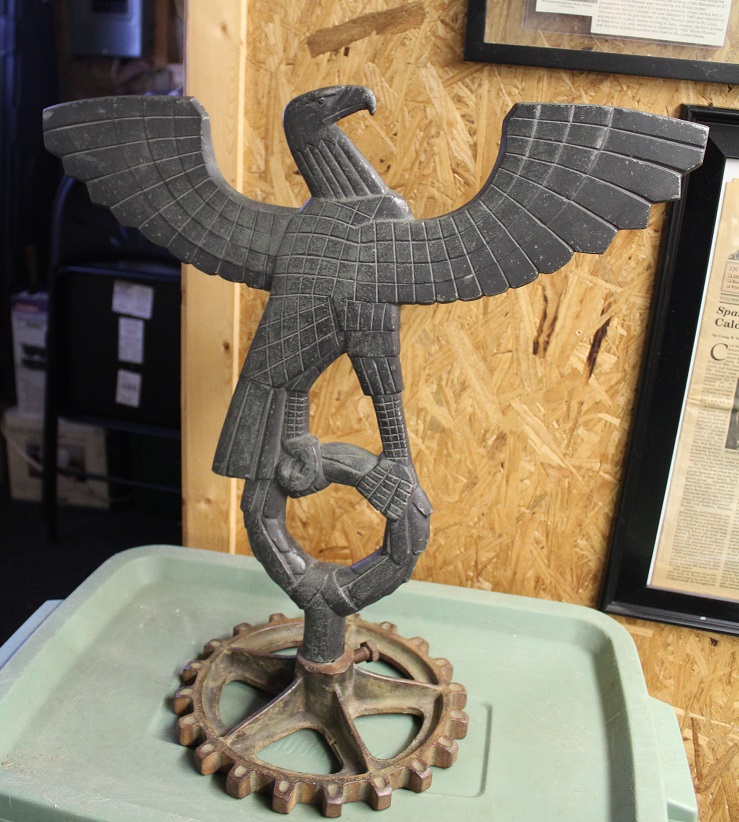

Indian Wars, Span Am, WW1 and WW2
_________________________________________________________________________________________
Item No. 104
Here we have various German banknotes. There are some 1904 Funf Marks, 50 mark Reichsbanknote 1920, 20 Reichsmark Reichsbanknote 1929, MillionenMark 1933, 1000 Reichsbanknote 1910, 20000 Reichsbanknote 1923 and a 50000 Reichsbanknote 1922. E-mail for prices. Check out the pics.
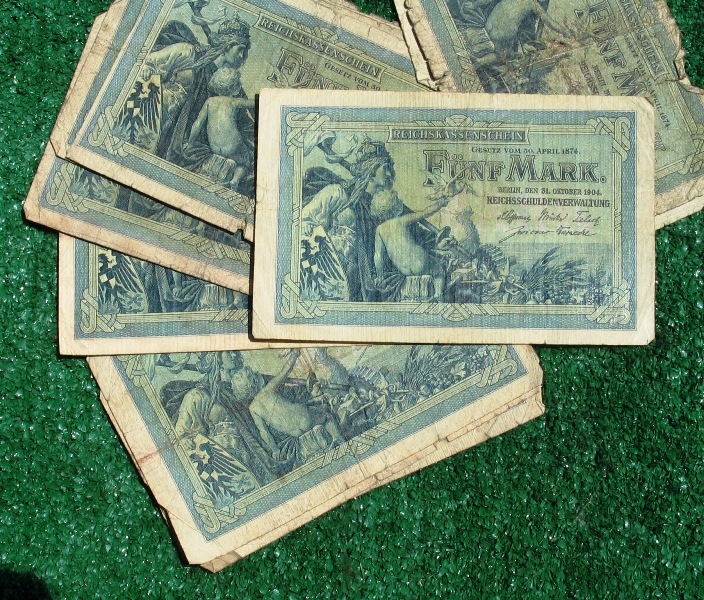
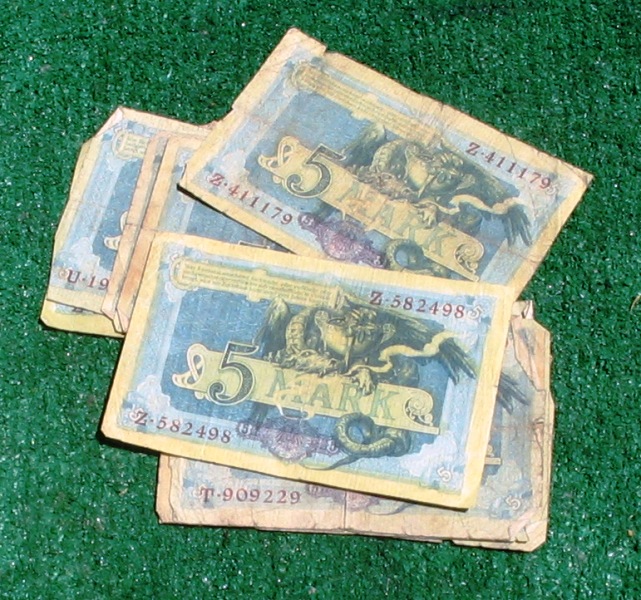
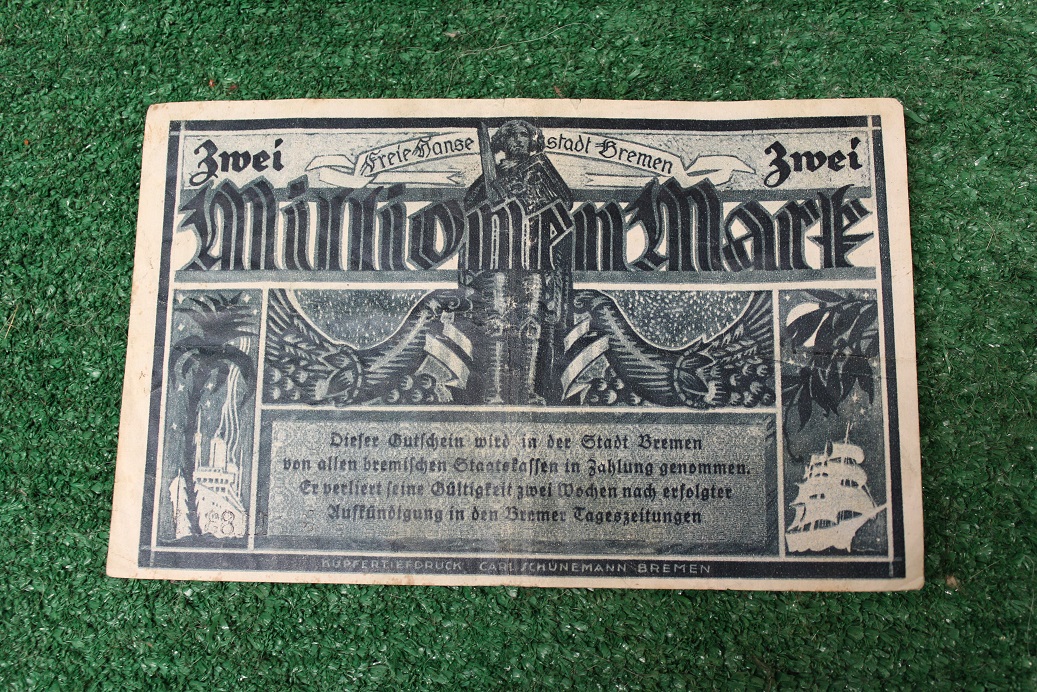
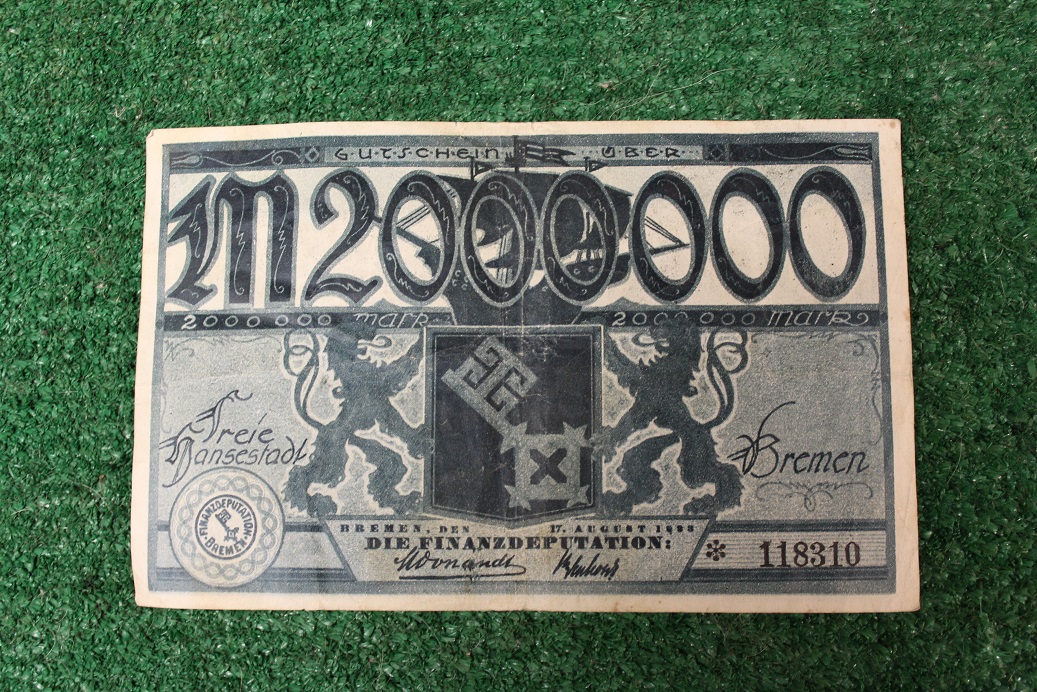
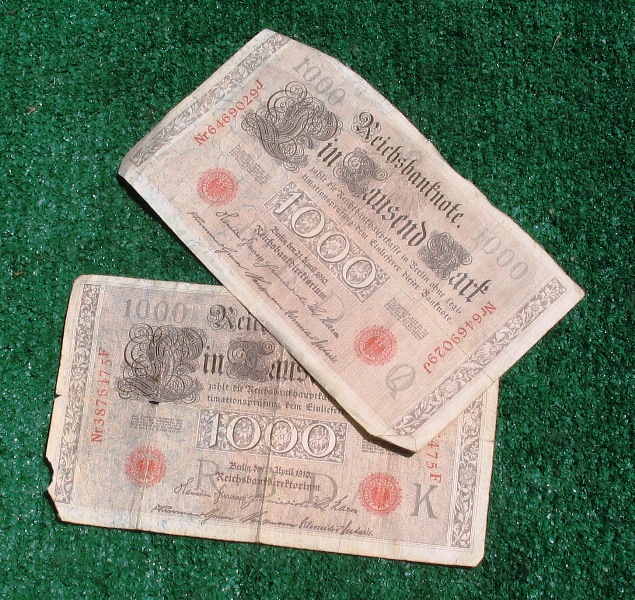
Some notes are not pictured. If interested please ask. Thanks!
_________________________________________________________________________________________
Item No. 57
Here is a very nice WW2 German Rifle Cleaning Kit For German Mauser 98K rifles and others.
The tin is in great original condition and is marked on the top lid 12 244 G.Appel 1937. Known as the RG-34 Reinigungsgeräte 34 (Cleaning Apparatus 34) and was standard soldier issue to maintain the K98 service arms.
The kit consists of two pull through brushes and an oiler. The pull through chain is with this cleaning kit as well as the cleaning cloths and a small brush. There is a smidge of original grease remaining in the bottom compartment
however. For this piece. $95.00

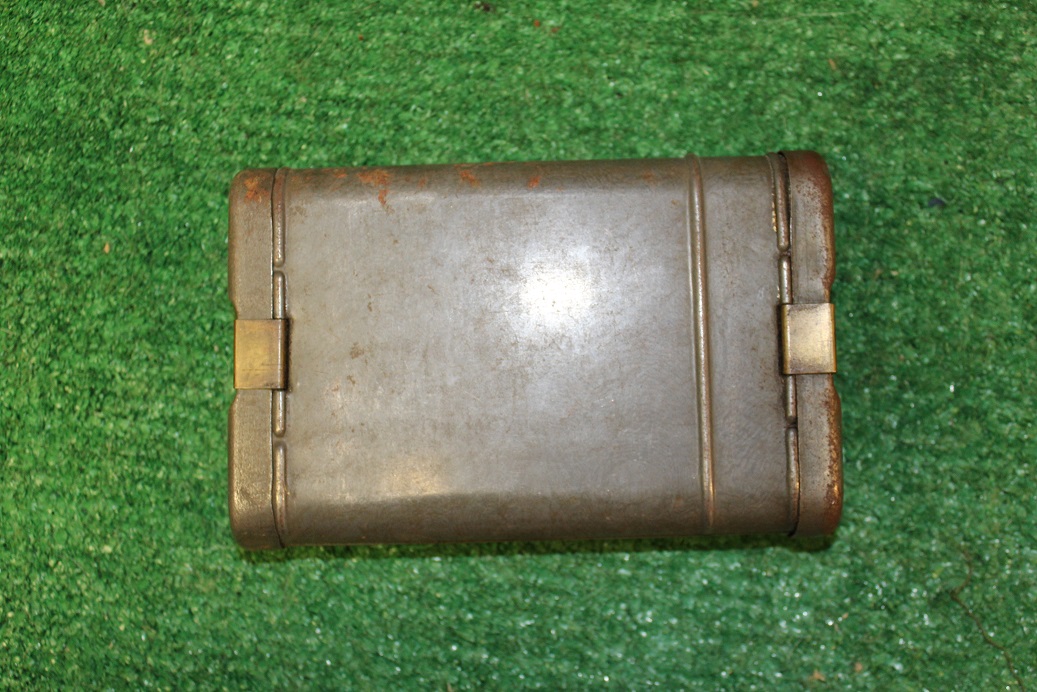

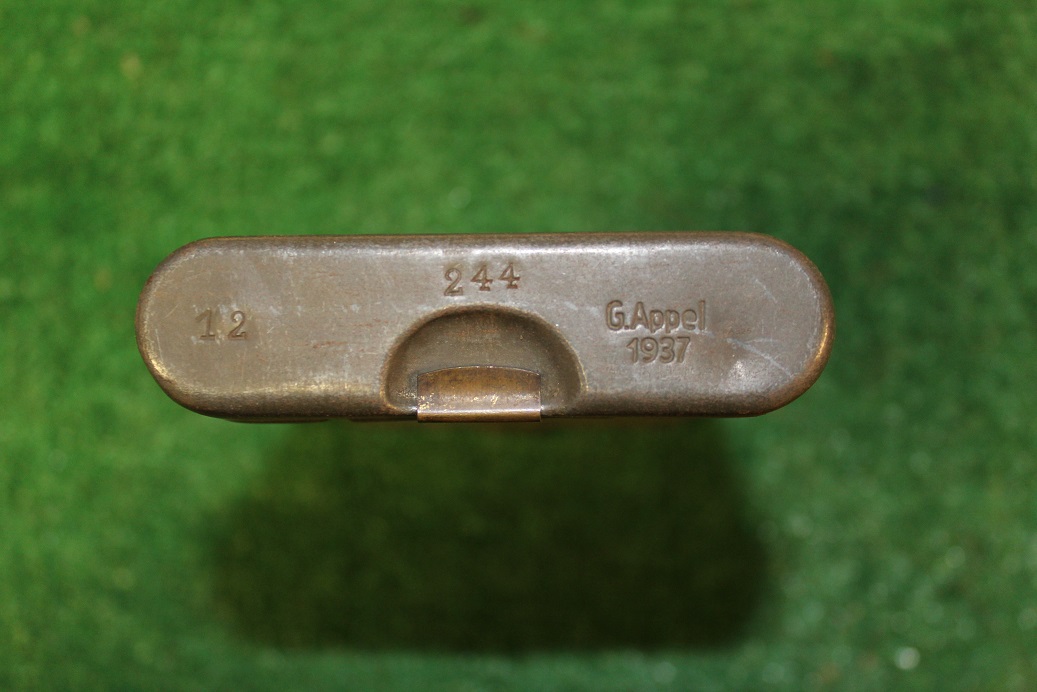
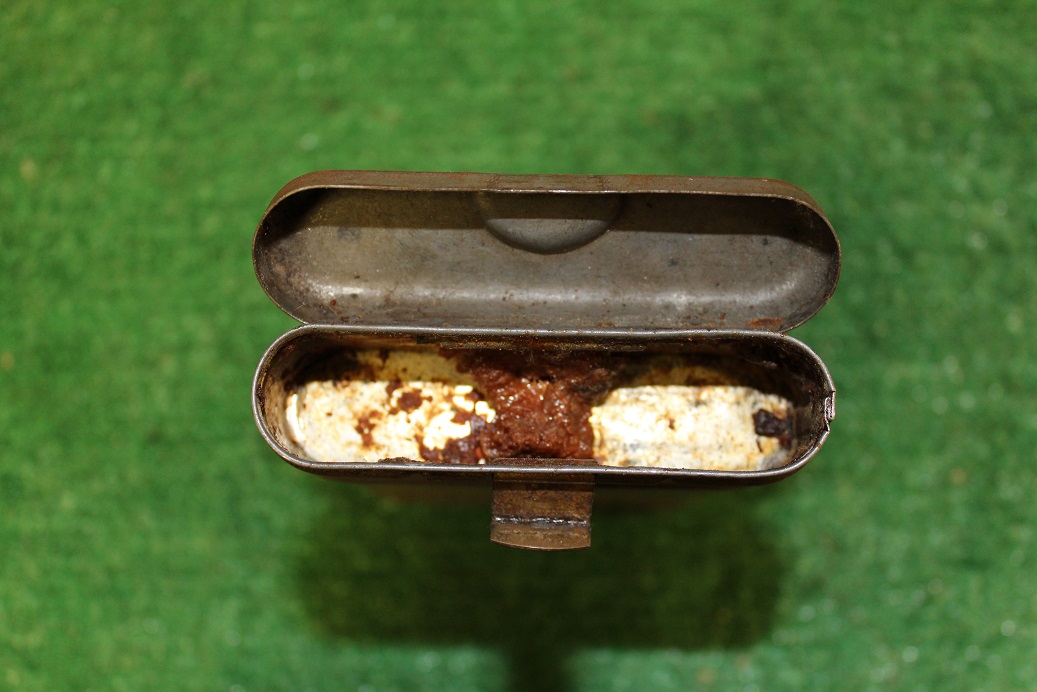
_________________________________________________________________________________________
tc
Here we have a very nice highly sought after Swiss M1914 Bayonet and scabbard! The M1914 bayonet is for the 1894/14 Carbine and the odd design is due the fact that the original 1894 Carbine had no provision for a bayonet. The unusual extended pommel mortise is the result of introducing a bayonet retrospectively to the carbine! The long bladed 1914 carbine bayonet was securely retained in the scabbard by a press catch located just above the crossguard on the left side of the hilt. The mortise slot is raised above the pommel in a somewhat unusual placement as this one is. This bayonet has the Swiss markings on the ricasso and the blade has been slightly sharpened indicating use instead of being surplus. The blade is full length as it should be. The wood grips are in great shape and the locking mortise works just fine. The bayonet lock to the scabbard works just fine as well. The scabbard is the correct one and is painted gray with red tape on the end for some reason that I do not know. The frog stud is still present also. All in all a very nice fairly rare example of this type 1914 bayonet! For this piece $250.00



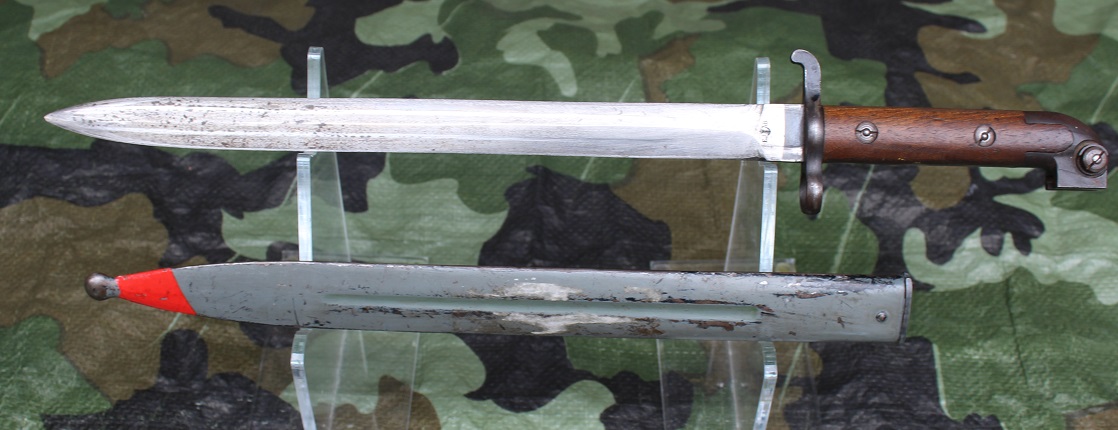
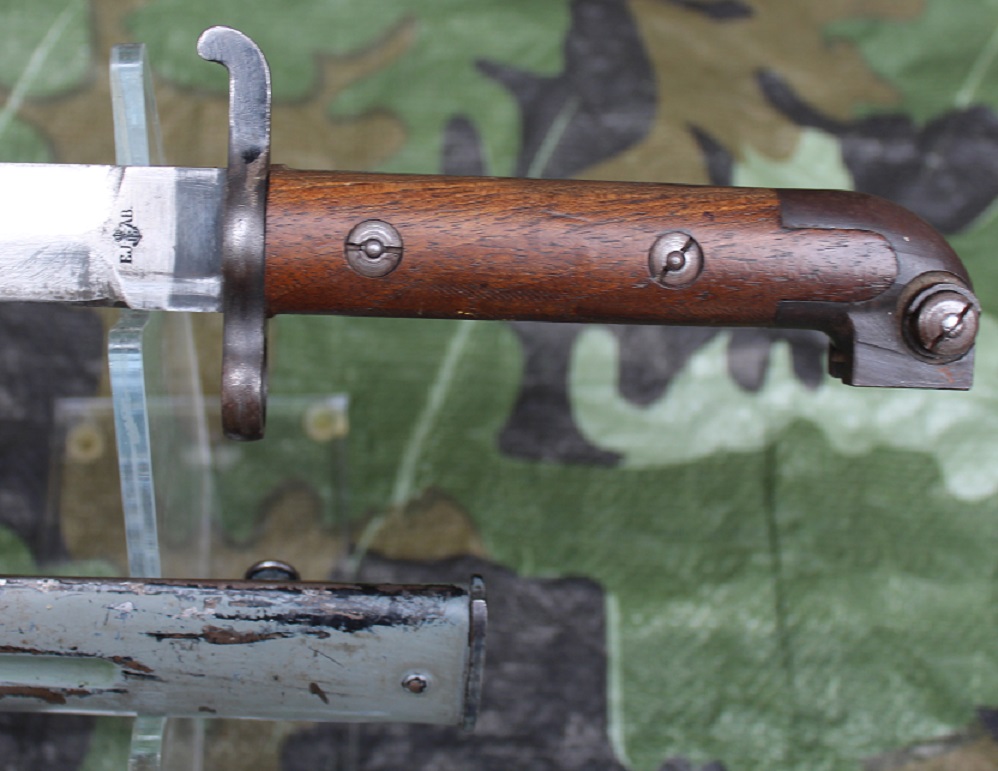
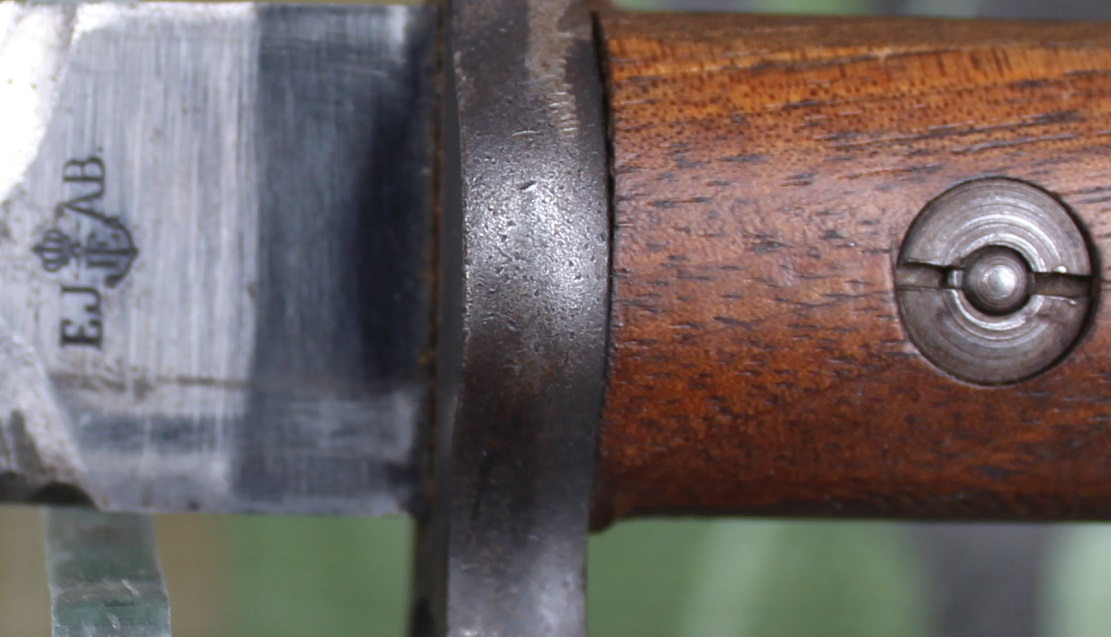
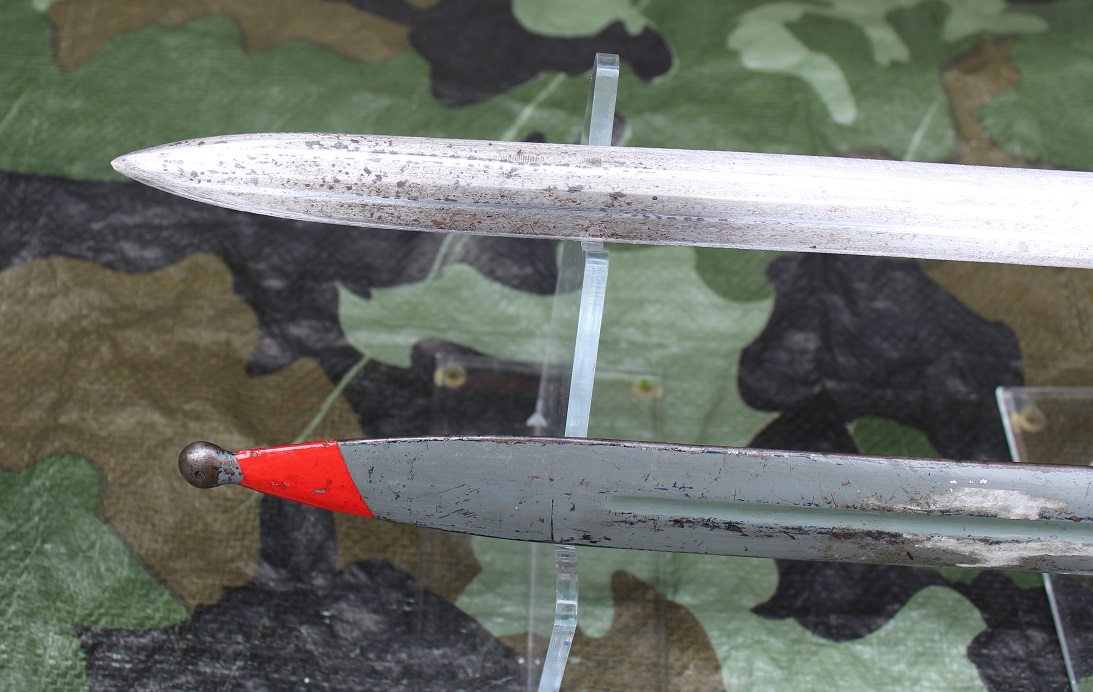

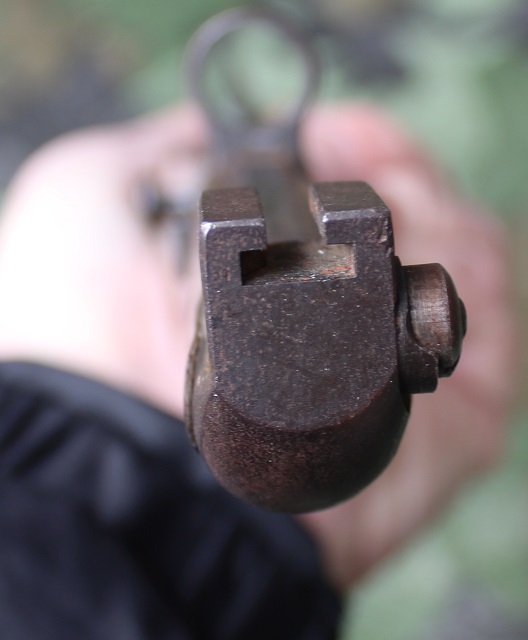
---------------------------------------------------------------------------------------------------------------------------------------------------------
Here is a rather large WW2 Grouping that we will sell as one unit but list as four separate sections. These items belonged to Jack E. Skirvin of Bloomington, Indiana. Jack served in the 91St Division. The 91st Infantry Division (famously nicknamed as the "Wild West Division" with a "Fir Tree" as its Division insignia to symbolize its traditional home of the Far West is an infantry division of the United States Army that fought in World War I and World War II. As the early battles of World War II involving the United States were being fought, the division was reactivated at Camp White, Oregon on 15 August 1942, under the command of Major General Charles H. Gerhardt. After initial training at Camp White, the division participation in the Oregon Maneuver combat exercise in the fall of 1943. Order of battle
Headquarters, 91st Infantry Division
361st Infantry Regiment
362nd Infantry Regiment
363rd Infantry Regiment
Headquarters and Headquarters Battery, 91st Infantry Division Artillery
346th Field Artillery Battalion
347th Field Artillery Battalion
348th Field Artillery Battalion
916th Field Artillery Battalion
316th Engineer Combat Battalion
316th Medical Battalion
91st Cavalry Reconnaissance Troop (Mechanized)
Headquarters, Special Troops, 91st Infantry Division
Headquarters Company, 91st Infantry Division
791st Ordnance Light Maintenance Company
91st Quartermaster Company
91st Signal Company
Military Police Platoon
Band
and the 91st Counterintelligence Corps Detachment
Then, the division, now under Major General William G. Livesay, departed for the European Continent on 3 April 1944. There, on the Italian Front, the 361st Regimental Combat Team was detached to participate in the battles for Rome and the Arno River. It became the first formation of the U.S. Fifth Army to reach the river. In September 1944, the division crossed the Sieve River, outflanked the famous Gothic Line, and captured the Futa Pass. For its part in combat, the division was awarded the North Apennines, Po Valley and Rome-Arno campaign streamers.
The division returned to the United States where it was inactivated at Camp Rucker, Alabama, in December 1945.
Campaigns:
Rome-Arno (22 Jan 44 – 9 Sep 44)
North Apennines (10 Sep 44 – 4 April 45)
Po Valley (5 Apr 45 – 8 May 45)
___________________________________________
Casualties
Total battle casualties: 8,744
Killed in action: 1,400
Wounded in action: 6,748
Missing in action: 262
Prisoner of war: 334
Jack was also an artist for the group and had his cartoons printed in several publications of which a few are included in this group. Jack also wrote a novel based on a true story (I suspect it was his! Lol!) We do not have the book but it can be purchased
on Amazon, Walmart and such. Here is a pic of the book.
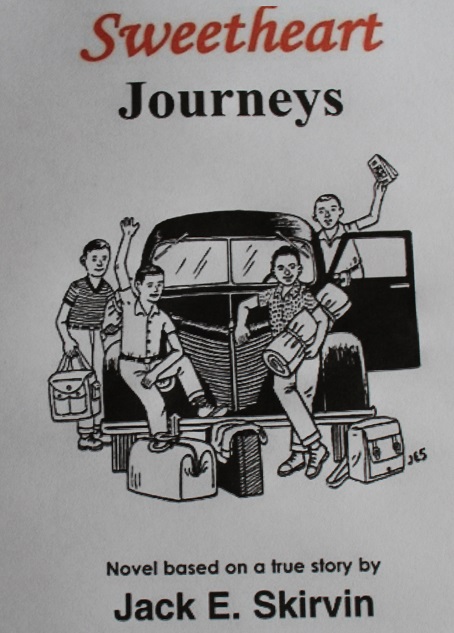
When World War II became history, there was a big reception in Boston Harbor followed by a heartwarming celebration at home. Jim would now be able to keep the promise he made to his four sweethearts residing on the west coast; a mighty
long way from his bailiwick. Sweethearts Miriam and Loretta were waiting in Oregon and he would board the Great Northern Railway to see them. Rita and Connie were sitting on pins and needles in Los Angeles. His cousin Andy returned home
from the War, bought an old Ford, and wanted to go along with Jim to see Hollywood and swing at the famous Palladium. Two of their high school buddies were hitching rides to the north woods and they wanted to go along. So, Jim made
arrangements to visit Miriam and Loretta in Oregon; take a semester of classes at Indiana University; and then begin the long journey to Hollywood in his cousin.
I suspect that this book is very entertaining!!!
Now on to the groups:
1st group:
This group consists of a good K98 Mauser bayonet in sheath with marked frog. The bayonet is missing the button to lock it onto the rifle but still in nice condition with good markings and grip. The frog is marked in a rectactle KMZ 1943. Also included is a K98 Rifle cleaning kit in good condition overall and seems to be complete, a 91st Division history booklet from August 1917 to January 1945, several negatives that can be processed of soldiers and sailor (not all are pictured here), a good conduct medal, a 1st place Soap Box Derby medal (I know it doesn't belong here but it's with his stuff), 2 WW2 WWII European African Middle Eastern EAME Campaign Ribbon Bar ETO Pin Back with 3 battle stars (one is not in great shape but the other is), collar brass, a Starr shaving kit, a 1939 WW2 German Merit Cross minus ribbon in box with crumpled up German news print, a piece of chalk with a mans face carved into it, a Johnson's TravelKit Pocket first aid kit and a copper cup commerating a 3 man team championship of unknown use but dated March 30th, 1941. Check out the pics!
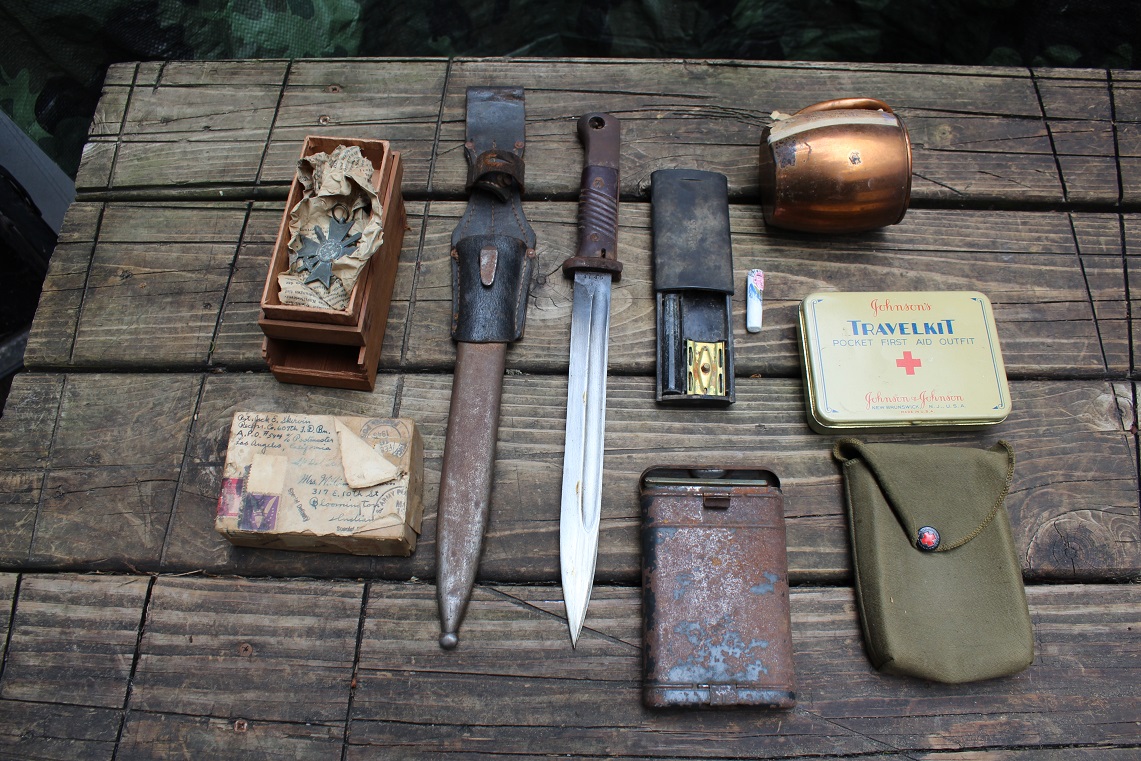
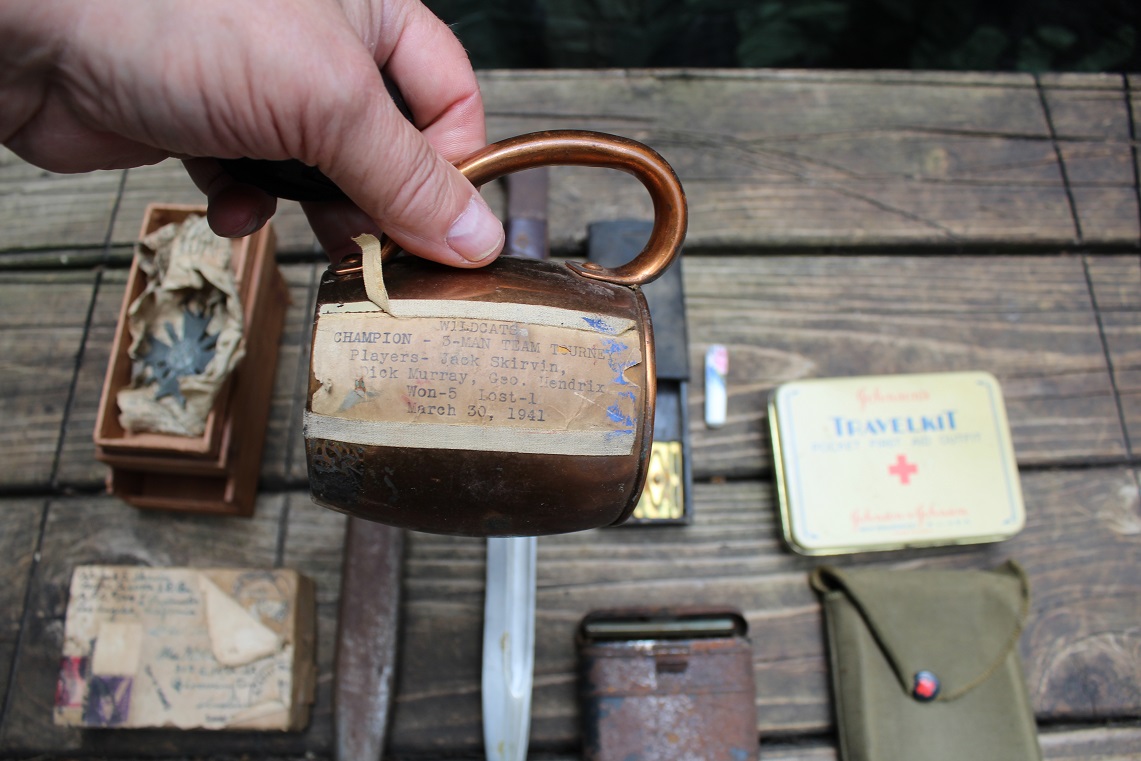

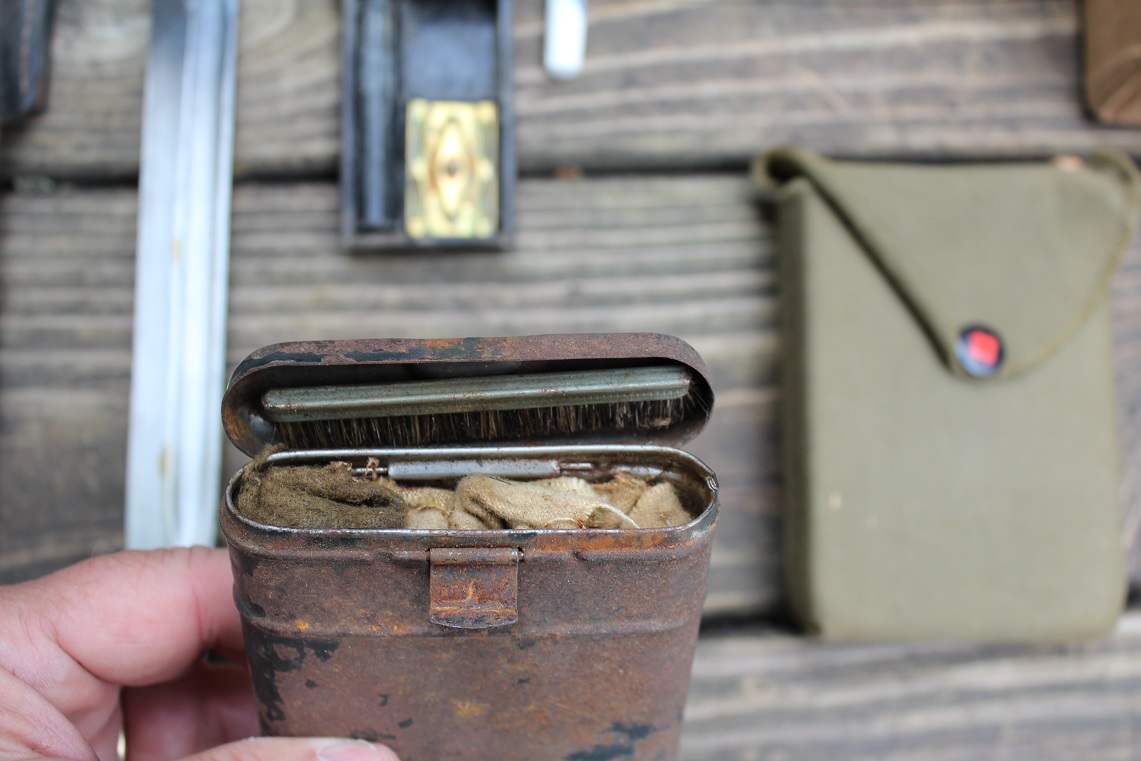

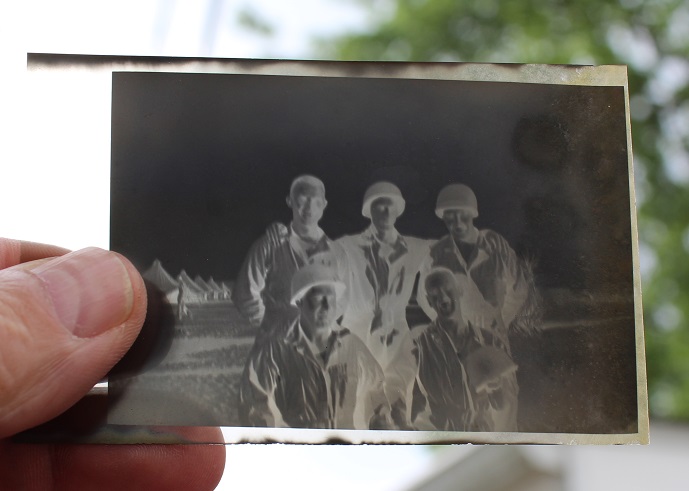

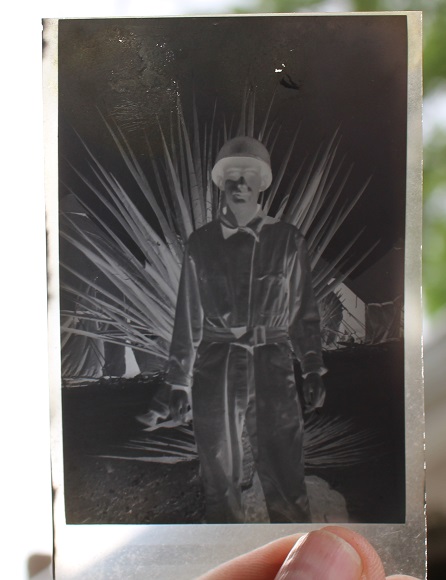
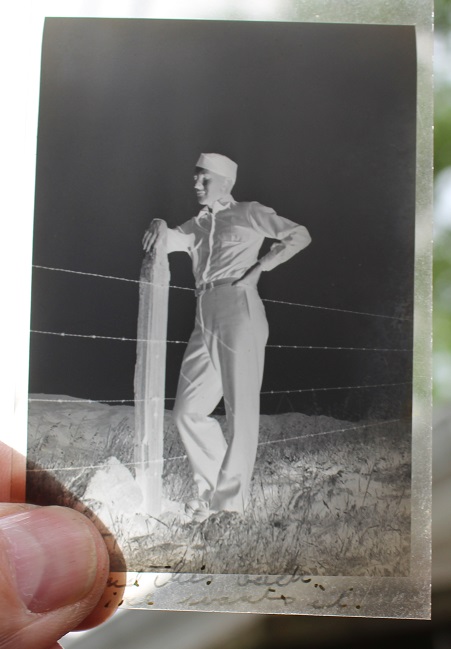
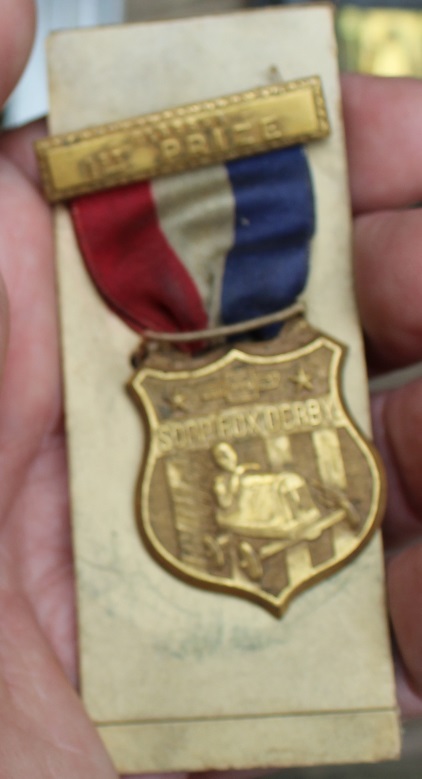
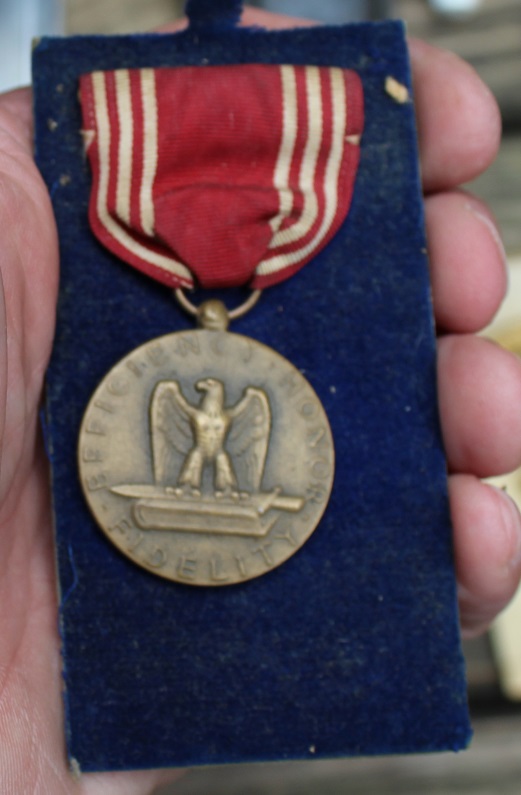
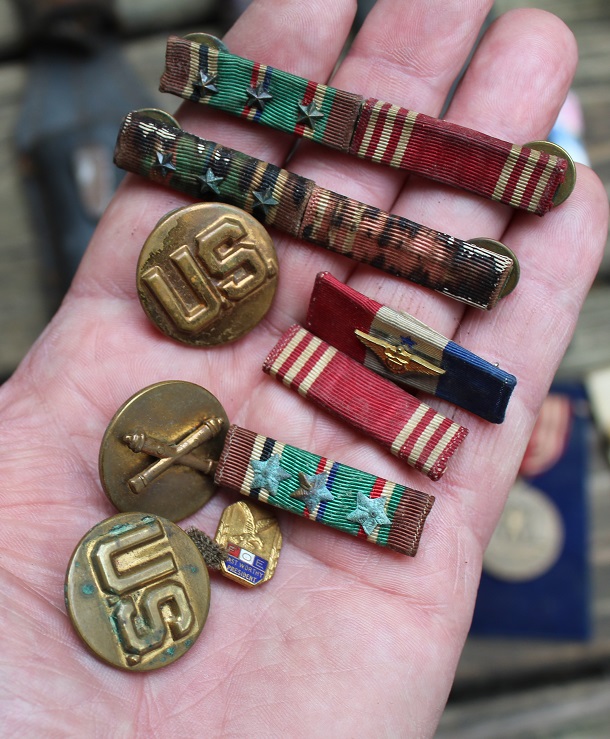
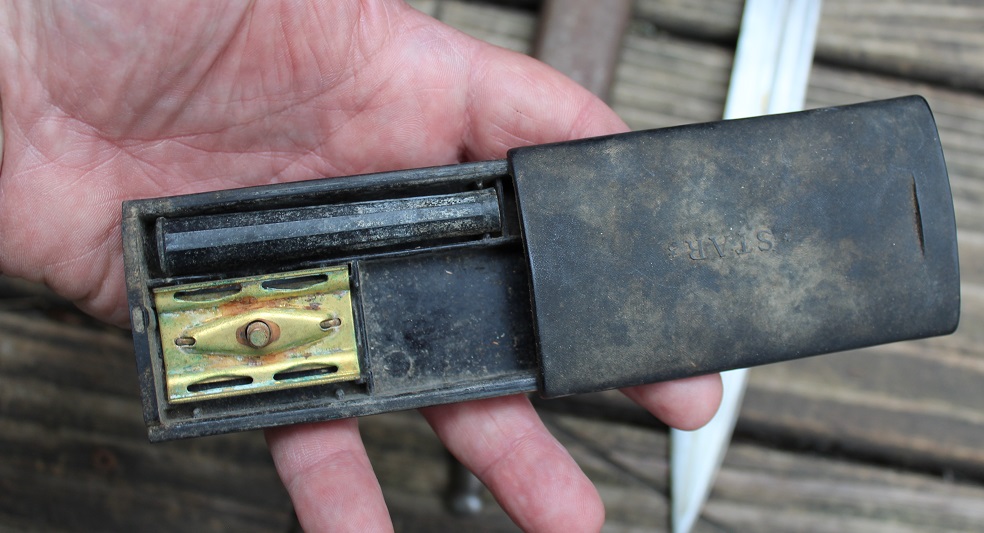
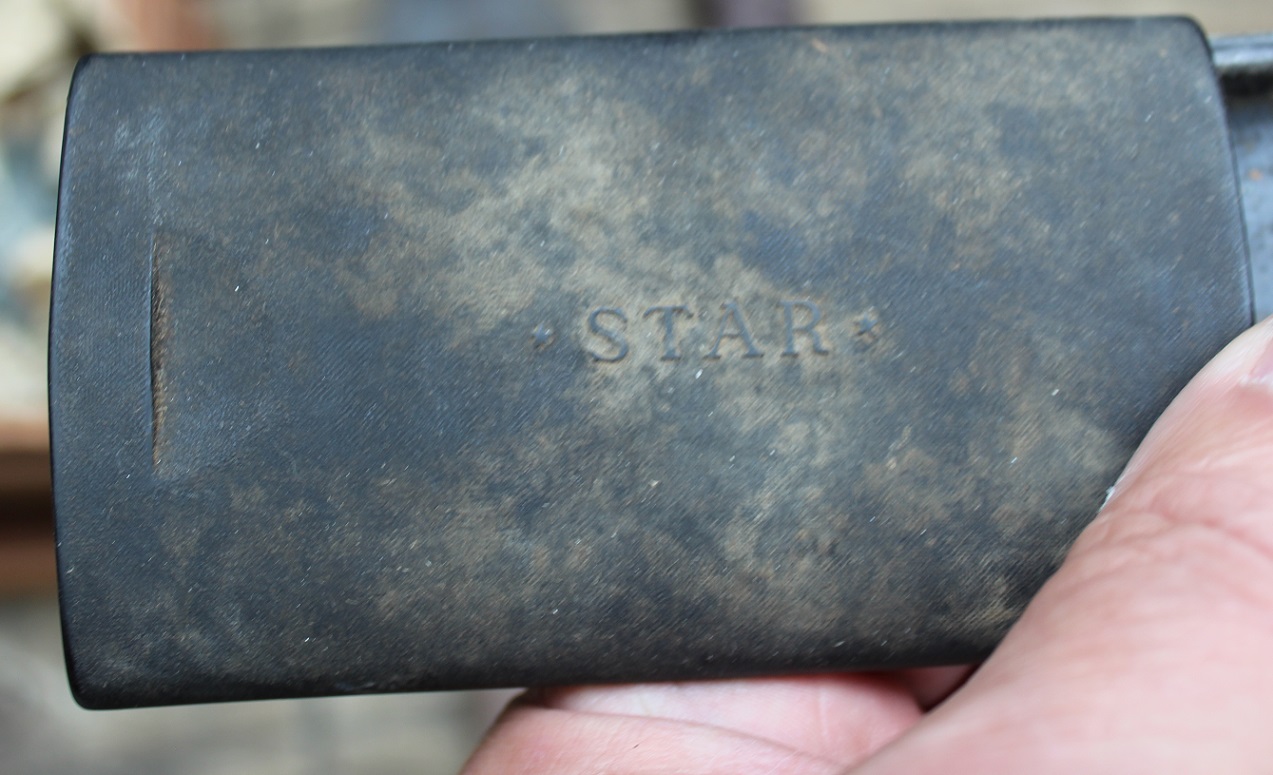



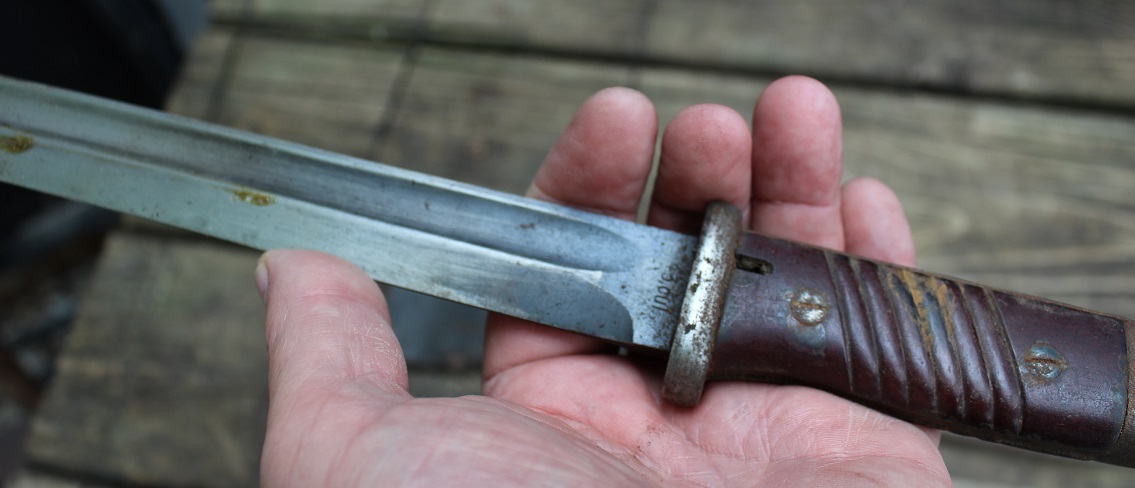

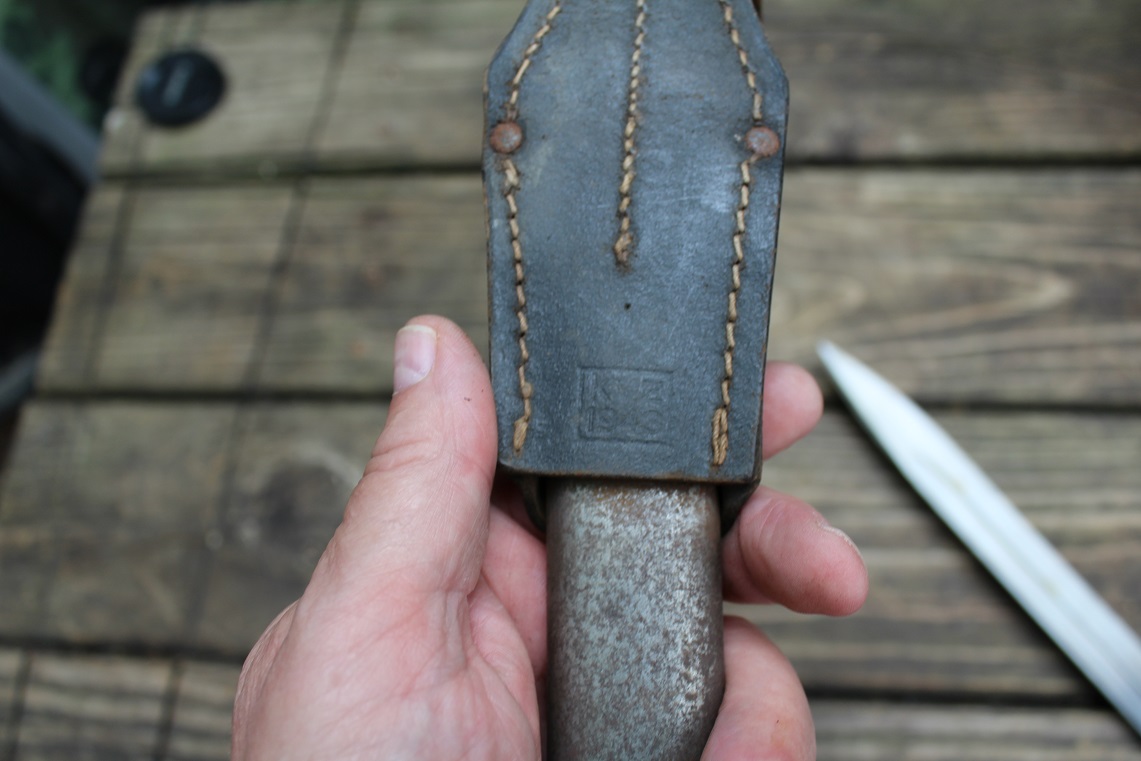
2nd Group:
Here we have a small grouping of patches and other items. They are 5 tank destroyer patches, 2 master sgt shoulder patches, one 91st Division Unit patch, and 2 Ruptured Duck Discharge patches. Also included is a European/African/Middle Eastern Campaign medal with 3 battle stars, a WW2 lighter, 2 ruptured duck collar pins, a US Naval reserve collar pin, a plastic army button, a 1942 and 1943 Italian coin and 3 rings. The rings are silver finished (cannot tell is actual silver or not) with one being marked with NAPLES and showing scenery, one is marke ORAN AFRICA 1944 and the last one is marked with what appears to be Mercury on the top ORAN 1944 on one side and AFRICA on the other side with decorations. Oran is a major coastal city located in the northwest of Algeria. These rings were sold as souvenirs to Allied soldiers after the Operation Torch landings in 1942. Check out the pics for these items!
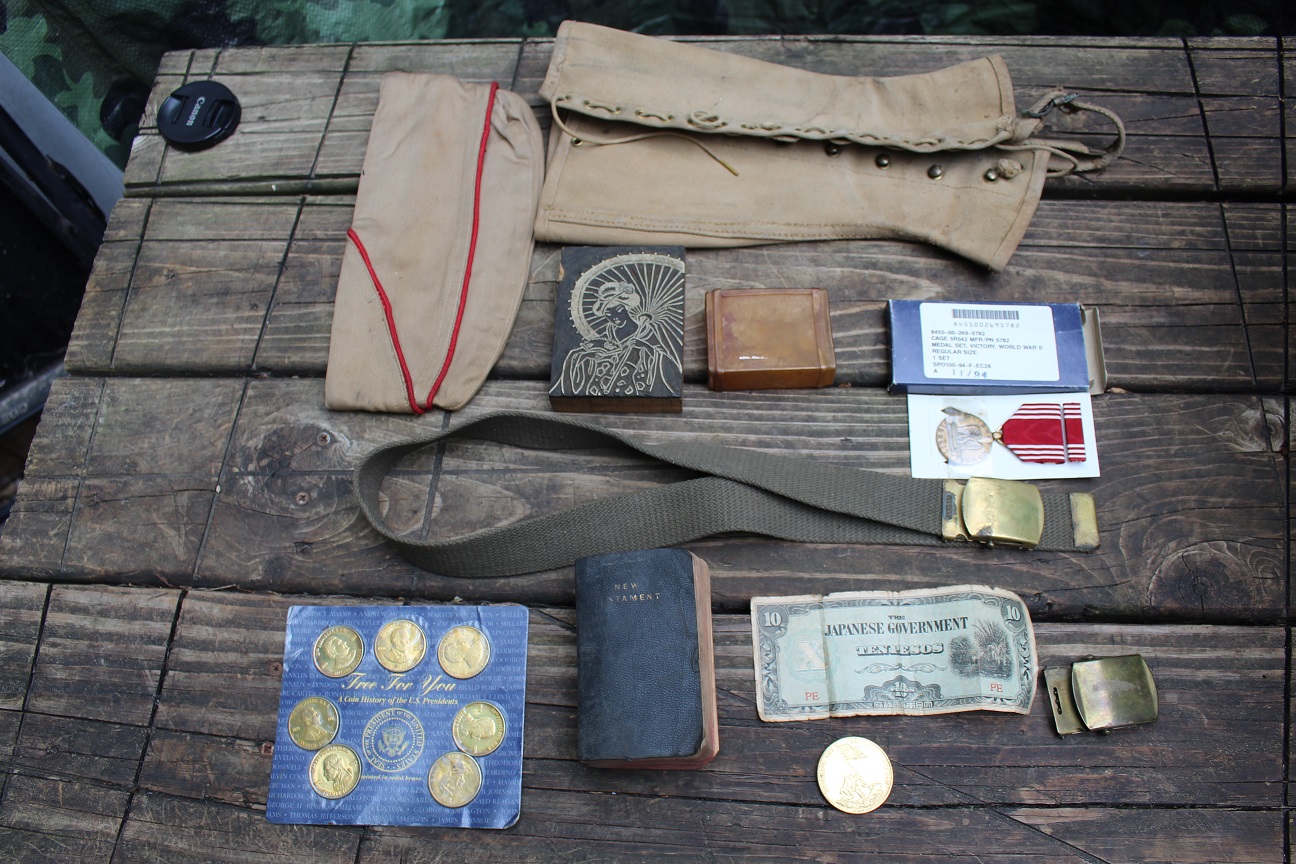
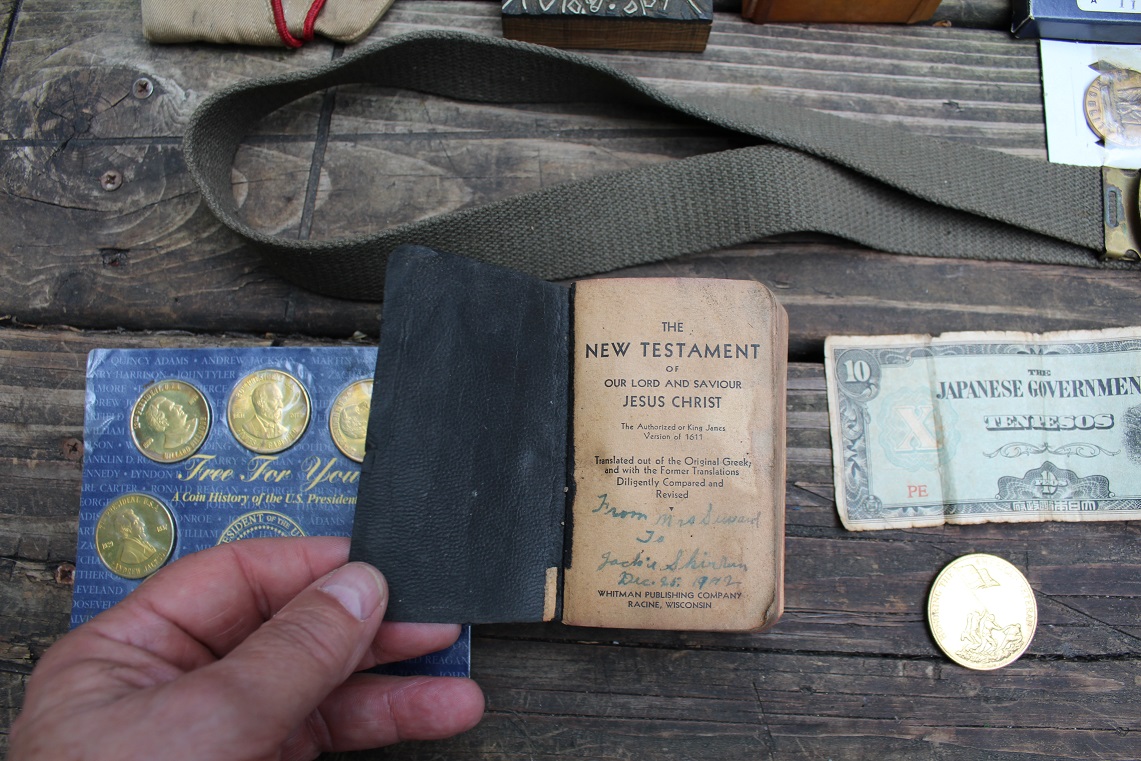
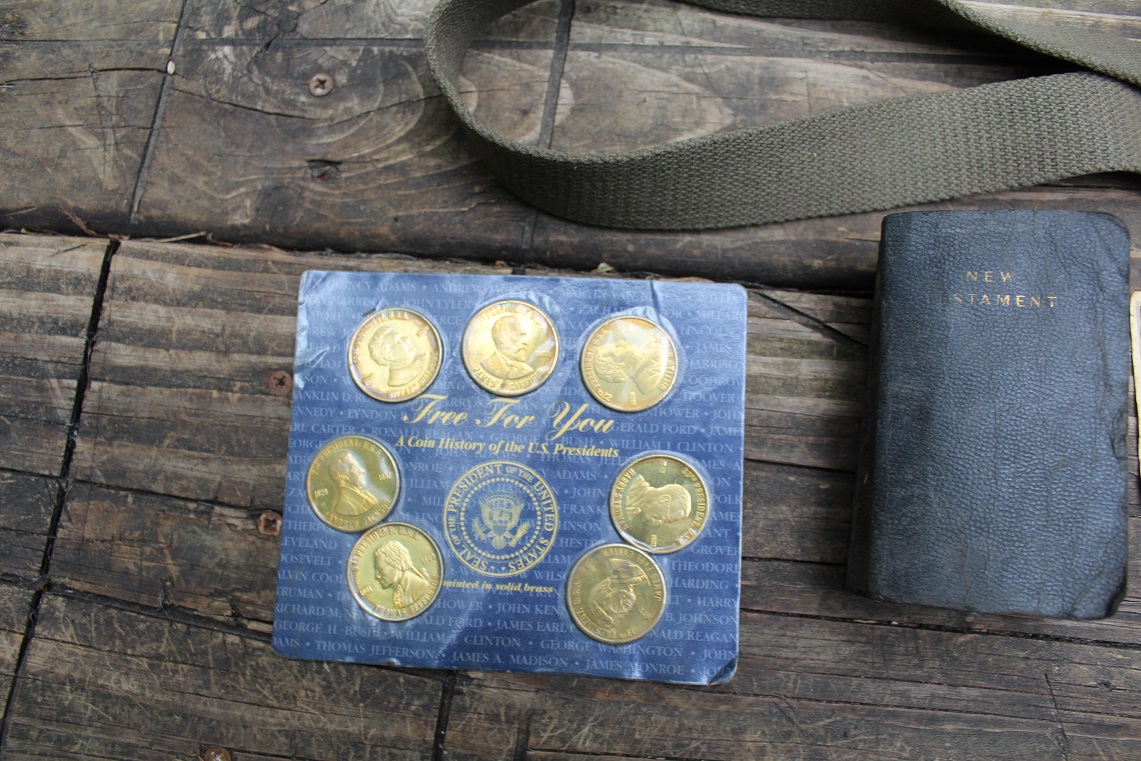
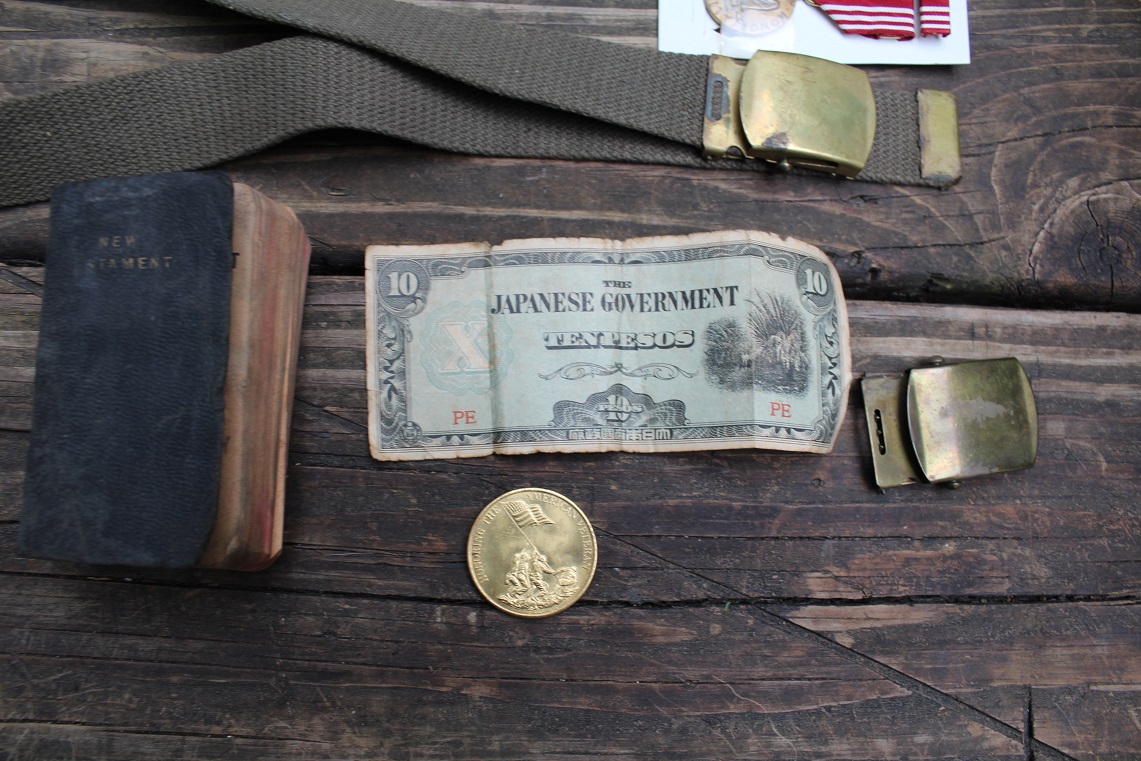




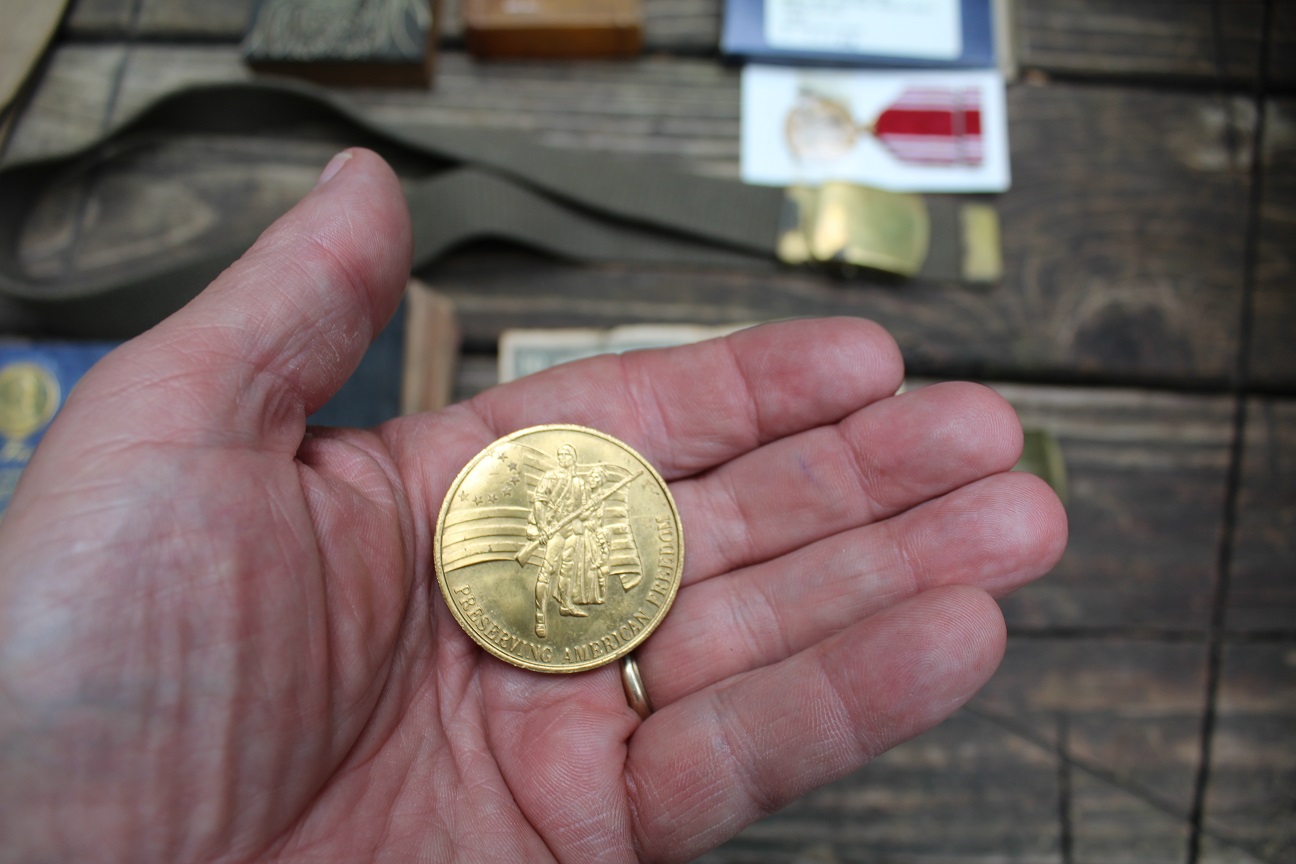
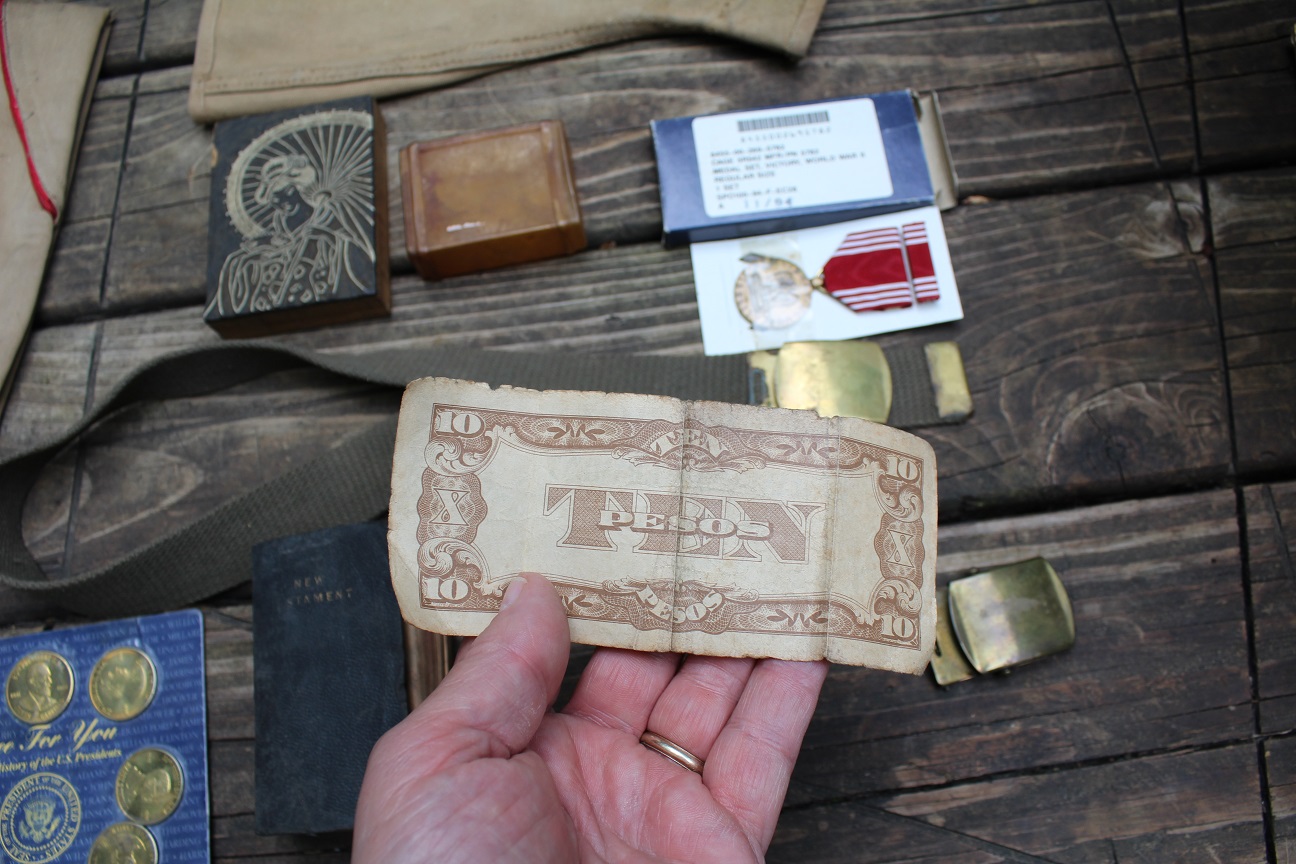
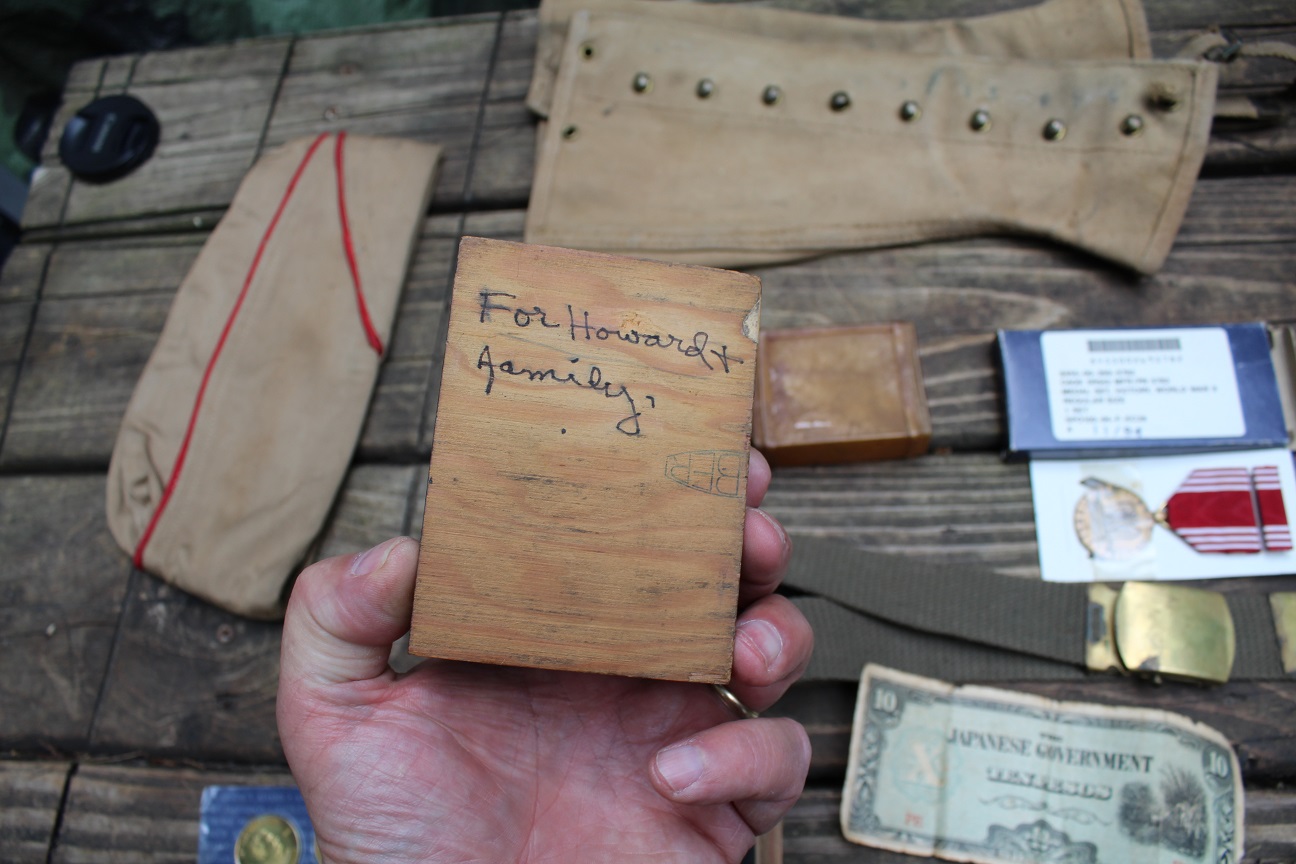
3rd Group:
Here in the 3rd group of items beling to Soldier Jack E. Skirvin is a single canval WW2 legging, an WW2 Army Artillery overseas cap made in 1942, a new Testament given to Jack in 1942, a celluloid soap dish, a WW2 Victory Medal that was acquired in 1994, a web belt with brass buckle and an extra buckle, an Honoring the American Veteran gold colored large coin produced later, a Coin History of the U.S. Presidents being minted in brass with the latest president being Jimmy Carter, and a couple of Japanese items that were probably given to Jack after the war. One is a printers block of a Geisha girl but is marked on the back for Howard and Family and one item is a used 10 Peso Note issued by the Japanese Government. Check out the pics!
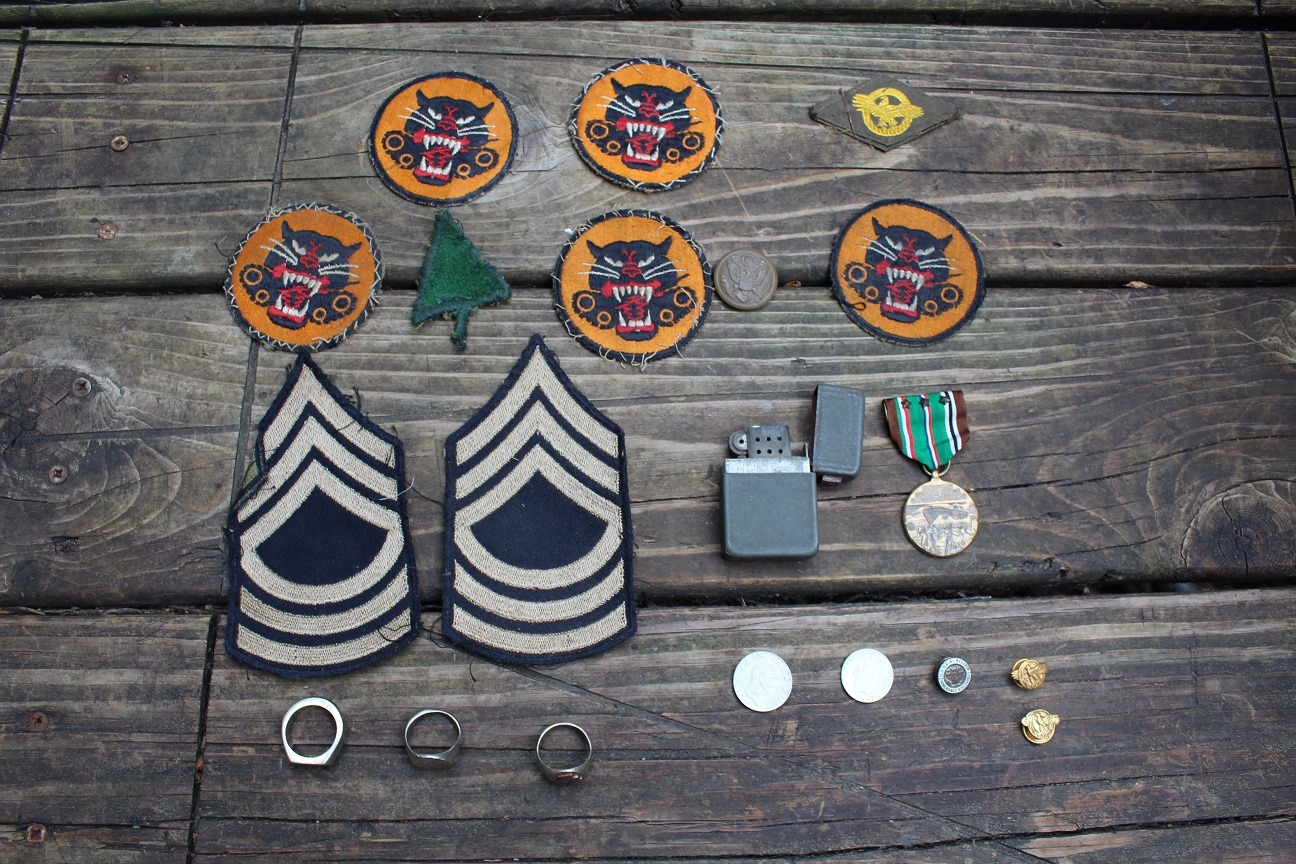


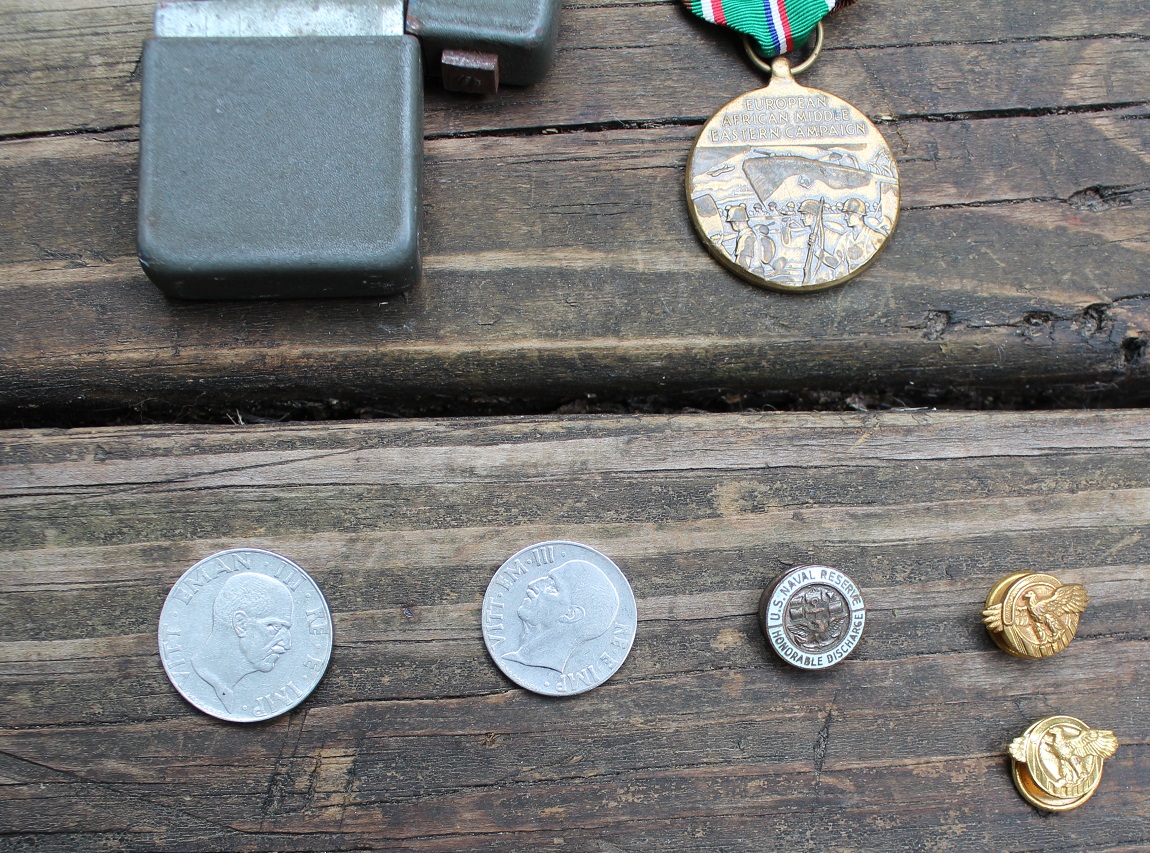
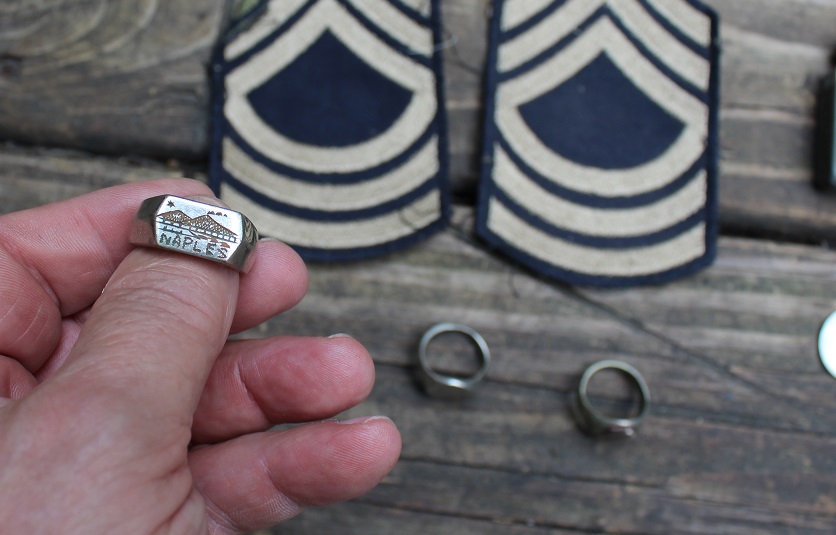
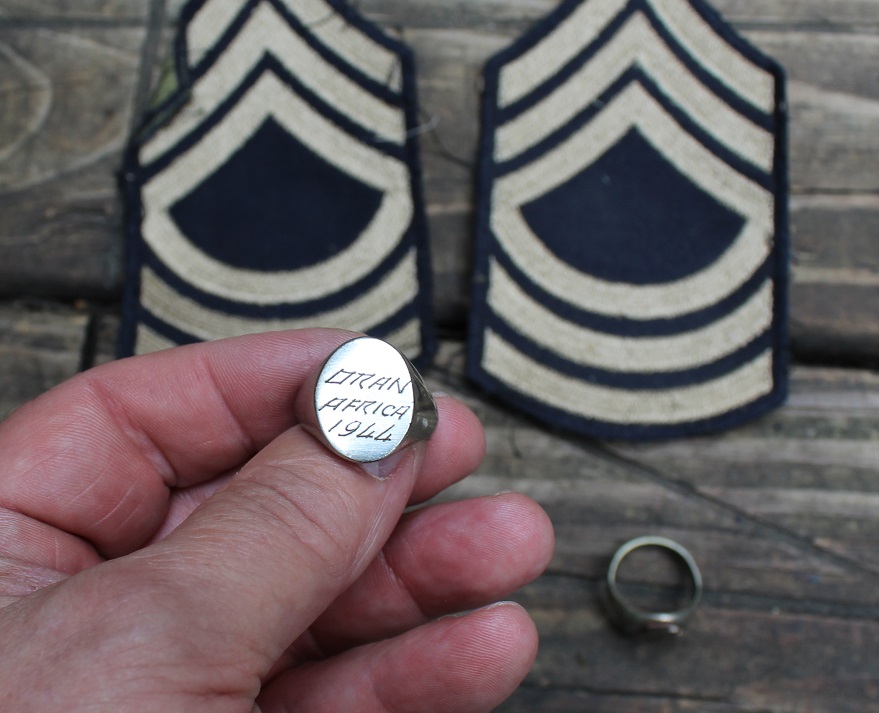


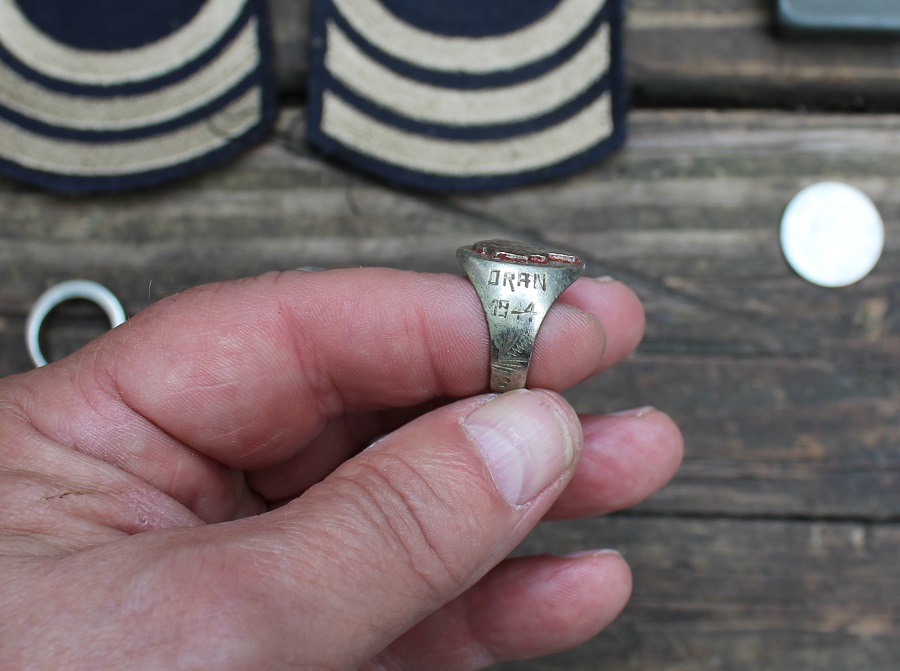
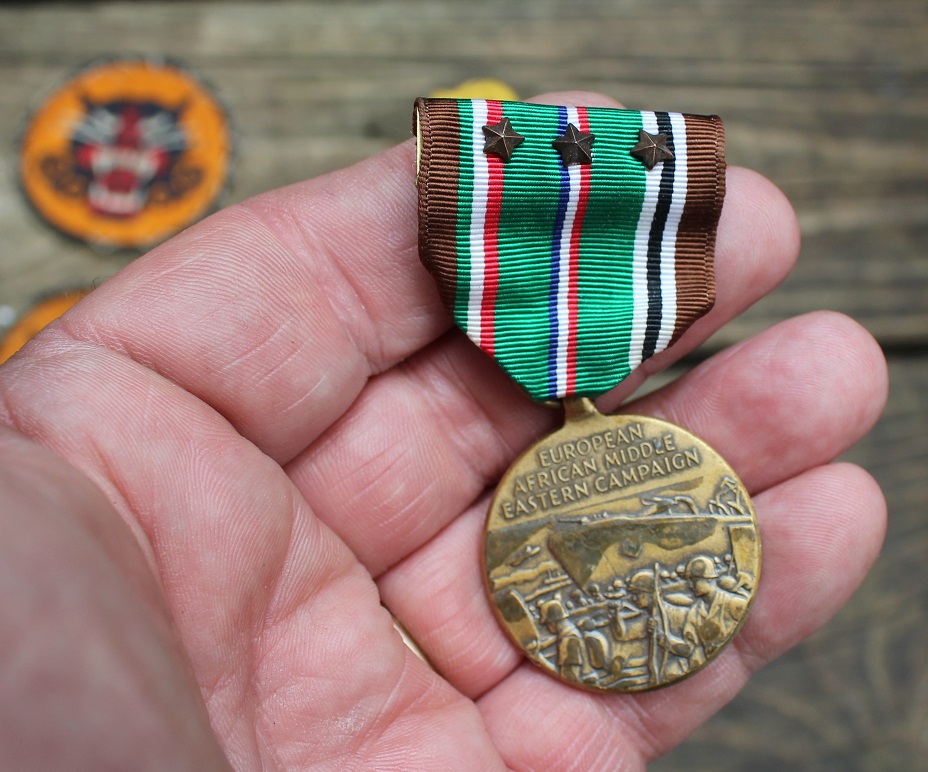


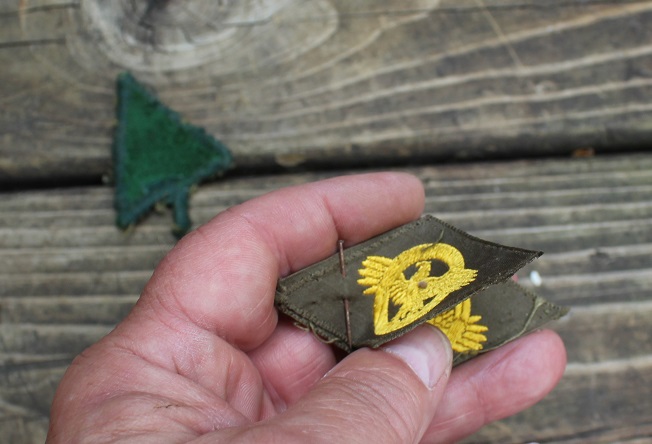
4th Group:
This 4th group is all paper items. Jack was an artist and included here is some of his art work as well as some of the publications with his art work in them and letters from the Military newspaper. There are also several newspaper clippings
dealing with the war. There is even a warning and repair order from the Arizona Highway Patrol for Jacks 1936 Ford Sedan. We have the paper showing Jack was promoted to Private on July 12, 1943 for the 670 Tank Destroyer Divisioin.
Jack furloughed in San Francisco in 1943 and we have his guide and when he stayed in the Hotel Cecil in Los Angeles. We have a letter written from the Congress of the United States recommending Jack for Officer Training signed by
Gerald Landis from the 7th Distric of Indiana. Also are 2 of Jack's original drawing pencils! We could go on and on and on! Many things we did not take pics of. Check out the pics below! For the entire grouping of 4 lots $495.00!
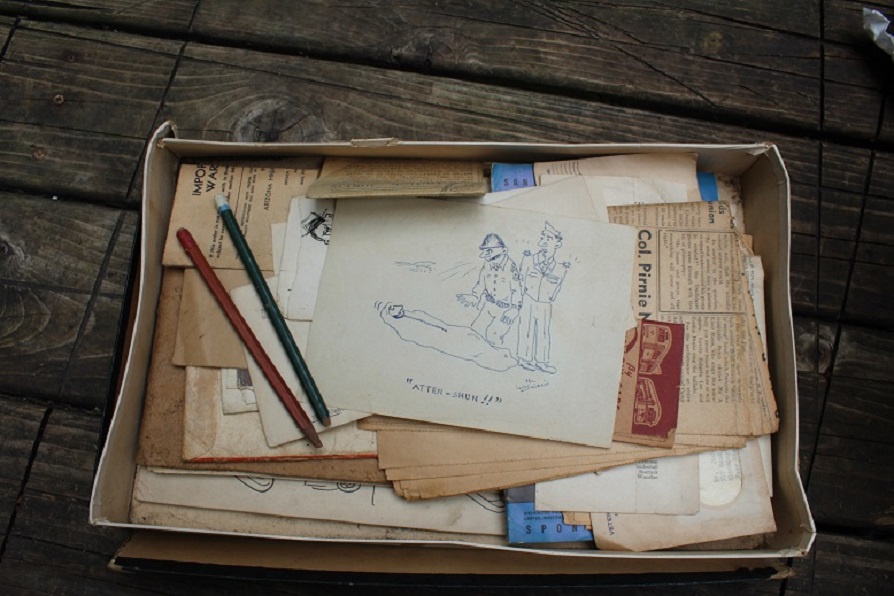


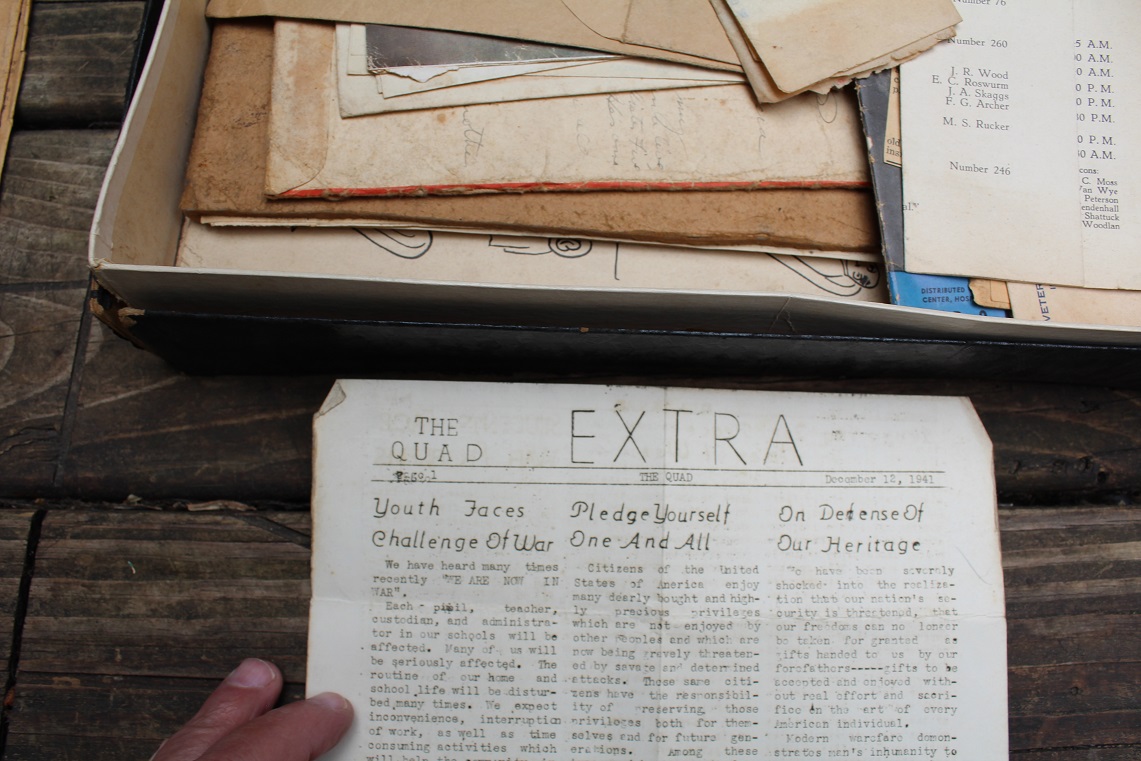
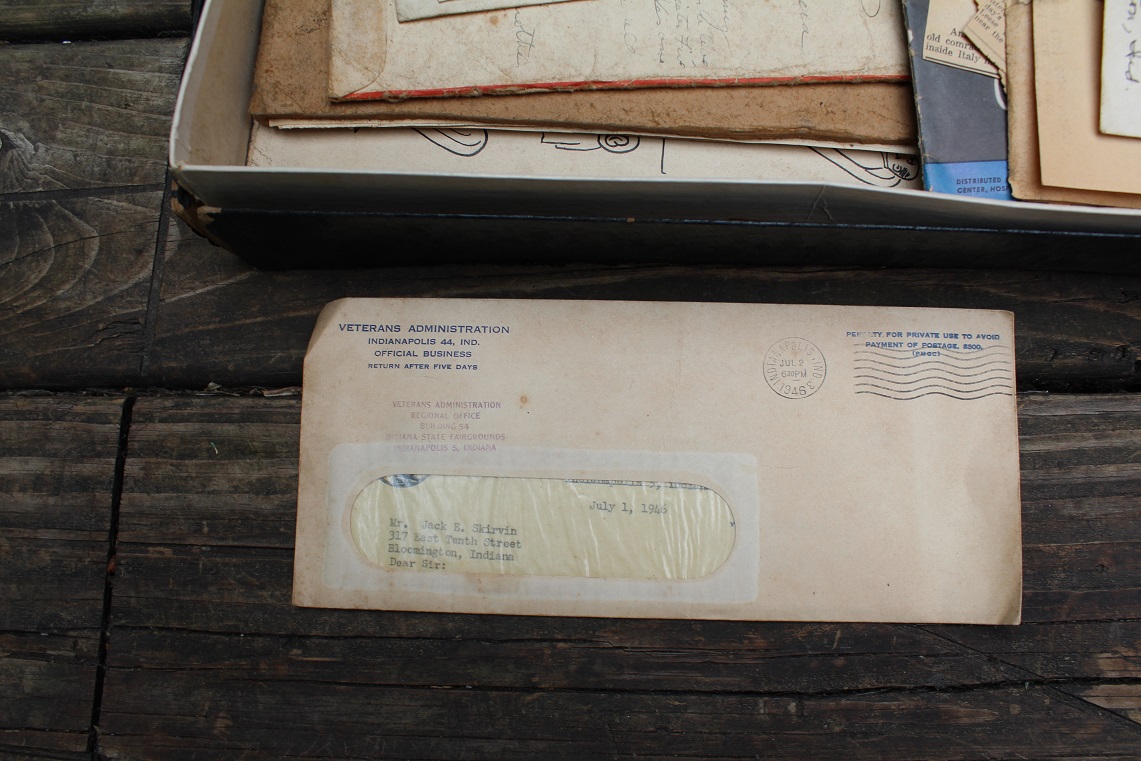
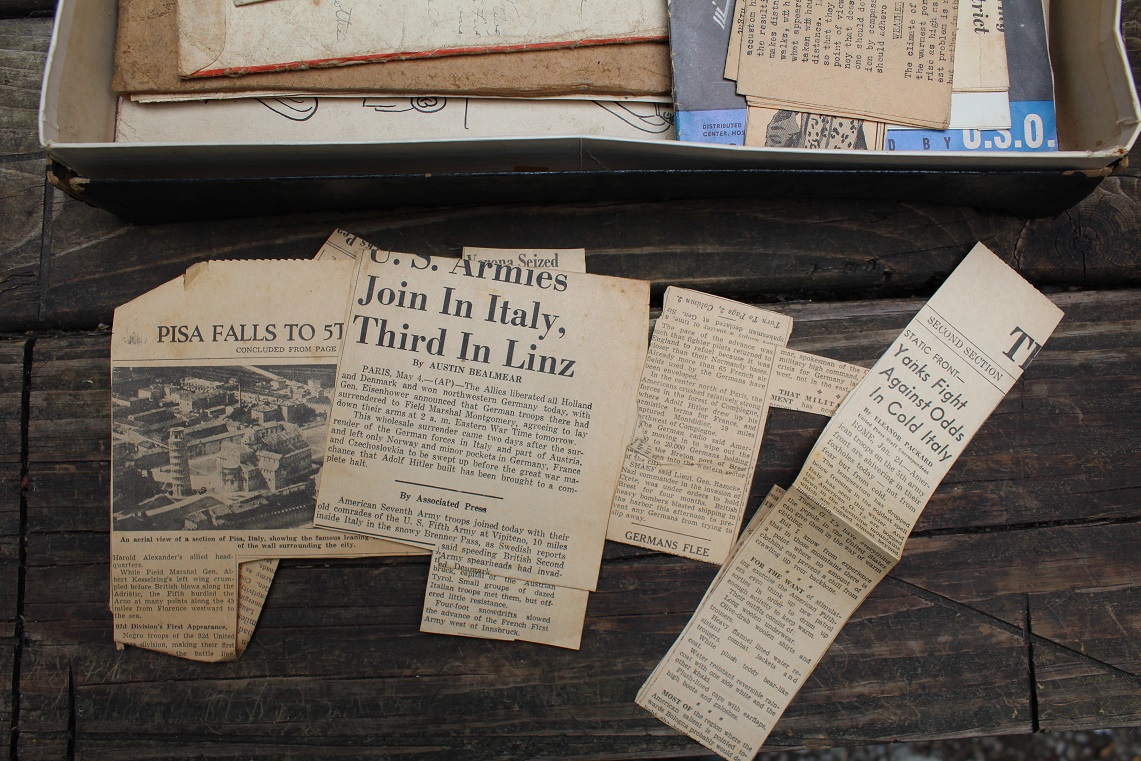
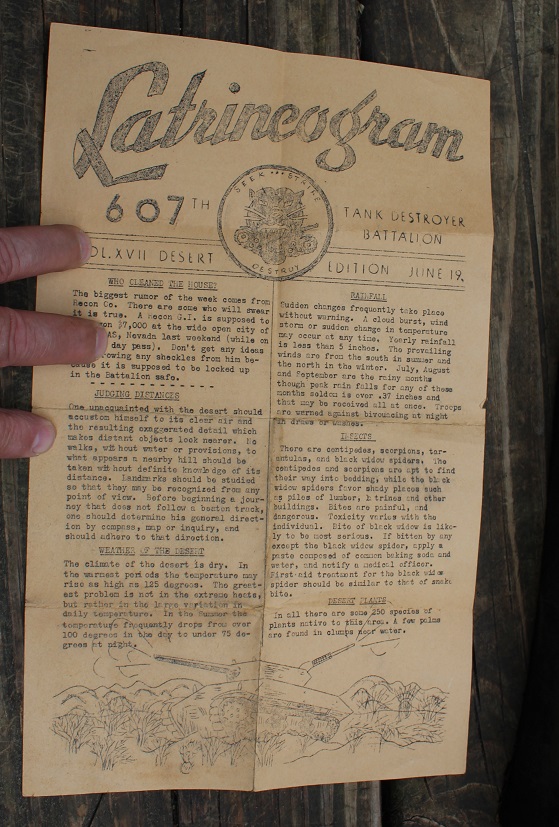
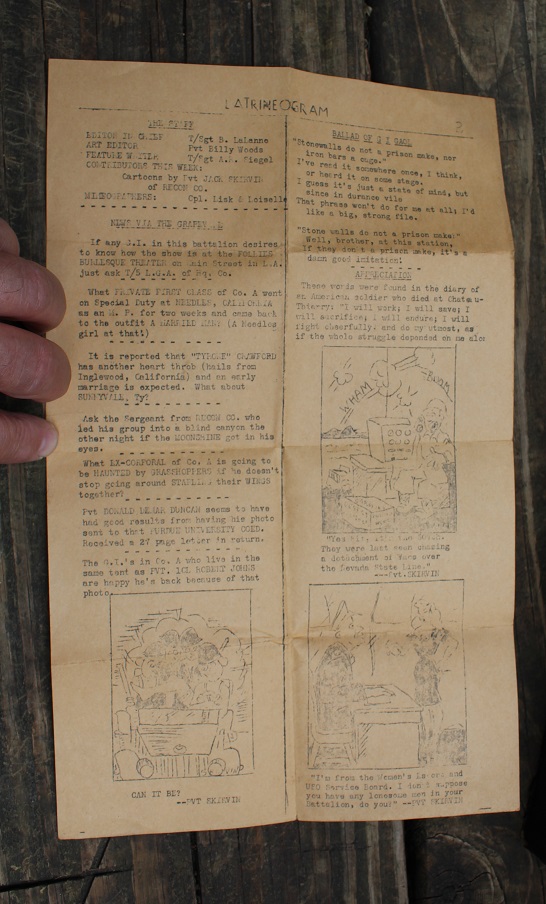
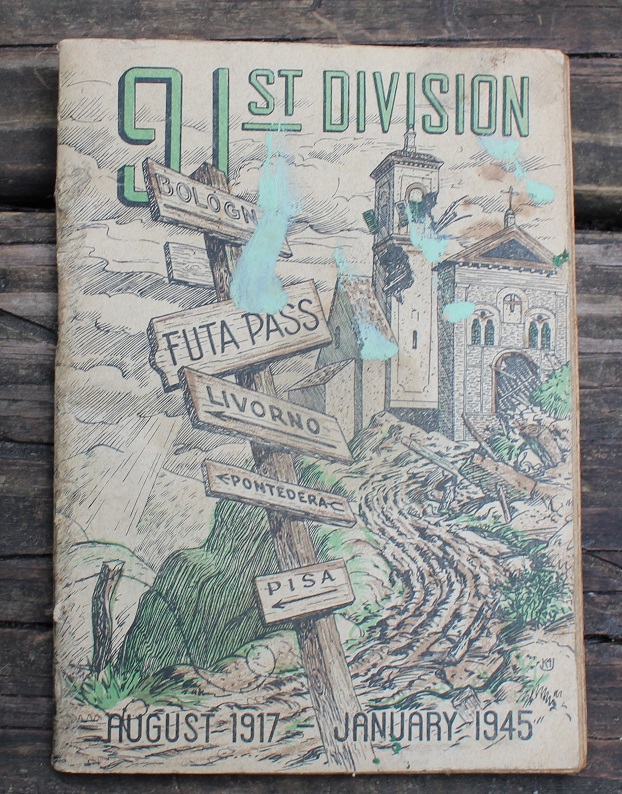
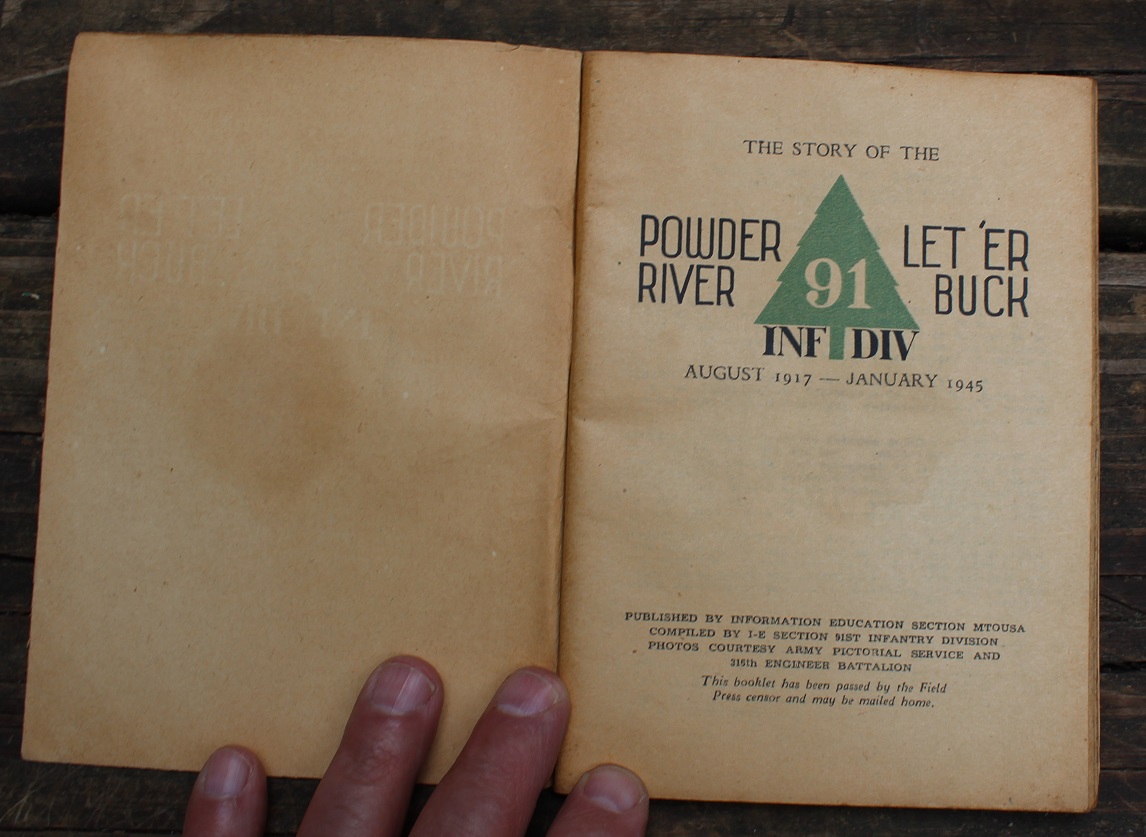

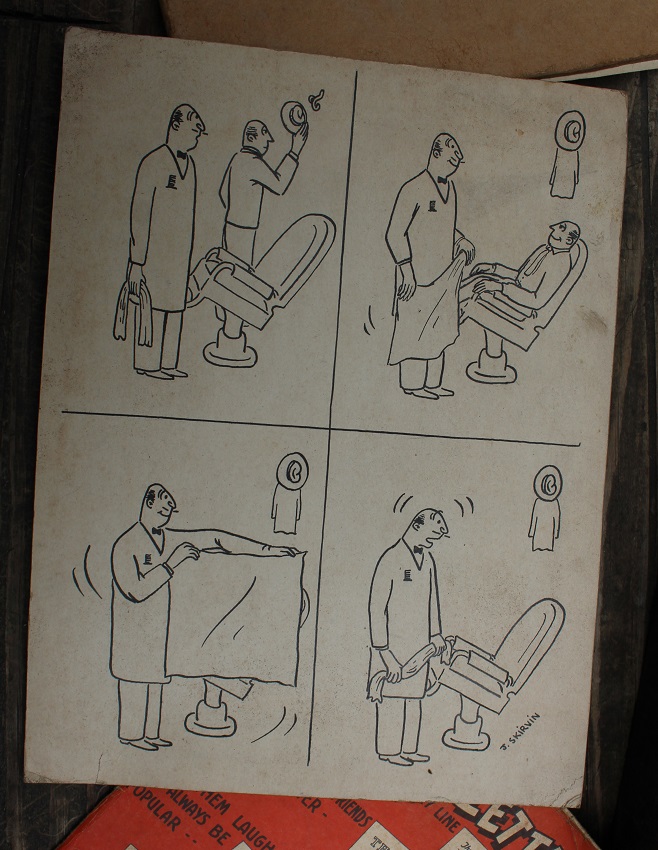
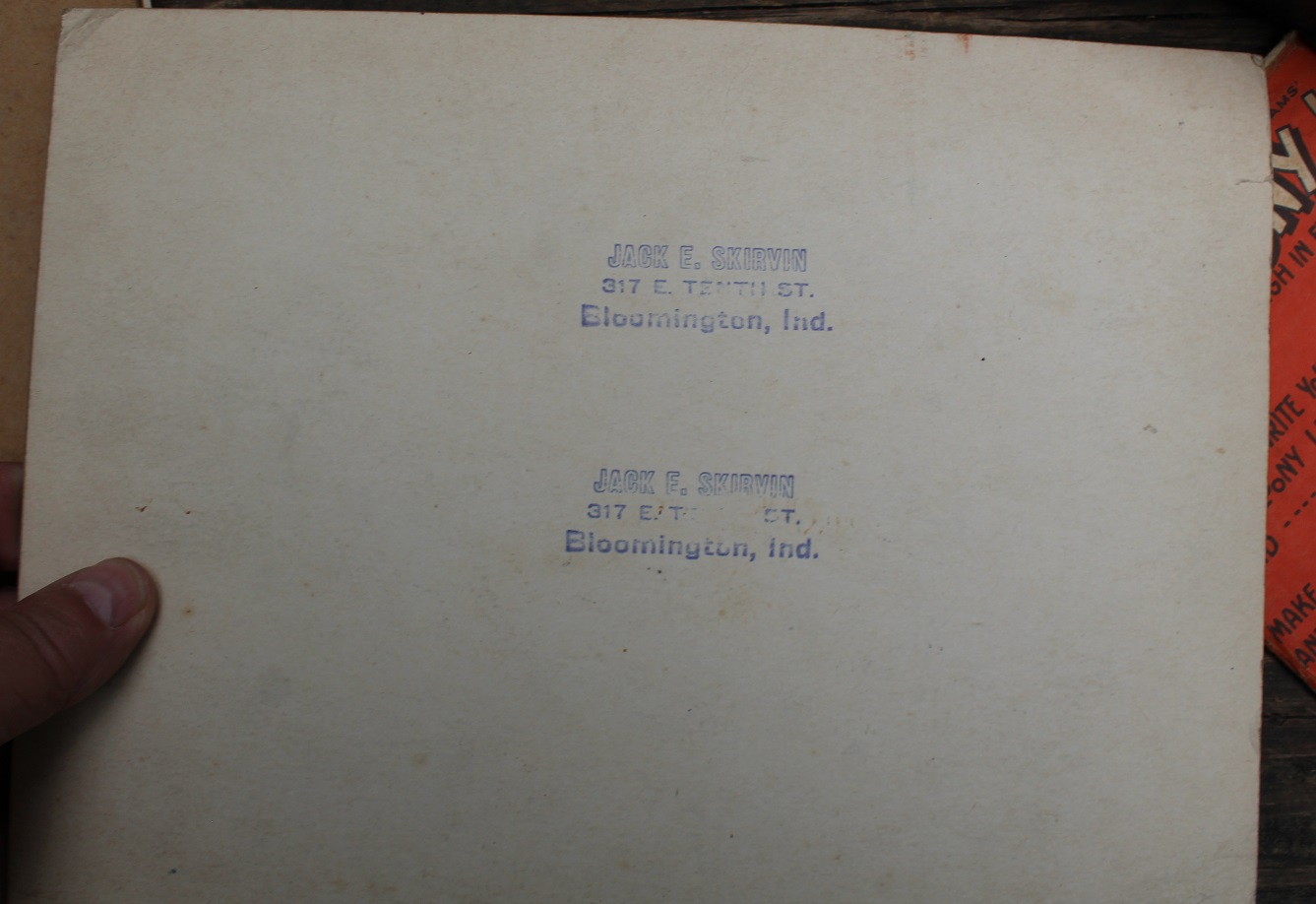

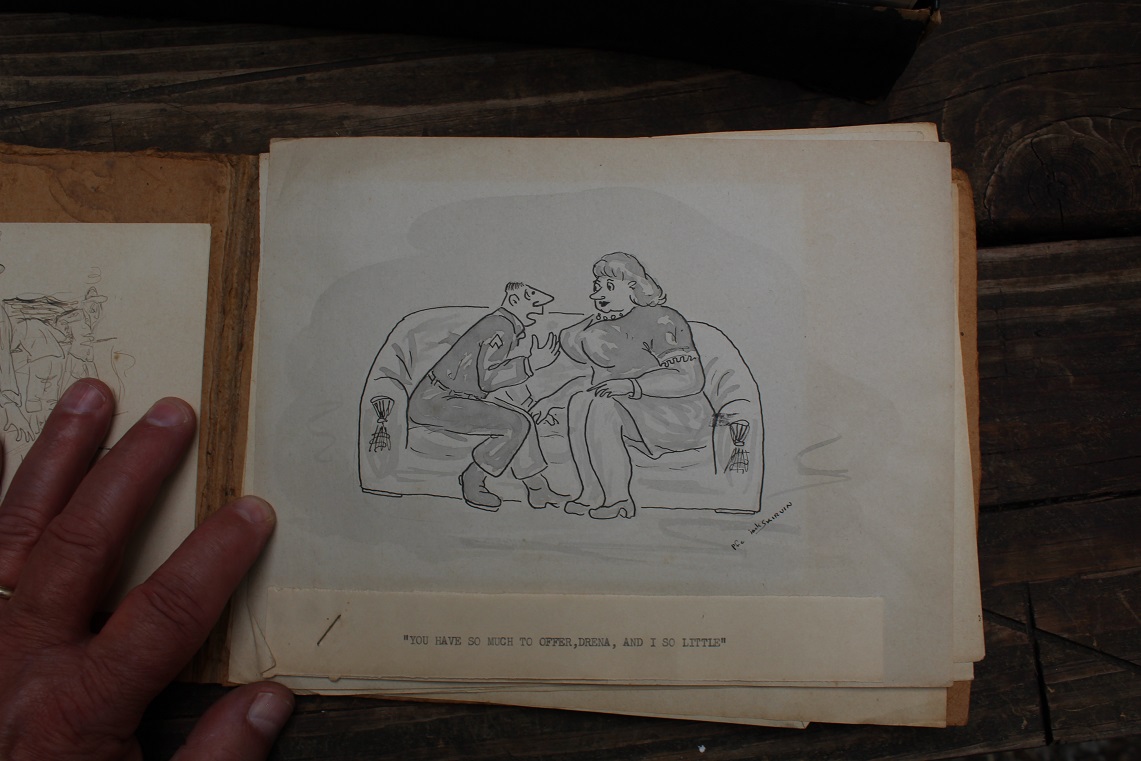


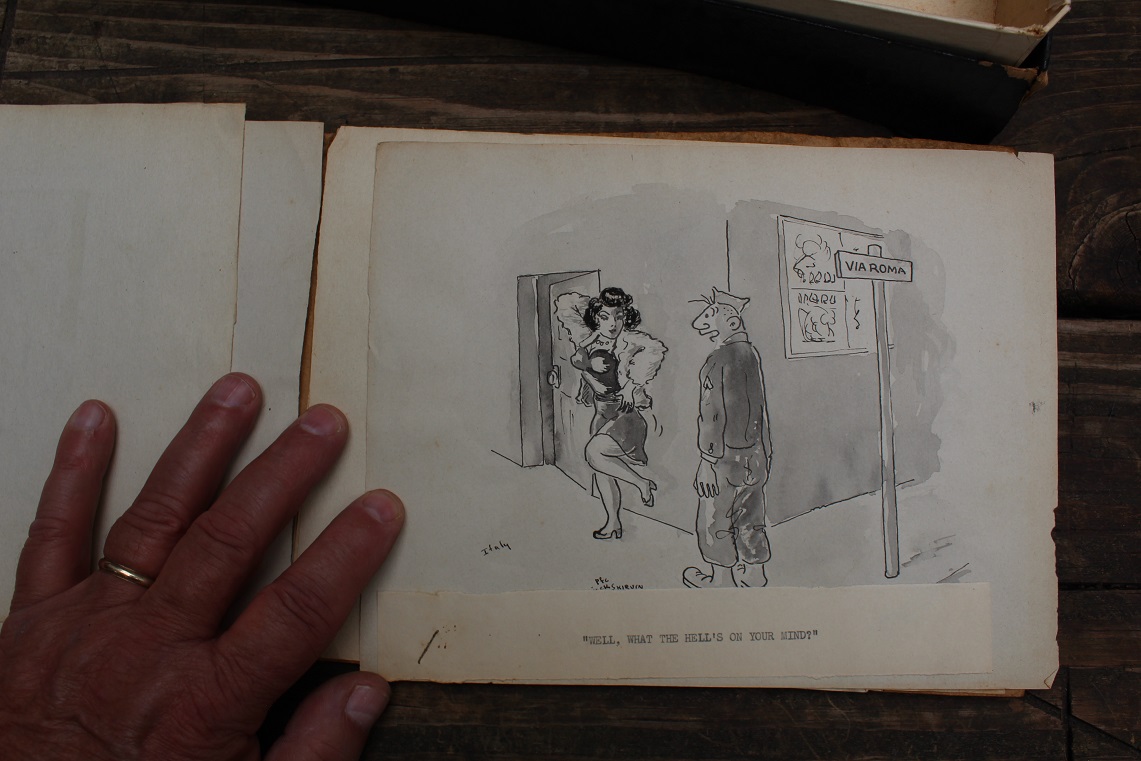
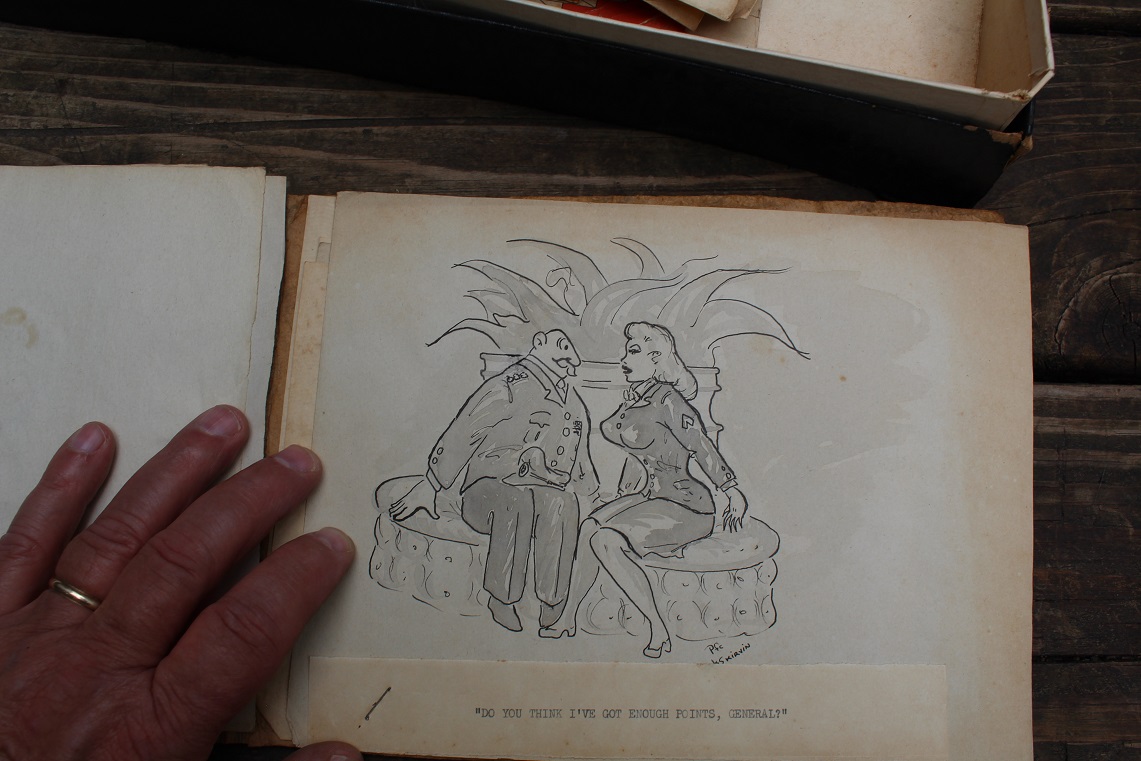
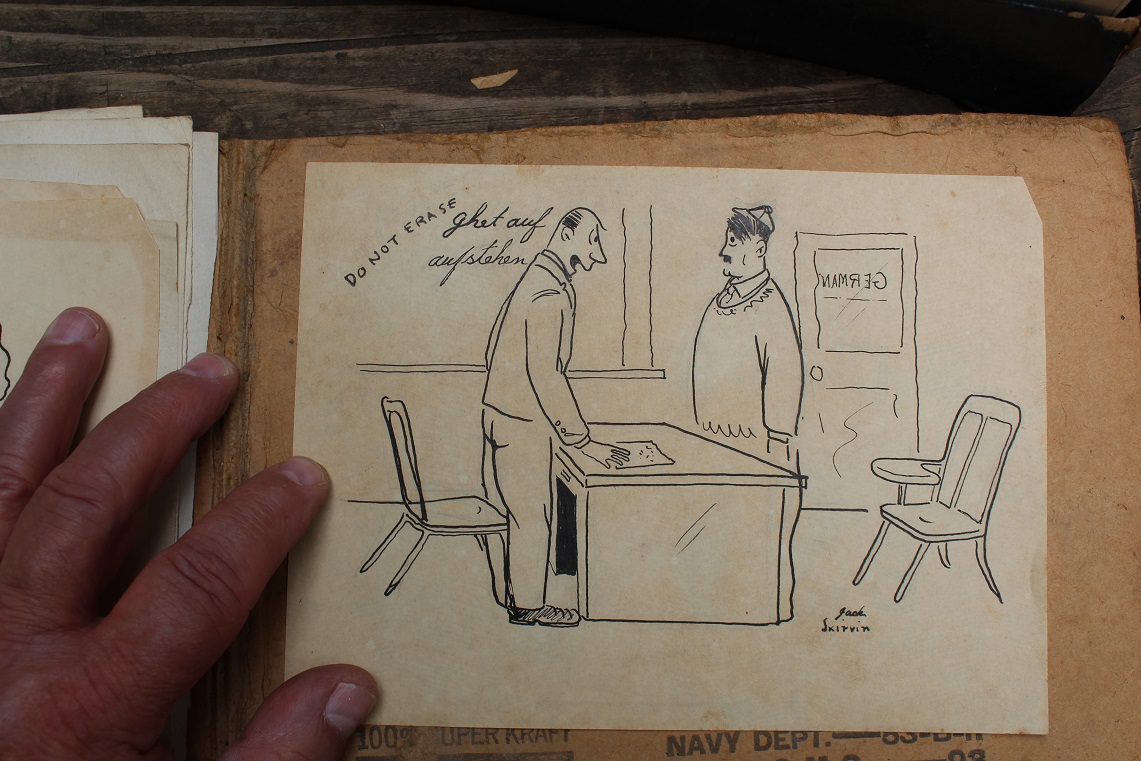
__________________________________________________________________________________________
tc 1907 Bayonet
SOLD!!!
The Pattern 1907 bayonet, officially called the Sword bayonet, pattern 1907 (Mark I), is an out-of-production British bayonet designed to be used with the Short Magazine Lee Enfield (SMLE) rifle. The Pattern 1907 bayonet was used by the British and Commonwealth forces throughout both the First and Second World Wars. This particular bayonet has the clearing home on the pommel. This hole made it possible to see the forward edge of the bayonet boss indicating the effectiveness of the bored hole in allowing an egress for fouling that may otherwise prevent correct fitting of the bayonet on the rifle. The blade has been sharpened as seen in the pics. There are many markings on the ricasso as one would expect. The scabbard is in good original shape showing wear consistent with the bayonet. The scabbard is complete. The wooden grips are very nice and this bayonet is complete. For this WW1 Bayonet $125.00
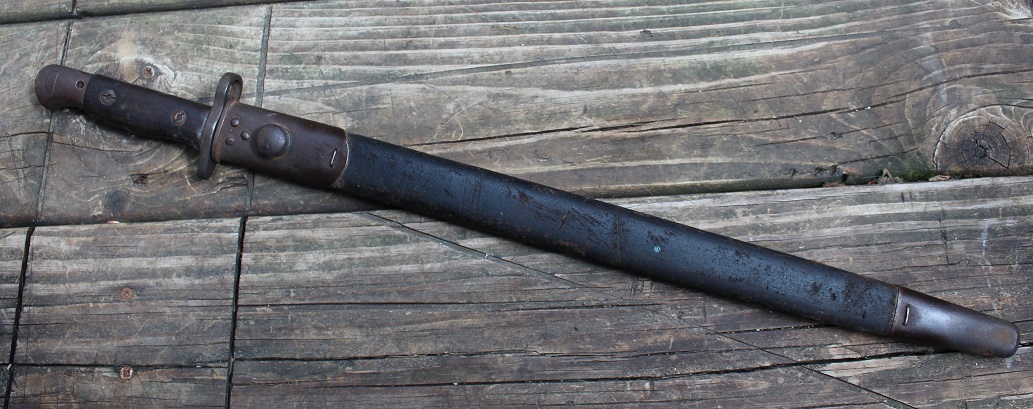
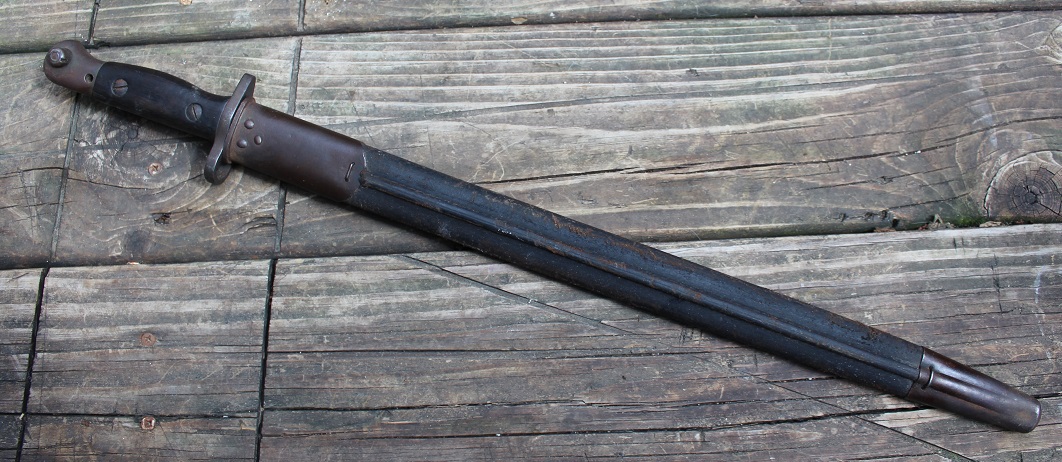
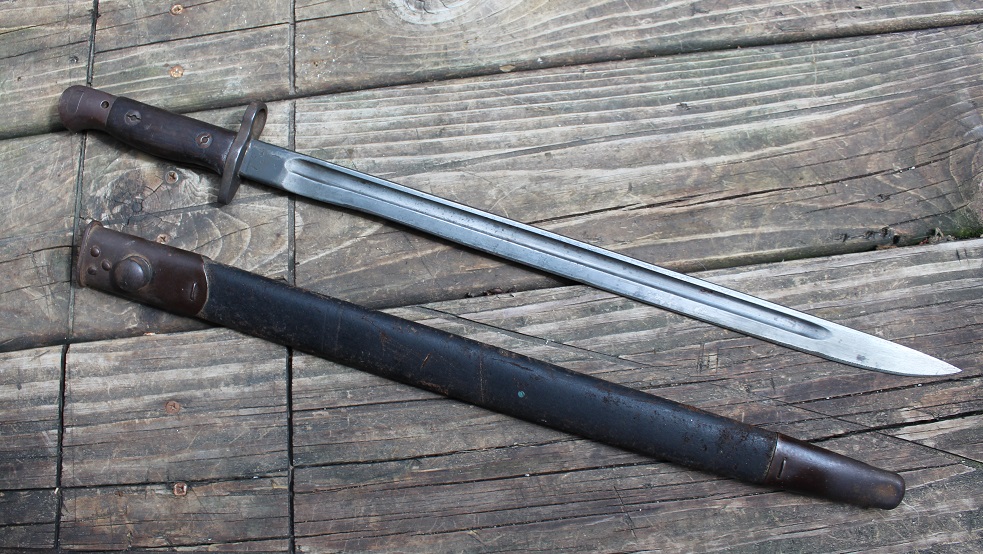
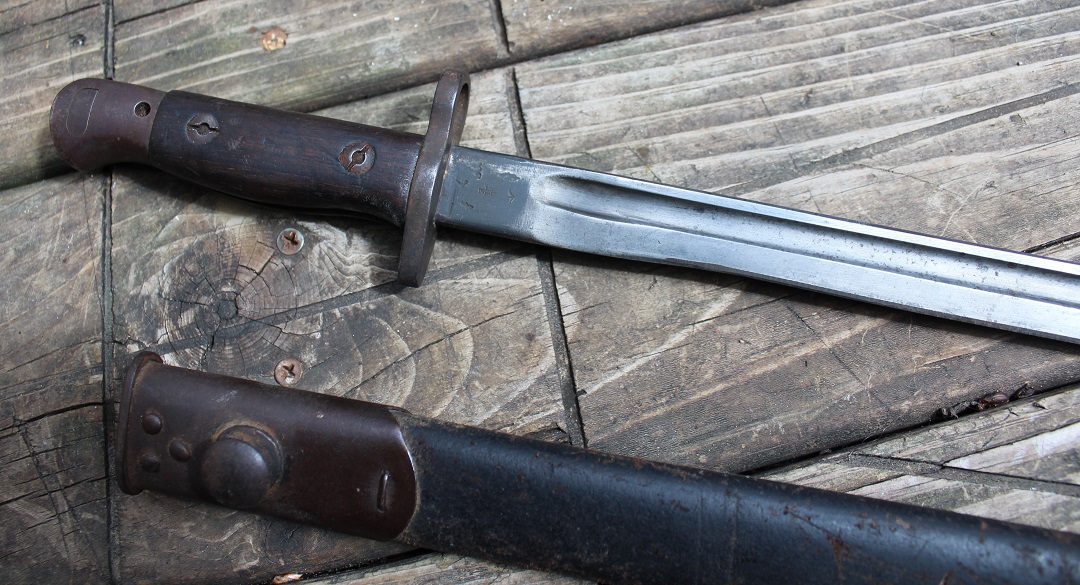
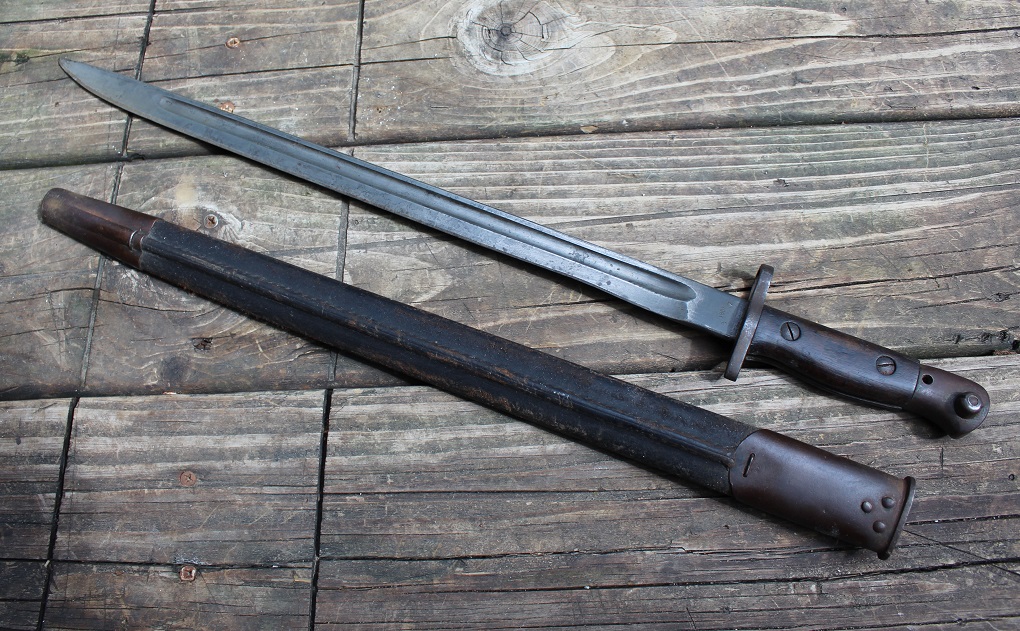
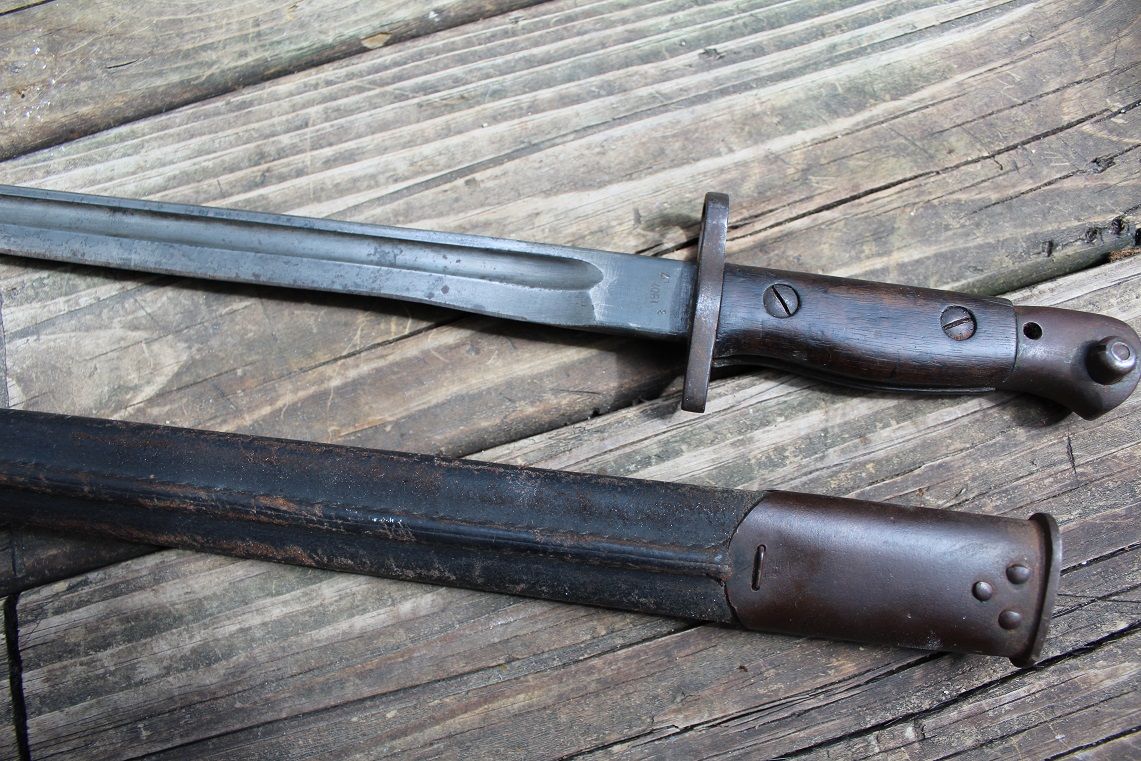
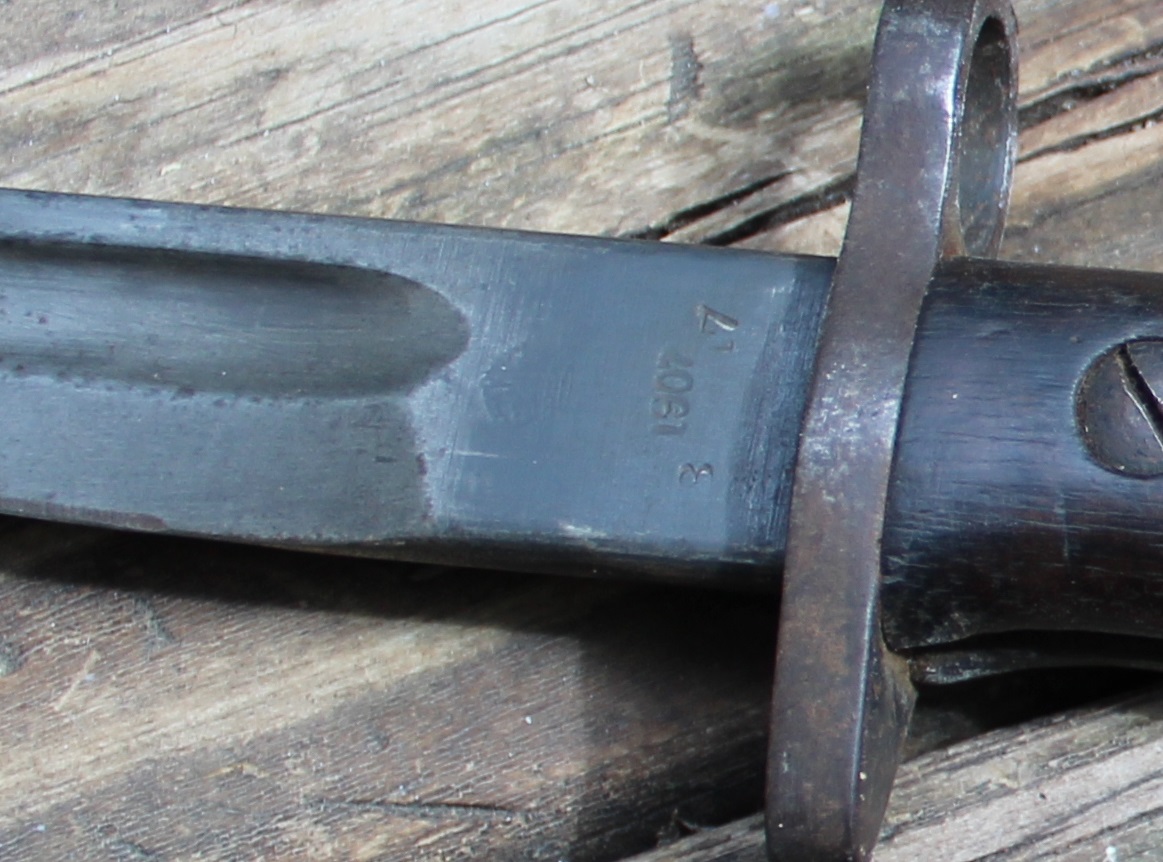
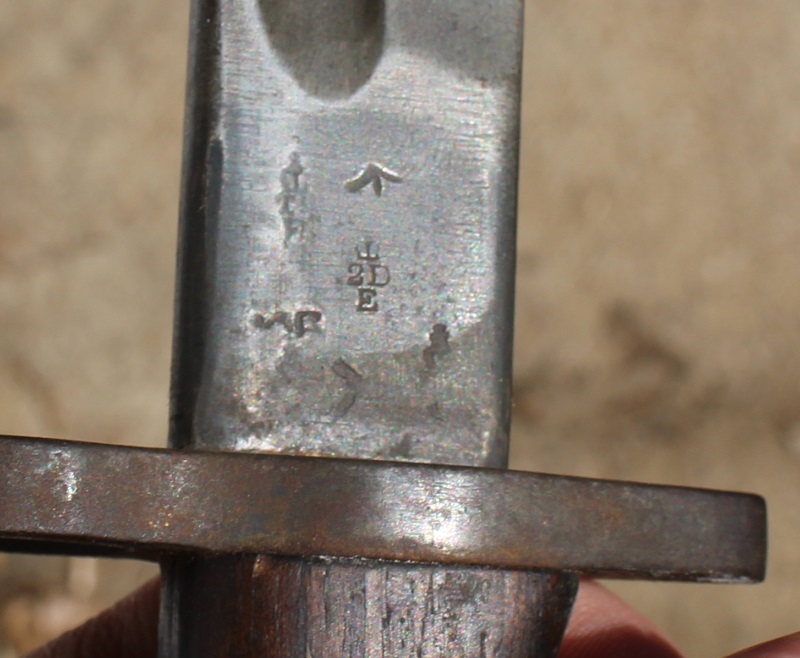
__________________________________________________________________________________________
tc paratroopers knife
SOLD!!!
Here we have a Vietnam era Pilots / Paratroopers knife. This is an excellent service used example of a Vietnam War issue Schrade Paratrooper and Pilot knife, with correct orange plastic "jigged bone" handles. These differ from the WWII and Korean war issue knives in that they have a second blade, specifically designed to cut cords. This would be used to help free the owner from tangled parachute rigging, or even their harness if they were a helicopter pilot. The black plastic was replaced with orange to make the knife easier to see in low light conditions. During my years on the Fire Department here locally our Fire Chief, who was a Vietnam veteran who served in the Air Force and did several parachute drops, carried one of these on him. He showed it to me proudly one day and I thought this was one neat knife!
This example is in fully functional condition and comes complete with a bale (ring) on the end for a lanyard. This would ensure it wasn't dropped when being used to cut through parachute rigging. This knife is in excellent condition and doesn't look like it was used at all! The blade is brite with the correct deep markings and has not been sharpened. The cord cutting blade shows no use at all! If you want an excellent example then this is for you! You won't find better! Check out the pics! $175.00
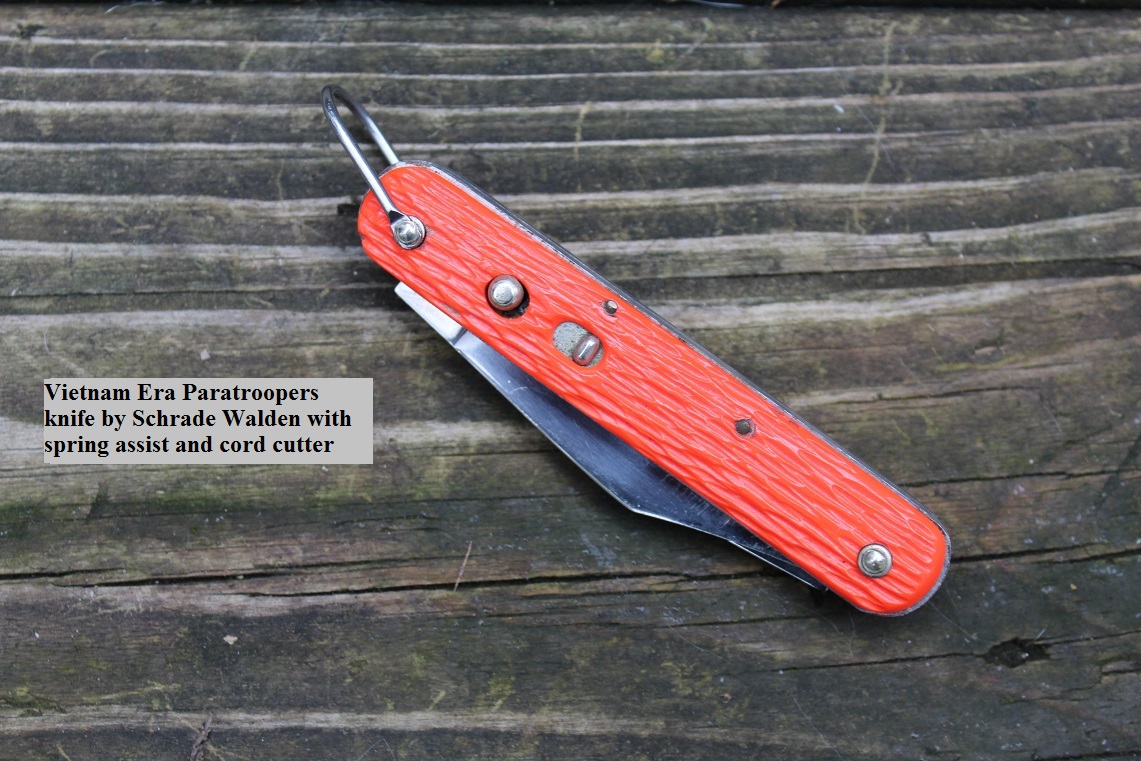
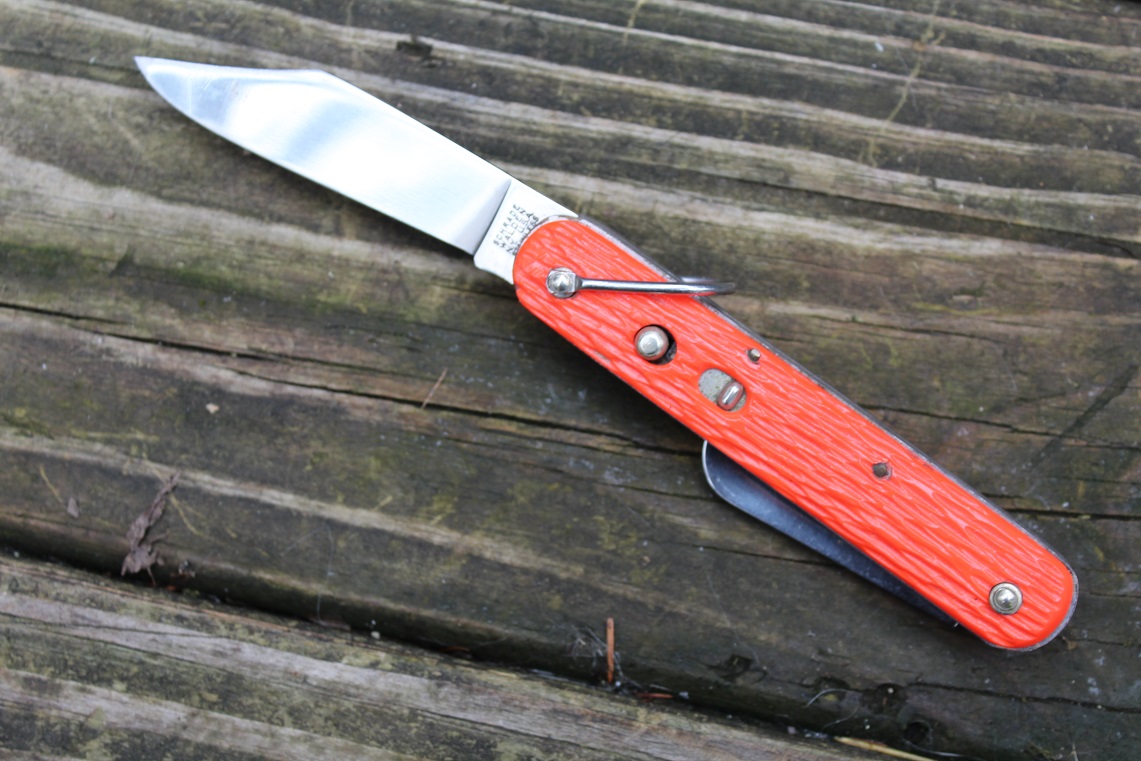

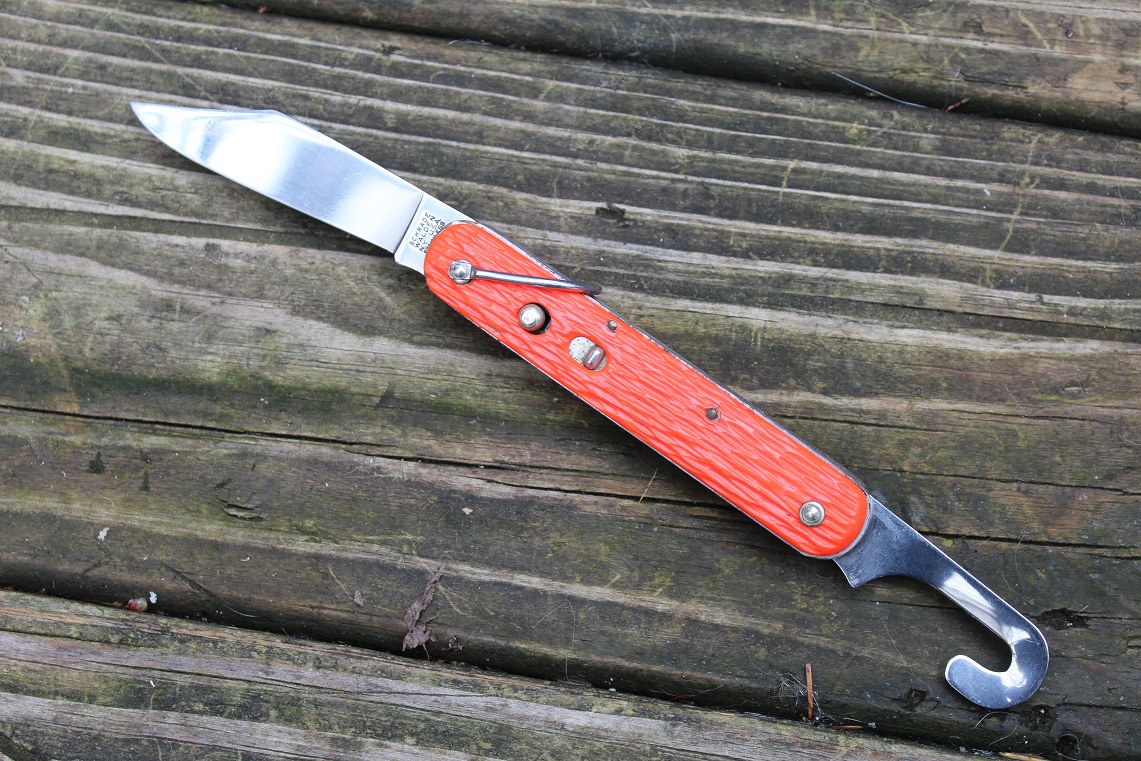
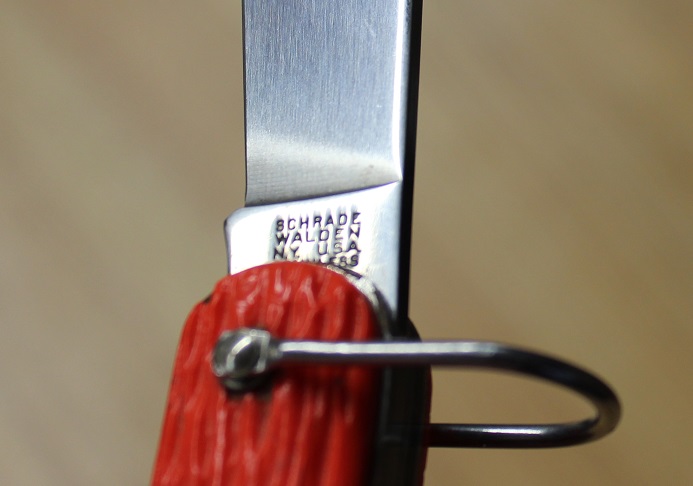
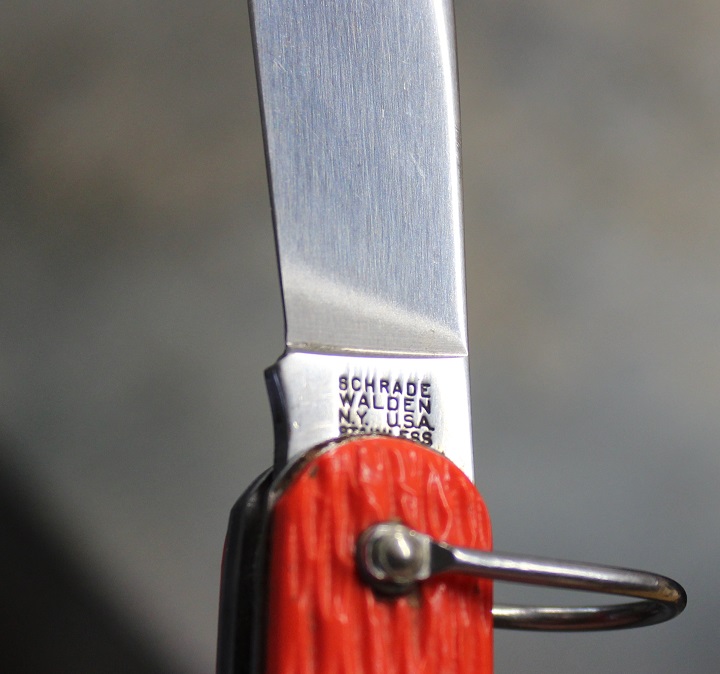
_________________________________________________________________________________________
TC ww1 vet grouping
SOLD!!!
Here is a small grouping that I picked up locally in central Indiana. The lot consists of two caps. One is the garrison cap in Red, White and Blue showing VETERANS - WORLD WAR 1 - U.S.A. size 7 1/8th with little war to it. The other garrison cap is the veterans American Legion Cap with the 45 in star designation and marked with the 133. THere are many small American Legion Membership year pins attached to this cap, actually 9 of them and 5 other pins designation dates from 1933 to 1959. The hanging medal is designated with Emery S. Conner's name and honors his for 36 years a member on 4-1-54 (1954). This cap was used quite a bit and has the initials of E S C stimple punched on the sweatband. I believe that the family removed the grave marker from his grave when a stone was installed. I will sell you the two hats and give you the grave marker. For the Hats along with all decorations on them $75.00 Check out the pics!
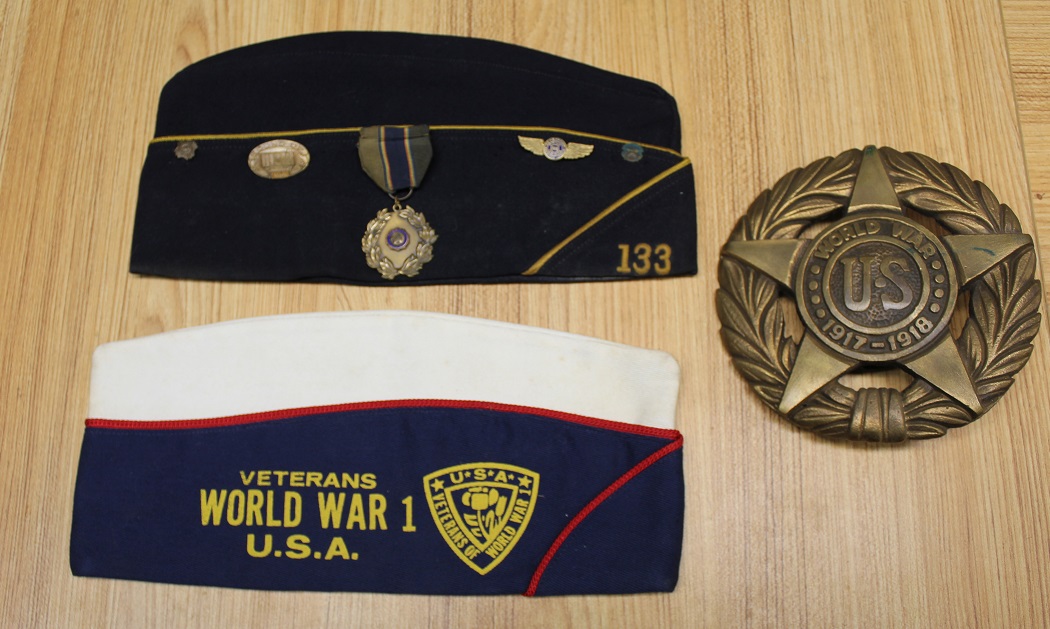

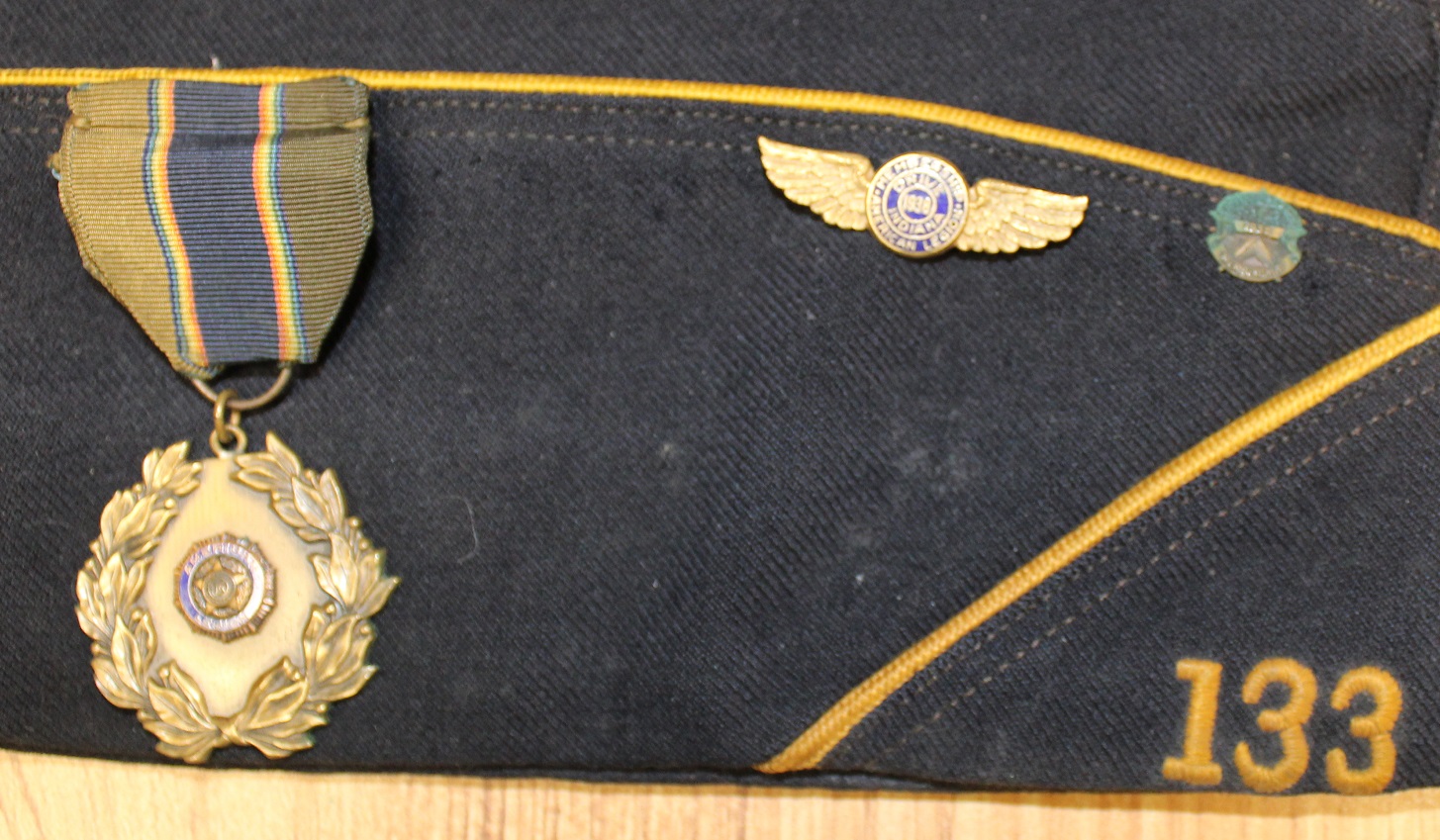
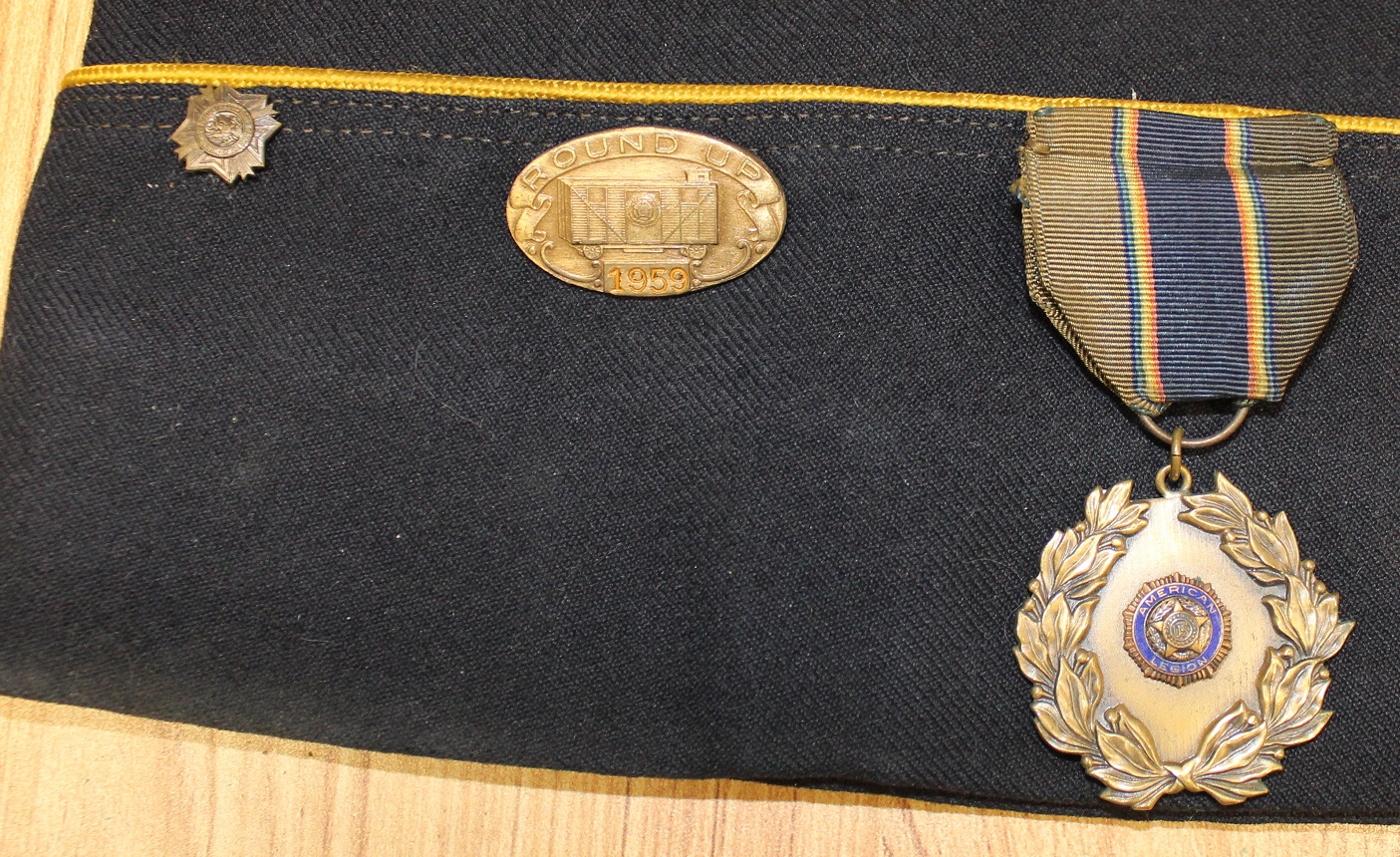
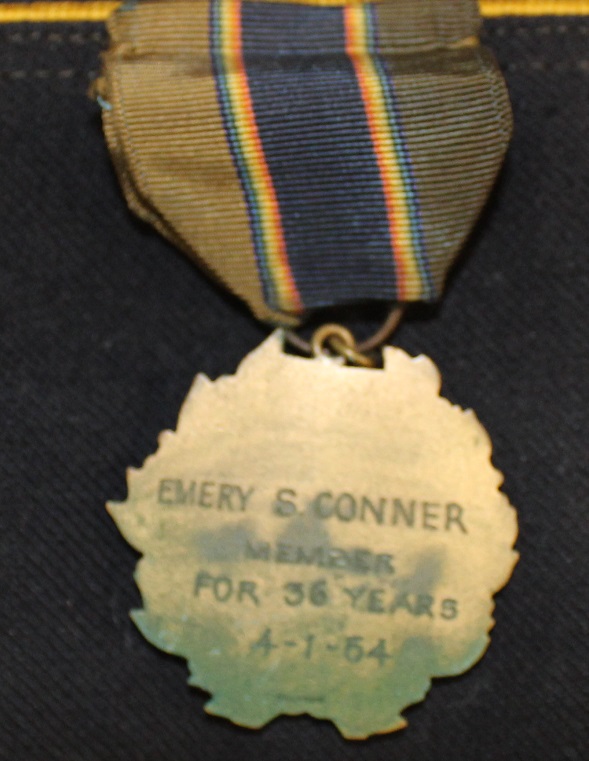
__________________________________________________________________________________________
tc 1902 US sword and scabbard
Here we have a very nice original Vietnam era 1902 Army Officers Sword in scabbard. This one was done by N.S.Meyer. N.S. Meyer was a military paraphernalia company until it went under in the mid-1990s. Meyer imported complete swords from Eickhorn (Germany), among others, both before and after the war and marketed them under various brand names according to fit and finish. "Spartan" was one of these trademarks. The "Spartan" trademark was applied for in 1955 and was used well into the 1970's. This sword pattern was adopted for all officers, except Chaplains, in 1902, with the guard specified as nickeled in December. This one is complete and in good condition with some rubbing and freckling to the finish on the scabbard. This sword must have been kept in the scabbard because the blade is darn near mint! The etching is dense, very strong, and vivid, with regulation geometric and floral motifs, crossed flags and cannon, and a blank panel for addition of a name or presentation. The U.S. is rendered in entwined letters on the reverse, and the American eagle on the obverse is rendered in the form of the Great Seal. The back edge of the blade is also etched with a leafy vine. There is absolutely no damage or nick to this blade! Fantastic Condition!!
The red leather blade pad in place under the guard. The obverse ricasso has a six-pointed maker’s star with inset brass “proved” disc. The reverse bears the "Trade/Spartan / Mark” . A cursory search indicates Meyer registered the Spartan mark 6/20/1955, but he may have been using it earlier. It is recorded in use as early as 1931, though possibly by other businesses. I really don't know for sure. The bakelite grip is excellent and the nickeled guard is non magnetic. I had to take pics of the blade etching in a darker area as I could not capture the vivid condition of the blade due to the brightness of it! Take a look at the pics! $225.00

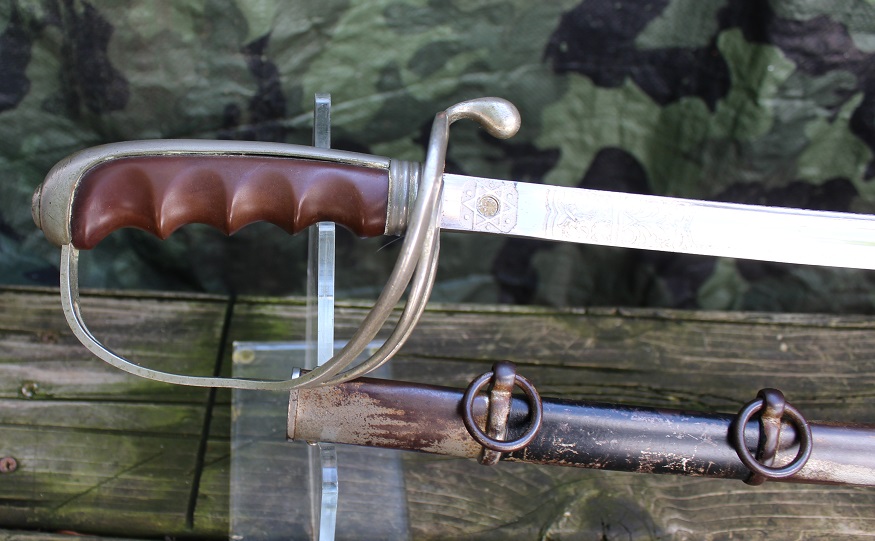

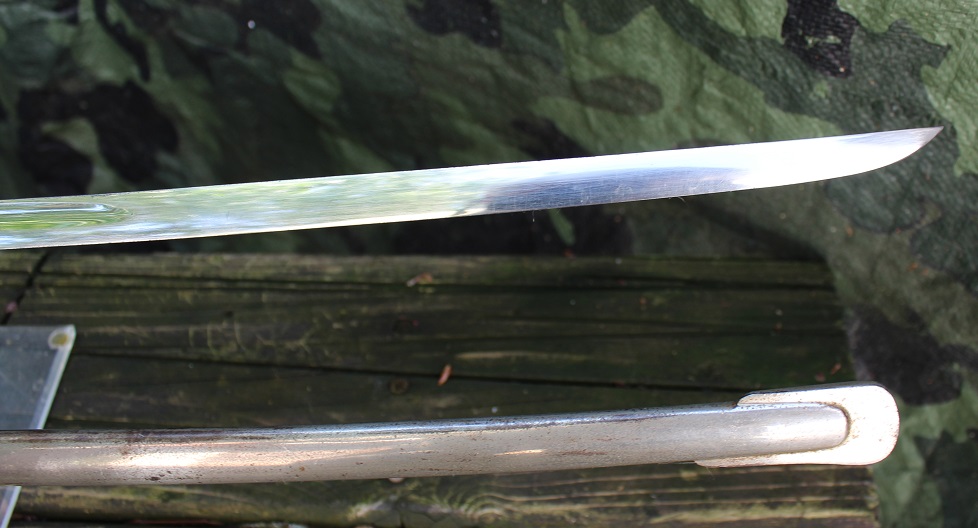

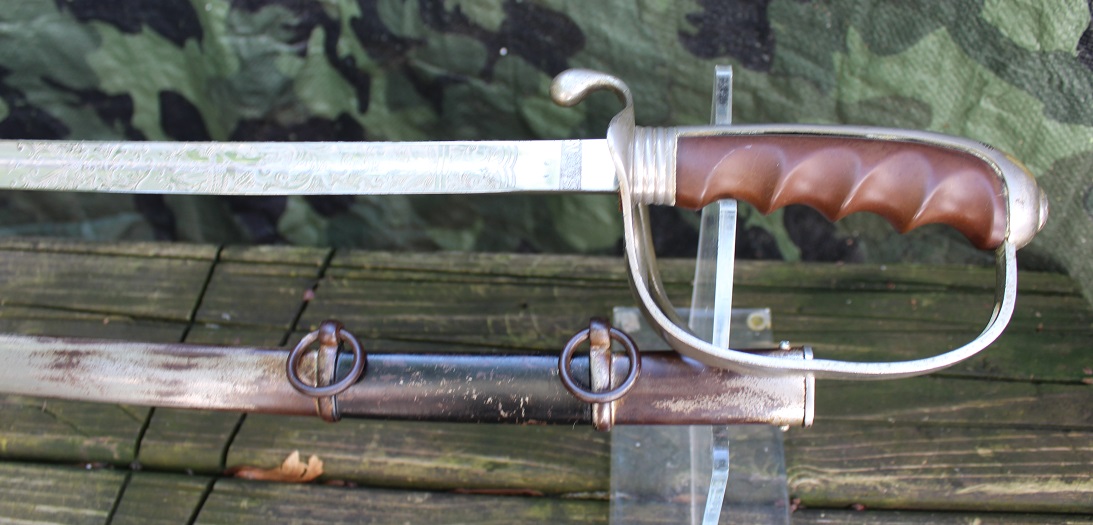

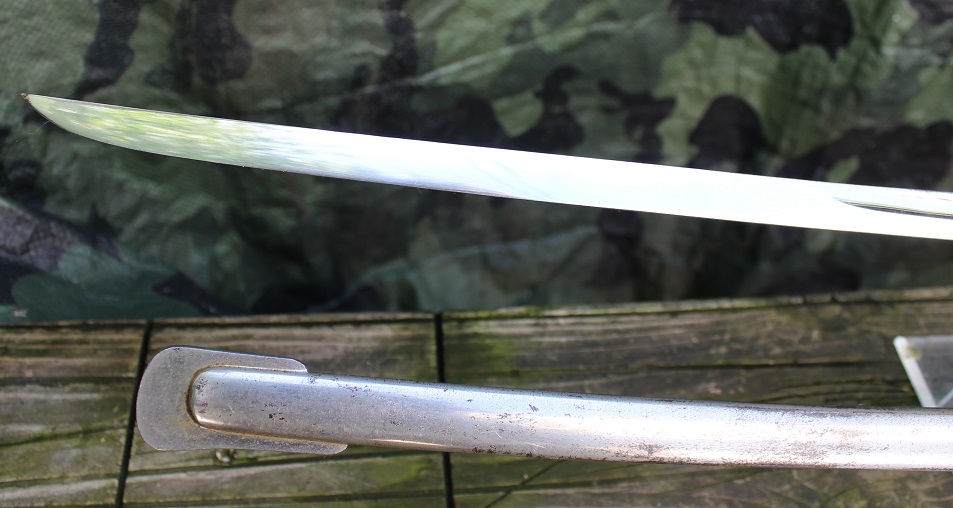
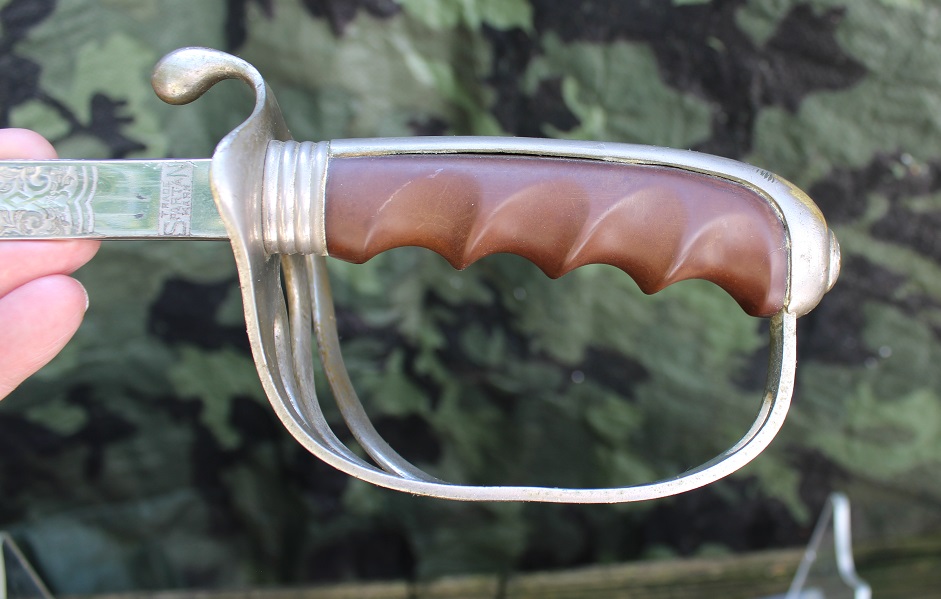
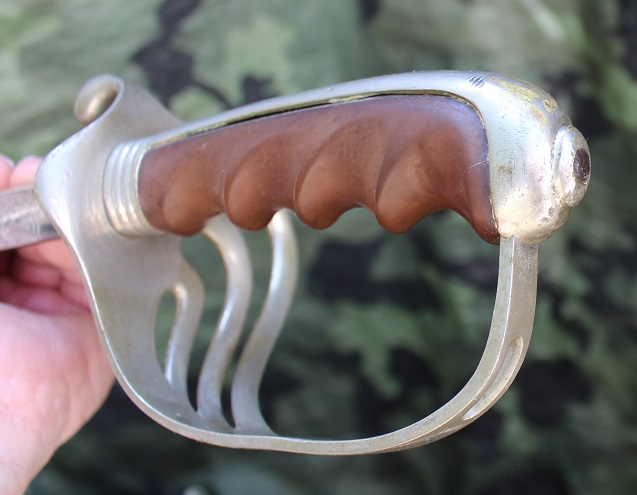
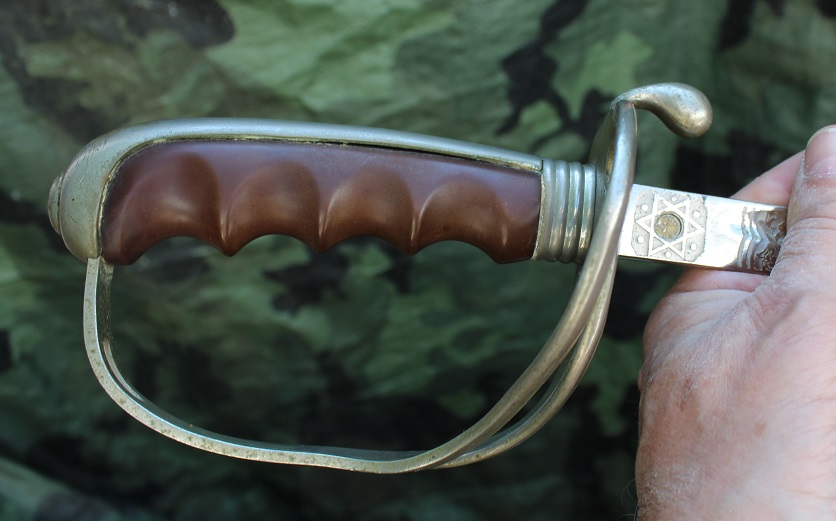
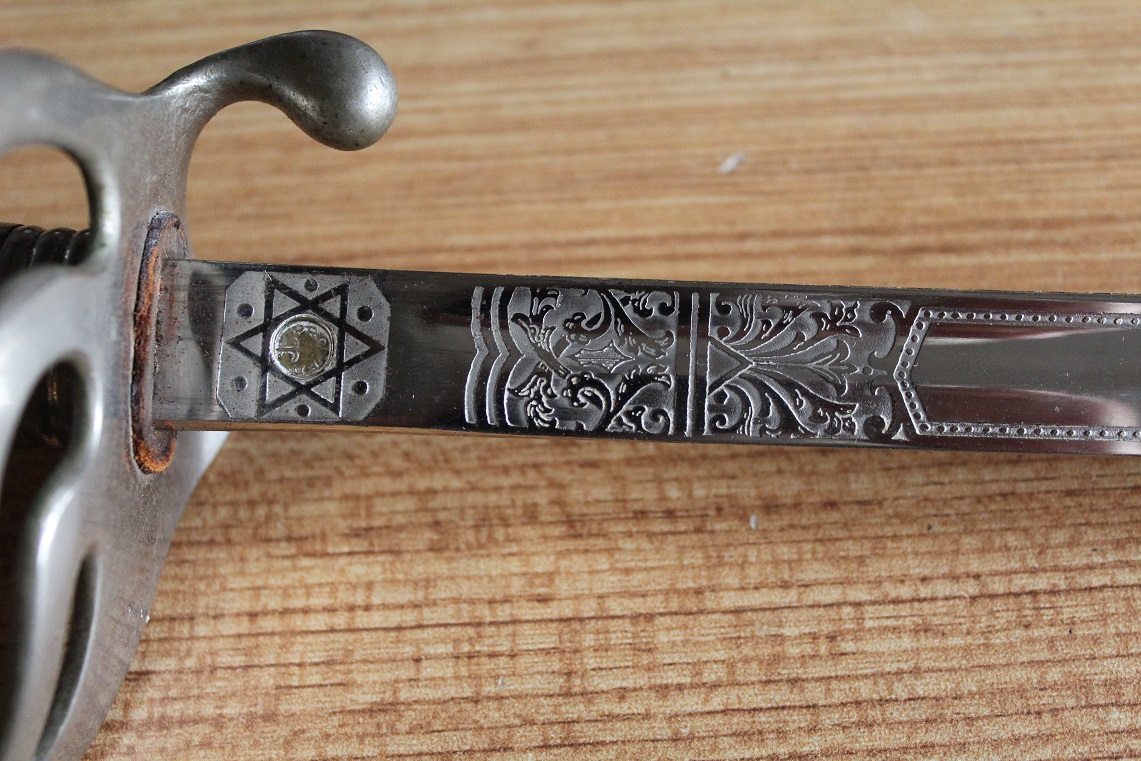




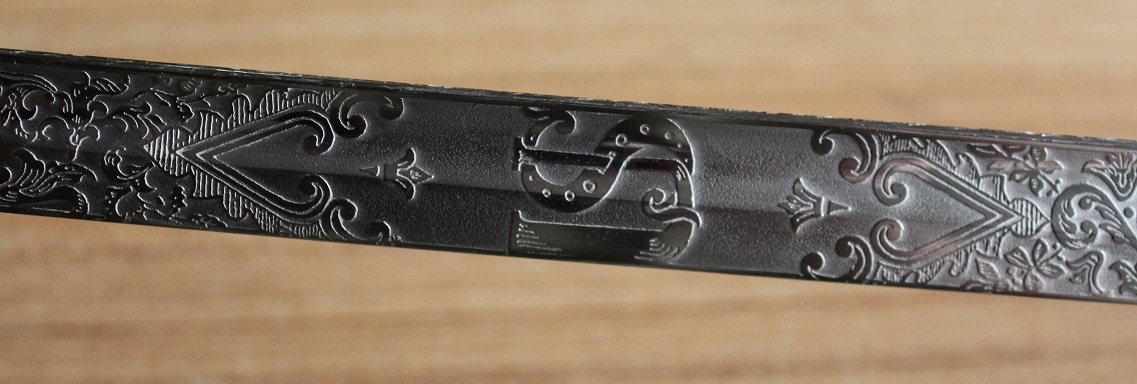
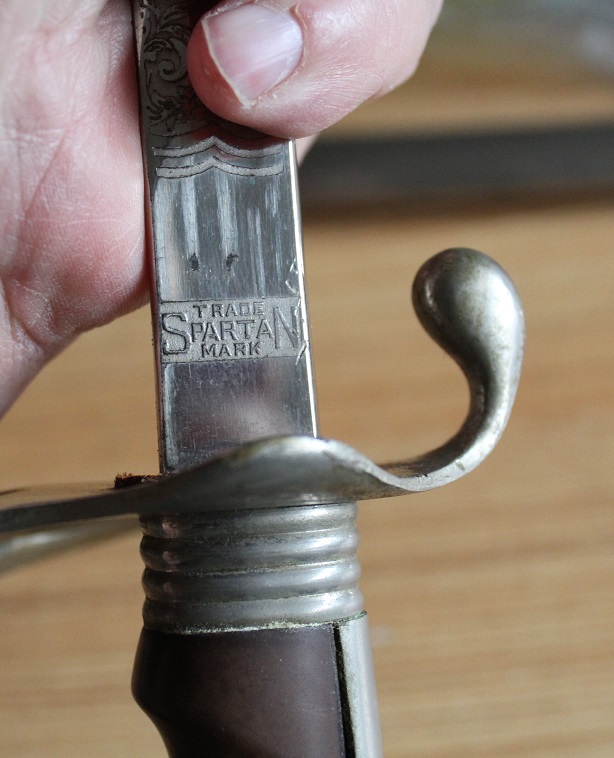
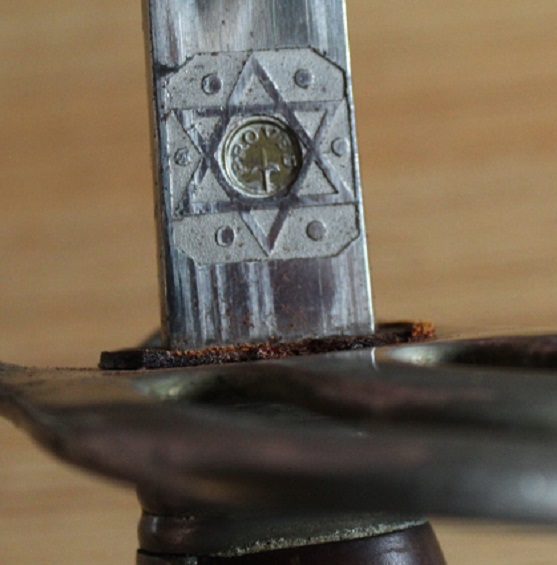
_________________________________________________________________________________________
tc WW2 Japanese Military Saddle
Here we have a WW2 Japanese Military Saddle! This is a WWI Imperial Japanese Army Calvary saddle. The design of this saddle is very effecient to repair. It is meant to be fully modular, with no nail or screws, all stitched and fully replaceable or to be able to add other items or gear to the saddle. This saddle is from the WWII era and is in incredible condition given its age. All leather, with some cracking, but nothing major. Has been well cared for over the years and this saddle could still ride if you wanted to fix a couple of the girth straps and purchase a girth. Canvas underside that is flocked with horse hair. The brass cropper ring/tab on the pommel is a really neat part of this saddle which instantly identifies it as Japanese. The unusual thing about this sadde is that usually they come with iron stirrups and no covers. This saddle comes with wooden stirrups and with leather hoods to protect the feet. I have seen one other like this and several with the iron stirrups. This one was probably used by an officer. It looks great and would be excellent in any WW2 Japanese Military collection! For this great old saddle $295.00 Note: my wifes quilt stand does not come with the saddle!
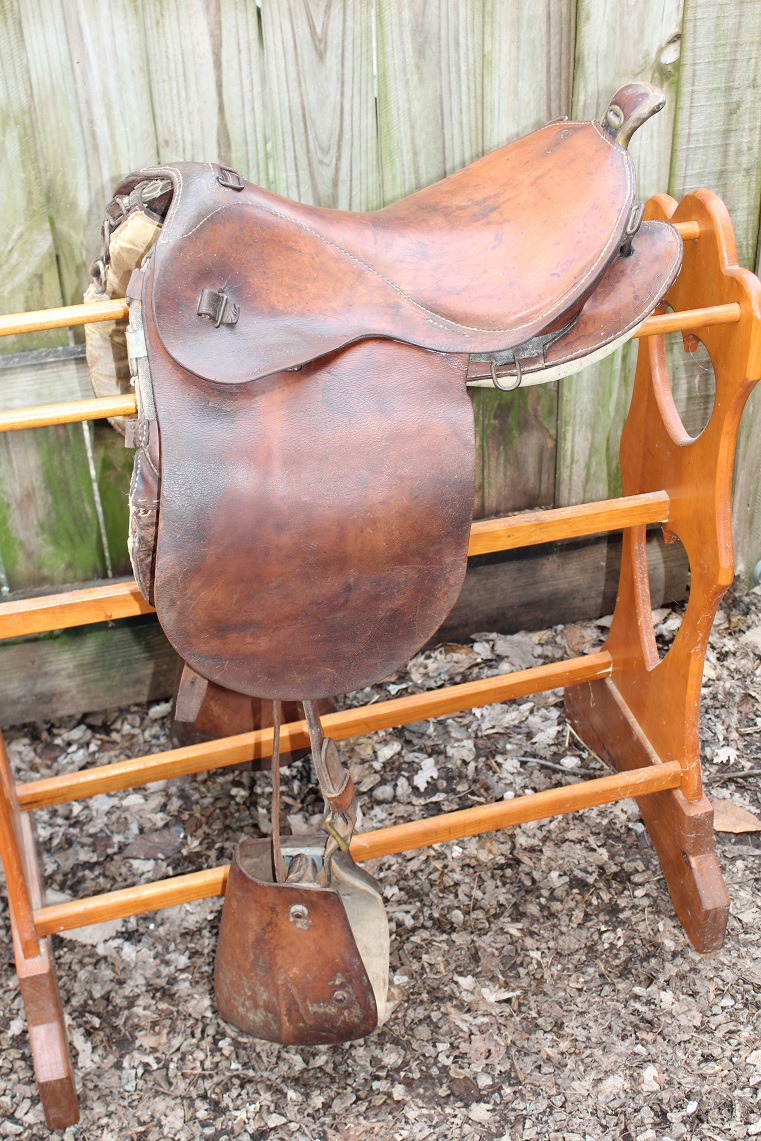
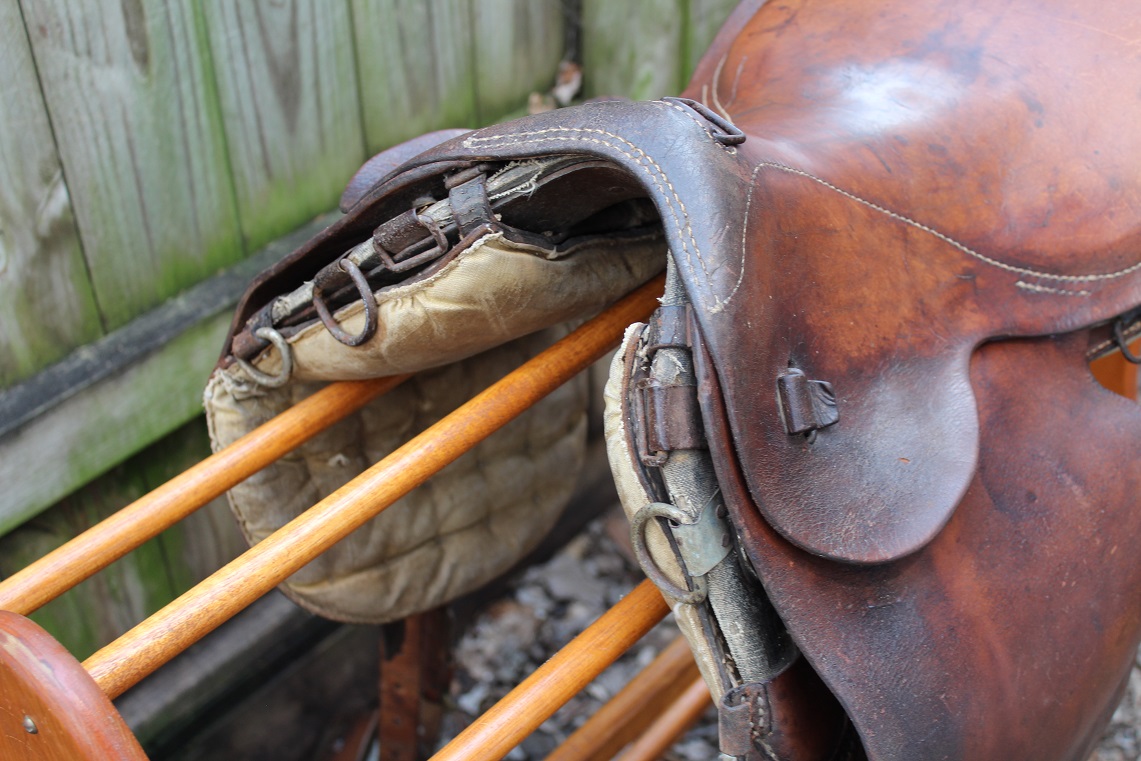
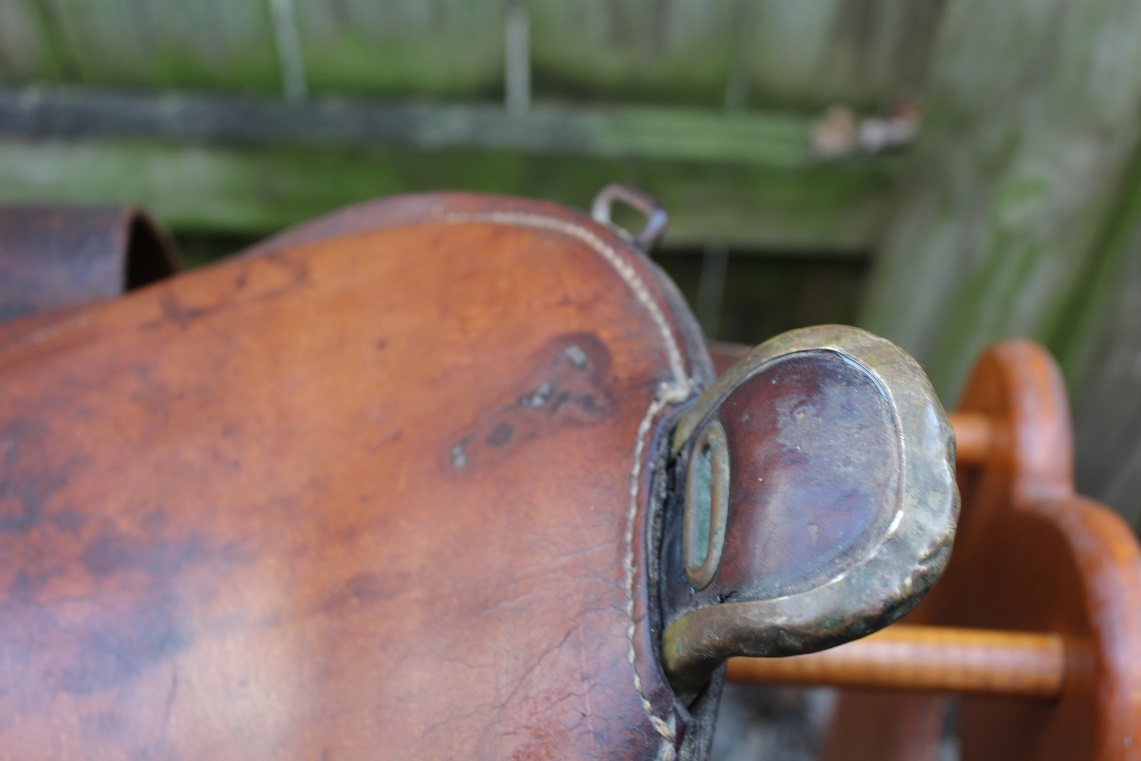
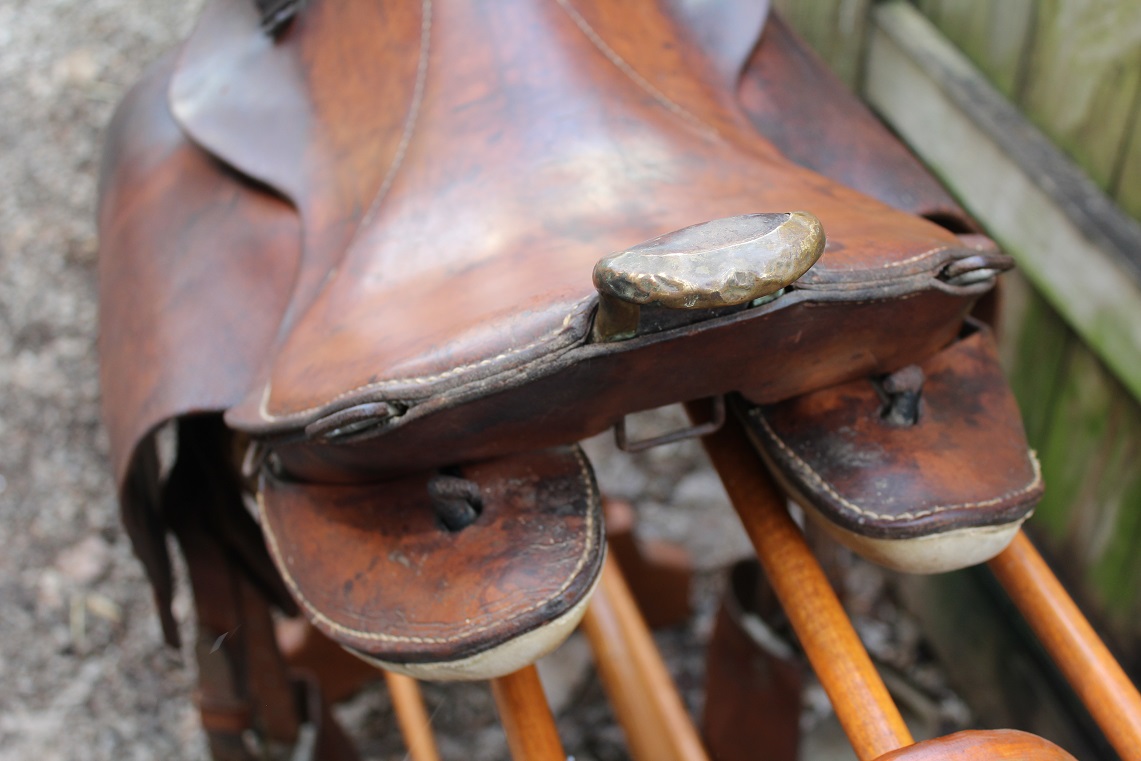

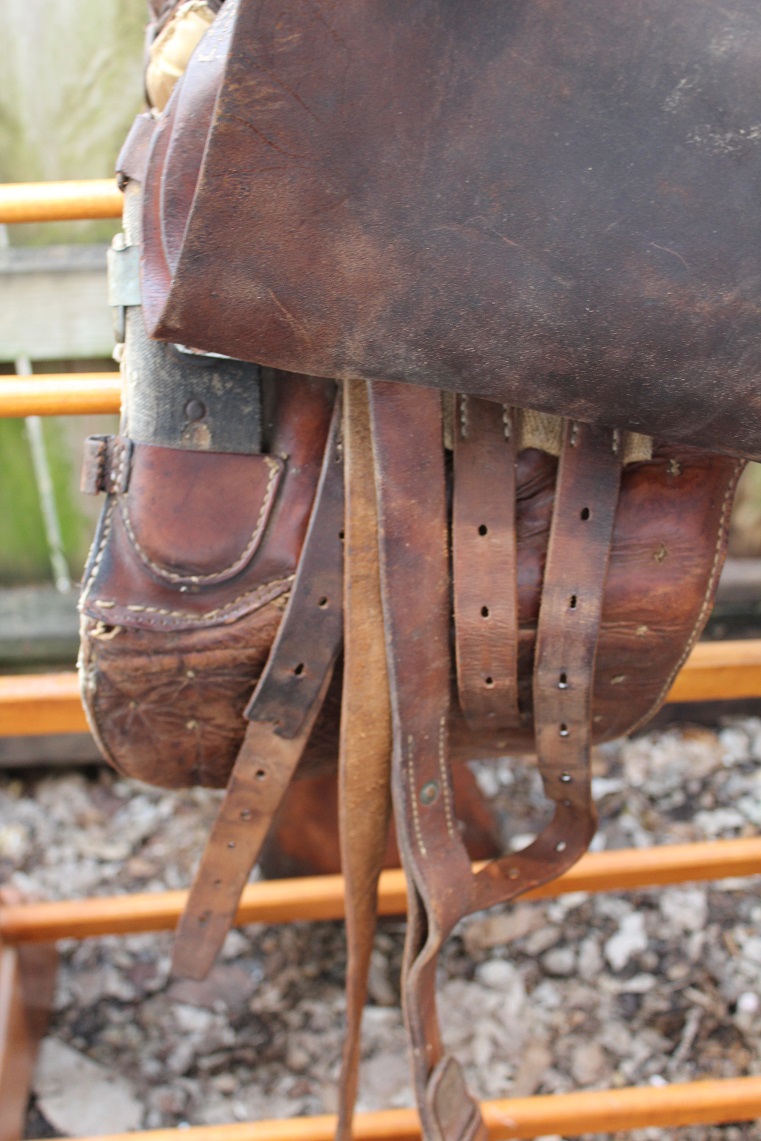


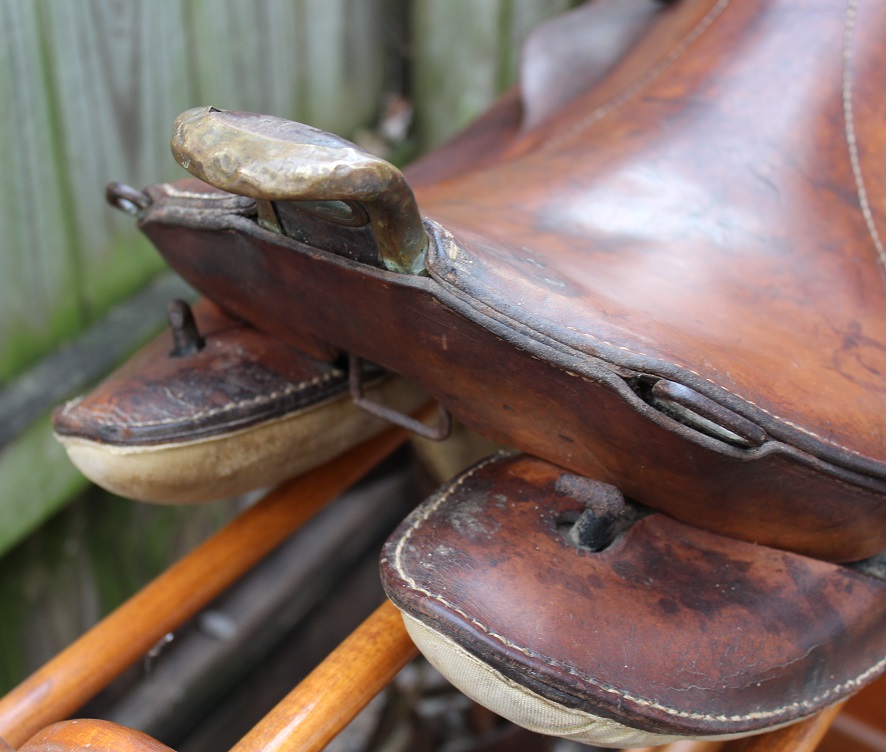
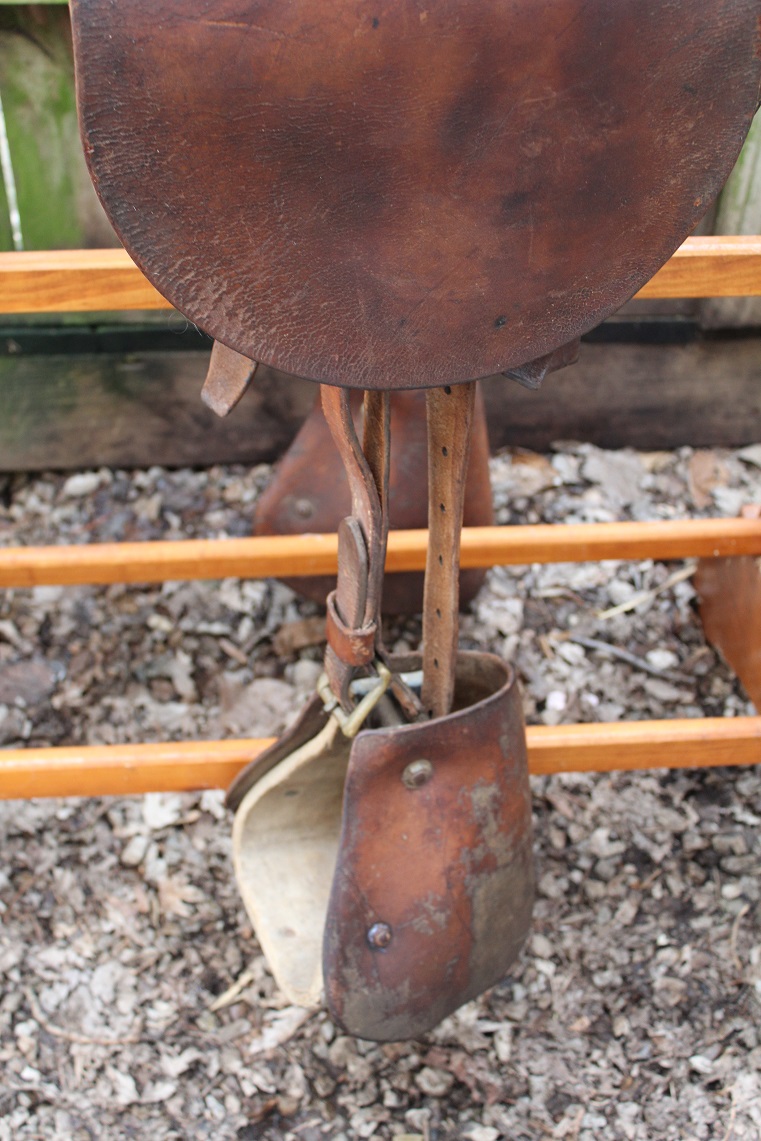
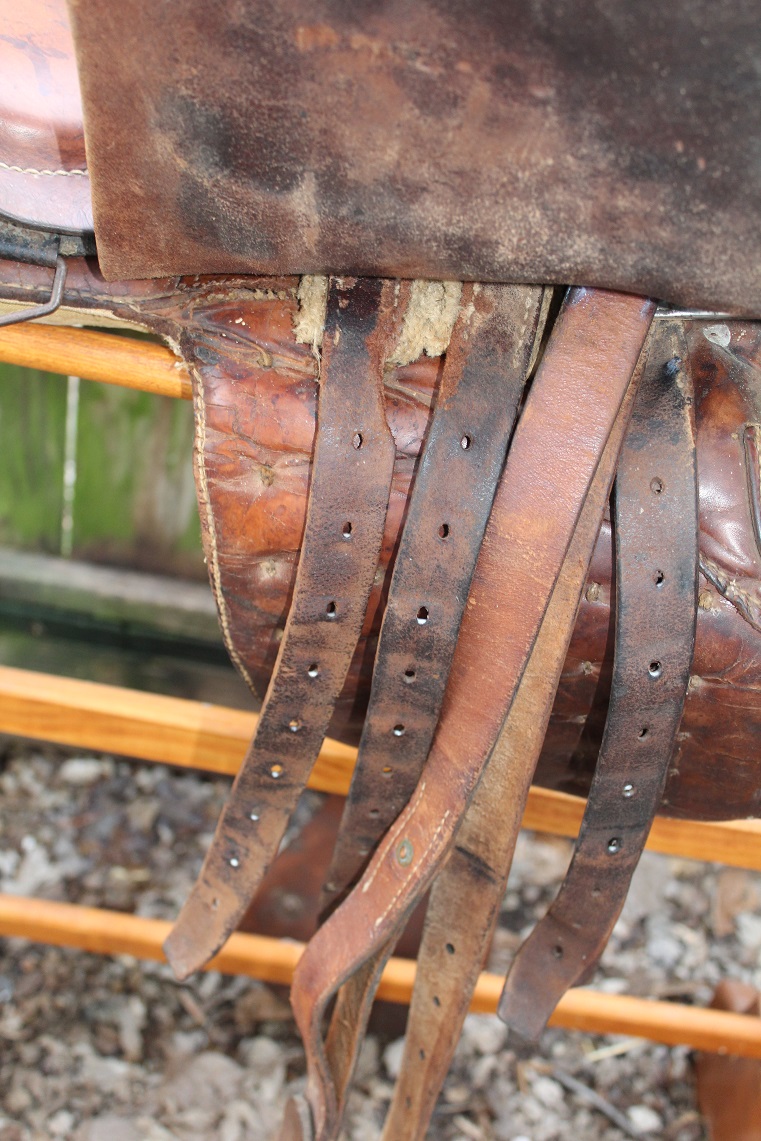


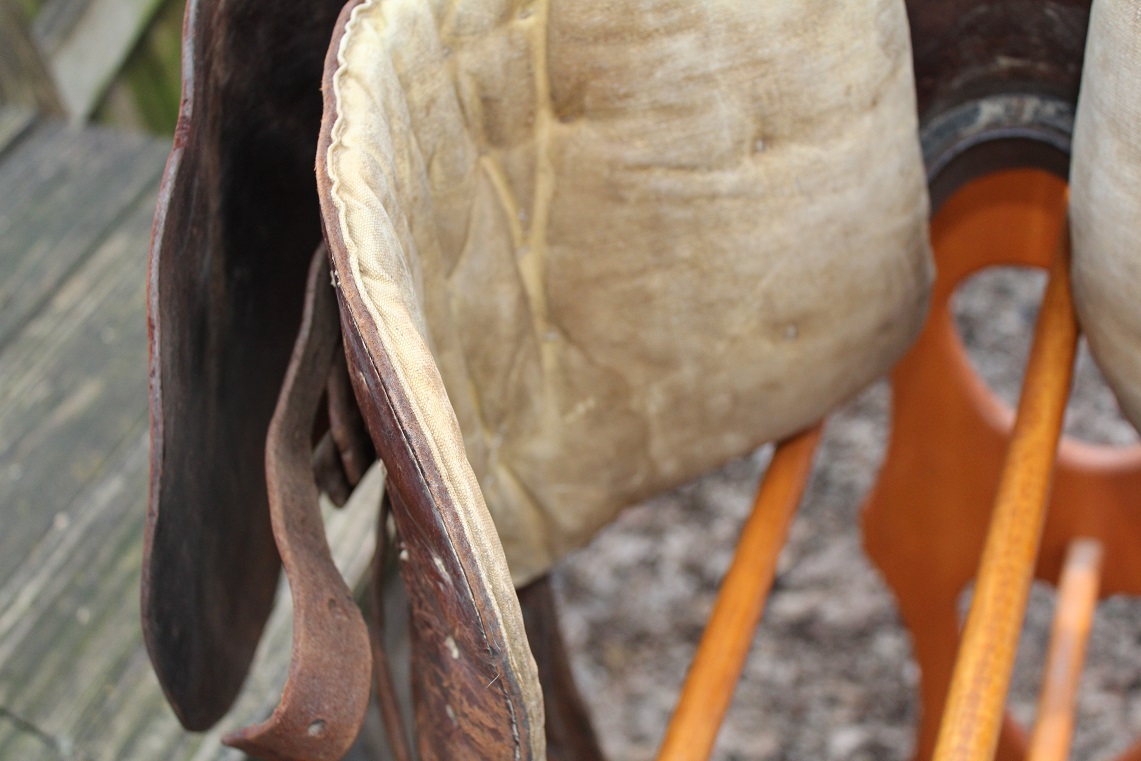
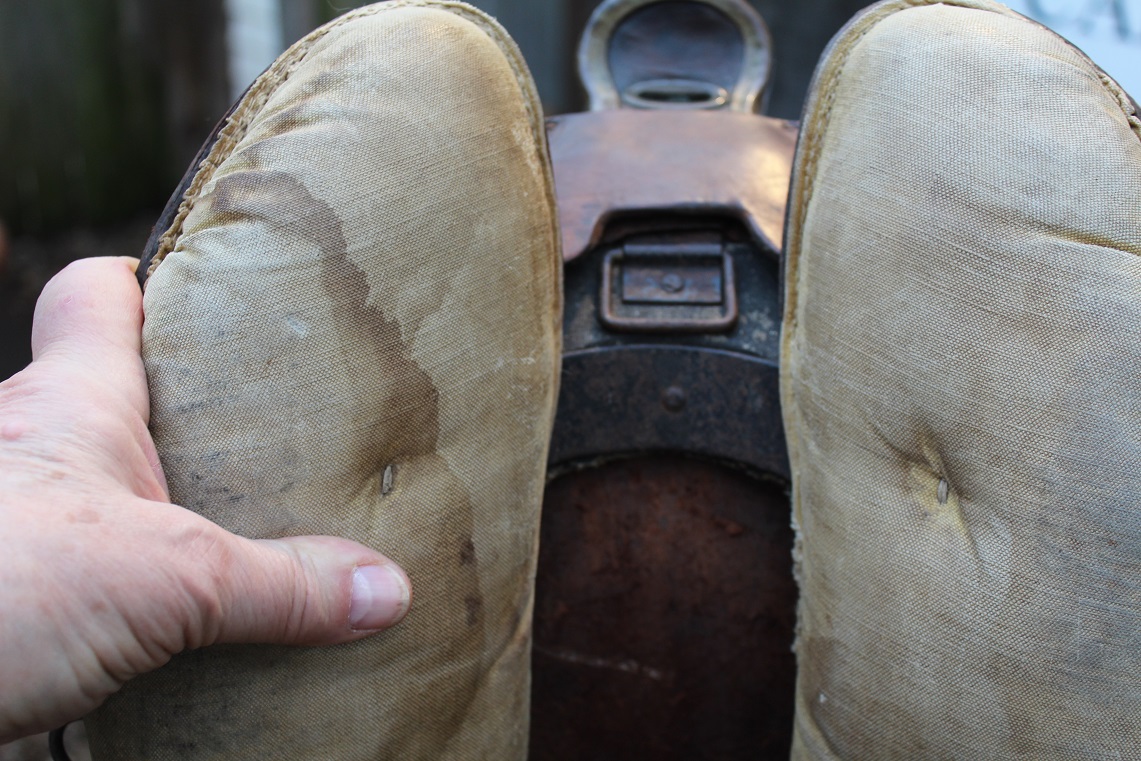

__________________________________________________________________________________________
tc
Grand Duchy of Mecklenburg-Schwerin: Military Merit Cross
fur auszeichnung im kriege
for distinction in war
1877 Military Merit Cross 2nd Class
Type -- Cross in two classes
Awarded for Bravery or military merit in wartime
Description _Bronze gilt cross pattée; 1st Class is a pinback decoration, 2nd Class is worn from a ribbon. This one is worn from a ribbon and is the combatant ribbon in lieu of the non combatant ribbon.
This medal is dated 1877. This was awarded to Russians and Romanians in the Russo-Turkish War (1877–1878). Certain German states, especially Mecklenburg-Schwerin, were sympathetic to the Russian and Romanian cause, and had dynastic connections to both states. Grand Duke Friedrich Franz II's grandmother was Grand Duchess Elena Pavlovna of Russia, his daughter was married to Tsar Alexander II of Russia's son, and his son and heir, Friedrich Franz III, would marry Grand Duchess Anastasia Mikhailovna of Russia in 1879. The Romanian royal family was a branch of the Hohenzollerns, the ruling house of Prussia and the newly created German Empire.
This medal is in excellent original condition with the original combatant ribbon which is also in excellent condition! Take a good look at the pics! $195.00
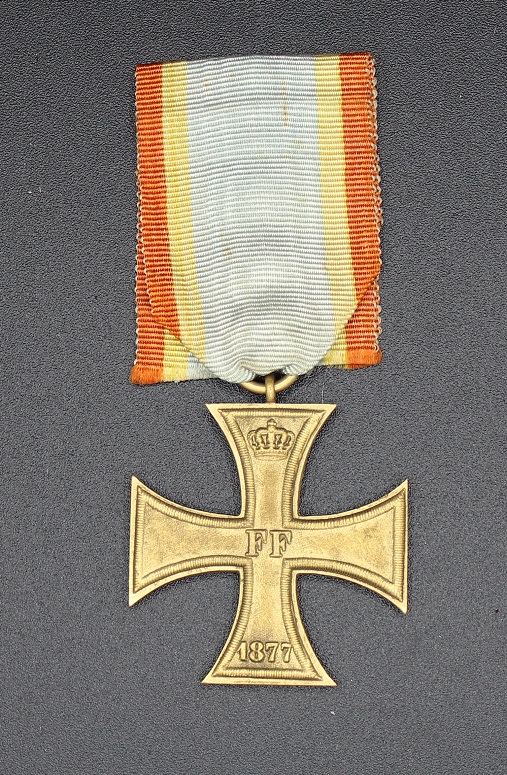
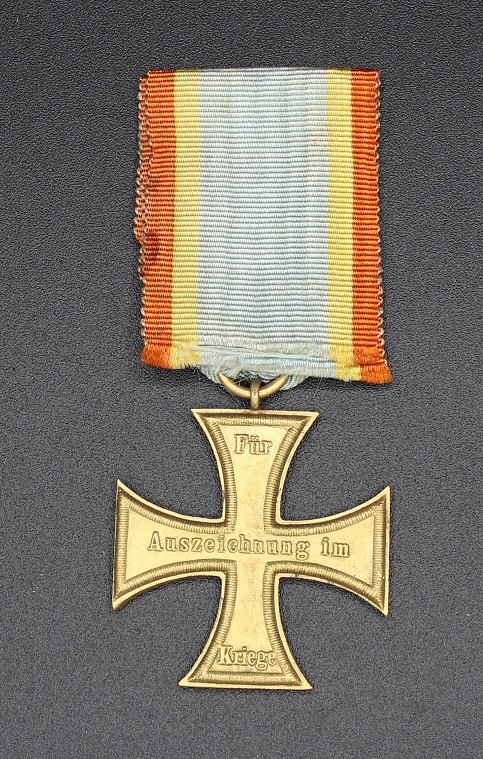
__________________________________________________________________________________________
tc
Here we have two Soviet medals. Number ONE is The Medal "For Construction of the Baikal-Amur Railway" and was awarded to active participants in the construction of the Baikal-Amur Railway, on the rail section Bam – Tynda – Berkakit, on the second rail section Taishet – Lena, in the production facilities, in the building of housing for the civilian workers, for good work in construction, for high-quality designs and survey work, for honest work at enterprises, institutions and organizations directly supporting the construction efforts and the workers. The medal was usually awarded to workers, engineering-technical workers and employees who worked on the project in its construction, design or for its maintenance for at least three years. This is a good example of that medal. 170,030 were awards and are no longer available. $35.00
Number TWO medal is The Jubilee Medal "70 Years of the Armed Forces of the USSR" and was awarded to officers, warrant officers, sergeants, petty officers, sailors and soldiers, enlisted in the service and on active duty on February 23, 1988 in the Soviet Army, Navy, in the troops of the Ministry of Internal Affairs, in the armed forces of organs of the State Security, in the Council of Ministers of the USSR; to former Red Guards, soldiers who took part in the fighting to protect the Soviet homeland in the Armed Forces of the USSR, to partisans of the Civil War and the Great Patriotic War of 1941–1945; persons discharged from active military service in the reserve or retired, who served in the Soviet Army, Navy, in the troops of the Ministry of Internal Affairs, in the armed forces and organs of the State Security Council of Ministers of the USSR for 20 years or more or that were awarded during their active duty, military orders of the USSR or the medals "For courage", Ushakov, "For Military Merit", "For Distinction in Protection of State Border of the USSR", Nakhimov, "For Distinction in Military Service". This medal is in excellent condition overall. For this one $25.00
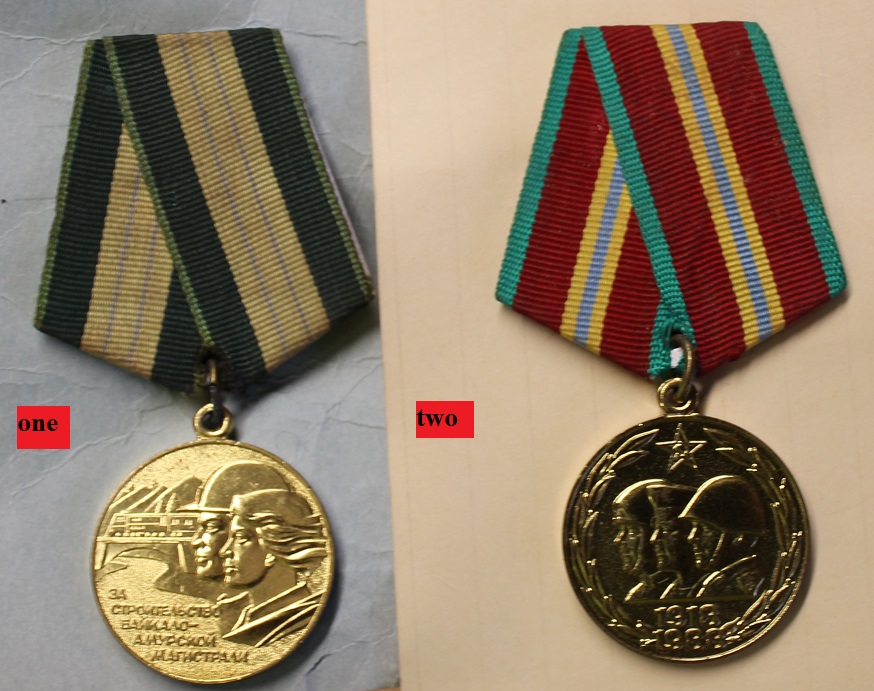

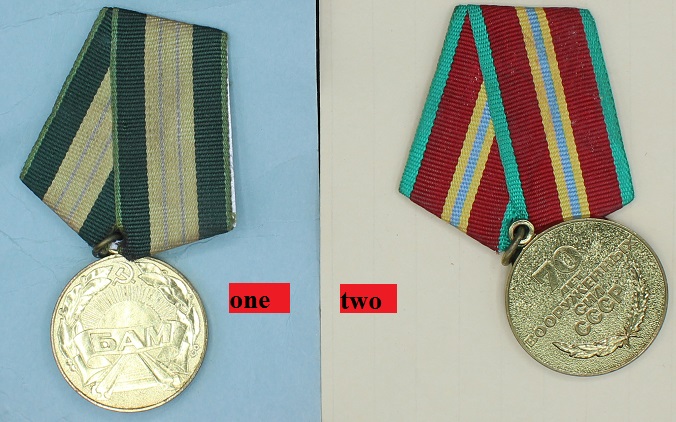
__________________________________________________________________________________________
tc
Here we have 3 Soviet medals in great condition that commerate the end of WW2. The Jubilee Medal "Thirty Years of Victory in the Great Patriotic War 1941–1945" was a state commemorative medal of the Soviet Union established on April 25, 1975, by decree of the Presidium of the Supreme Soviet of the USSR to denote the thirtieth anniversary of the Soviet victory over Nazi Germany in World War II. Each medal is in very nice condition overall complete with ribbons. $10 each. Check out the pics!
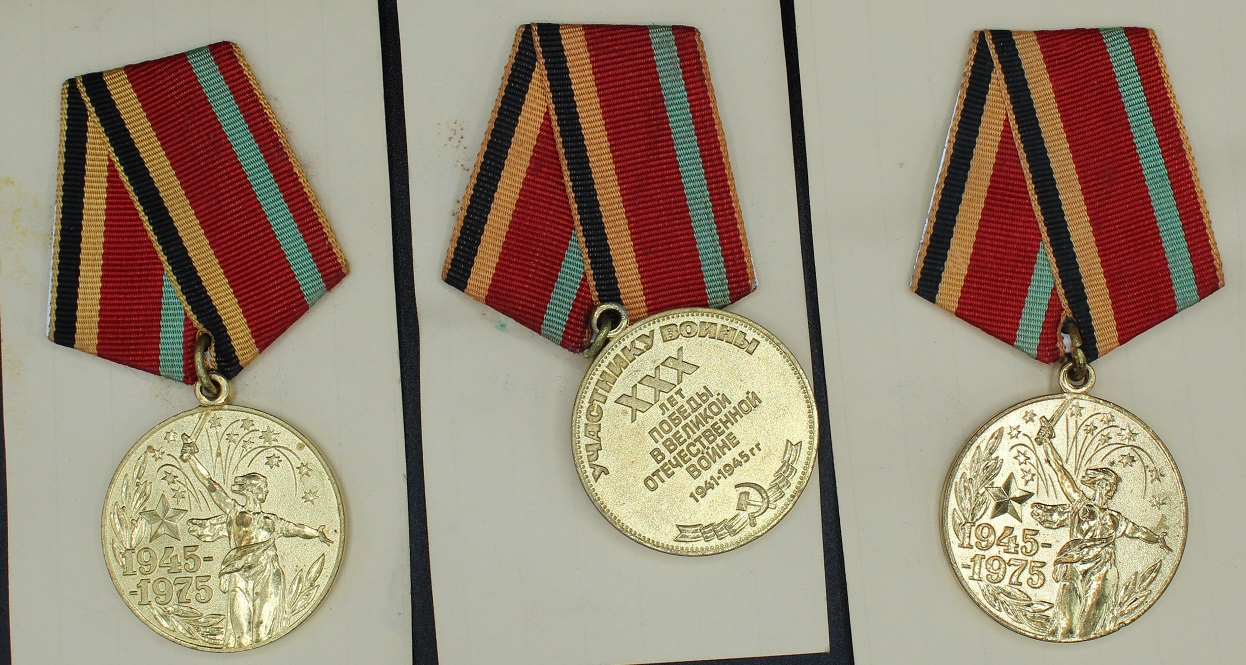 __________________________________________________________________________________________
__________________________________________________________________________________________
tc
Here we have a Russian Medal commerating the capture of Berlin in 1945. The Medal "For the Capture of Berlin" was awarded to Soviet soldiers who participated in the capture of Berlin from April 22 to May 2, 1945. This medal
is just for the drop and it's been around with very dark patina and no ribbon. The Soviets gave out 1,100,000 of these medals! Just the medal here-no ribbon! The 2nd photo was taken in a booth while the first one was not but it's the same medal and looks more like pic 1. $10.00

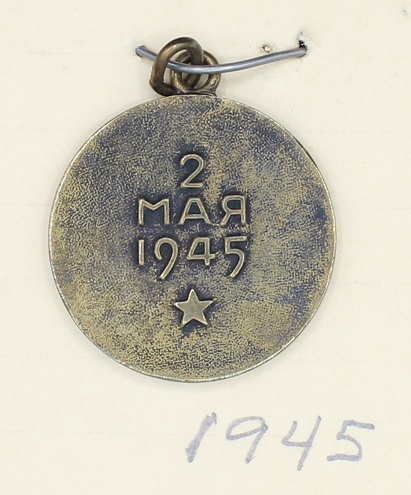 __________________________________________________________________________________________
__________________________________________________________________________________________
tc photos and documents
Here we have a pack of US Military documents and pics from 1920 belonging to William Hughes who was a staff sgt in 1920. There is a military pass from Fort Riley, Kansas dated 1920, 2 business cards for the Staff Sgt from Spartanburg, S.C., a dance card from William Hughes dated 1918 from Fort Riley, Kansas, a dance ticket dated June 9, 1918 to Lane's School of Dancing, 3 photos of which one is a dog in an inner tube with a Confederte flag attached to the tube, an old 1920's car with the driver and a guy in the rumble seat, a 1920's lady outside a store and a photo of a waterfall of which I don't know where it is. Also included with Williams lot is a postcard from a soldier "over there" spending the day in Monte Carlo and sending the post card to a Lt E. A. Froshaug 2nd Btry, 7th F.A., AEF Germany. He says he is writing that card with his feet on Italian soil. Also included in with this lot is several items belonging to Jerry Callahan from Albert A. Mass. Perhaps he is a relative of William as they were all together. We have two VFW membership cards dated Feb-19, 1942 and another which is blank as to the name of the soldier dated Oct.17, 1942 so they may be for different soldiers. This lot deals with the liberation of Paris in 1944 and there are several original photographs here showing the Arc de Triomphe along with Charles Degaulle,
liberation French partisans with a captured German soldier and another with several german prisoners, parades, fortications and celebrations! On August 25, 1944, after more than four years of Nazi occupation, Paris is liberated by the French 2nd Armored Division and the U.S. 4th Infantry Division. There are many pics of U.S. Soldiers here. All of these photos came out of an album and has traces of having been glued in an album on the back. There is writing on the backs of two of the photos with one of the photo's having on it distain for the young French Men who did nothing to fight the Germans. Also are included a few postcards from back home. There is one from Corpus Christy and the others seem to be overseas. There is a photo of the Docks at Seattle and a couple from San Antonio. You get all for one money. For the entire lot $75.00
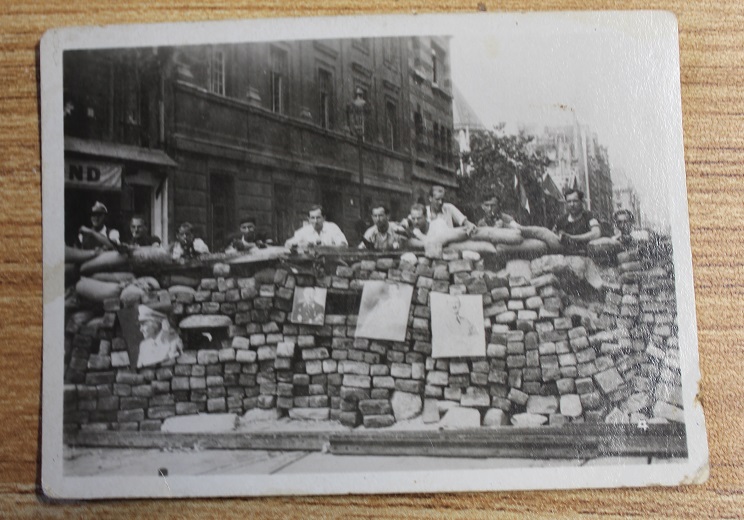
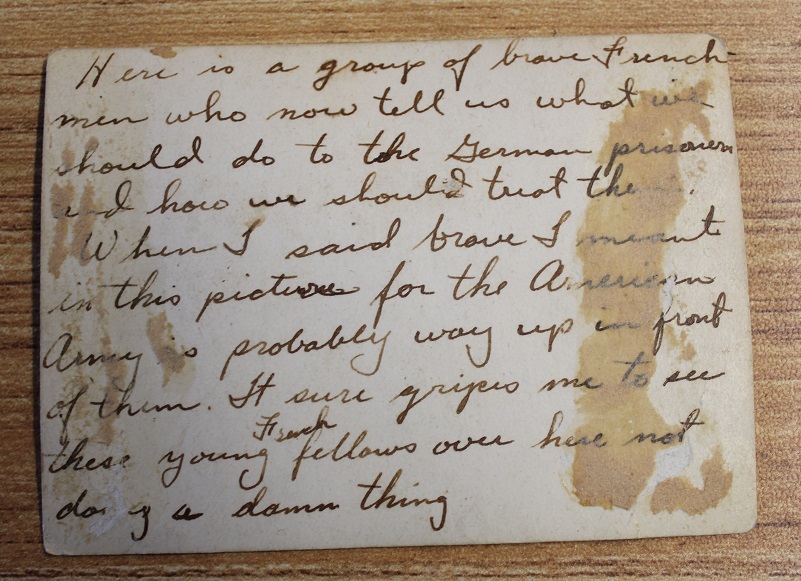
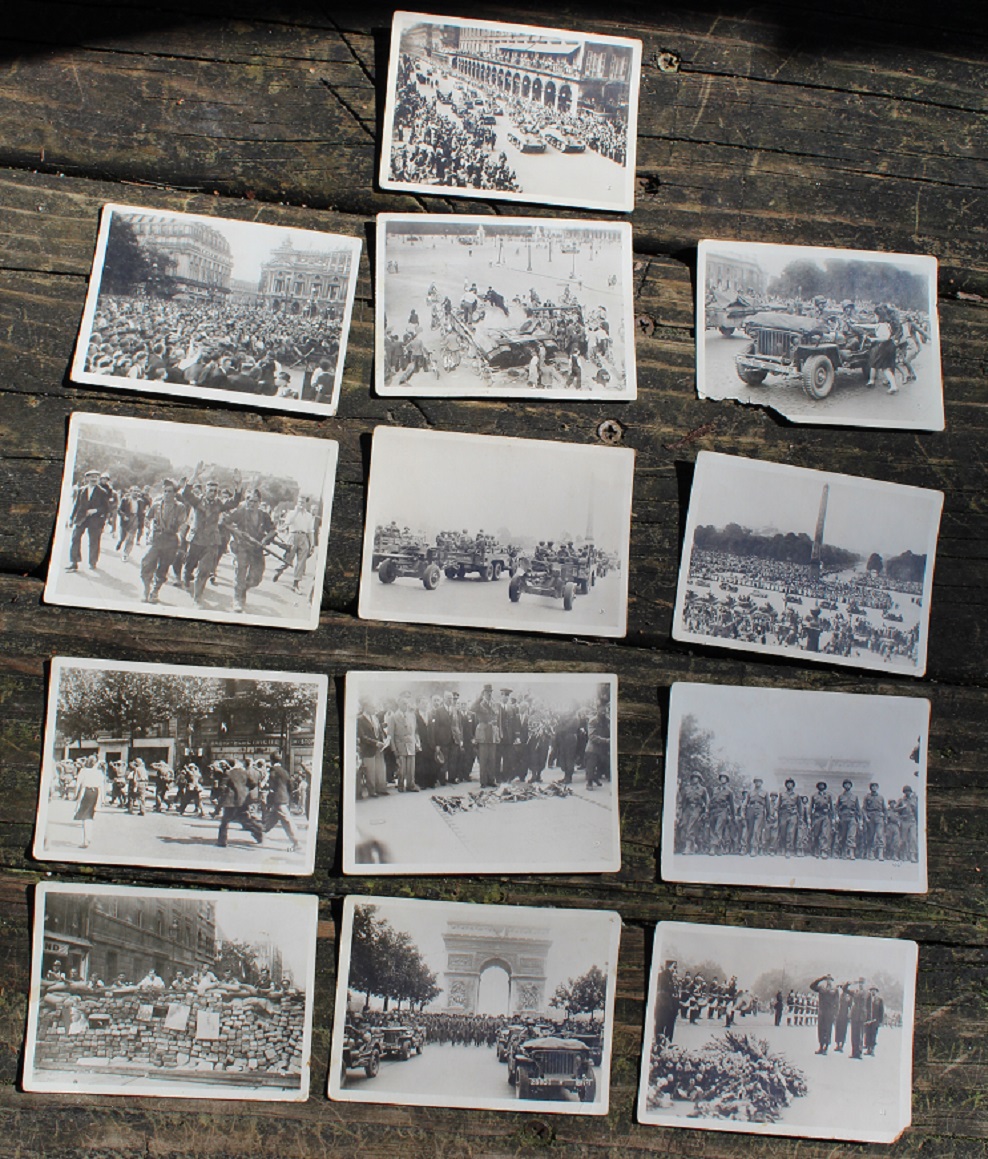
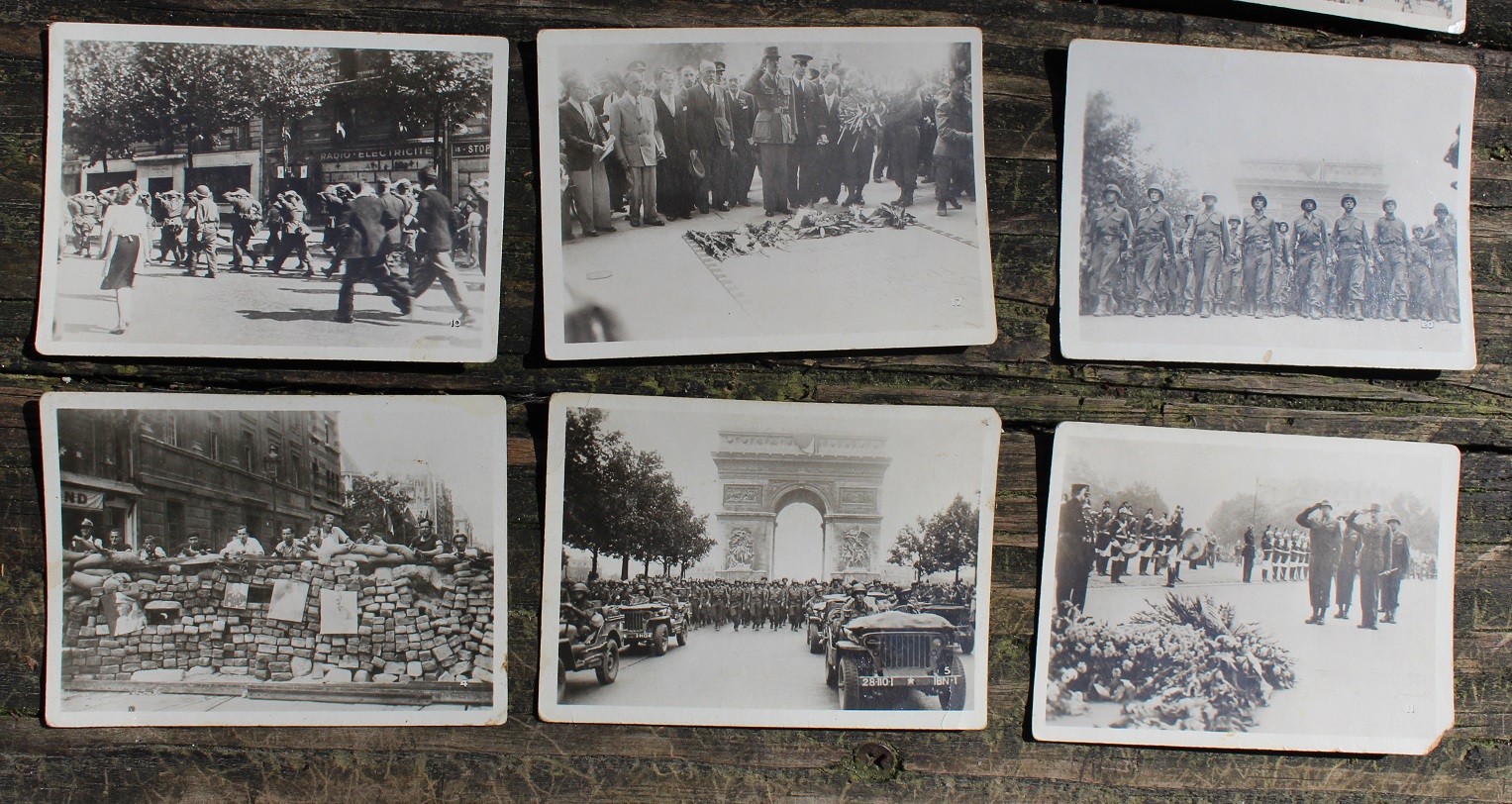
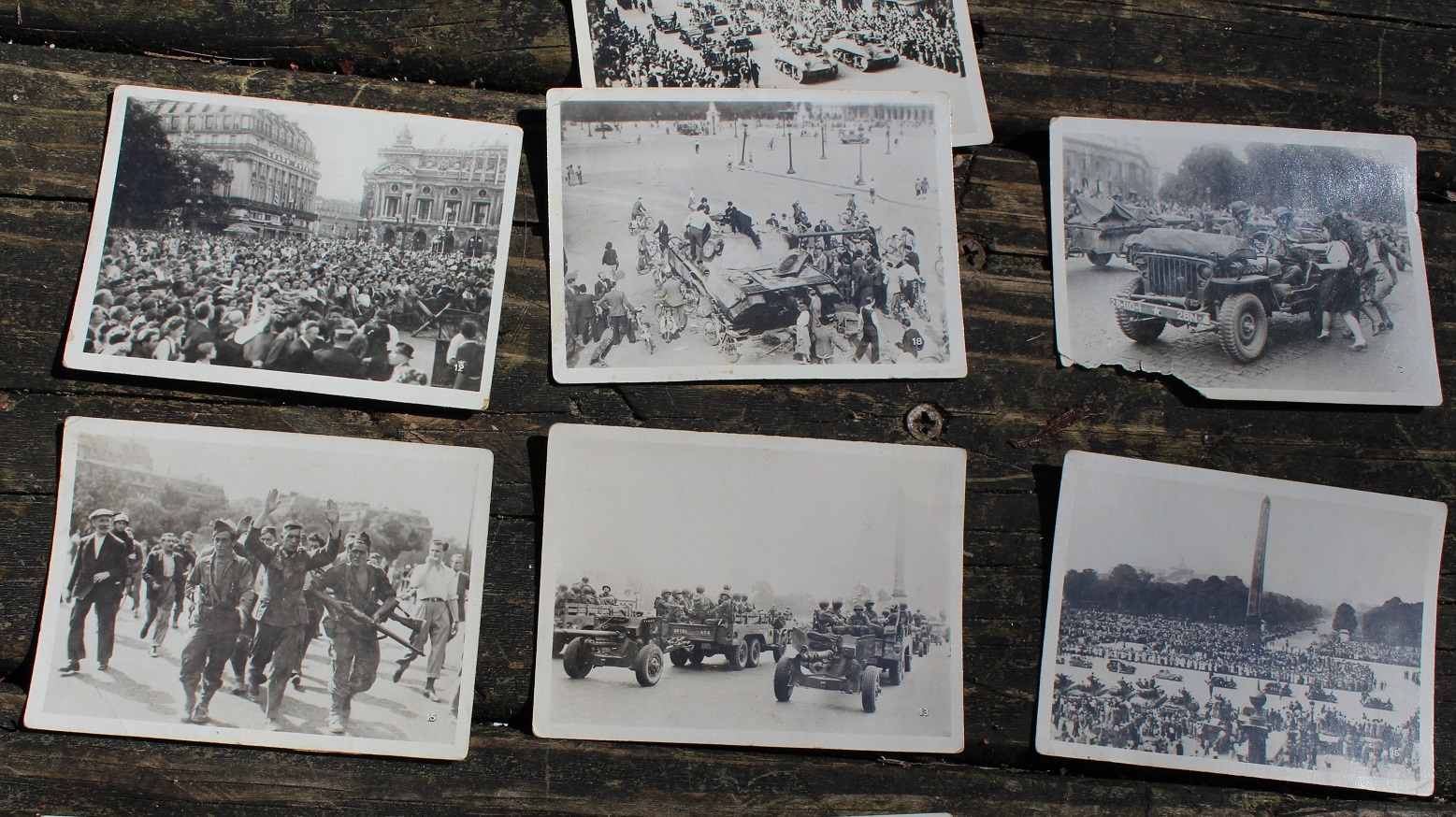
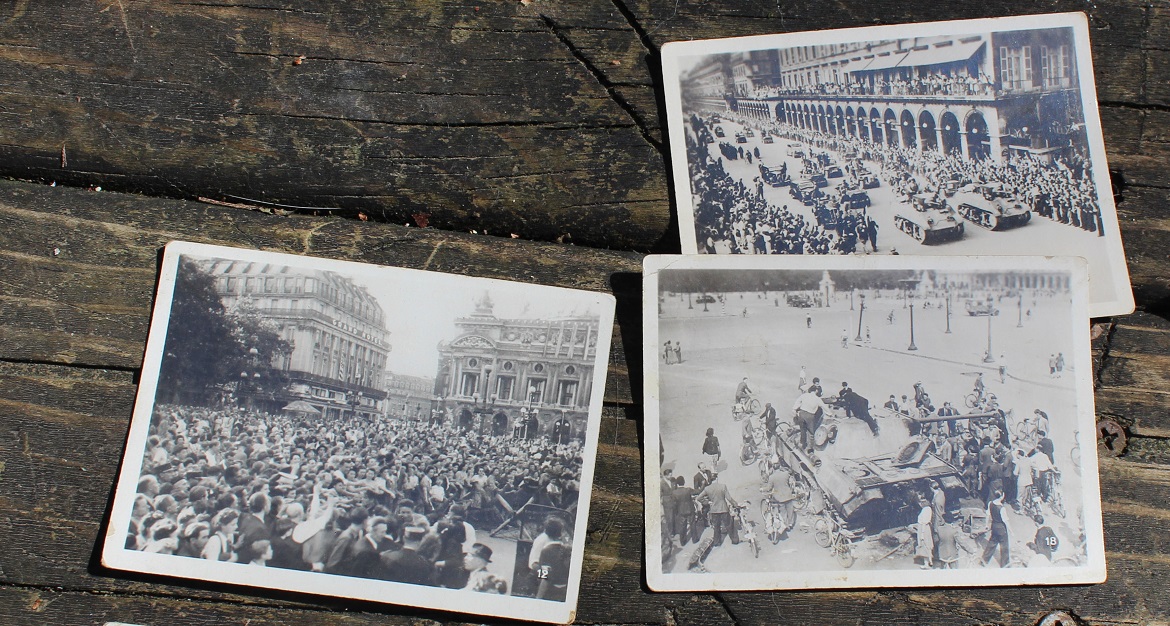

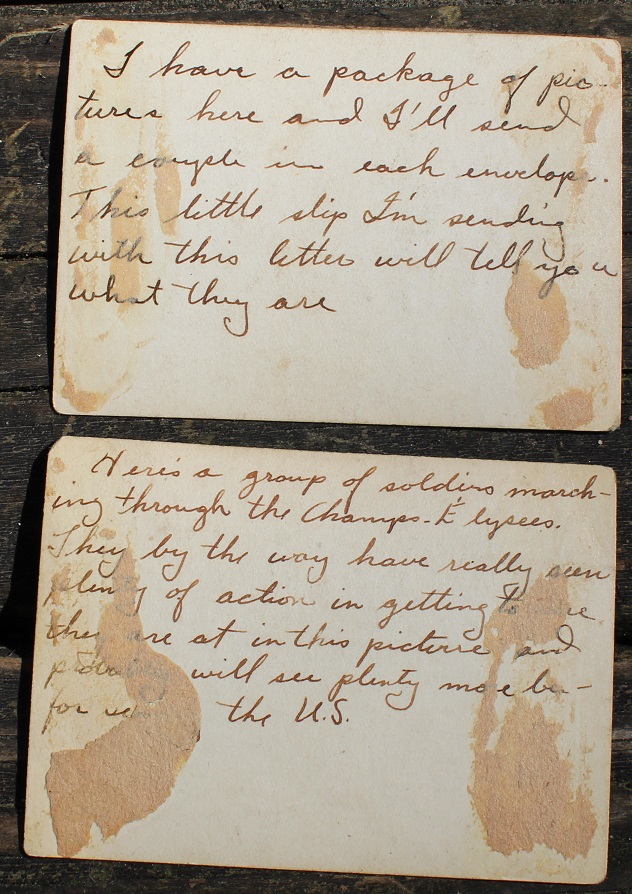
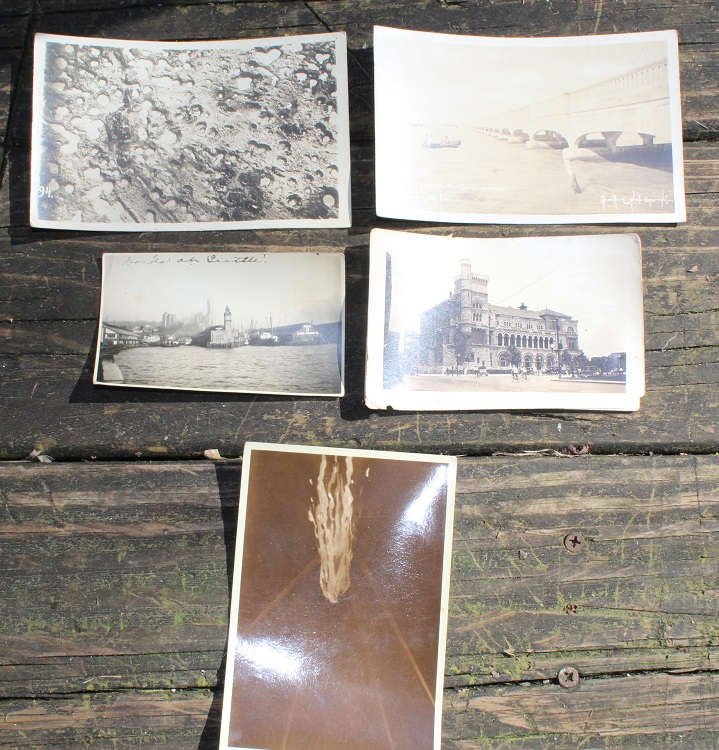
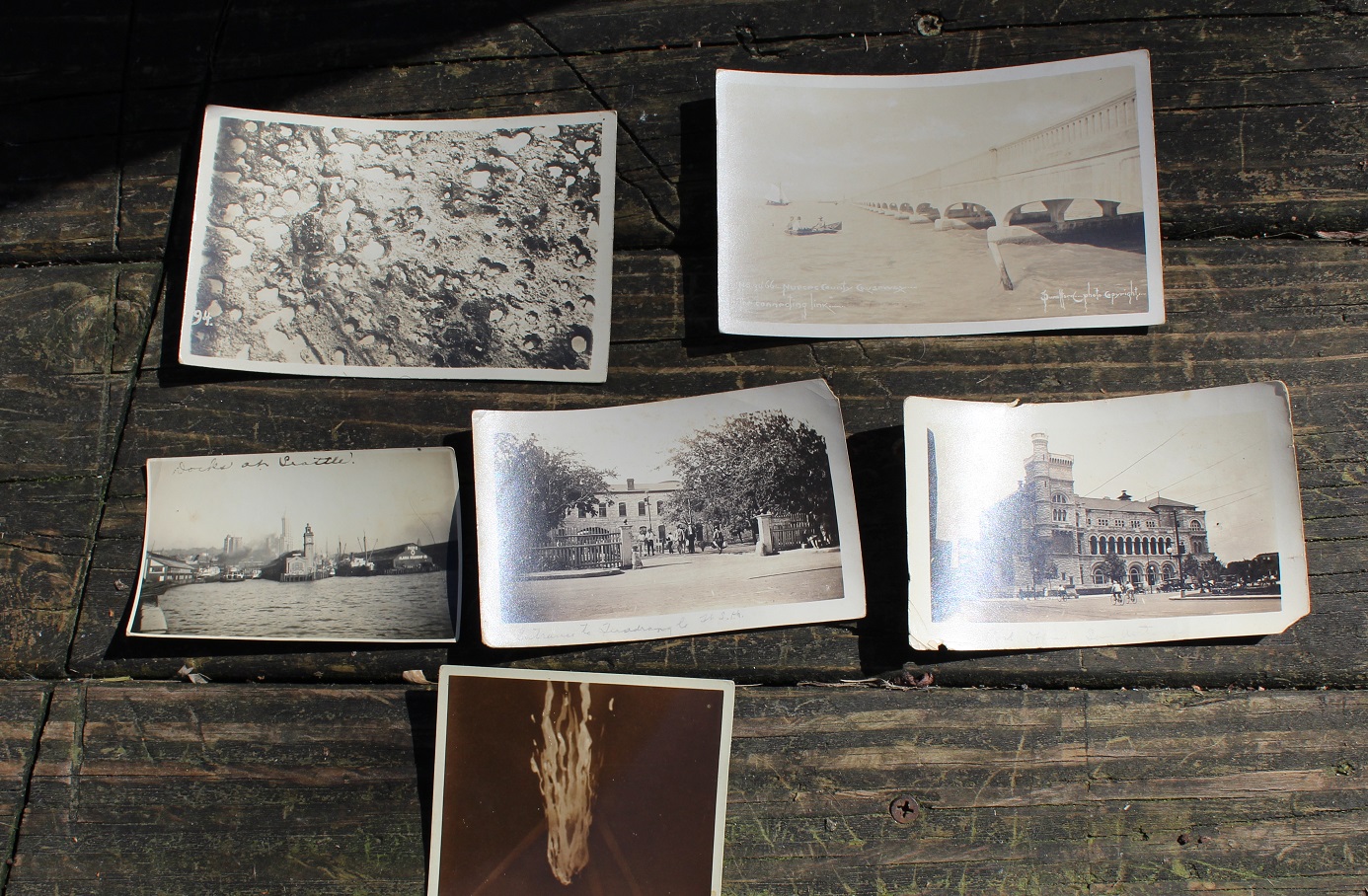
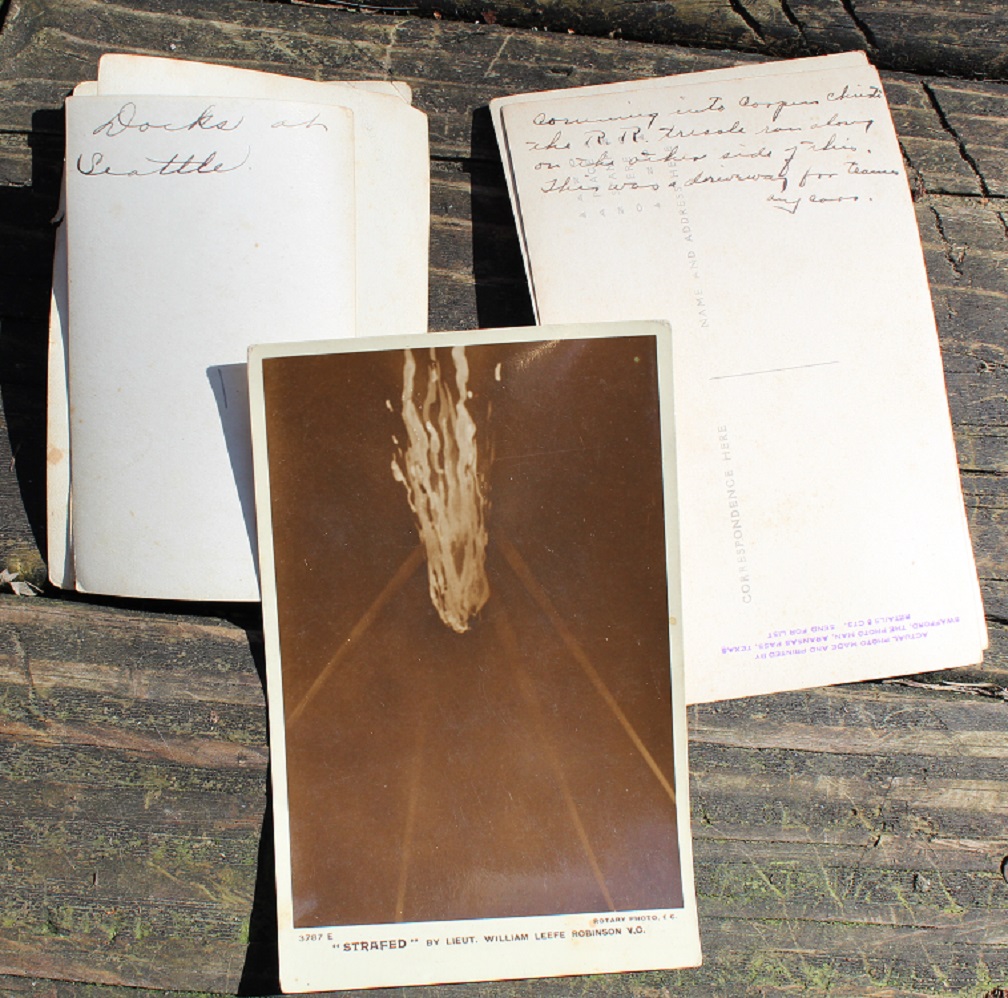
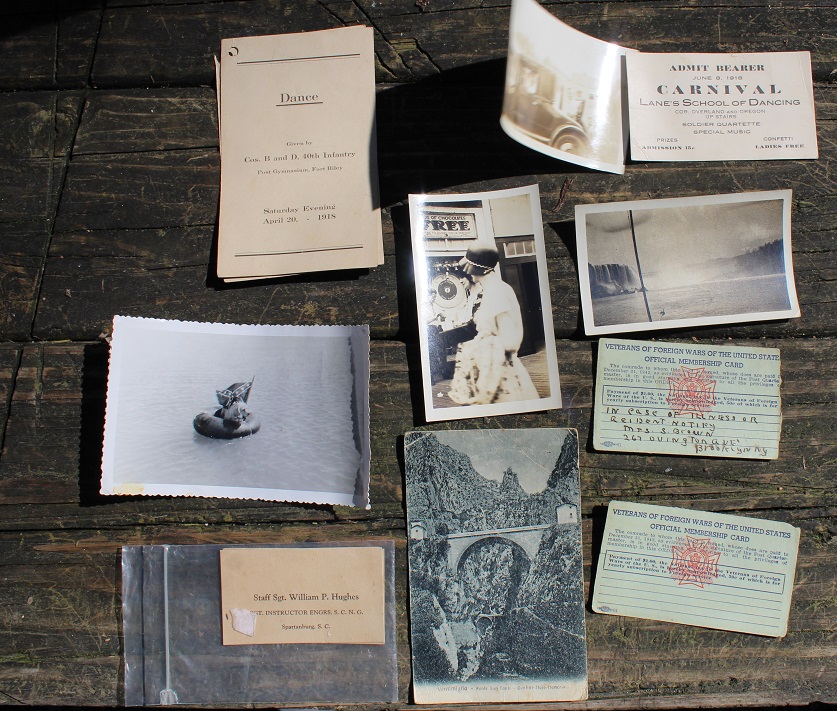
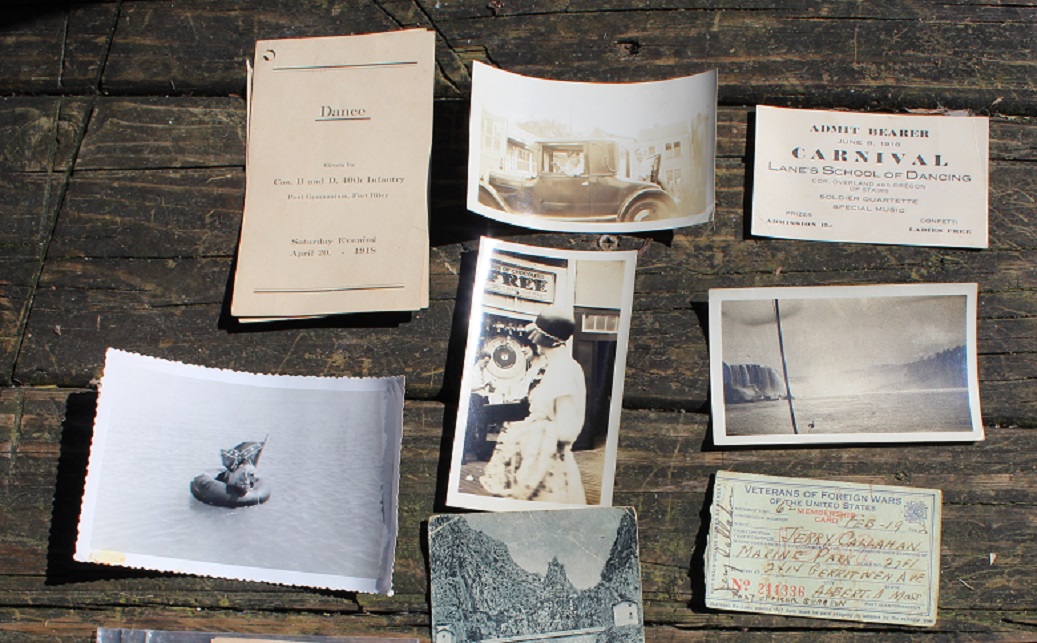
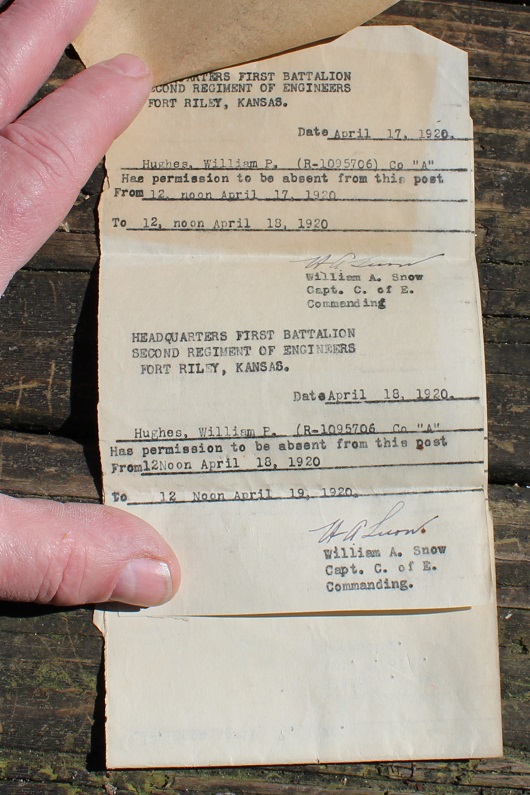

__________________________________________________________________________________________
tc eagle straps
We need your help on this one! Here we have a couple of, what looks like to be, eagle shoulder straps. They are thin and measure 2 inches wide by 5 1/2 inches long and have the same embroderied Eagle but reversed on each strap. The backs are different and I have included pics of both the front and the back. There are no markings on them at all. I bought them in a frame and took them out because the frame was broker. If you have any idea what they are I would appreciate hearing from you at ted.caldwell@comcast.net Thanks!
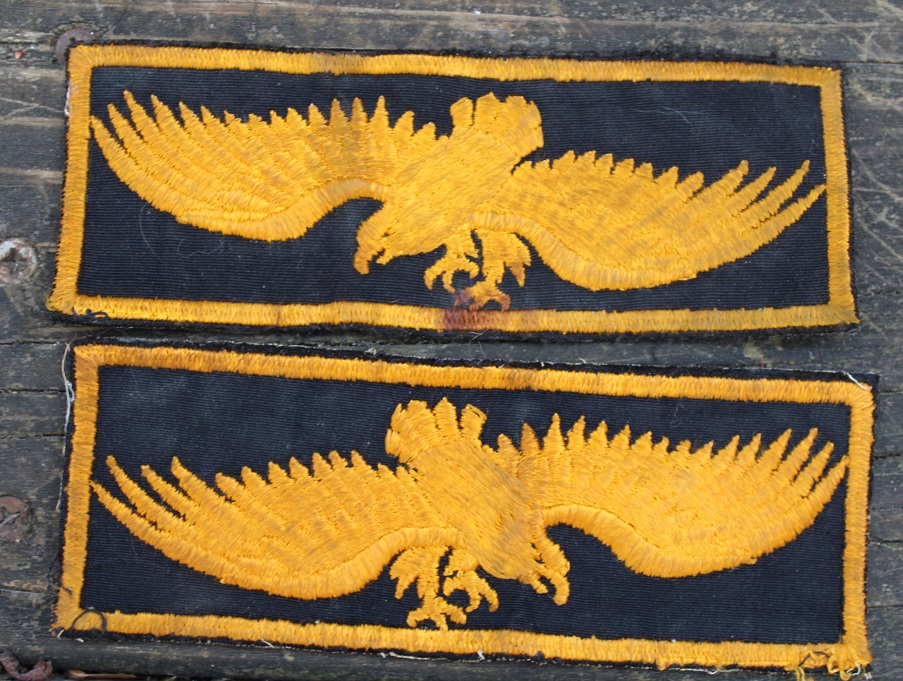

__________________________________________________________________________________________
tc 75 military items
Here we have a lot of 75 military items from around WW2 on down to modern times. There are patches, medals, demilitarized ammo, sewing housewifes, etc.! Take a look at the pics! You get it all for $45.00 + postage.
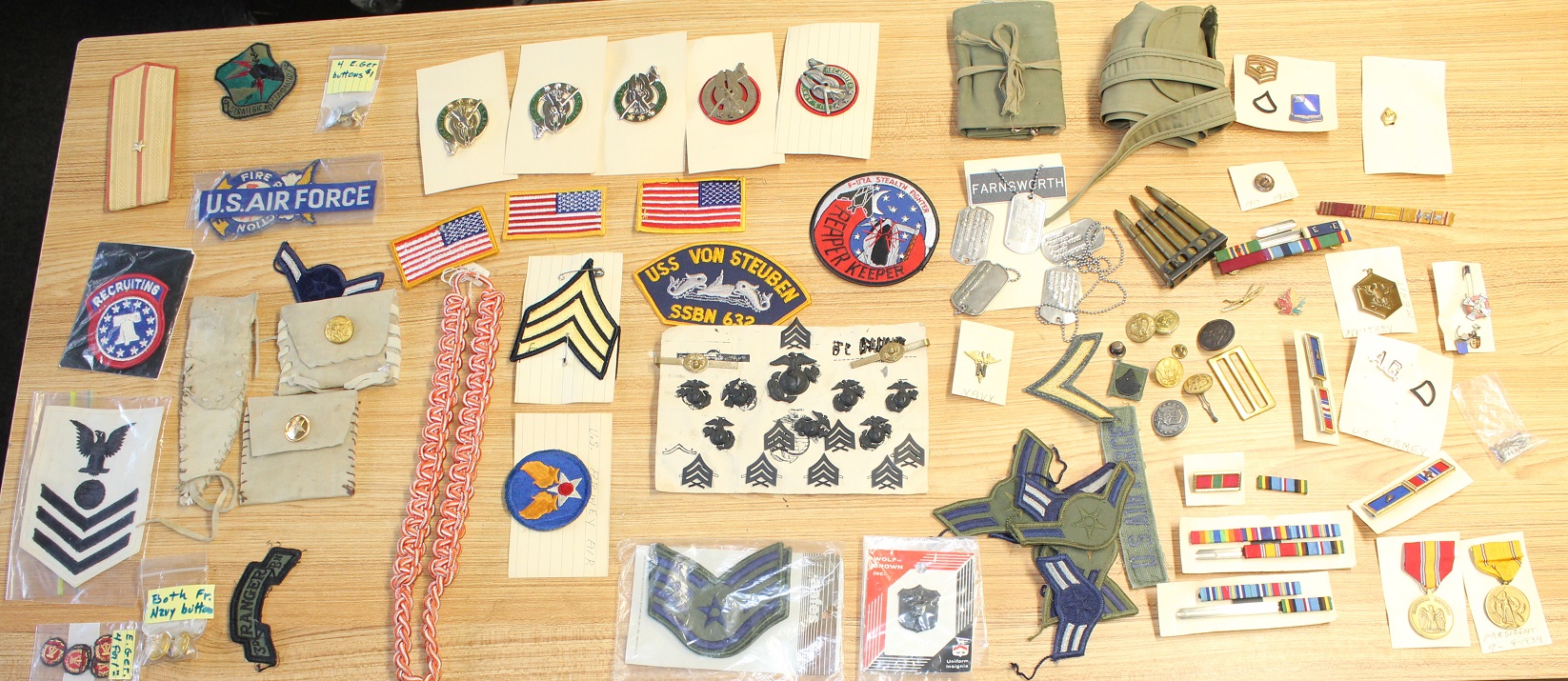
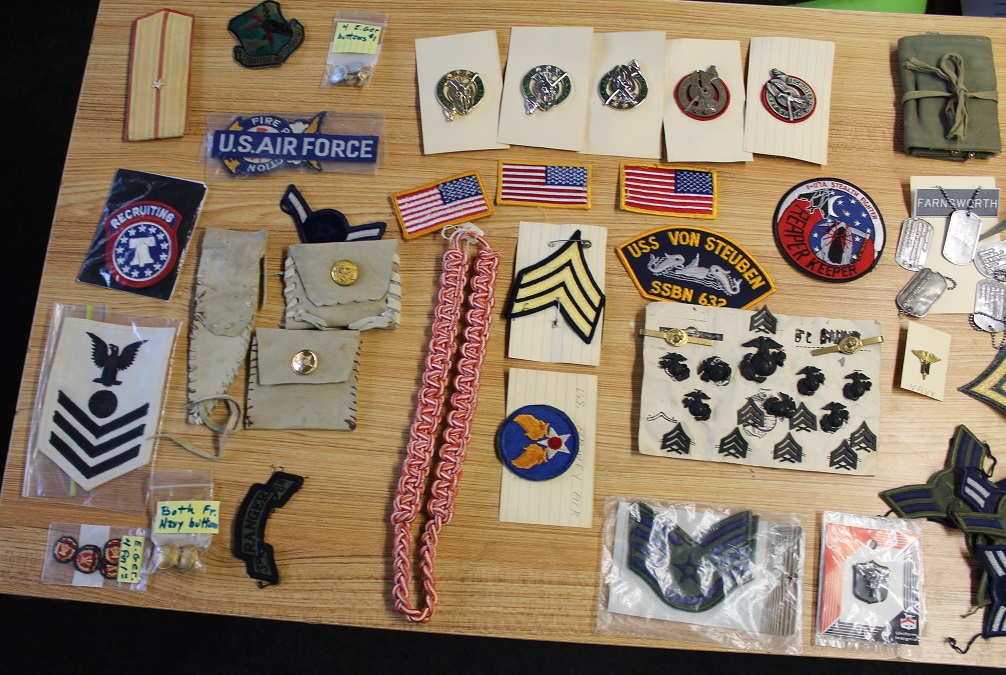
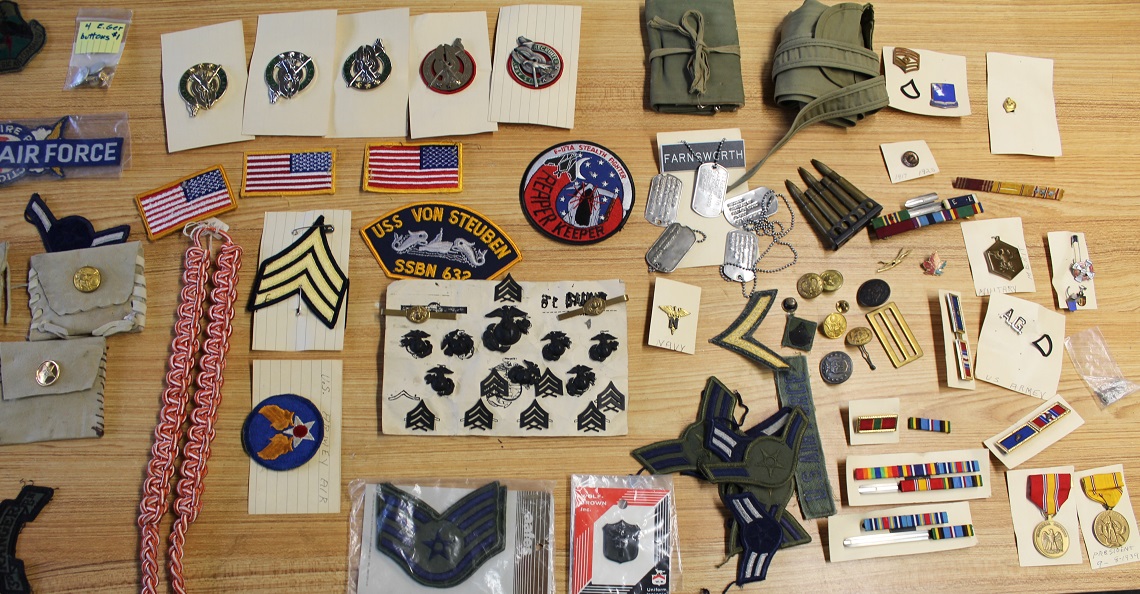
__________________________________________________________________________________________
tc ww1 postcards
Here we have a pack of 12 WW1 French postcards in book form stapled on the end. The photos aren't very pretty but definitely original. A couple of the pics have a tissue over them. A couple have soldiers in them but there is no war photos here. For this original French piece $20.00
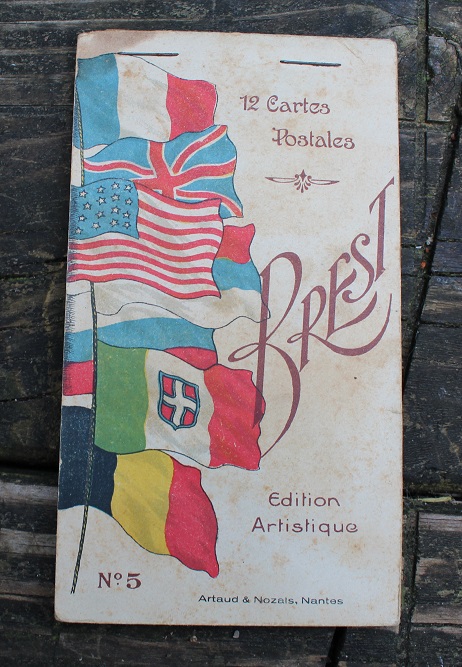
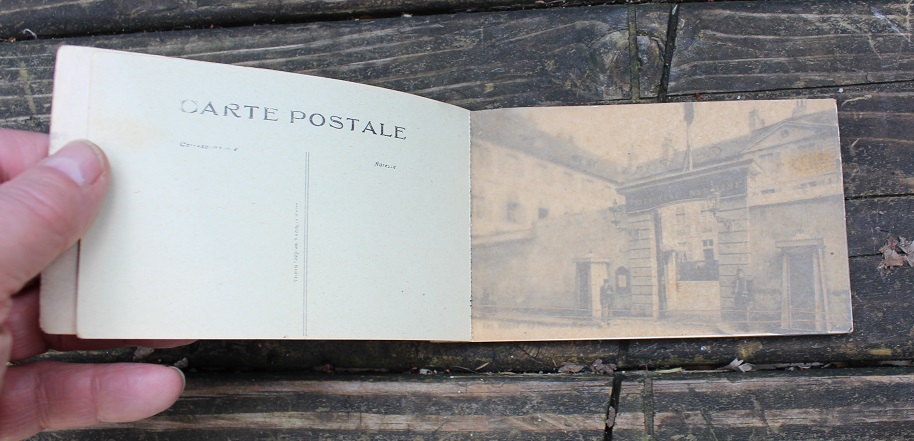
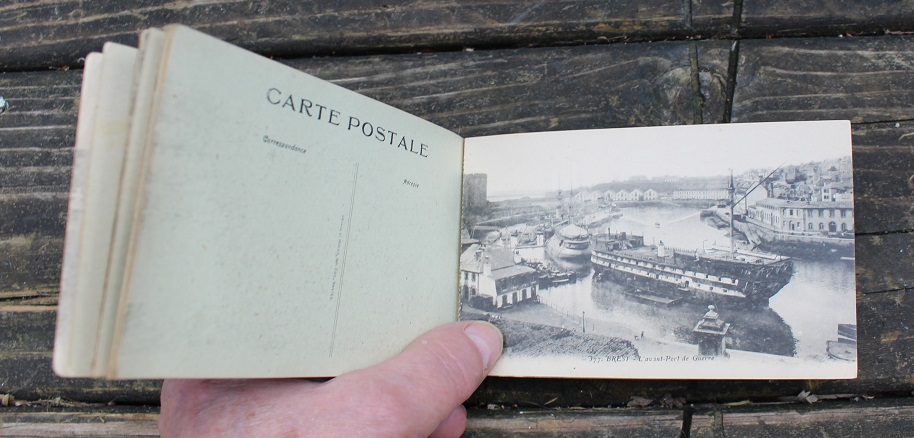
__________________________________________________________________________________________
tc print
Here we have an old WW2 era print(s) showing patches and rank insignia showing the folks what these ranks and patches mean. The frame is 18 1/2 by 9 inches and consists of several pages pieced together. Take a look at the photo. $20.00

__________________________________________________________________________________________
naval ratings
Here we have a pair of post WW2 naval ratings in hinged frame. Both are in excellent condition with at least the blue wool one having been taken off a uniform. These insignia are for an Instrumentman-IM and was started in 1961 and disestablished in 1999. $10 for the pair.
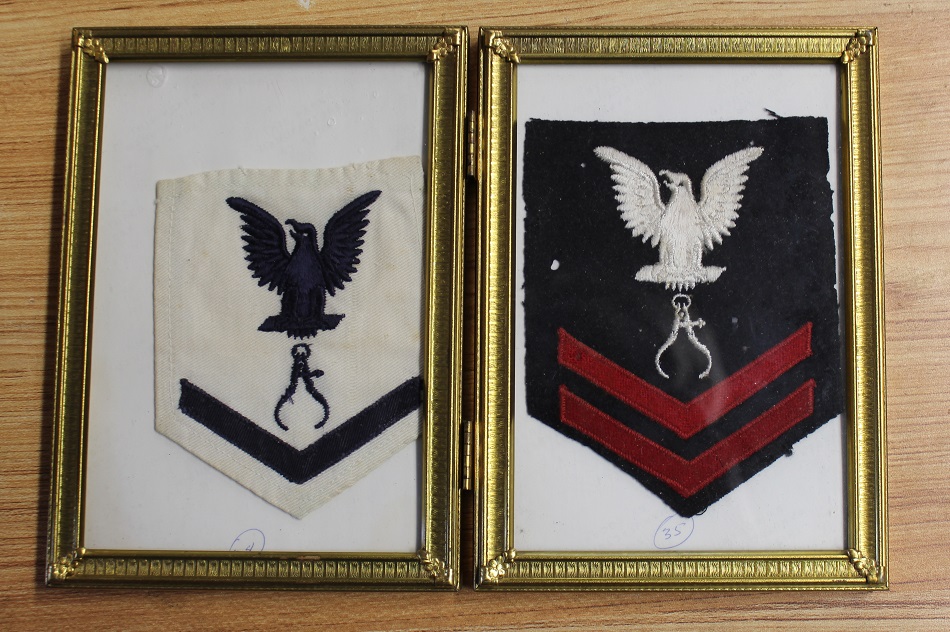
__________________________________________________________________________________________
tourist map
Here we have a 16 1/2 X 22 1/2 inch map that could be purchased by WW1 soldiers that were over there. The map is color and on one side is the typical map and on the other side is the tourist map. It must have been in a little book at one time as one pasteboard end is still attached. This would look great framed! $25.00
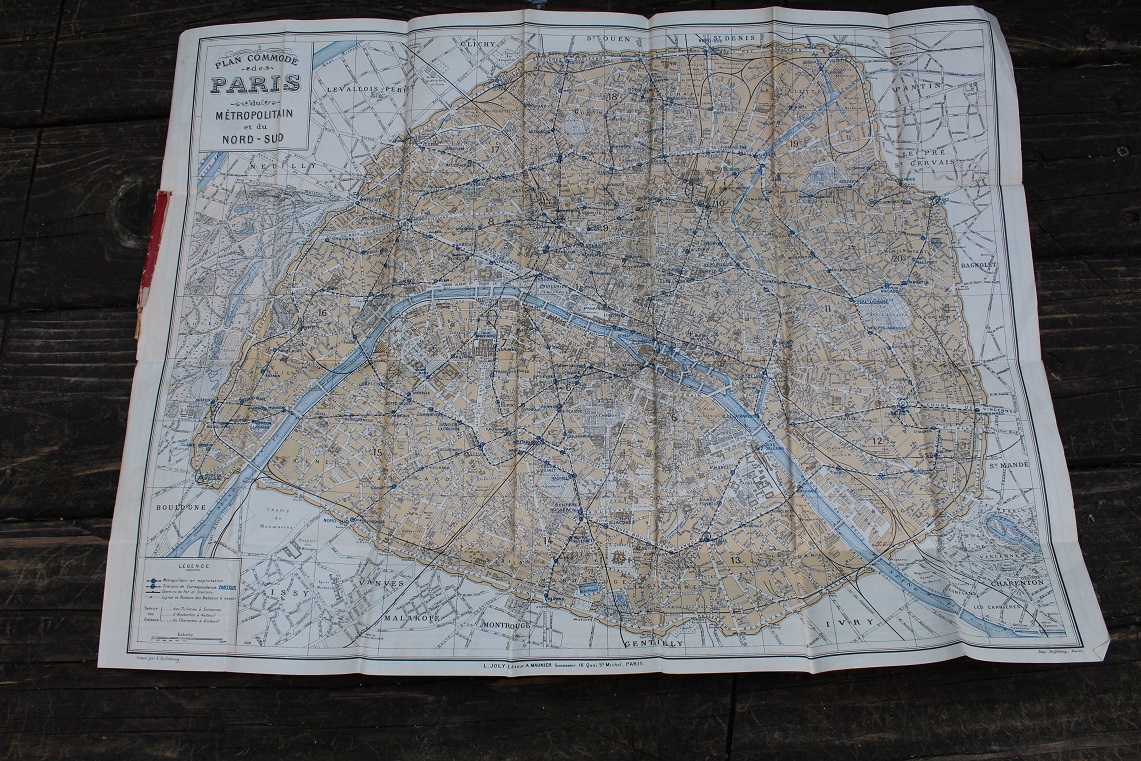

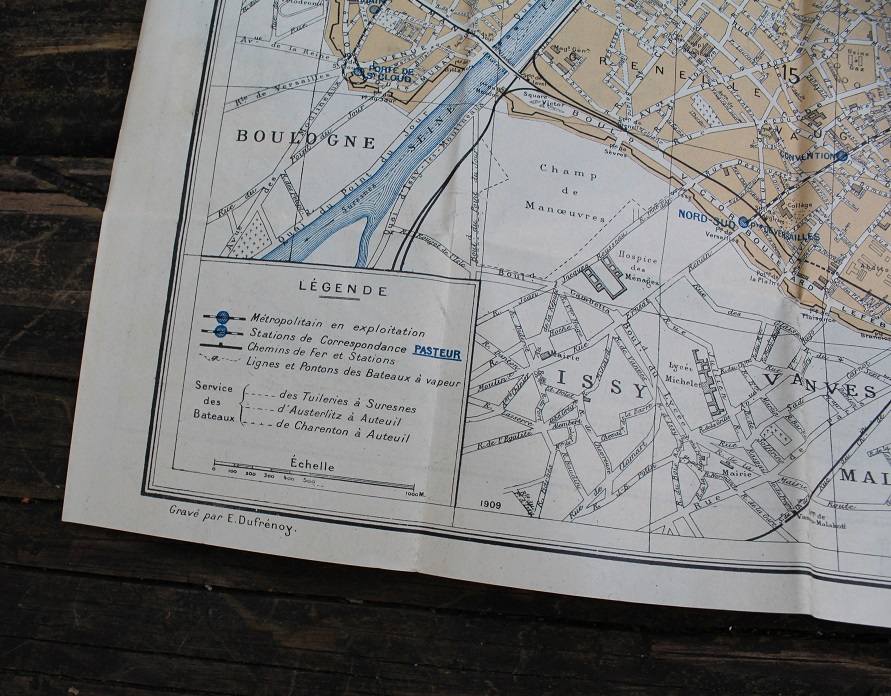

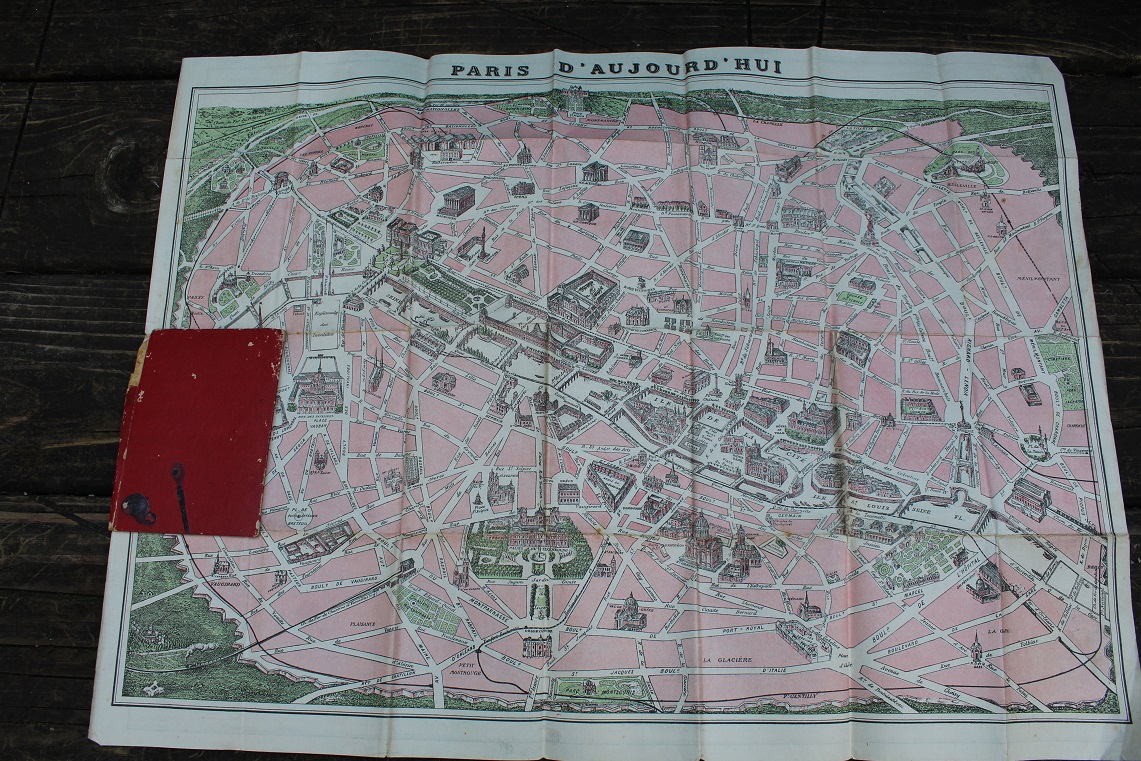

__________________________________________________________________________________________
TC
SOLD!!!
Original German WWI M1898/05 modified Butcher Sawback Bayonet by ANKER-WERK over BIELEFELD with Steel Scabbard & Leather Frog that had the sawback removed because supposively it was inhumane to use it as it caused horrendous wounds. This is a scarce S98/05 bayonet by Anker-Werke Bielefeld. Anthony Carter in his 'German Bayonets' book states that the models 98/02 and 98/05 bayonets by this firm are scarce and are thought to have only been made in 1917. They only carry the 2 line trademark of Anker-Werke Bielefeld with no dates, cyphers or other firm markings. The bayonet is in an all steel scabbard with a very nice leather frog. There are no marks on the frog as well. See German Bayonets book by Carter Page 27-30 and Page 64-65. It's a nice piece! $195.00

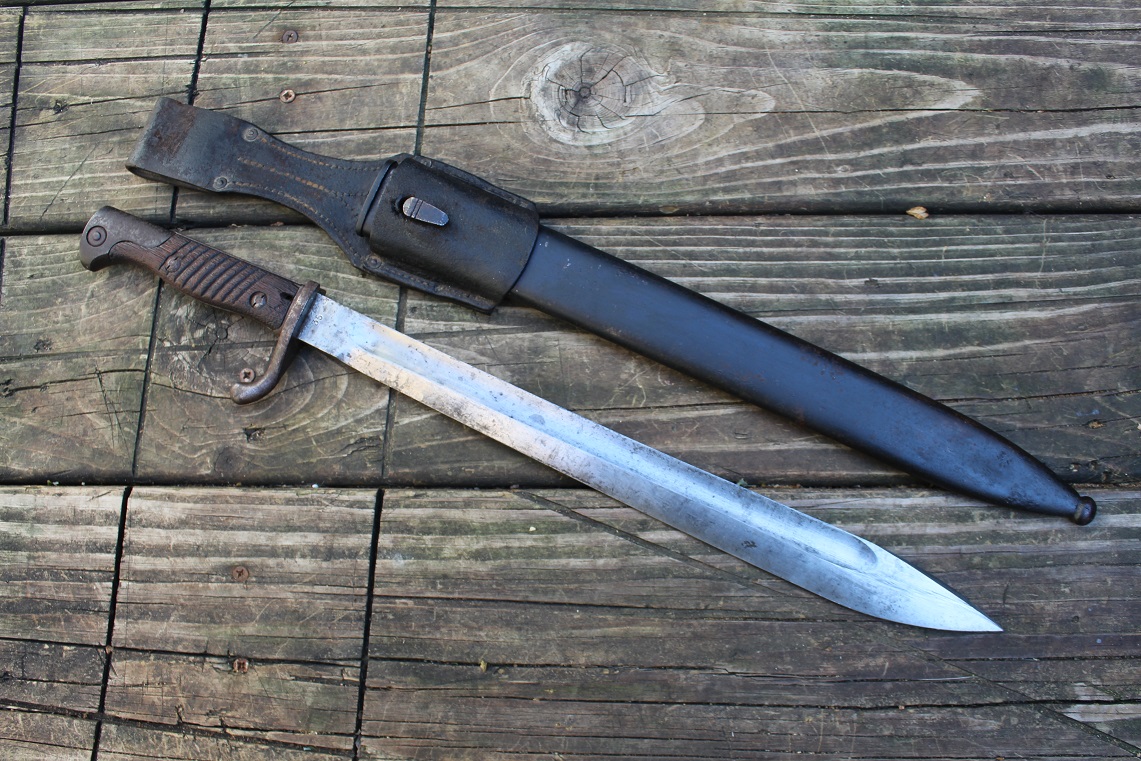
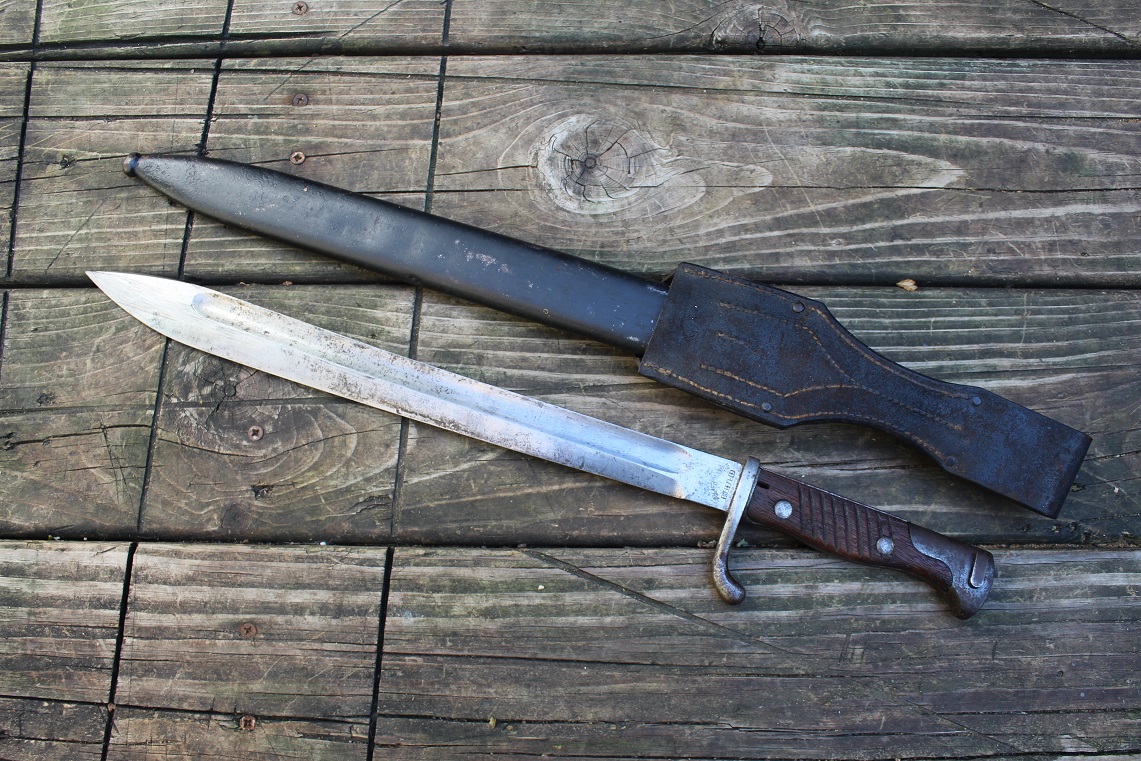

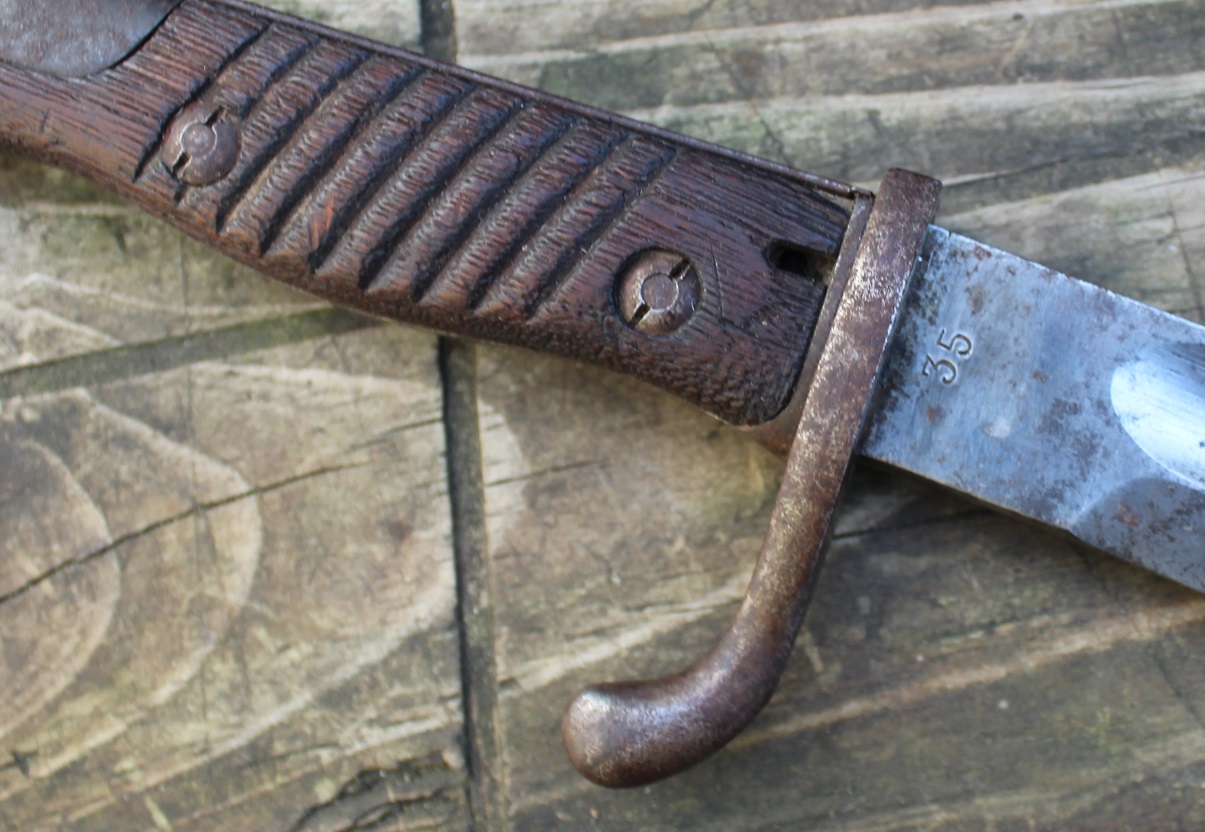
__________________________________________________________________________________________
tc
ww2 142
Here is what looks to be a period WW2 Japanese Tanto with secret compartment in sheath to hide gold or maybe just a small knife. Maybe this knife was made post war to sell to the occupying
American Forces after the war but I do not know for sure but it sure looks older than that to me. I have seen several items that were made to sell to the GI's by the
Japanese citizens. This piece is done very well especially the wrapped rayskin grip! It looks really good! The grip to the tsuba is 3 1/2 inches long and
the blade past the tsuba is a little over 9 inches long. The enamel painted sheath is still in good condition but missing a couple of items on it and, of course, there are chips in the finish.
The blade has been sharpened and is quite sharp. Take a look at the pics! For this piece $275.00














___________________________________________________________________________________________
tc 1917 can
ww2 192
Here we have a well used CHEST, AMMUNITION CAL. 50 M17 D39091 Early Browning Maching Gun ammo chest with folding lid and fabric handle. This piece has some non active rust on it and a few paint
spots from being in the old garage when the garage was painted. These old ammo chests are pretty difficult to find now. No holes and no dents! For this old chest $75.00

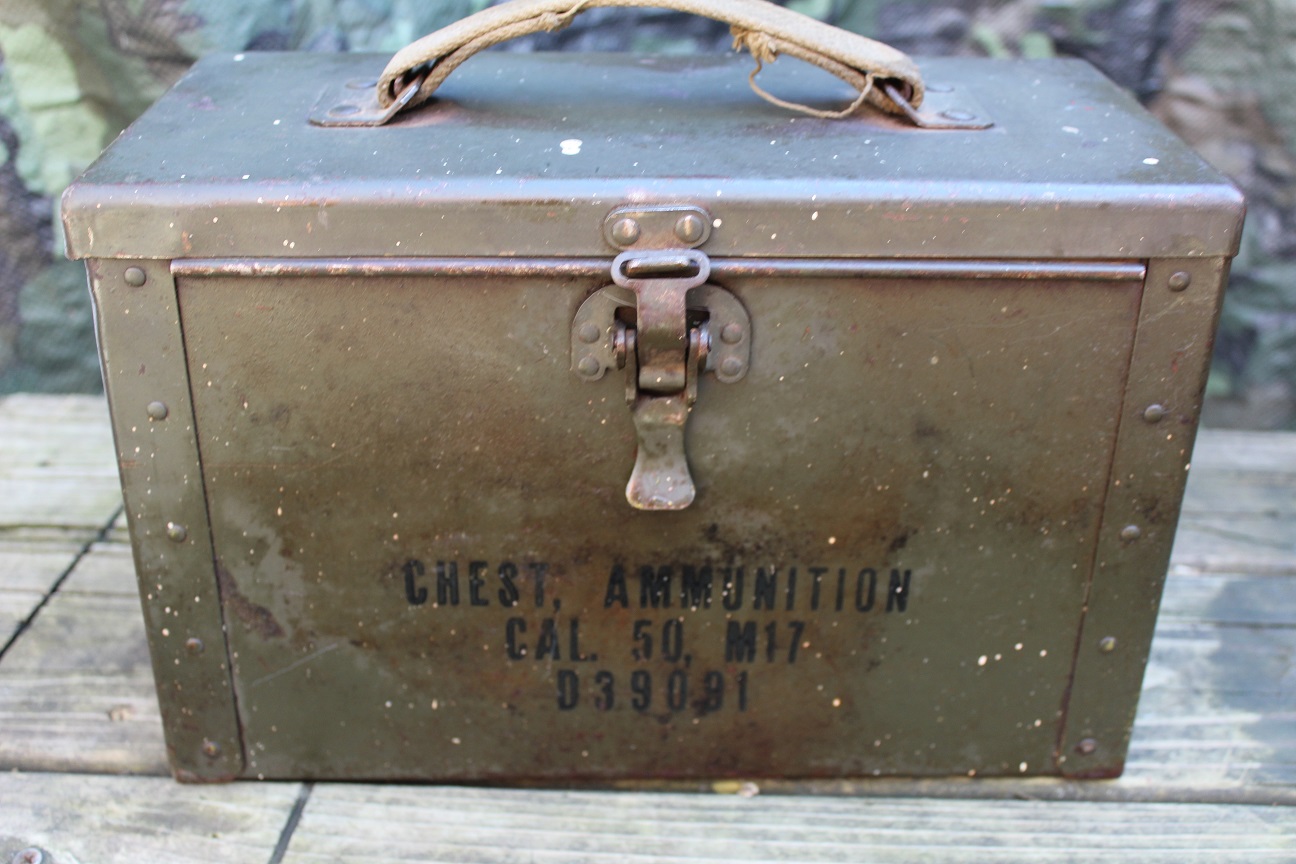

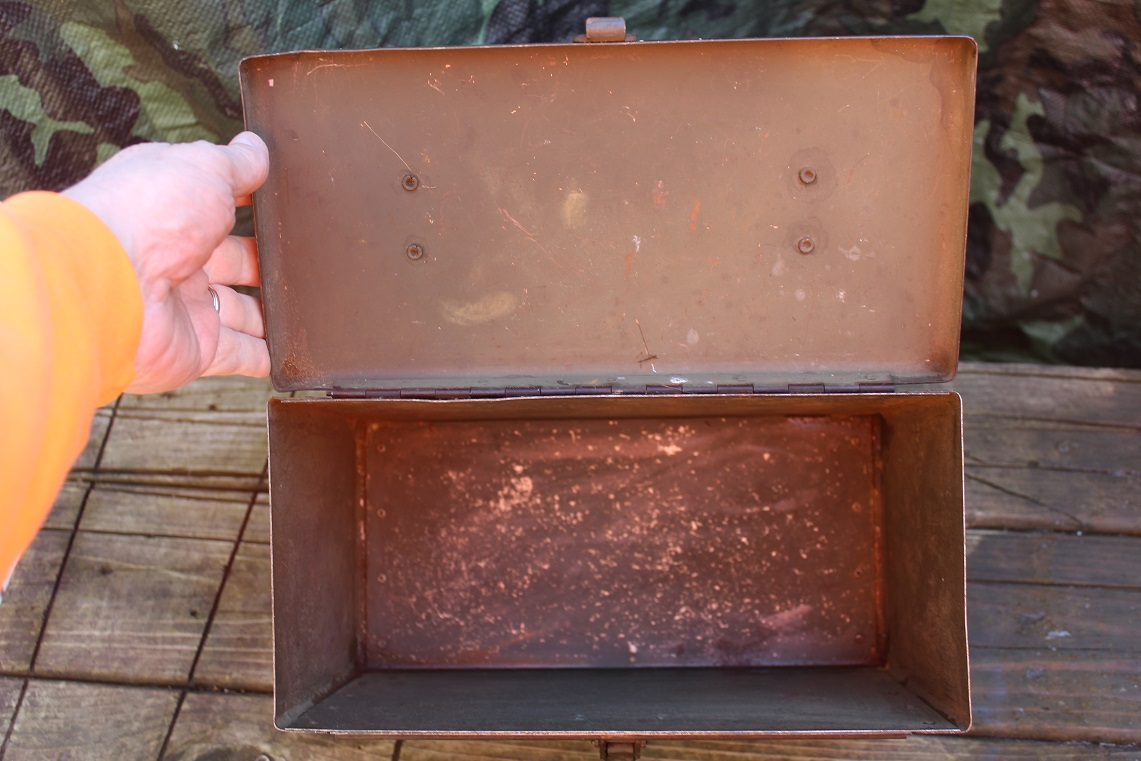
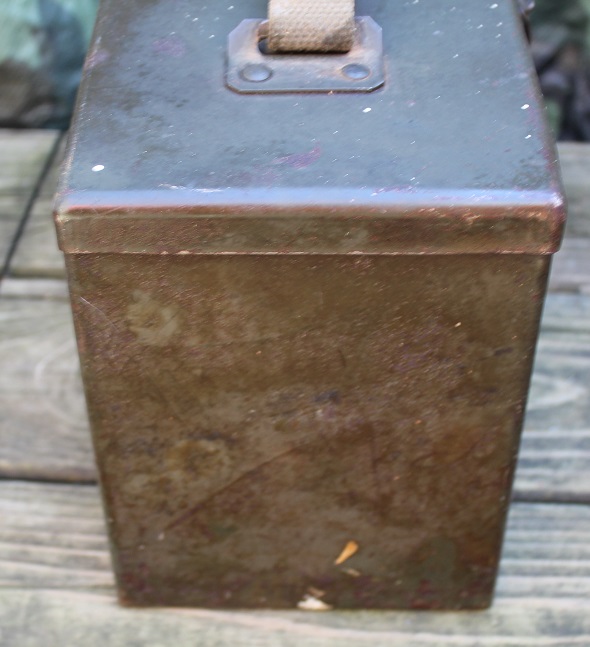
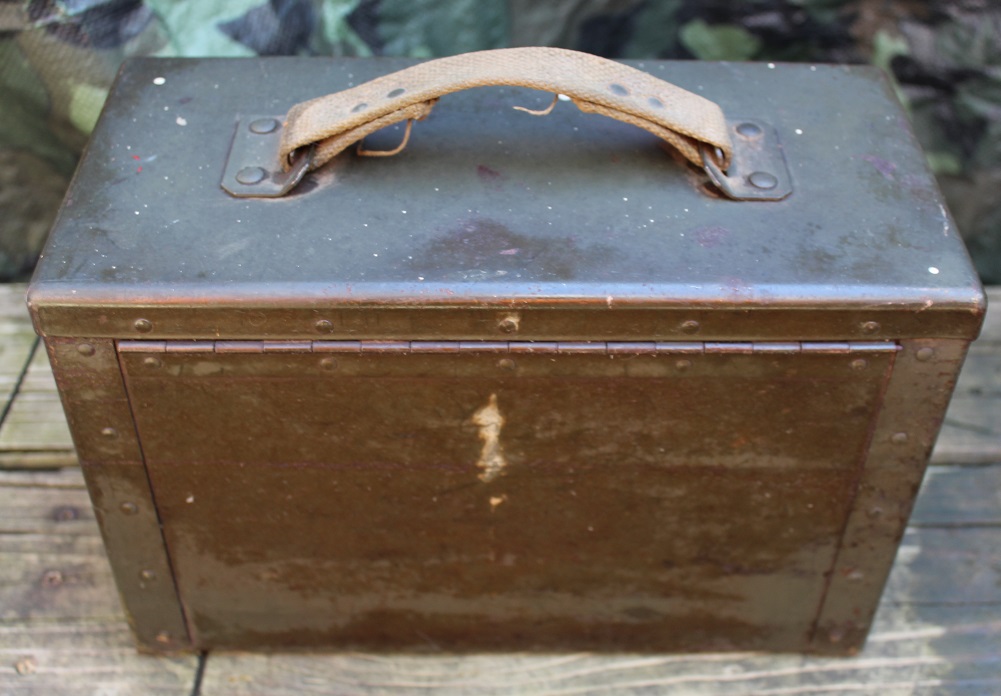

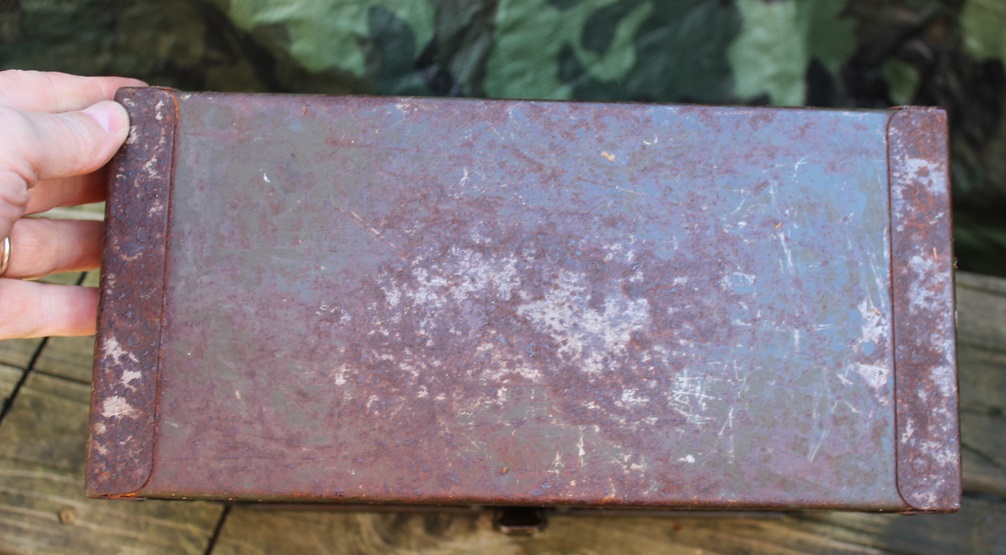


__________________________________________________________________________________________
331
Here we have an unissued PRISONER OF WAR Medal given by the USA to the POW’s. The Prisoner of War Medal is a military award of the United States Armed Forces which was authorized by Congress and signed into law by President Ronald Reagan on 8 November 1985. The United States Code citation for the POW Medal statute is 10 U.S.C. § 1128.
The Prisoner of War Medal may be awarded to any person who was a prisoner of war after April 5, 1917 (the date of the United States' entry into World War I was April 6). It is awarded to any person who was taken prisoner or held captive while engaged in an action against an enemy of the United States; while engaged in military operations involving conflict with an opposing Armed Force; or while serving with friendly forces engaged in armed conflict against an opposing Armed Force in which the United States is not a belligerent party. As of an amendment to Title 10 of the United States Code in 2013, the medal is also awarded for captivity under circumstances "which the Secretary concerned finds were comparable to those circumstances under which persons have generally been held captive by enemy armed forces during periods of armed conflict.” The person's conduct, while in captivity, must have been honorable. This medal may be awarded posthumously to the surviving next of kin of the recipient.
No more than one Prisoner of War Medal may be awarded. For any subsequent award of the medal, service stars will be awarded and worn on the suspension and service ribbon of the medal.
The medal was designed by Jay C. Morris of the United States Army Institute of Heraldry.
As perviously stated this medal is new and unissued in the box. For this nice piece $20.00
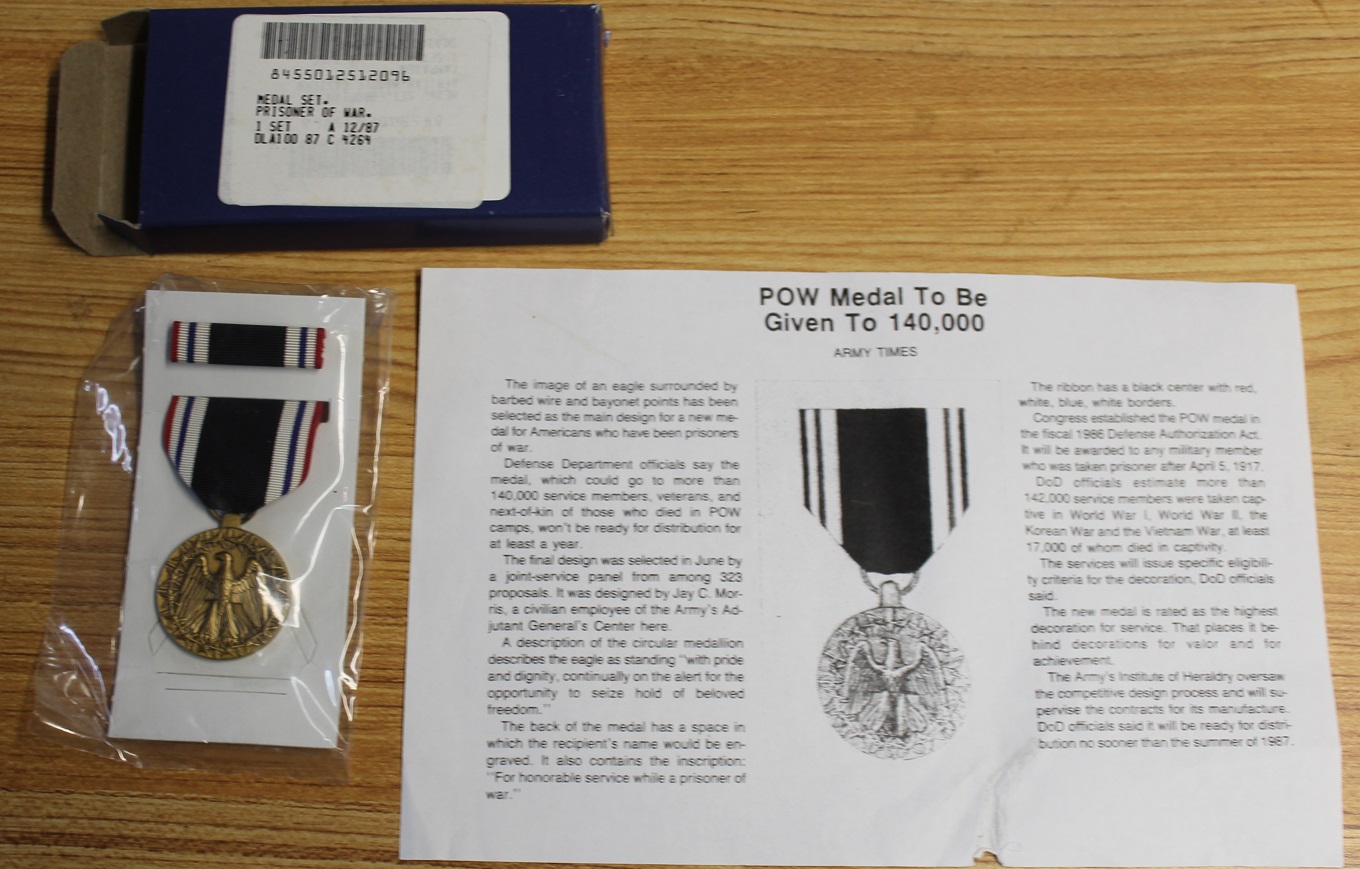
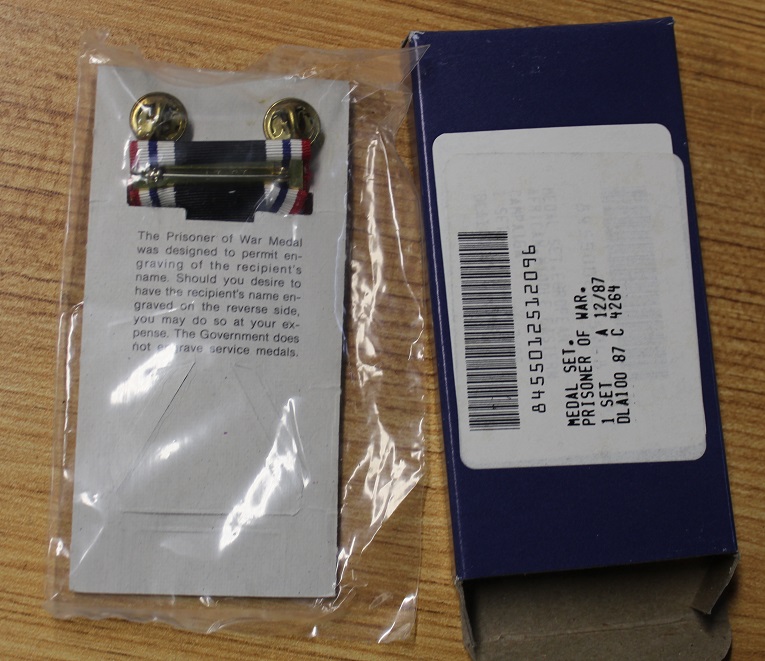
---------------------------------------------------------------------------------------------------------------------------------------------------------
tc 330
Here we have a Soviet Medal. The Medal "Veteran of Labour" was a civilian labour award of the Soviet Union established on January 18, 1974 by Decree of the Presidium of the Supreme Soviet of the USSR[1] to honor
workers for many years of hard work in the national economy, sciences, culture, education, healthcare, government agencies and public organizations. Although it only had a relatively short eighteen years of existence, it was awarded nearly
forty million times. Its regulations were detailed and approved by decree number 5999-VIII of May 20, 1974. Its statute was amended by multiple successive decrees of the Presidium of the Supreme Soviet of the USSR, first on June 8, 1977
then on August 12, 1983 and lastly on December 28, 1987. The medal ceased to be awarded following the December 1991 dissolution of the Soviet Union.
The Medal "Veteran of Labour" was designed by artist SA Pomansky. It was a 34 mm in diameter circular medal struck from tombac and then silver-plated and oxidised. The obverse of the medal bears the relief image of the hammer and
sickle over the inscription "USSR" . with diverging rays, a laurel branch spans the width of the obverse from right to left passing under the sickle's handle in an upward curve, along the lower and right circumference, a ribbon
bearing the relief inscription "VETERAN OF LABOUR" . The otherwise plain reverse bears the inscription on four lines "FOR LONG DILIGENT WORK" .
The Medal "Veteran of Labour" was secured by a ring through the medal suspension loop to a standard Soviet pentagonal mount covered by a 24mm wide overlapping silk moiré ribbon with 1 mm wide white edge stripes and coloured from
left to right by a 7 mm wide dark grey stripe, an 8 mm wide light grey stripe, and three 2 mm wide red stripes separated by two 0.5 mm wide white stripes.
Apparently, there is a variation of the medal, being stuck in silver as opposed to tombac, but this has not yet been verified.
Take a look at the pics. For this medal $10.00
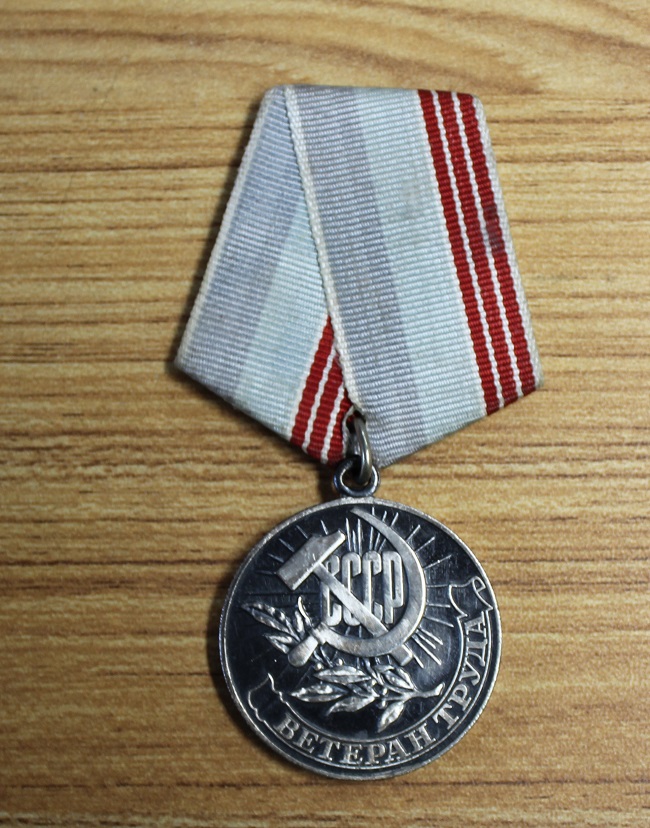

---------------------------------------------------------------------------------------------------------------------------------------------------------
tc 329
Here we have some WW2 Japanese Civilian patches or Roundels that was worn on the workers uniform. Listed as WW2 Imperial Japanese Army Civilian sleeve wood roundels. A 5.5cm or 2 inch diameter olive drab wool
patch with an alloy backing, upon which is sewn a red or orange felt five-pointed star. We have red stars and orange stars. They also came with white stars. If you know why the different colors let us know. Each $20.00
Check out the pics!
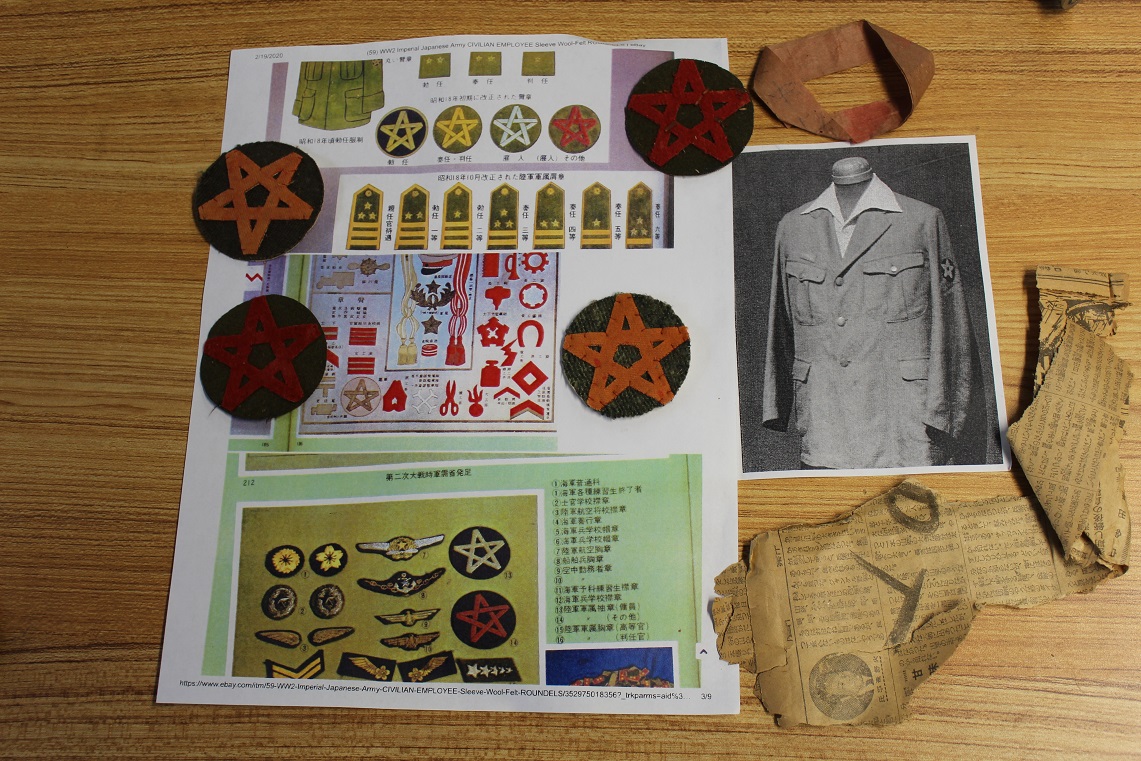
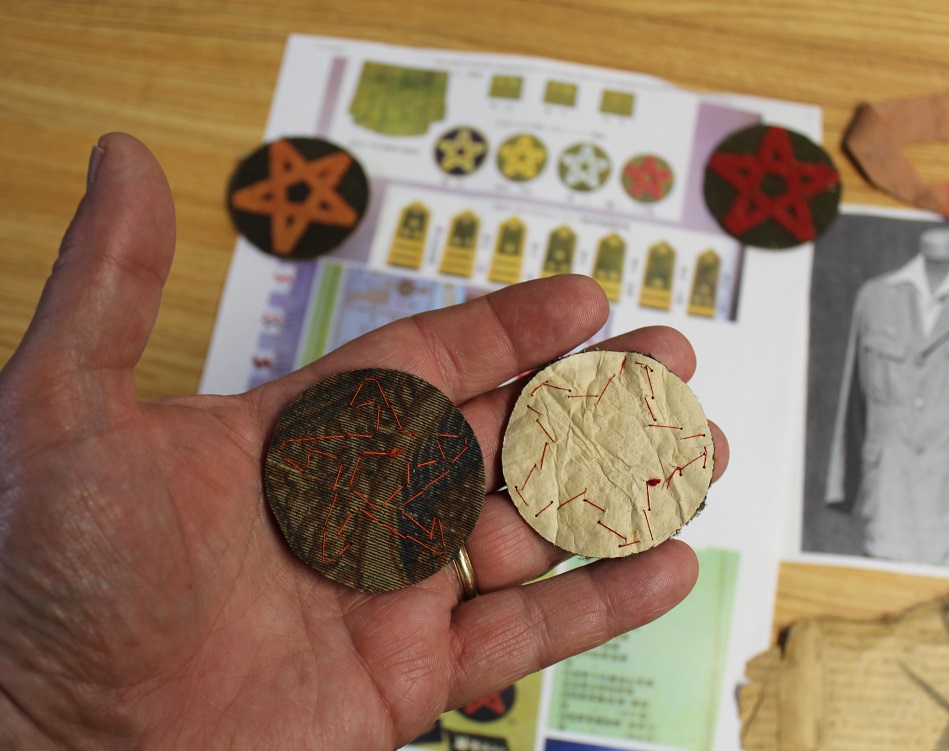
_________________________________________________________________________________________________________________________________________________________
tc m3 knife 317
Here we have a WW2 field repaired M3 Trench Knife! The M3 knife was developed in 1943 for our fighting men in the War Theatre! This knife was manufactured by at least 9 makers but this one is an Imperial and you can still see remnants of the stamped name on the blade. The Govt. purchased these fighting knives during 1943 and 1944. This well loved knife was most likely broken in the field and the blade was field welded back together. This soldier must have really loved this knive or really needed it or both! Don’t have a story to accompany it as this is how it was found without scabbard/sheath. You can see a couple of cracks in the blade but it’s as solid as a rock! For this old fighin’ Lady $65.00



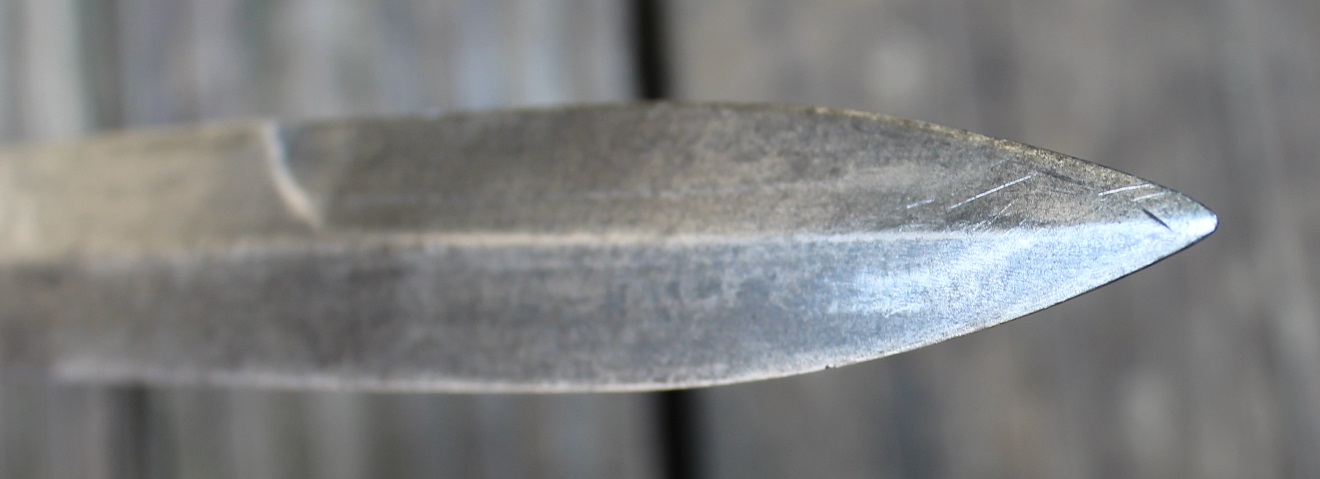


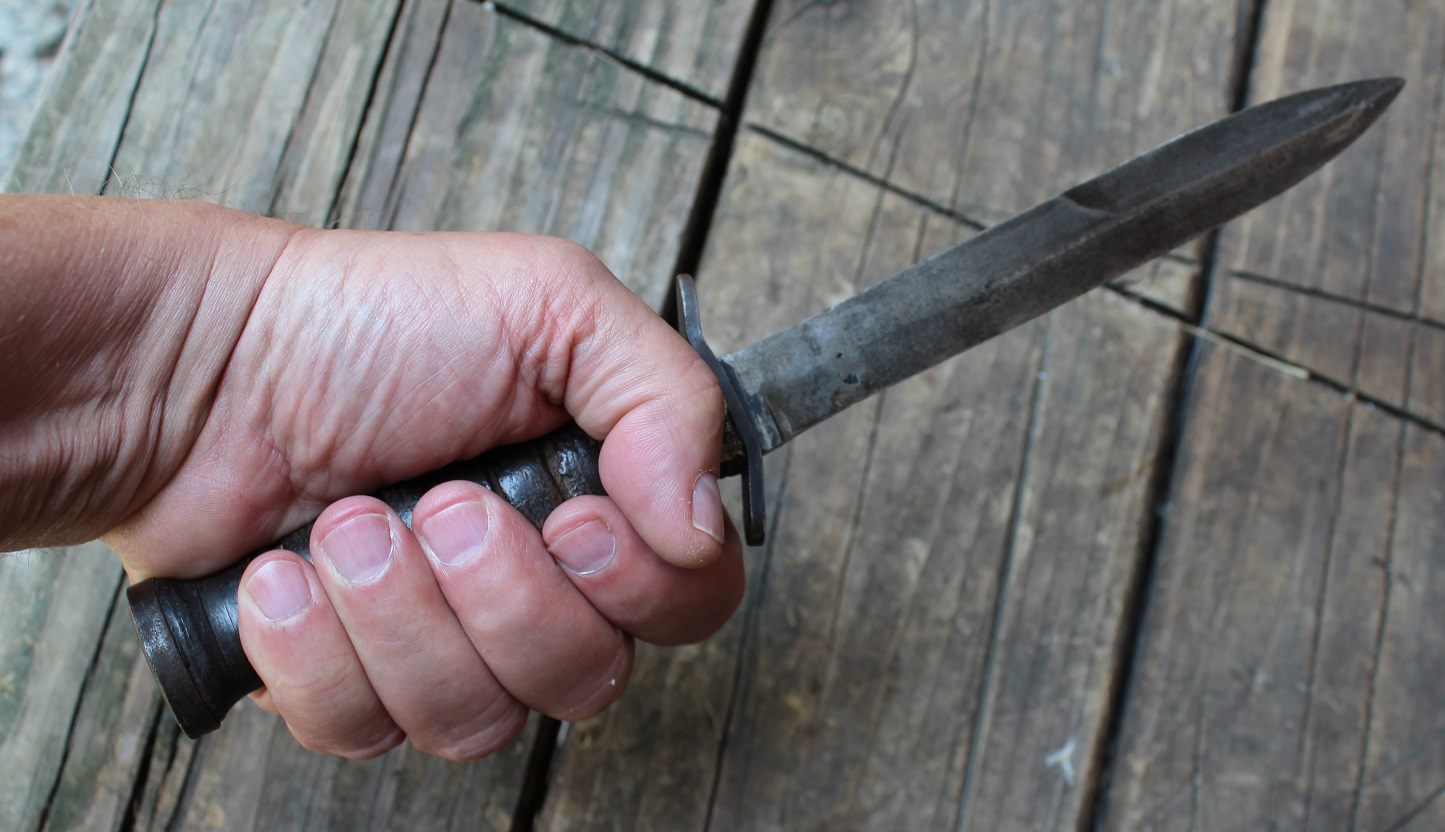
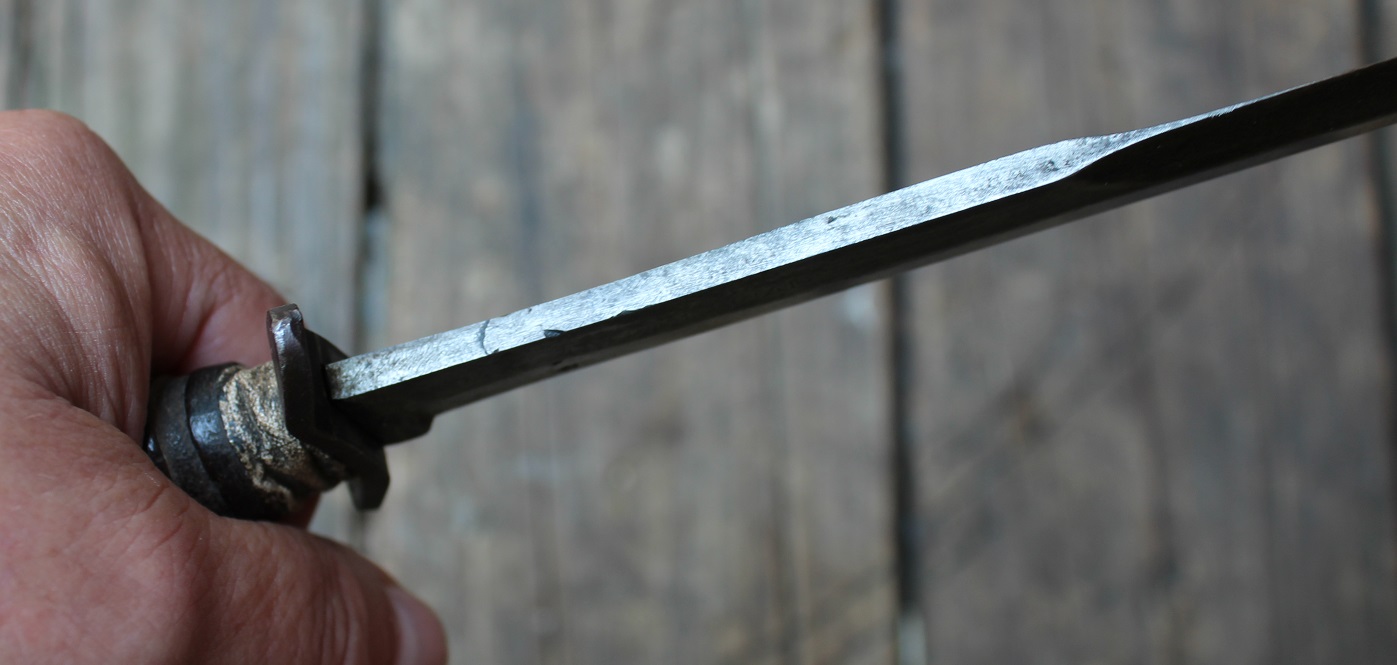
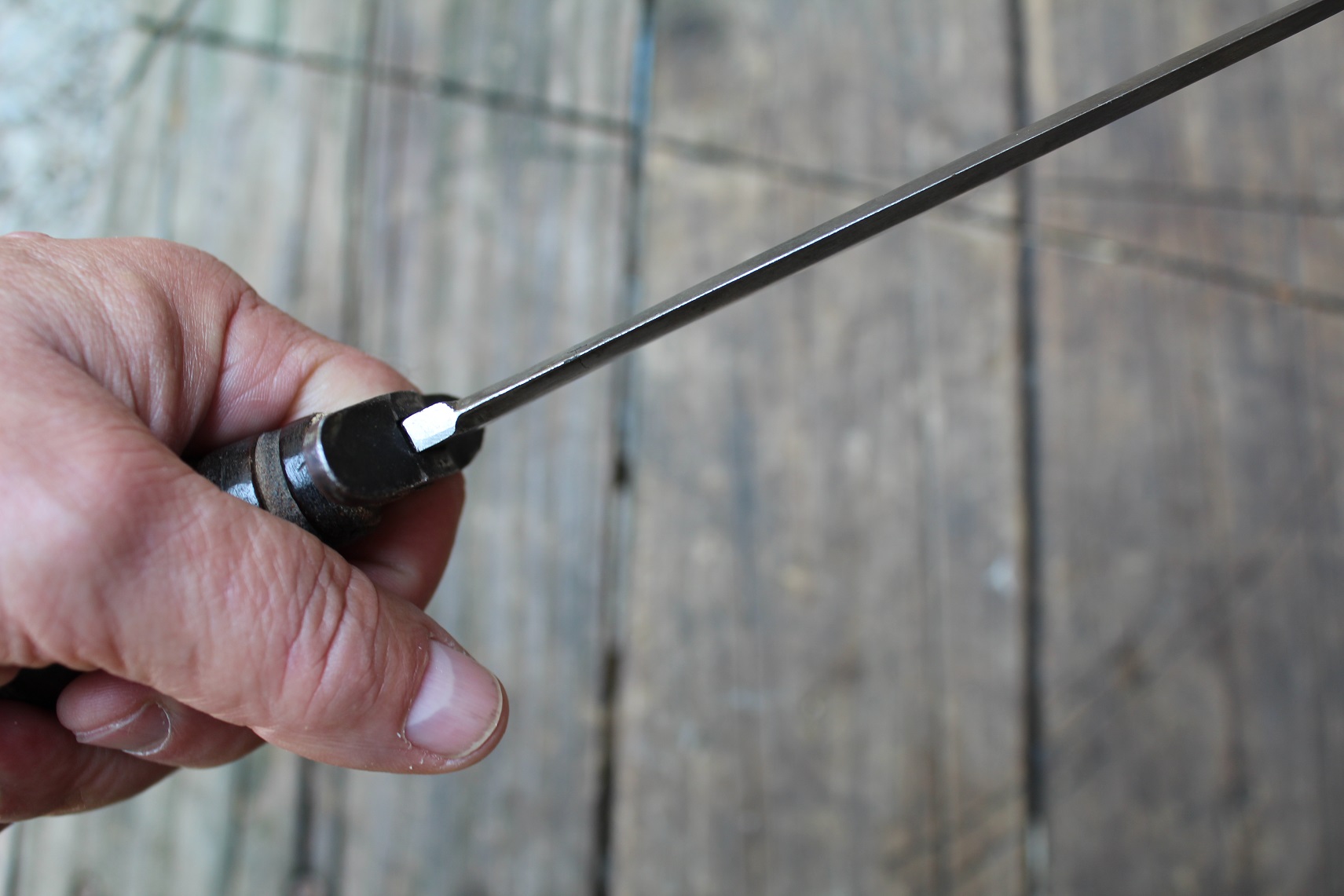
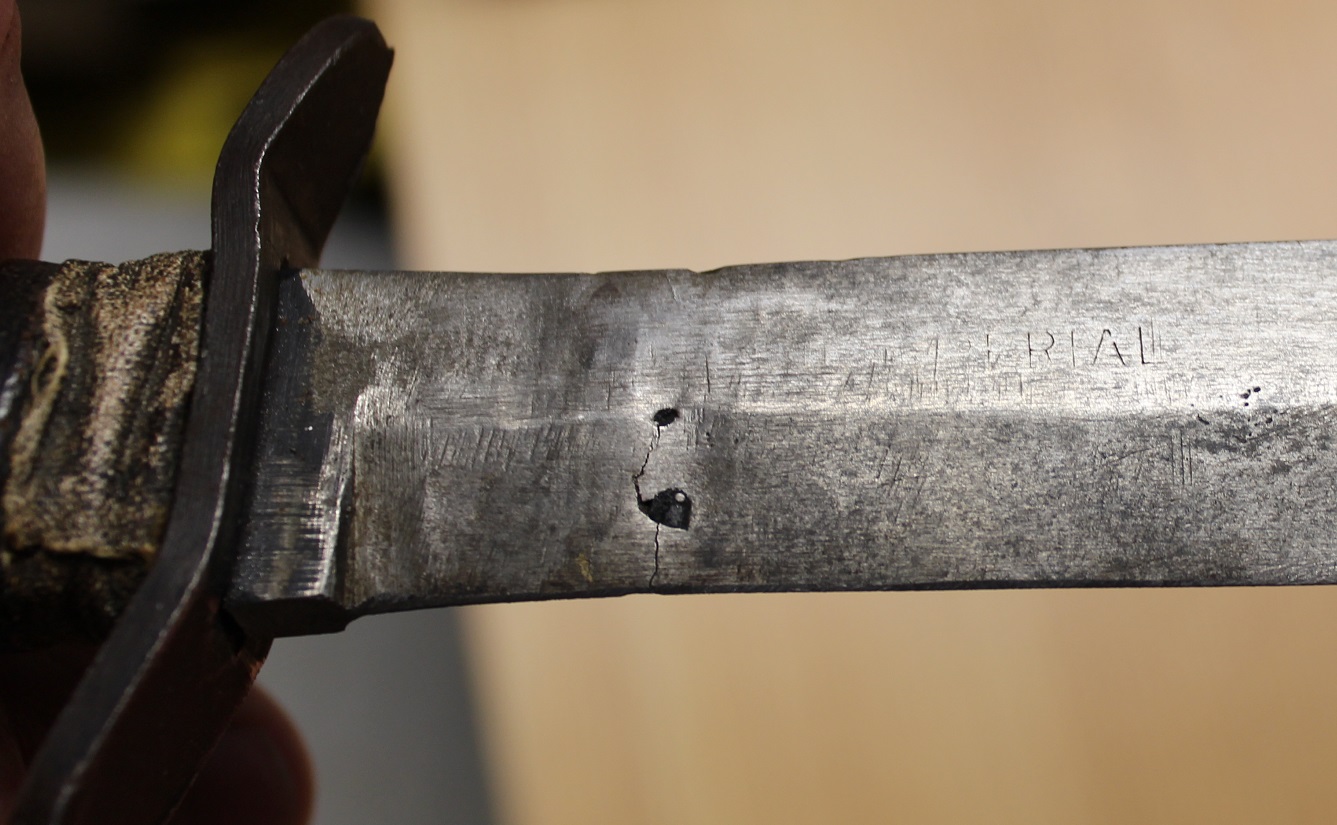

---------------------------------------------------------------------------------------------------------------------------------------------------------
307
Here we have an Inert WWII US 75mm M18 tank shell projectile
that was found at a local flea market. I found on it was a photo on wikipedia that shows a pile of projectiles and one like this one is laying off to the left. The caption
under
the photo is in cryllic Russian so I can make it out. This inert projectile is in excellent condition and safe for display! This type of round was predominately used on the US Sherman and Hellcat tanks during WWII.
Capture a piece of US WW2 Memorbillia for your desk! For this piece $125.00
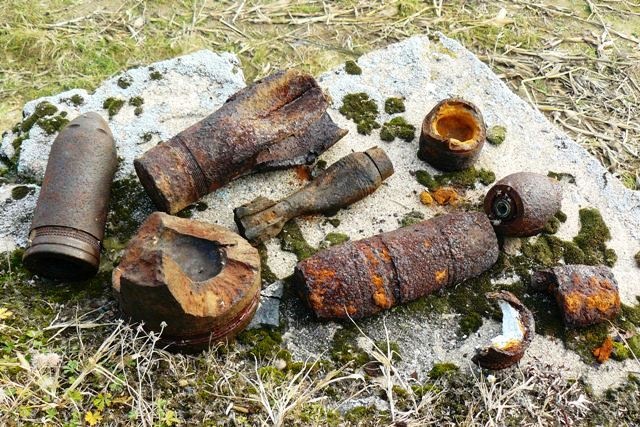
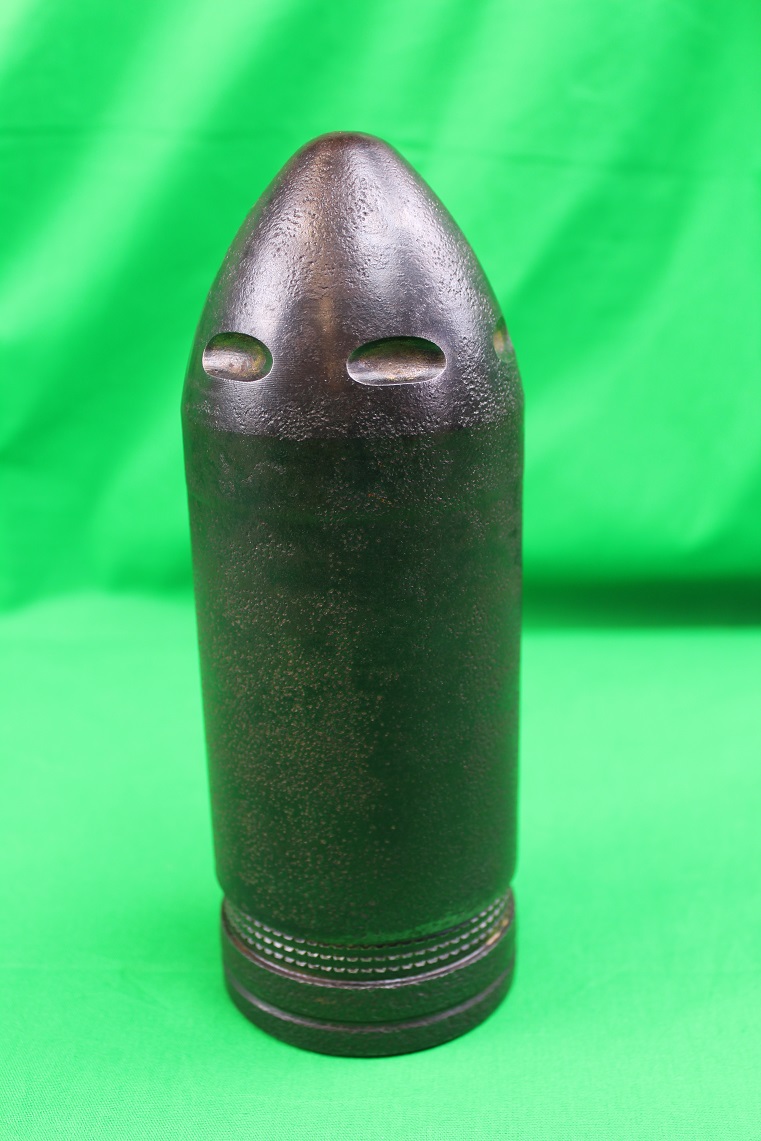
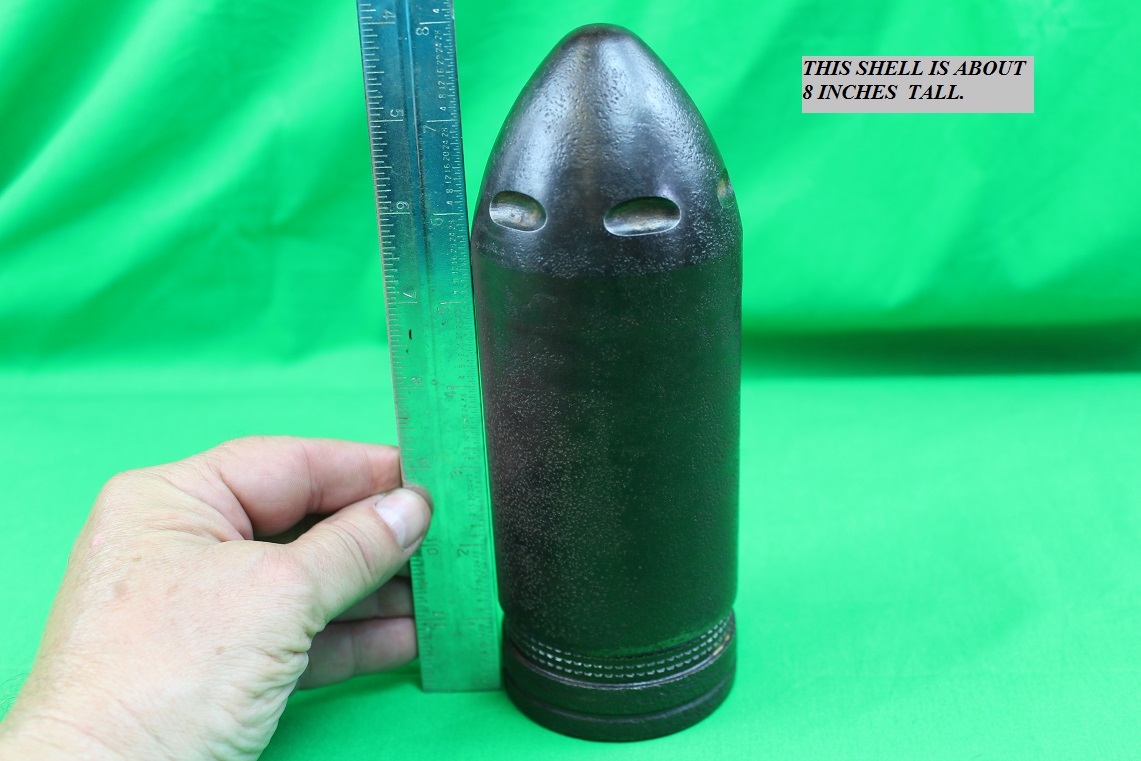
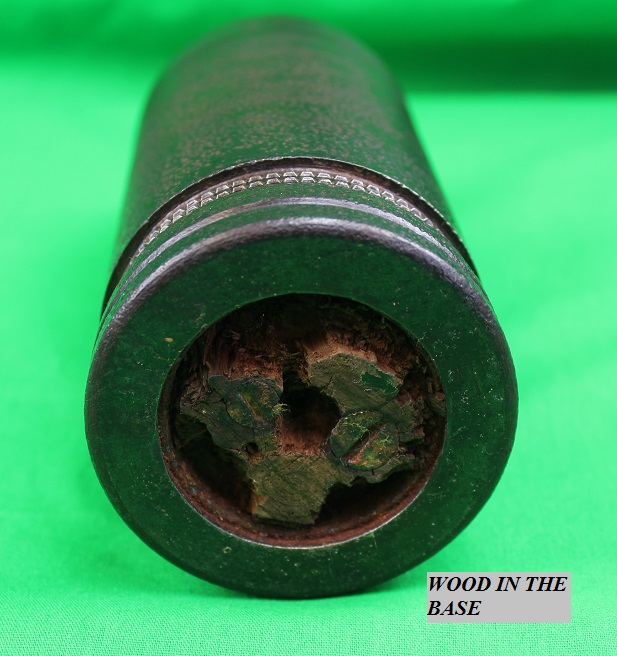
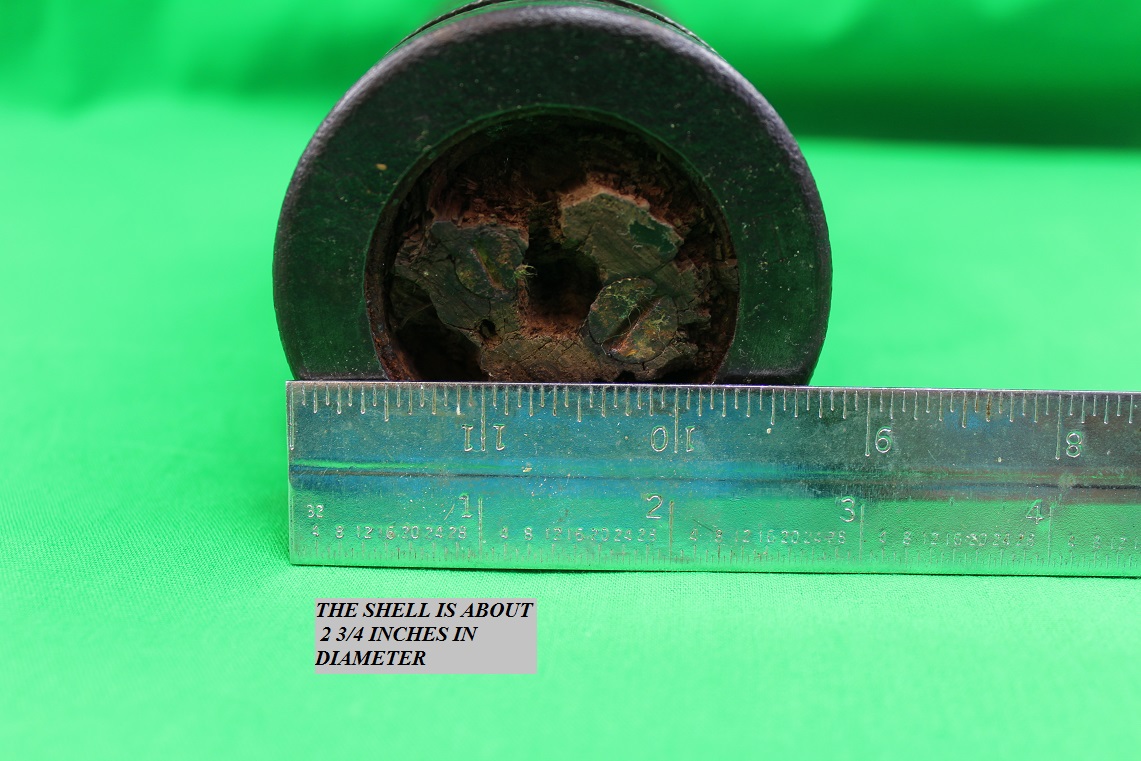
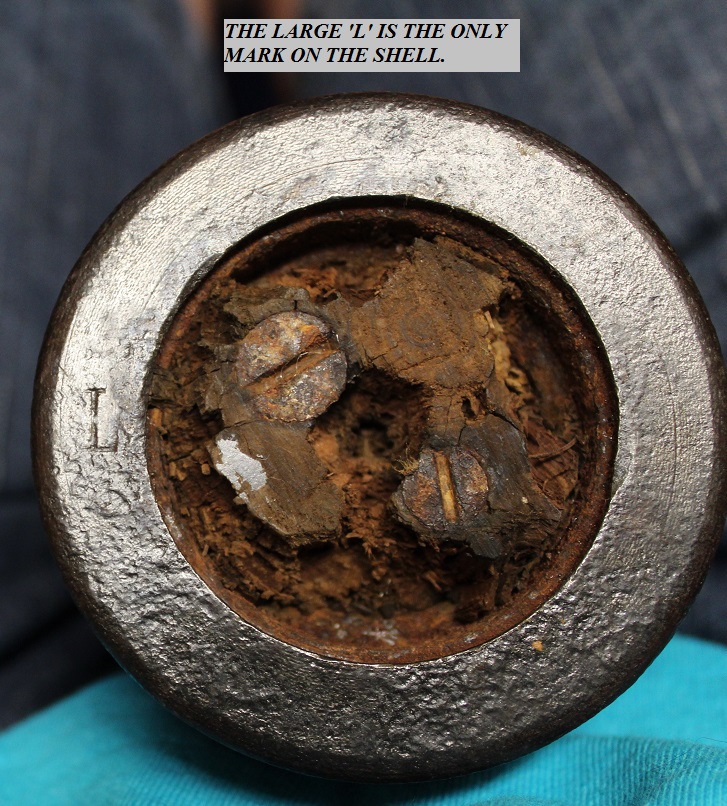
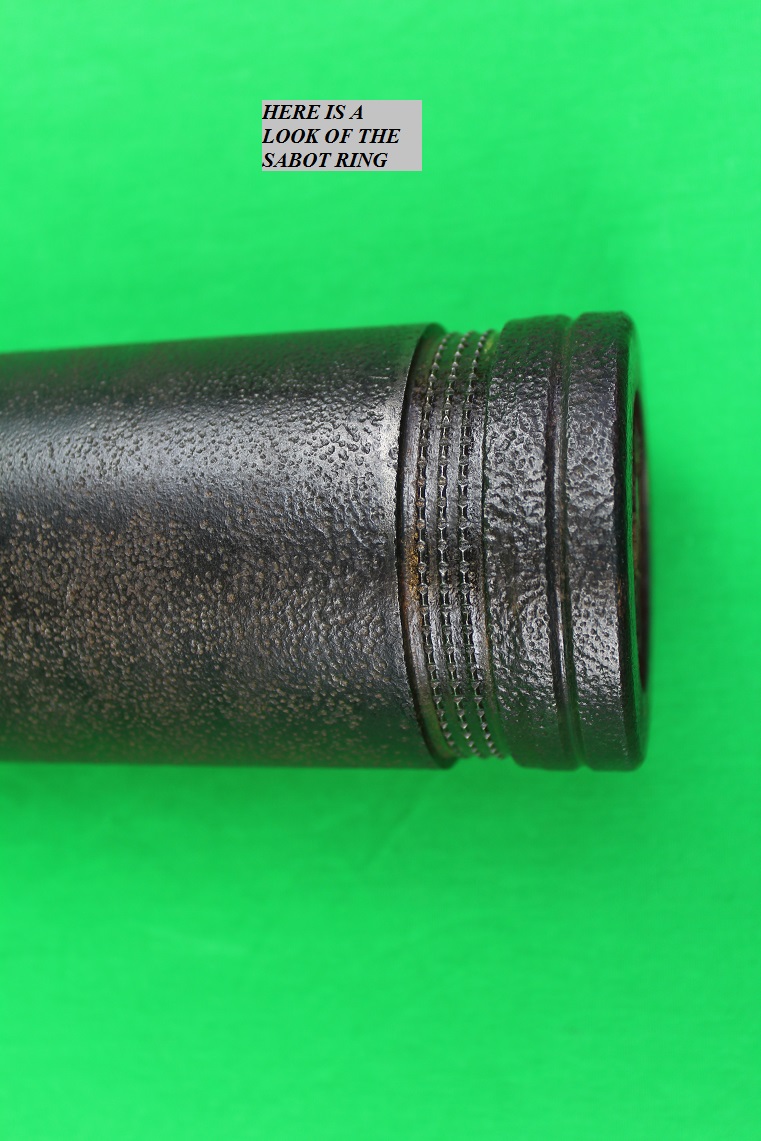


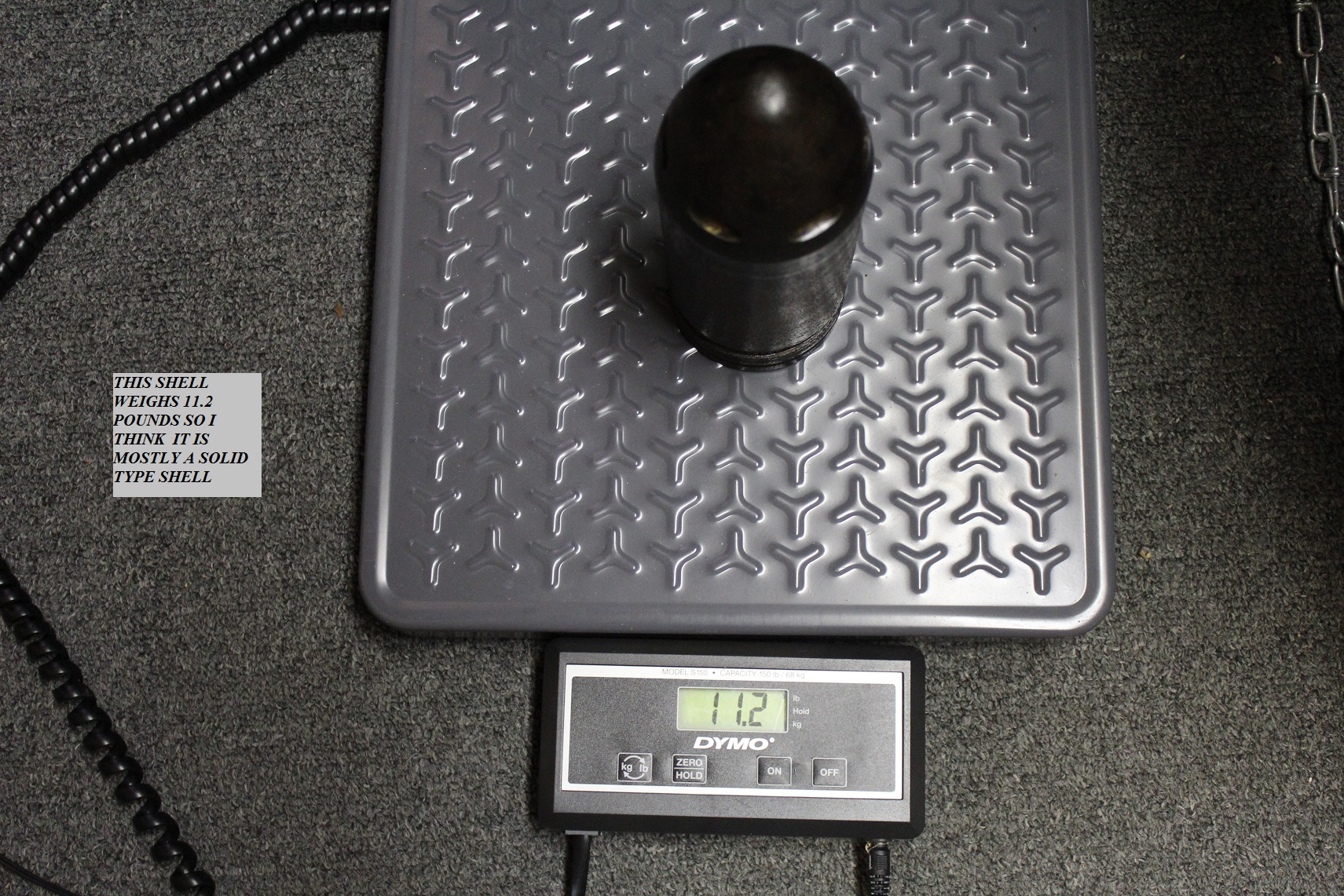
_______________________________________________________________________________________________
195 WW1 & WW2
Here we have a lot of Broom tail Mauser ammo in clips and in box! 7.63 MAUSER Ammo
7.63 Mauser ammunition goes by a few names, 7.63 x 25mm, 7.63 Mauser, and the .30 Mauser automatic. The round is quite proficient and famous, even if you’ve never heard of it before. 7.623 Mauser ammo was the round used in the famed C96
Mauser also known as the “Broomhandle Mauser”. That’s the famed weapon Han Solo wielded in the movie Star Wars. The Mauser factory has produced some of the greatest and most influential weapons and ammunition in the world. 7.63 Mauser
rounds were one of the first massively successful automatic cartridge rounds, paving the way for commercial development of automatic pistols the world over.
In Europe the round was widely adopted by everyone from Australia, Finland, Austria Hungary, to Germany. The 7.63 Mauser round was not only popular is pistols, but in sub machines guns as well. The Mauser C96 was also converted into one of the
first machine pistols. The cartridge found service in numerous wars all over the world, including World War 1 and the Finnish Civil War.
Today, 7.63 Mauser ammunition is still being produced and fired in weapons built over a hundred years ago. While the cartridge isn’t in service with any modern military, the round is still popular with numerous collectors, re-enactors, and enthusiasts.
7.63 Mauser is still quite popular with modern ammunition being manufactured for it.
The Mauser C96 (Construktion 96) is a semi automatic pistol that was originally produced by German arms manufacturer Mauser from 1896 to 1937. Unlicensed copies of the gun were also manufactured in Spain and China in the first half of the 20th
century.
The distinctive characteristics of the C96 are the integral box magazine in front of the trigger, the long barrel, the wooden shoulder stock which gives it the stability of a short-barreled rifle and doubles as a holster or carrying case, and a unique grip
shaped like the handle of a broom. The grip earned the gun the nickname "Broomhandle" in the English-speaking world because of its round wooden handle, and in China the C96 was nicknamed the "box cannon" (Chinese: ___; pinyin: hézipào)
because of its rectangular internal magazine and the fact it could be holstered in its wooden box-like detachable stock.
With its long barrel and high-velocity cartridge, the Mauser C96 had superior range and better penetration than most other pistols; the 7.63×25mm Mauser cartridge was the highest velocity commercially manufactured pistol cartridge until the advent
of the .357 Magnum cartridge in 1935.
Mauser manufactured approximately 1 million C96 pistols,]while the number produced in Spain and China was large but unknown due to the loss, non-existence or poor preservation of production records from those countries.
Here we have 95 vintage rounds of ammo and 9 separate stripper clips. $125 for the lot.

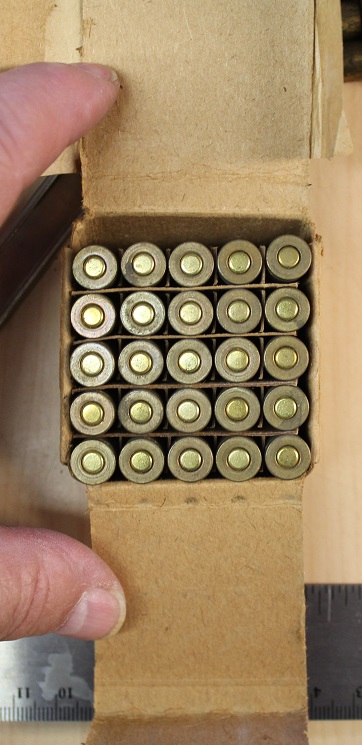
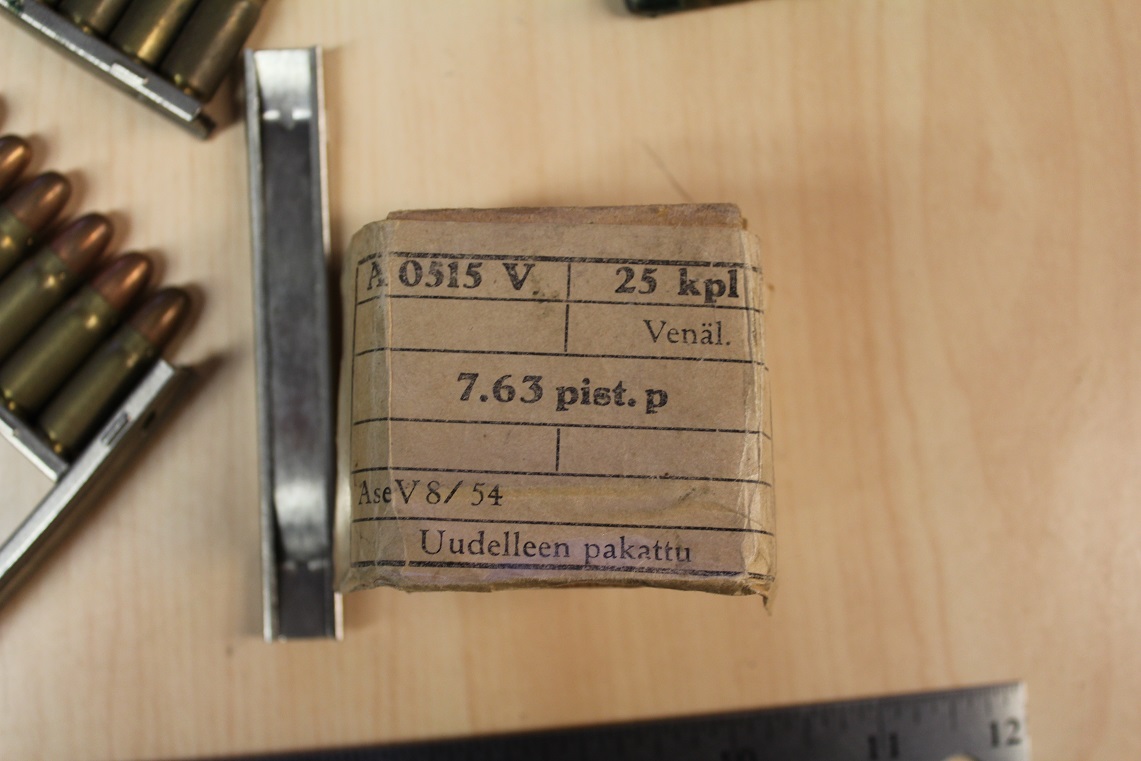
Item No. 66
Parris-Dunn Civilian Training Rifle circa 1943
Following the completion of their military contracts for the Parris-Dunn Training Rifle in 1943, they continued making a similar model for the civilian market. In 1949, William Dunn retired and sold the company to Cecil Parris. Parris renamed the company the Parris Manufacturing Company and continued to produce toy guns and drill rifles in Clarinda until 1951. In 1952, he moved the company to Savannah, Tennessee. The company is still located in Savannah and continues to produce a variety of toys.
This particular training rifle is one of the early ones as the buttplate says MADE IN USA ,PARRIS-DUNN, CLARINDA, IOWA. This rifle still has part of the original decal on the stock and you can still see TRAINER Pat Pend. The rifle is complete and nothing is missing. It's common for the rear sight to be broken but it's entact. The sling swivels and stacking swivel are still present as well. There was no provision for this training rifle to have a bayonet mounting stud. On the military rifles the nose cap and barrel band are steel but on this civilian model they are just painted on. This is a piece of our history! $145.00



WW2 Item No. 47
We have here a pen desk set for Maj Rodney S./ Syczylo, 100th S&S BN (DS) who must have served there fro July 1975 to December 1975 as indicated on the plaque. I believe that he handled the Stores and Supply. This is a nice desk set with a mechanical clock. Check out the pics. $35.00

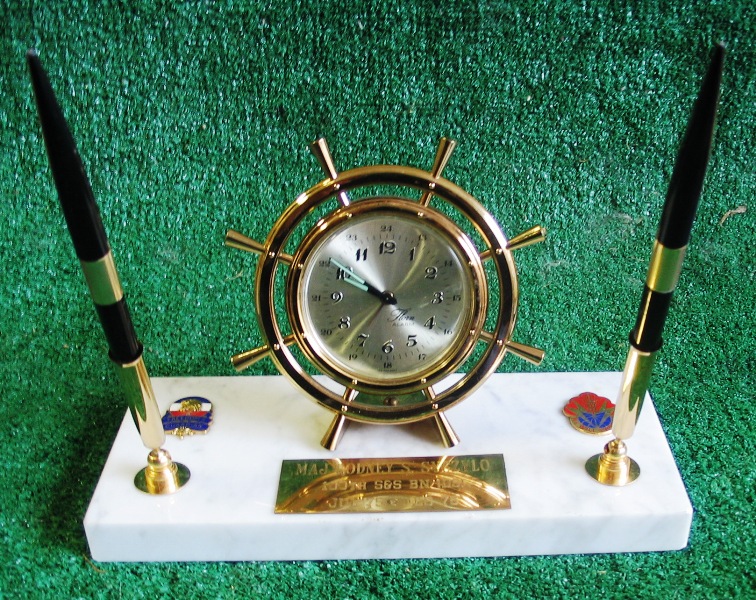

PARRIS-DUNN TRAINING RIFLES
Mark I Navy model

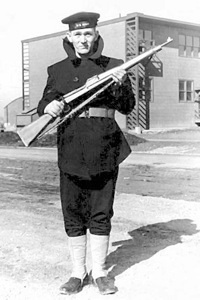
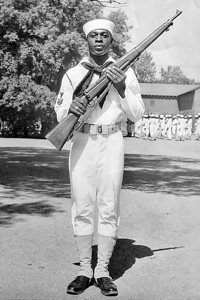
Here we have a couple of the Mark I Navy Model training rifles. Here is some history of the company.
Unfortunately, no Parris-Dunn production records still exist, so all of the information relating to them has been pieced together from other sources. An early employee by the name of Maurice O. Greimann wrote short article in 1984 concerning the Parris-Dunn Corp and his information has been invaluable. In 1943 Mr. Greimann came to work for the Parris-Dunn Corp. as an electrical engineer. When the work shifted to making Training Rifles he became involved in their production and designed the firing mechanism for the first toy guns they later produced.
The Parris-Dunn Corporation was founded by William G. Dunn and Cecil L Parris when they formed a business partnership in 1937. Each of these men brought unique contributions to this partnership. Although Dunn had no formal technical training he, like many great inventors, could see the interrelationships that existed between different mechanical devices and could modify or combine them to solve problems. Parris had a background as sales manager for the Kari-Kleen company of Souix City, Iowa and was a talented merchandiser. Initially Parris was the President of the corporation and Dunn the Vice-president but during the war years their positions reversed.
William G. Dunn (1883-1968) ran a hardware business in Clarinda, Iowa in the early 1900's. In 1917 he formed the Dunn Counterbalance Company operating out of the back of his hardware store. He eventually built a factory on South 15th Street in Clarinda and the name was changed to the Dunn Manufacturing Co. He was a very talented inventor and eventually held patents for 75 different mechanical devices, many of which were related to the early automobile and aircraft industry. In 1934 he developed a wind driven generator that was designed for farm use. His primary invention was a device to control the speed of the propeller on this device. In 1936 he formed a partnership with Cecil Parris in order to better promote his generator business. In 1937 they sold 37,000 of these units. When WWII broke out in 1941 their wind generator business was declared nonessential and they were only allowed to make repair parts for the units already in use. There was a severe shortage of military firearms at the start of the war and they were approached by US Army Ordnance to produce a non-firing training rifle. Shortly after, the US Navy also expressed interest in this project but they wanted some slight modifications in their model.
In July of 1942 the Army let contract 271 ORD for 35,000 training rifles of their pattern at a cost of $166,000. In August the Navy let contract NROS 10993 for 190,000 training rifles having their changes at a cost of $903,000. In October of 1942 the Army contract was completed and in November they finished the first Navy contract. In January of 1943 the Navy let contract NORD 808 for 110,000 additional training rifles and in June that contract was completed. The total cost of the 300,000 rifles produced for the Navy was $1,384,000. The cost per rifle for the first contract was $4.75 and for the second contract $4.37. By the time of the second contract, Parris-Dunn could no longer get walnut wood for the stocks as all of it was going to arsenals that were making functional military rifles. They had to start using a cheaper grade of wood during the last contract which lowered the unit price.
Prior to the start of the military contracts Parris-Dunn recognized that they did not have sufficient personnel to produce the required number of training rifles in a short period of time. They put together another organization called Parris-Dunn Associates to undertake this important project. I have a document that contains the following: “C.L. Parris, W.G. Dunn and H.E. Davidson, Copartners, doing business as Parris-Dunn Associates”. At this time I have not been able to identify H.E. Davidson. They immediately expanded into all of the available building space in the area and hired more employees. This number grew to 250 during the peak of their production. They sub-contracted much of the work to 14 different businesses. The wooden stocks and sights were manufactured at their Clarinda plant and all of the assembly and finishing was also done there. They had that capacity to produce over 3000 training rifles a day. They became so efficient that the company voluntarily returned $228,000 to the Government as excess on allowable profit. On July 23, 1943 Parris-Dunn Associates received the coveted Army-Navy “E” Production Award.
After the completion of their military contracts they continue to produce 200,000 of a civilian model for drill corps, schools and ROTC programs. The civilian model was essentially the same as the military models but had different markings.
In November of 1945 The Nave classified their training rifles as surplus and offered them for sale at $7.75. This price included a plastic bayonet and scabbard. Nothing is known concerning the disposition of the Army training rifles.
The Parris-Dunn Training Rifle is not a very accurate replica of the 1903 Springfield Rifle. It has a similar profile but is thinner in cross section and 3 pounds lighter in weight. The receiver, bolt and trigger mechanism are simple and crude by comparison to the Springfield. It has the general feel and appearance of a toy. It was reported that these training rifles were not very popular with soldiers and sailors that were required to use them during basic training. It must be noted that there were no other alternatives available at the time.
The two examples we have are marked for the Navy. They are:
Item No. 32
1. This one is complete with sling although the sling is a little beat up but there. The rifle is complete and in good condition with no cracks or breaks. The rear sight is still there and usually these are broken. The bolt opens as it should and the rifle fires (clicks) as it should. These training rifles were usually beat to death while being used and after surplused out. Sling swivels are present as well as the stacking swivel. The bayonet lug is still present as well. The buttplate states DUMMY TRAINING RIFLE - MARK 1-U.S.N. PARRIS-DUNN CORP. - CLARINDA, IOWA. For this nice piece of U.S.Navy History $165.00
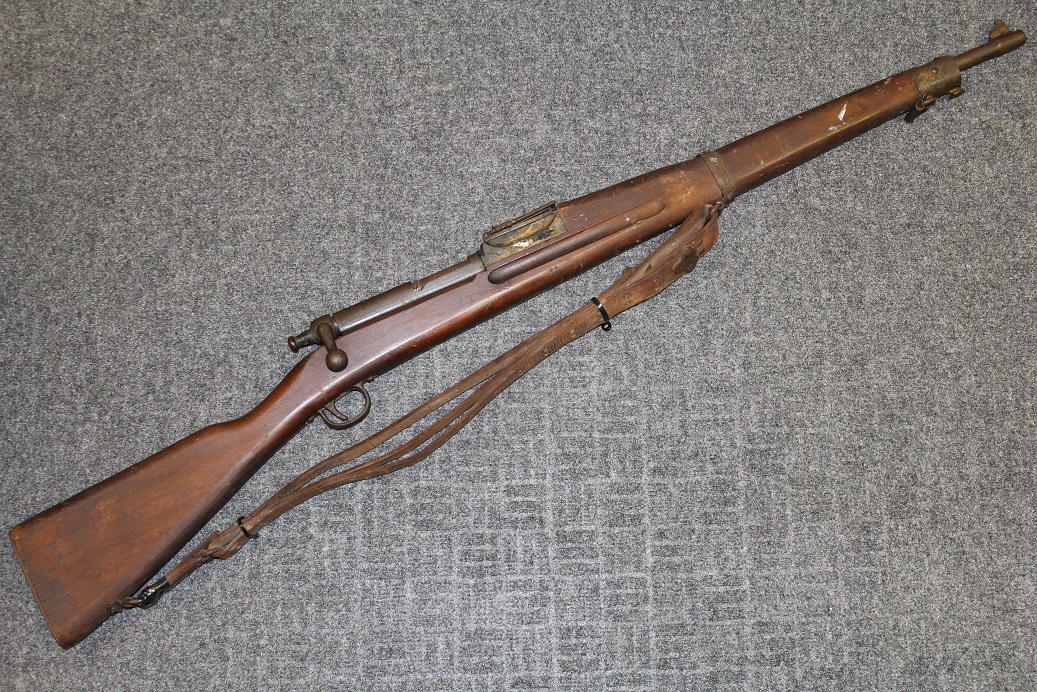
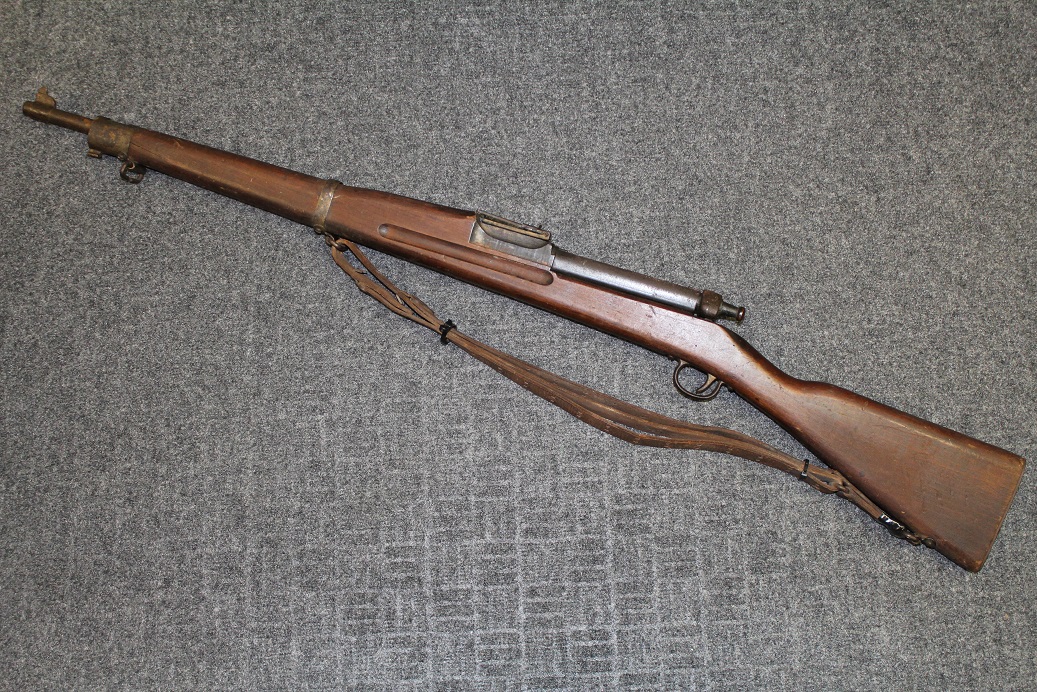
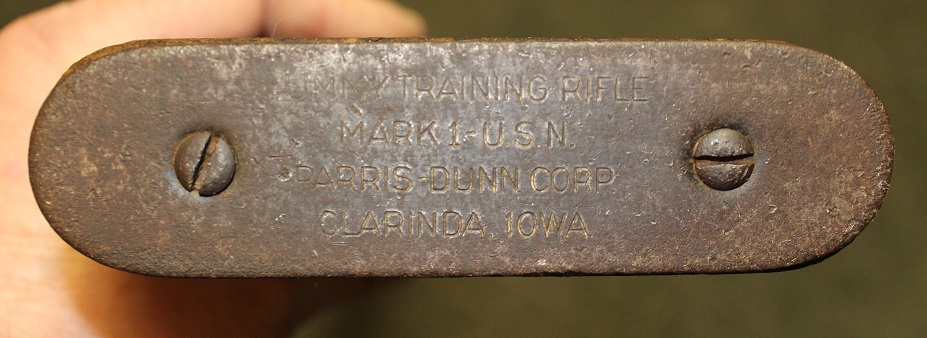
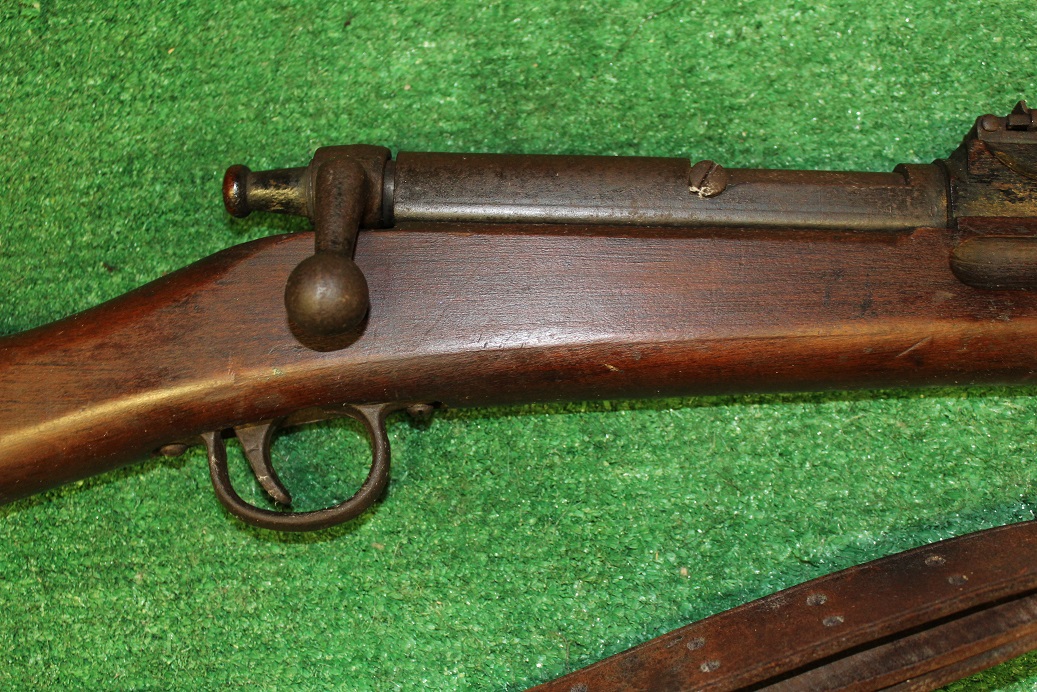
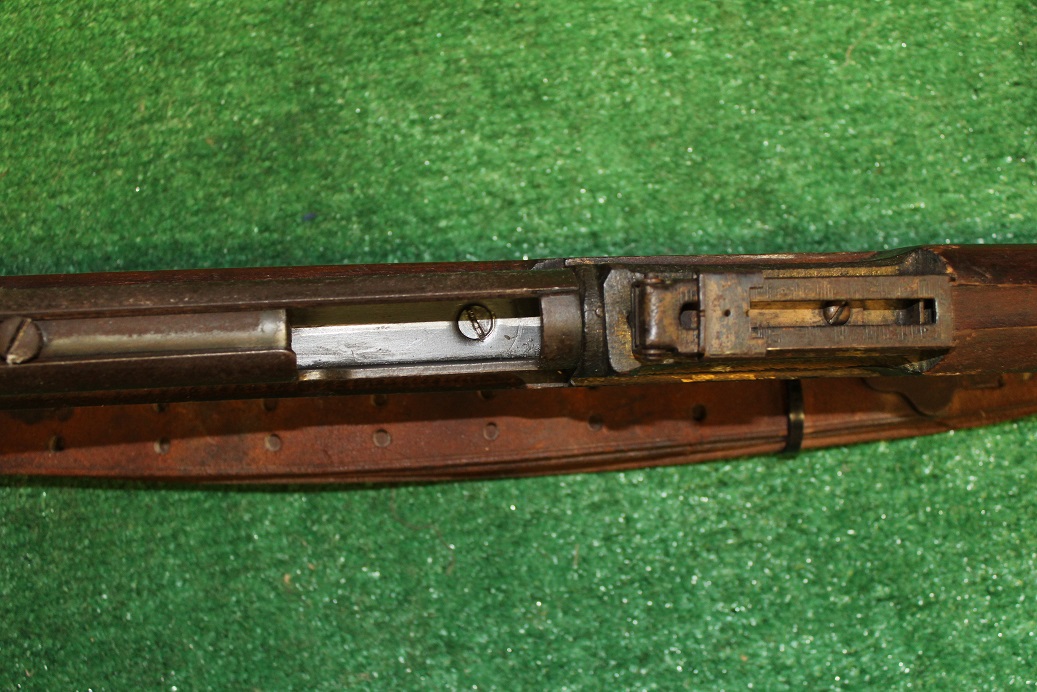
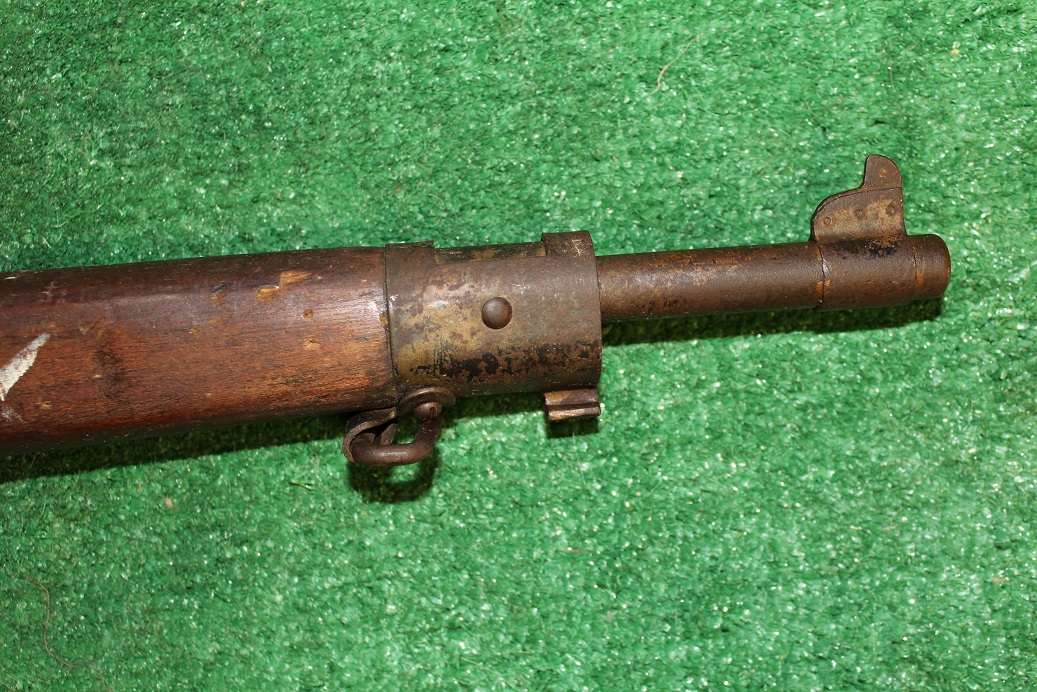

Item No. 31
2. This next one is pretty nice as well but has part of the rear sight broken off and does not have the sling. This one 'fires' as it should as well. The wood is pretty nice with a few gouges from use. There are a couple of cracks in the buttstock but they are stable. The sling swives and stack swivel are present with this one as well as the bayonet lug. This would look great over the fireplace and you don't have to worry about the kids hurting themselves with it. $125.00
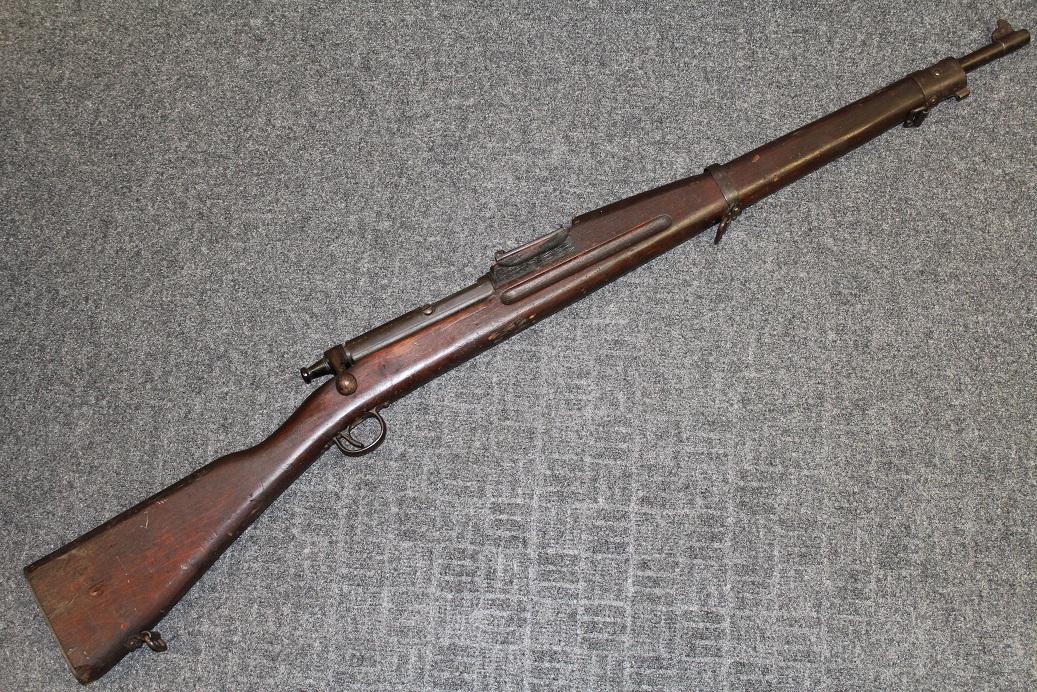
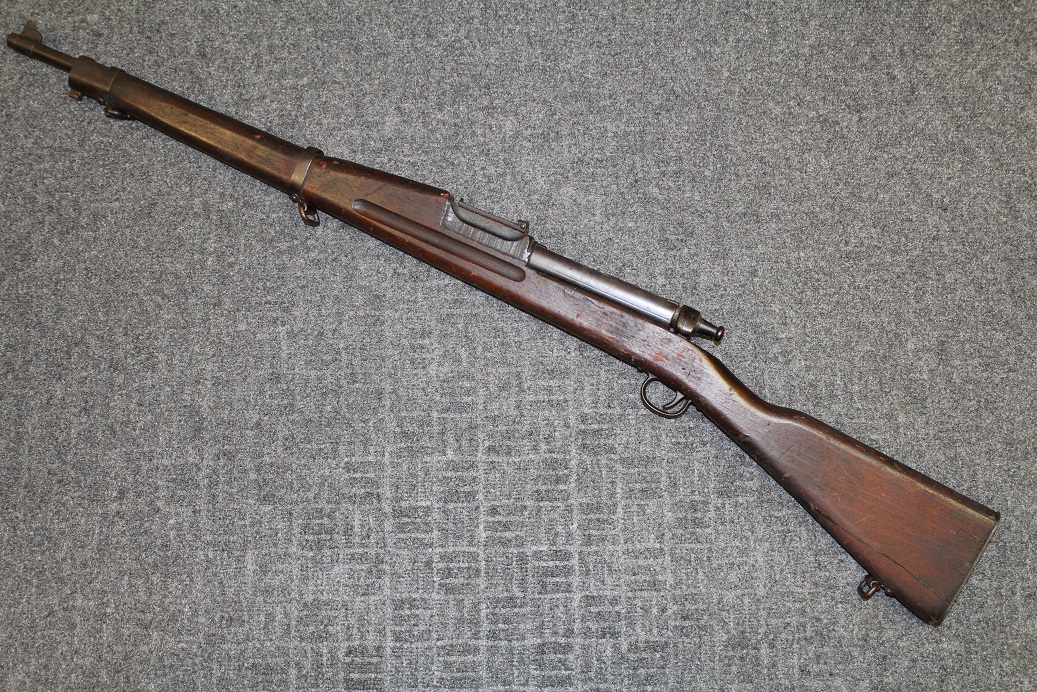
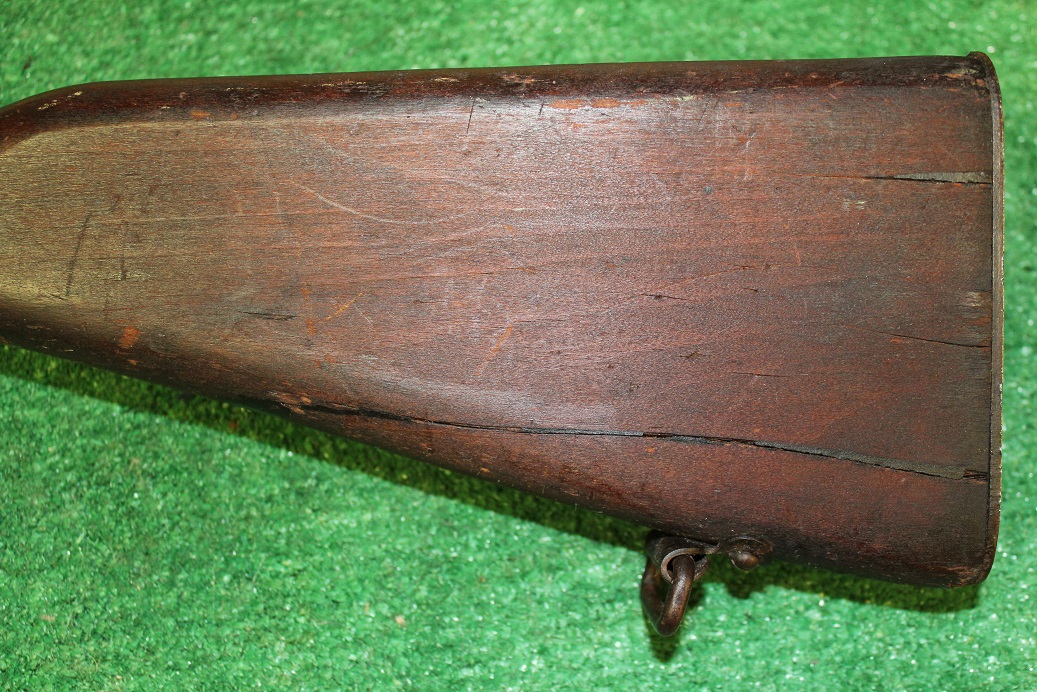
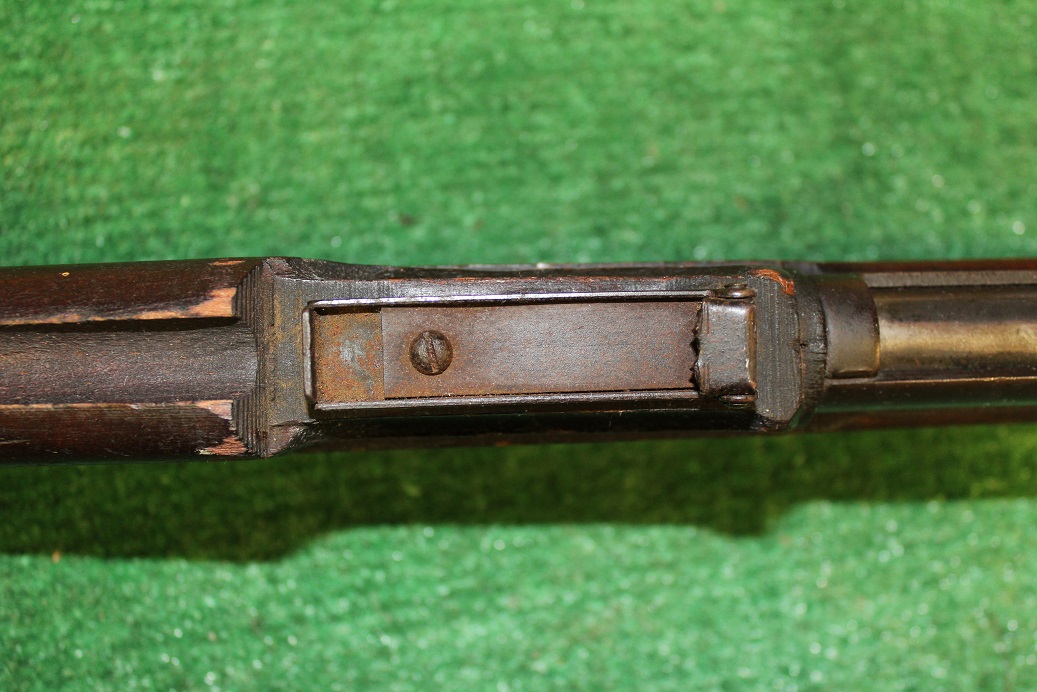
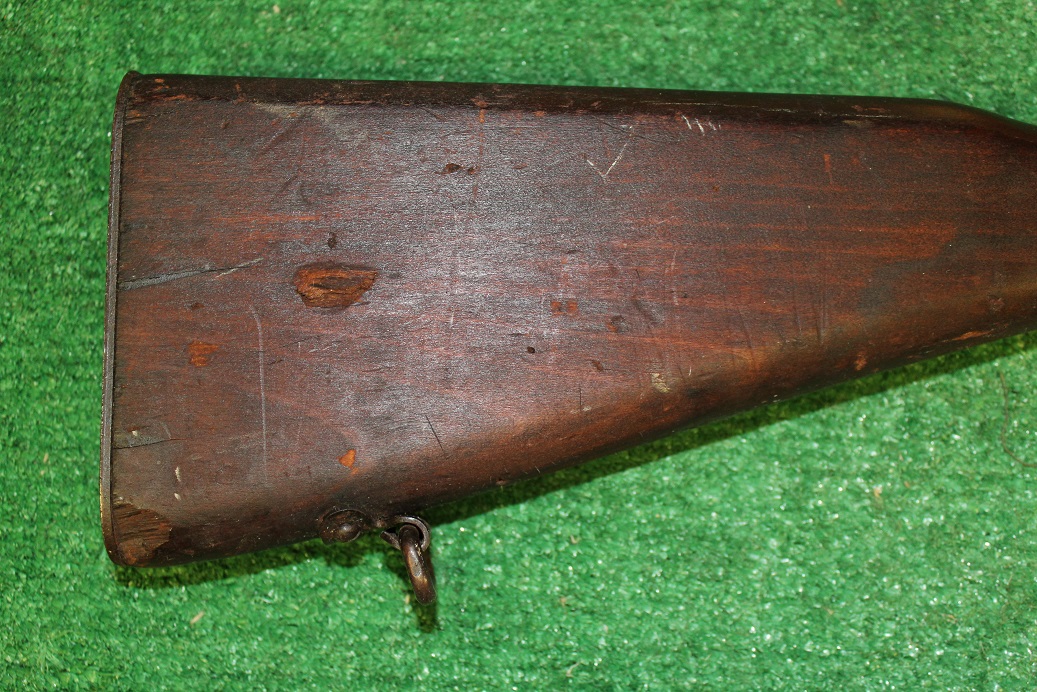
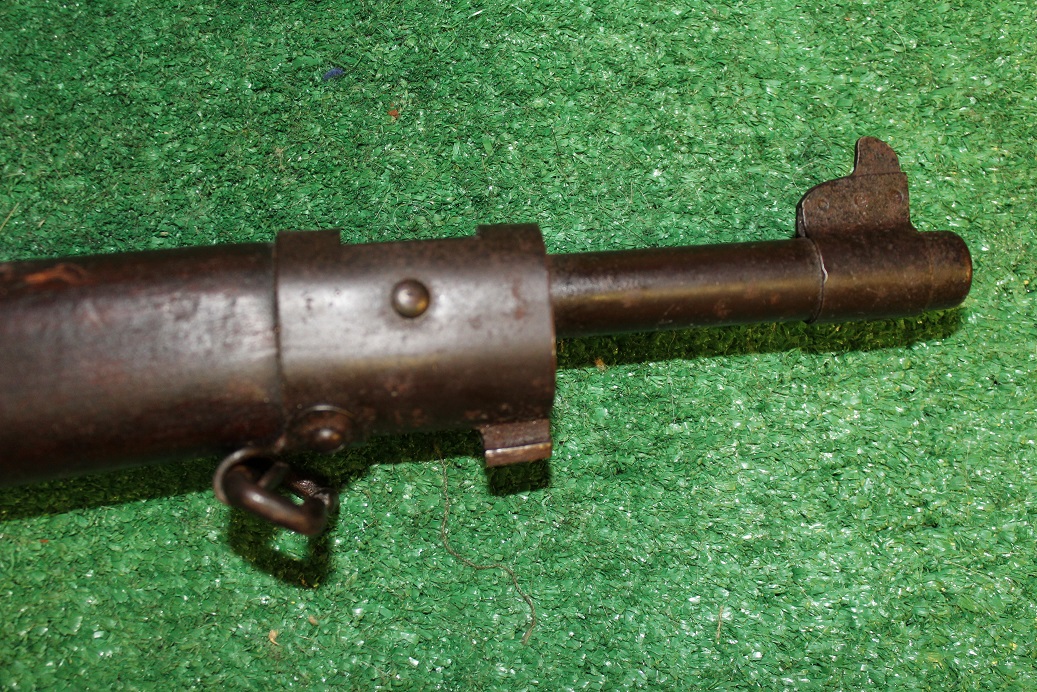
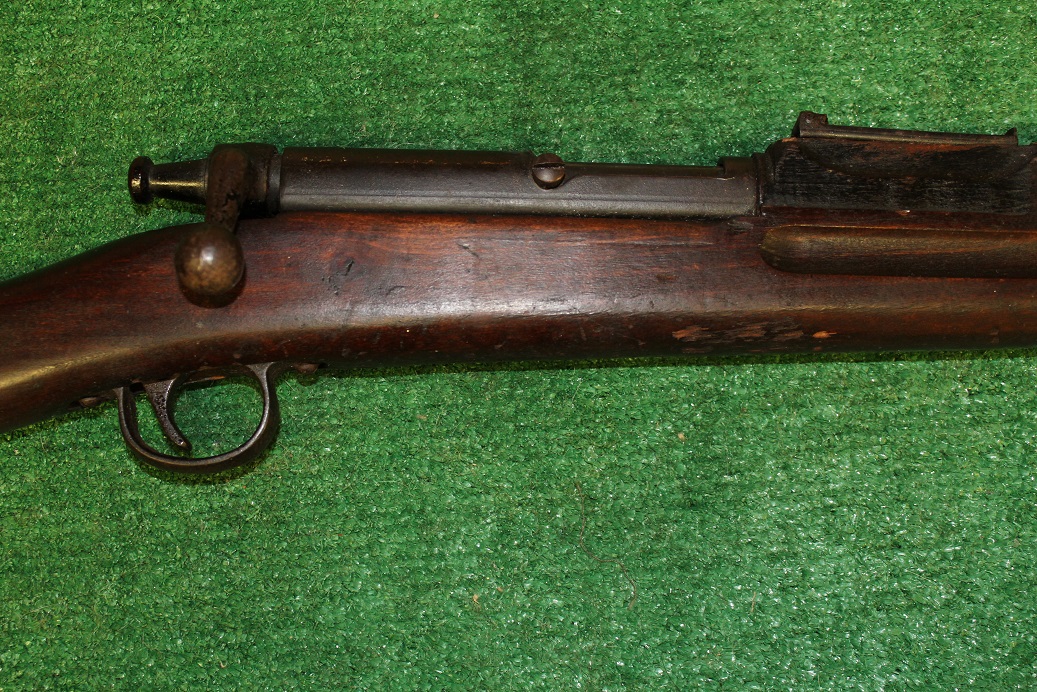

Item No. 7
CONSIGNMENT
Item No. 6
WW2 Grouping!
This is a grouping mostly of photographs but patches as well belonging to Clarence Ray Frye who was a member of the 48th Tank Battalion 14th Armor Division. The 14th Armored Division was constituted and added to the roll of the US Army on 28 August 1942; it was activated on 15 November in a ceremony at Camp Chaffee, Arkansas. It was organized initially as a heavy division with two armored regiments (the 47th and 48th) and one armored infantry regiment, the 62nd Infantry Regiment. It was reorganized from a heavy division to a light division on 20 September 1943. The reorganization saw the loss of two tank battalions from the Armored regiments, one battalion each. The 1st Battalion of the 47th Armor was redesignated as the 786th Tank Battalion and the 3rd Battalion of the 48th Armor was redesignated as the 716th Tank Battlion.
The division departed Camp Chaffee in November to participate in the 2nd Army maneuvers in Tennessee from 17 November 1943 until 10 January 1944. At the conclusion of the exercise, the division was assigned to Camp Campbell, Kentucky. The division remained at Camp Campbell until late September when it was alerted for movement to the ETO (European Theater of Operations) via Camp Shanks, New York where it went for final processing. Units departed Camp Campbell on 1 October and completed their arrival at Camp Shanks on the 6th of that month. After completing their processing, the division boarded four transport ships for deployment on 13 October 1944.
Active 1942–45 Country United States Branch US Army Type Armored division (light) Nickname "Liberators" (special designation) Engagements
World War 2
S. France (part of division)
Rhineland, Ardennes/Alsace Operation Nordwind
Central Europe
Decorations Presidential Unit Citation (2)
This unit participated in heavy fighting in Europe/Germany during WW2. "Liberators" is the official nickname of the US 14th Armored Division. The division became known by its nickname during the last days of World War II when it liberated some 200,000 Allied prisoners of war from German prison camps. Among those liberated were approximately 20,000 American soldiers, sailors and airmen, as well as an estimated 40,000 troops from Great Britain and the Commonwealth.
During the divisions' advance into southern Germany, on 2 and 3 May, the 14th liberated several sub-camps of the Dachau concentration camp. Upon entering the towns of Mühldorf and Ampfing, units of the division discovered three large forced labor camps containing thousands of Polish and Soviet civilians. Units also liberated two additional camps nearby holding Jewish prisoners.
The 14th Armored Division was inactivated on 16 September 1945 at Camp Patrick Henry, Virginia.
The photos below were taken in the Field of operations . One of these photos is id'd on the back as 'TAKEN AT BURCHESGUARDEN HITLERS HOME'. Most don't have anything written on them and many were removed from an Album as witnessed by the black paper stuck to the back of the. Clarence has his name on several so you can definitely tell which one he is. Some of the larger pics were taken at Camp Chaffee, Arkansas. I would say that most of the photos are taken in France and Germany. One photo is labeled ERDING. Erding is a town in Barvaria, Germany. There are tanks, jeeps, a duck, trucks, bombed out buildings, many soldiers and even one pic of a GI standing with two bare chested native women. That pic was probably traded for since he was not in the South Pacific. There are pics of trains and at least one poor little skinny dog. There are several negatives of some of these pics. There are also several yardlongs including:
1. pic no. 14- 48th TANK BN. CAMP CAMPBELL KY JULY 44
2. pic no. 8- CO 'C' 48TH TANK BN. CAMP CAMPBELL KY JULY 44
&
3. There is one from Co 'F' at Camp Chaffee. Several Id's on the back.
4. Here is another one from Co 'F' 48th Armd. Regt. 14th AD at Camp Chaffee from 1943.
A copy (fascilimie) of the Surrender Document.
A coloized copy of BG Albert C. Smith Commander of the 14th AD questioning a solder who is escourting prisoners in 1945.
There are several patches. Some of these belonged to Clarence but I think that he also traded for some with his buddies like he did for that Native girl photo.
Also included with this grouping is an original box for a BRONZE STAR MEDAL without the medal. Clarence's daughter said that her Dad had one but now missing. In the box is his Good Conduct Medal with bar and small button bar. Also in the box is his Bronze star ribbon and small button bar. Lastly is a Europe-Africa-Middle East WW2 medal bar with two battle stars on it. You'll have hours of fun trying to figure out where these pics were taken! For the entire grouping $475.00
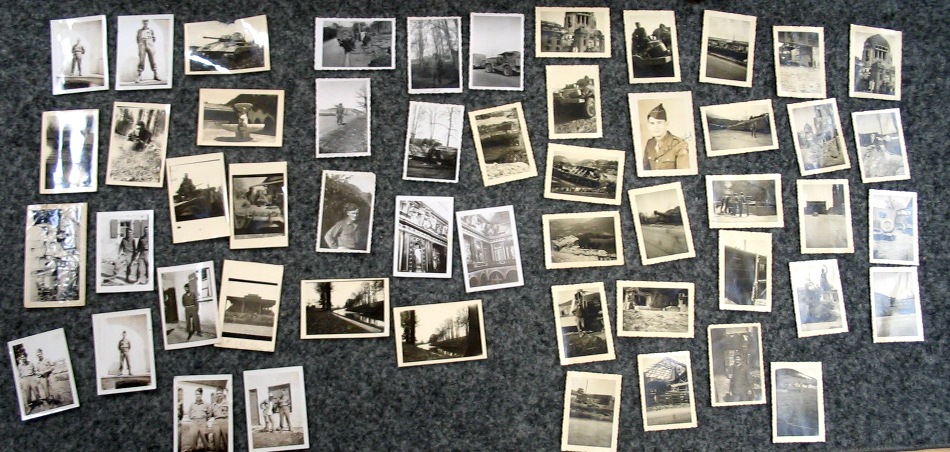
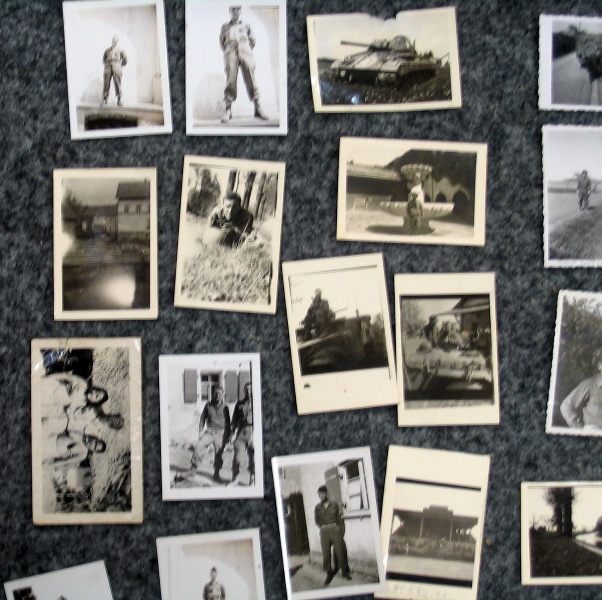
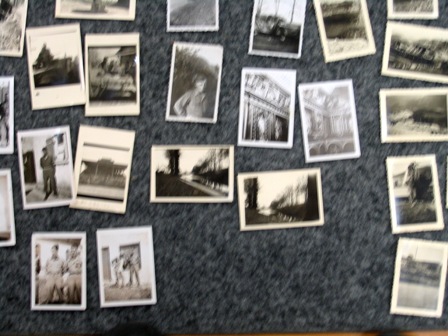
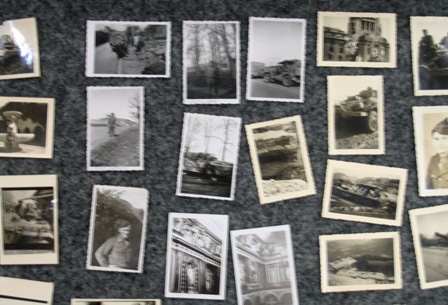
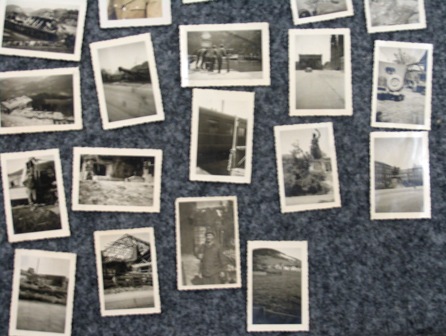
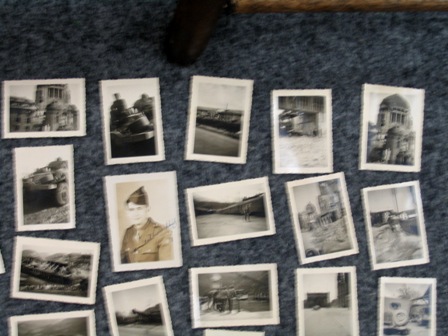
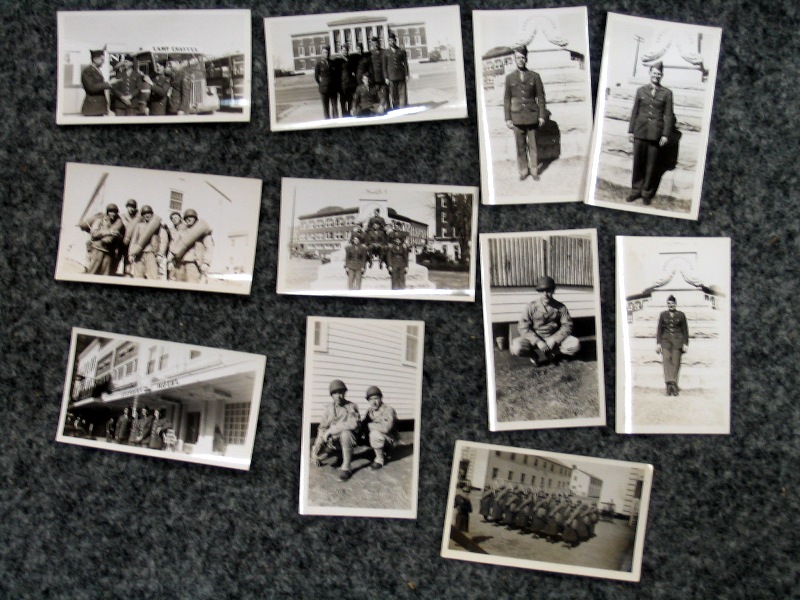
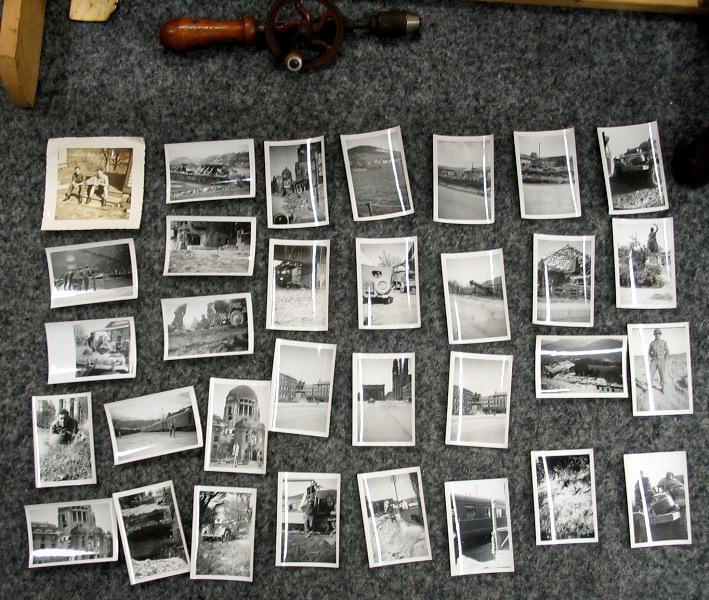
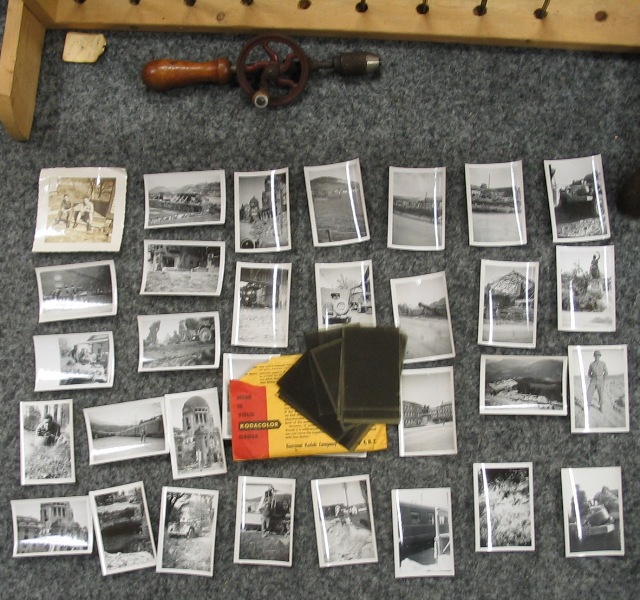
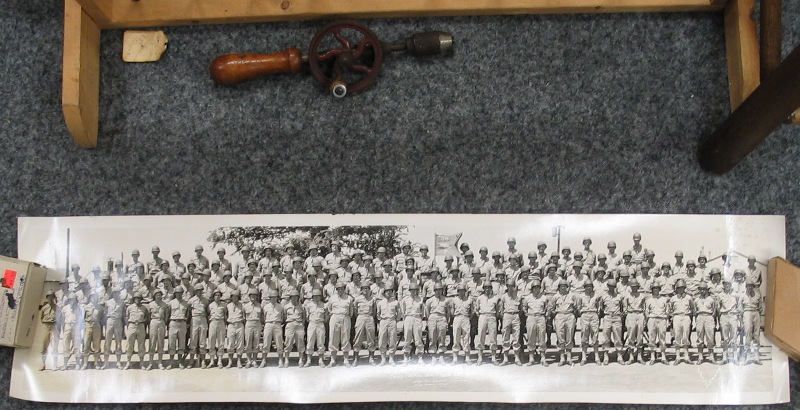



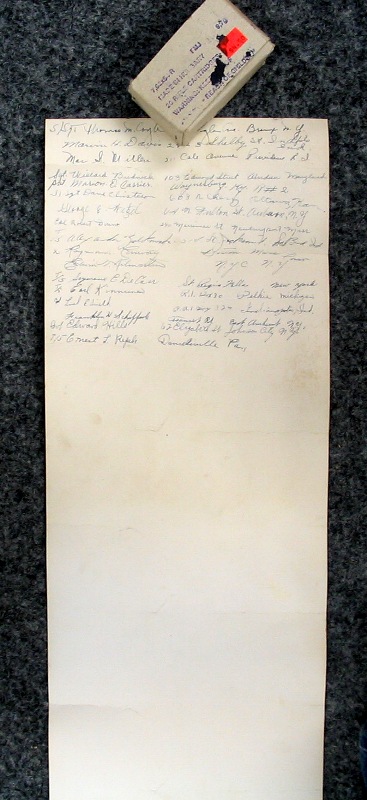
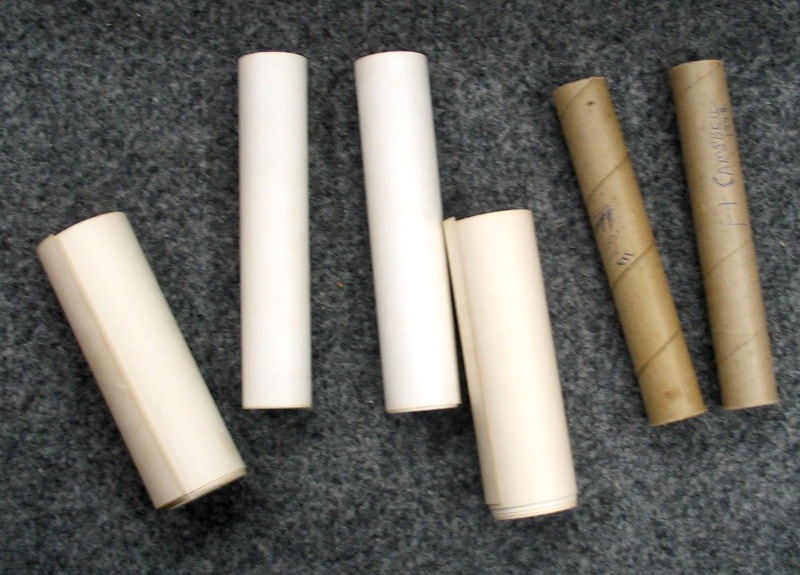

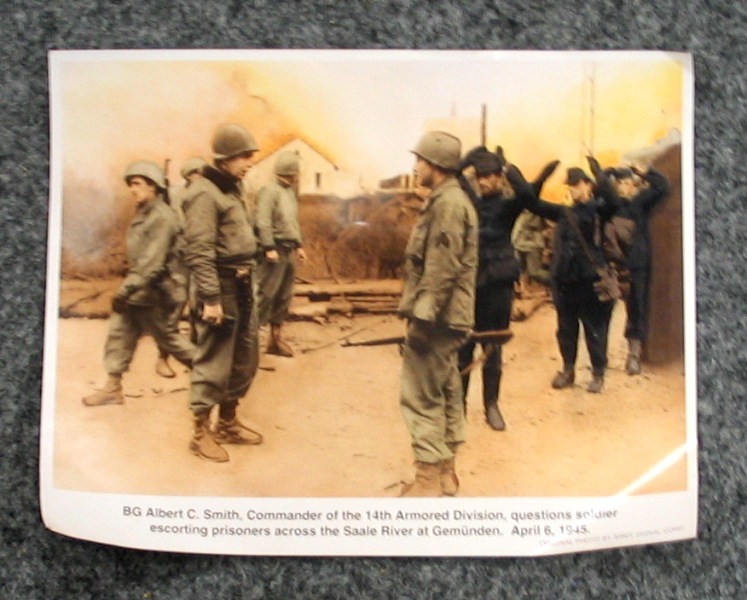

Item No. 5
Here is a small British Flag or Canadian Flag that I found among some WW1 small personal flags. The British had a different flag for everthing and for every colony they ever controlled so I don't know who this flag represents. It's made of silk and in pretty good condition with a few minor moth nips and a splint under the British Jack. This piece should be framed. For this piece $35.00
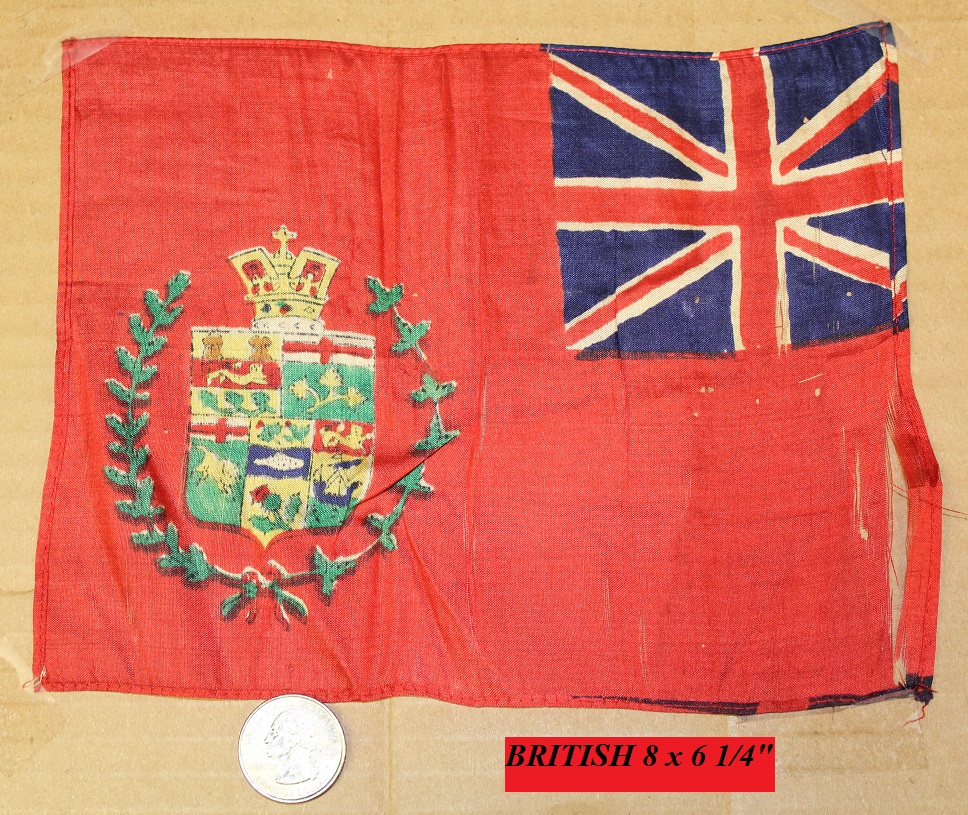
Item No. 4
Here is a , I think, silk handkerchief that was a Souvenir De France WWI. It's about 12 inches square ahd as a WW1 British Biplane enbroderied on it as well as the american Eagle over shield. Also comes with a small piece of lace. For the pair $25.00
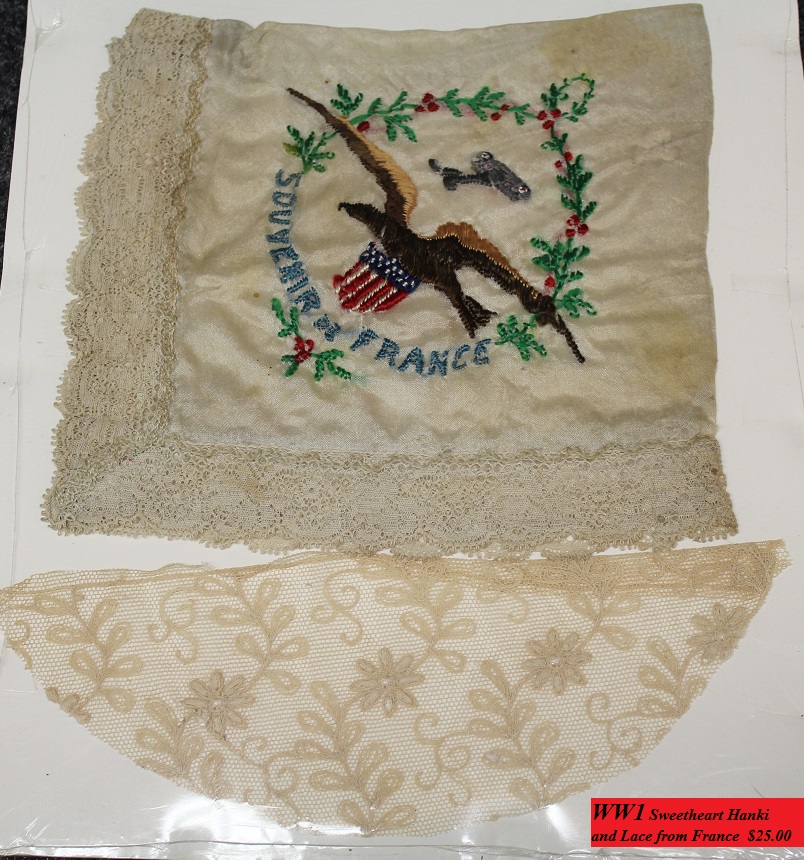
Item No. 3
Here we have what I think is a WW1 Service Flag. But it could be WW2 as well. I am just used to seeing the phrase 'OVER THERE' on WW1 items. The "Sons in Service" flag was used during World War I and World War II. Each family was entitled to hang a small Son In Service flag in their window, the blue star in the center of the red-bordered white rectangle signified a family member in active service. The star was replaced (or covered) with a gold star (in practice, yellow or dark yellow) if the family member died in action. (Hence the name of the organization "Gold Star Mothers" of women who had lost sons in the war.) There were other variations to the star for missing in action, injured, captured, etc, etc, but flags of that sort are rarely, if ever, seen.
Sons in Service flags made and used by families usually were no larger than about one foot long. They were always hung vertically, a stick being sewn into the top heading of the flag and a piece of string attached to both ends of the stick - the string suspended at its midpoint from a hook or some other feature of a front window of the home.
If a family had a husband and a son, or multiple family members in the service of their country, then additional blue stars were set into the white rectangle. Organizations and corporations extended this practice to fly flags incorporating stars for each of their members/employees who were off to war and, of course, would change/overlay the blue stars with gold ones when the news came back that one of theirs had died in action. These larger flags (I have one with some 50 stars in a circle, a quarter of them in gold, measuring about 8 feet long overall) were sometimes flown outside on a pole, but most often were suspended from the ceiling of the factory / meeting hall indoors.
This one is still in good condition with some of the original wool star material missing. This flag is made of silk I believe. Take a look at the pics! $35.00 for this one.
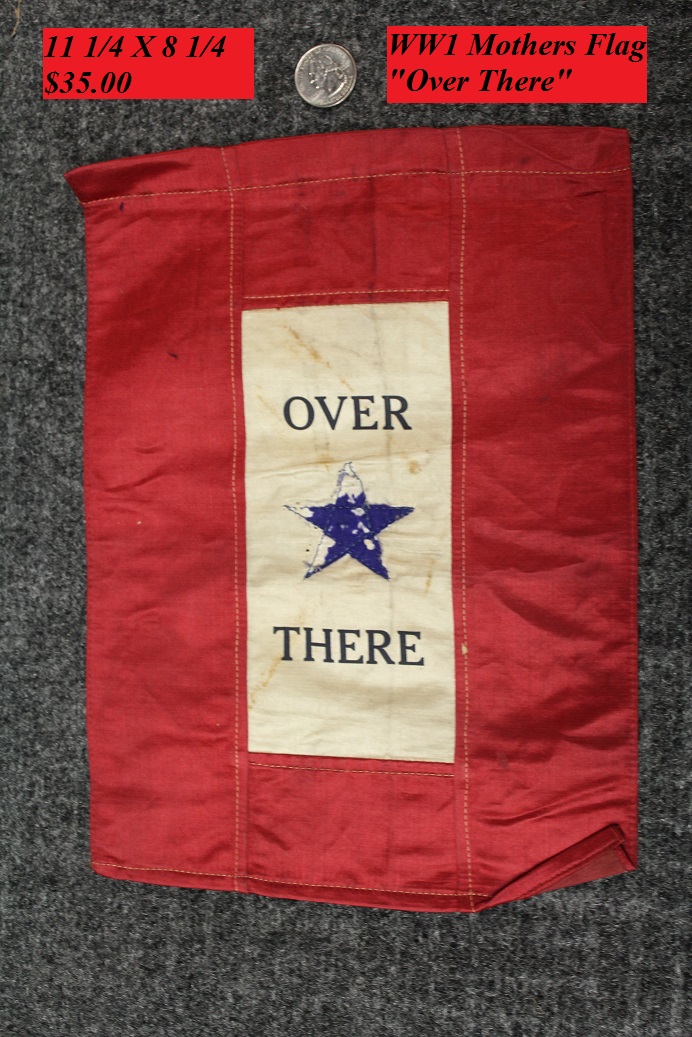
Item No. 2
This next service flag is much larger and made from thin silk. There are splits at the folds but still worth putting in a frame. Check out the pics.
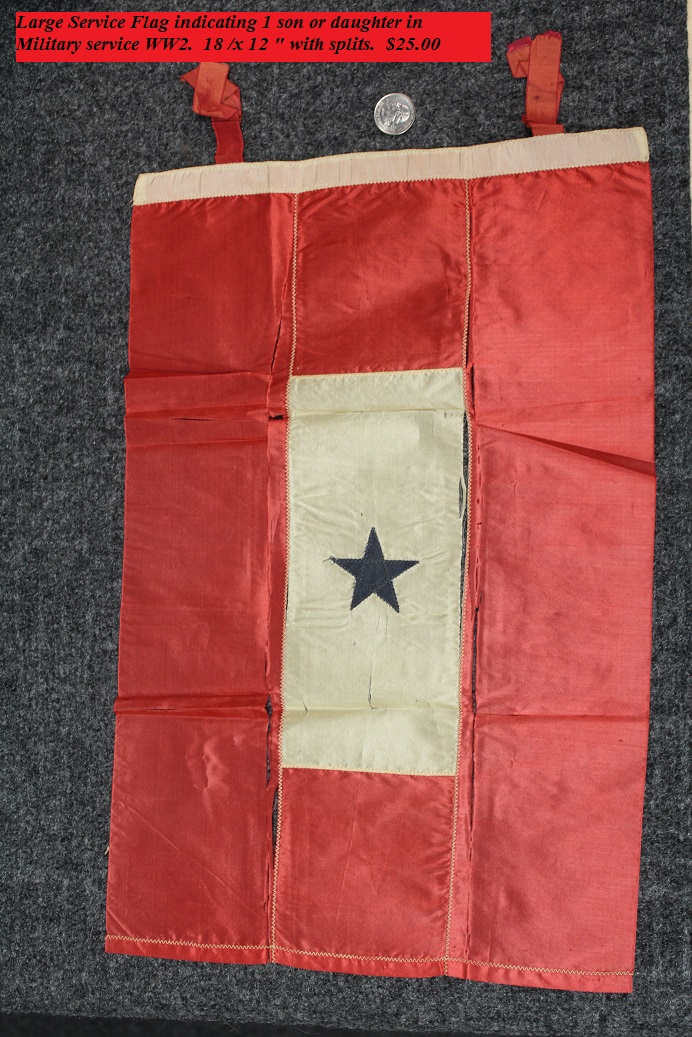
---------------------------------------------------------------------------------------------------------------------------------------------------------
Here’s a bunch of empty brass shells and all are marked and uncleaned or lightly cleaned. These are all USC. CO. No 12 CLIMAX brass shot shells! They are all 12 ga and all in pretty good condition just needing a good cleaning or leave them like this for display. Each $5.00
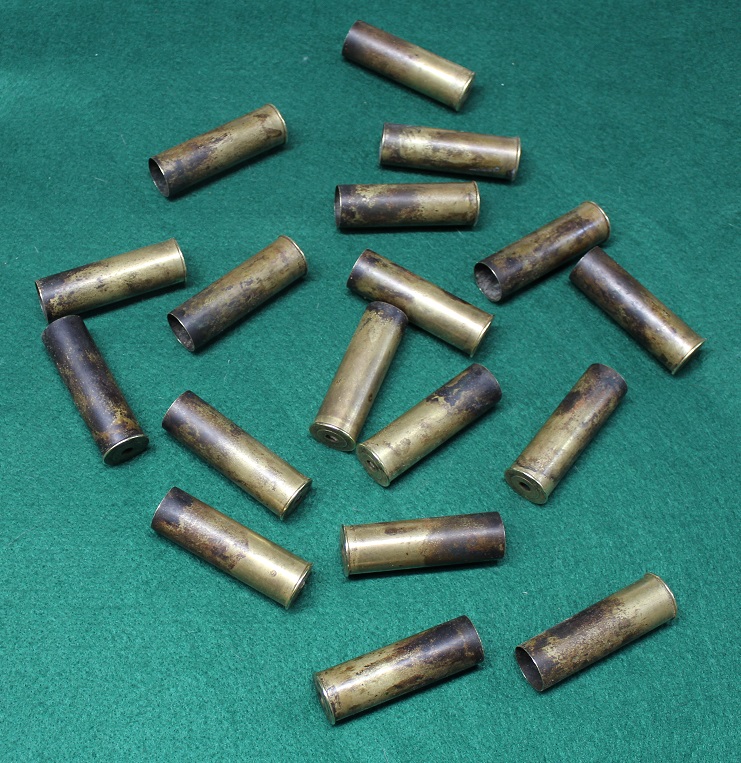

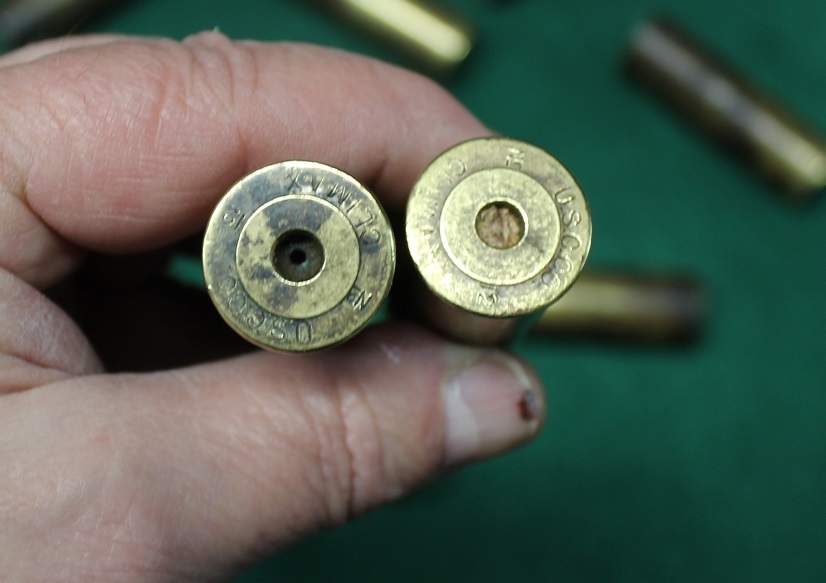
---------------------------------------------------------------------------------------------------------------------------------------------------------
>
WW1/WW2 knives and bayonets 17
Here are two E.G.W. Knives that were made by E.G. Waterman & Co. of New York City for WW2. This is a WW2 knife that sold commercially through stores in the United States but was probably not an Official Government Issue Knife. But there is no doubt that thousands of servicemen who wanted a good duty knife purchased them and carried them throughout the war. The top knife has a leather washer grip for a hand grip and a nice steel blade marked with the makers initials. You can see a like drawn example on page 193 of U.S. MILITARY KNIVES BAYONETS & MACHETES BOOK III by M. H. Cole. This knife is about 11 3/4 inches long with a 7 1/4 inch bowie type blade. There are a few spots where the leather washers have deteriorited but it's not bad at all and still quite solid. This piece comes in the original leather sheath that is in good condition as well. $85.00
The second knife down is not E.G.W. marked but obviously it is from the same company. The blade has been sharpened on this one so the first one has a better blade but this one has a better grip which is darn near perfect. The sheath is good on this one as well having been oiled at one time. For this one $85.00 as well.
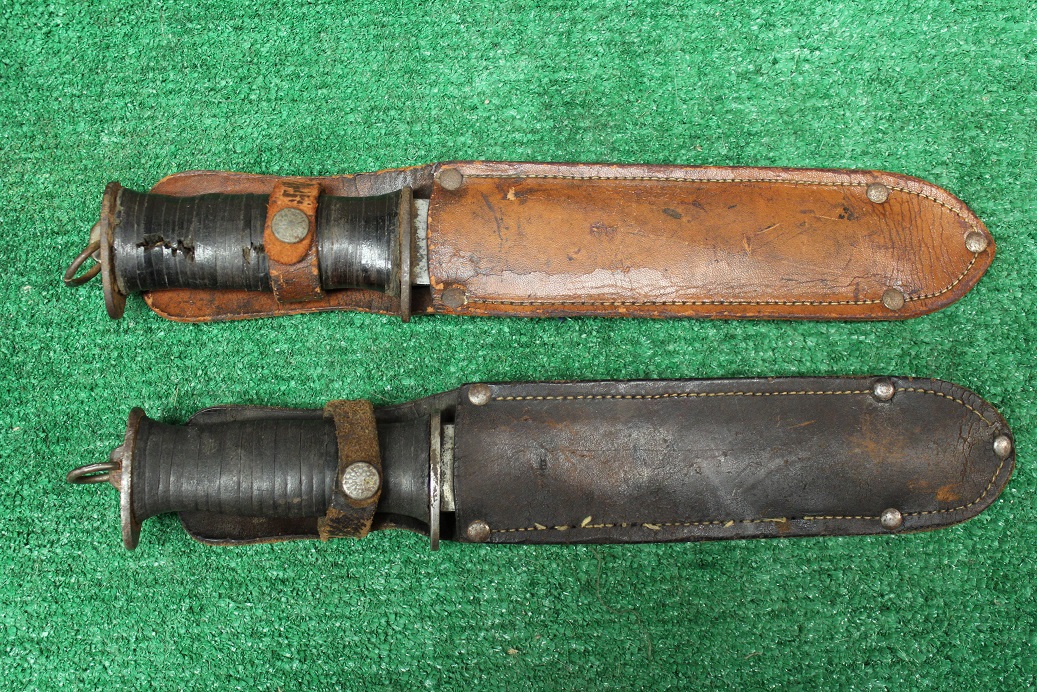
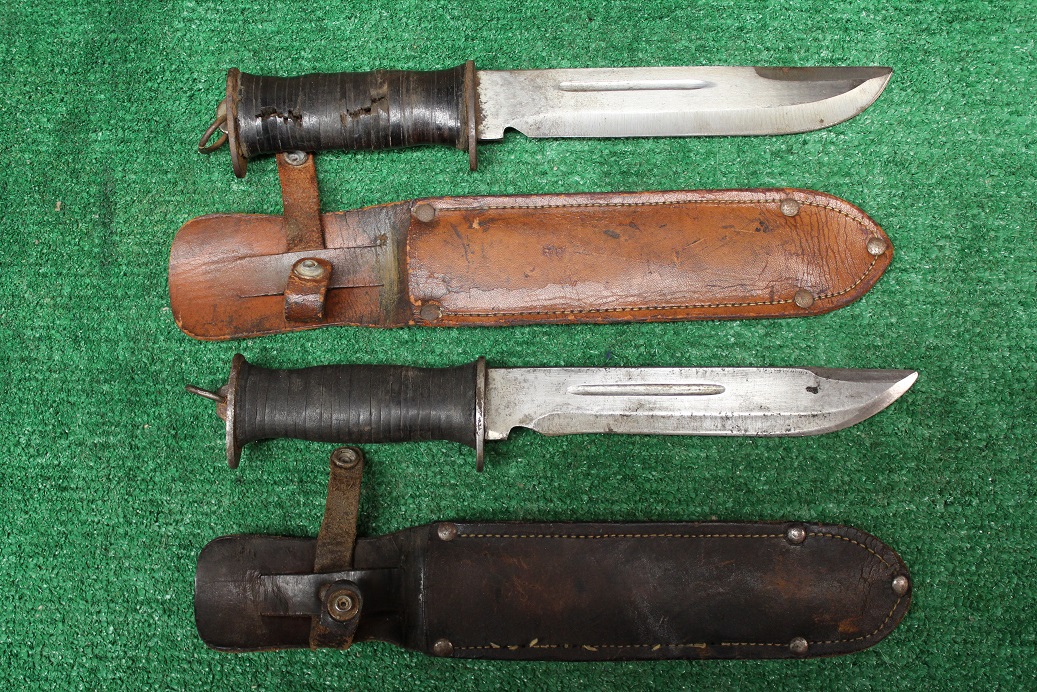
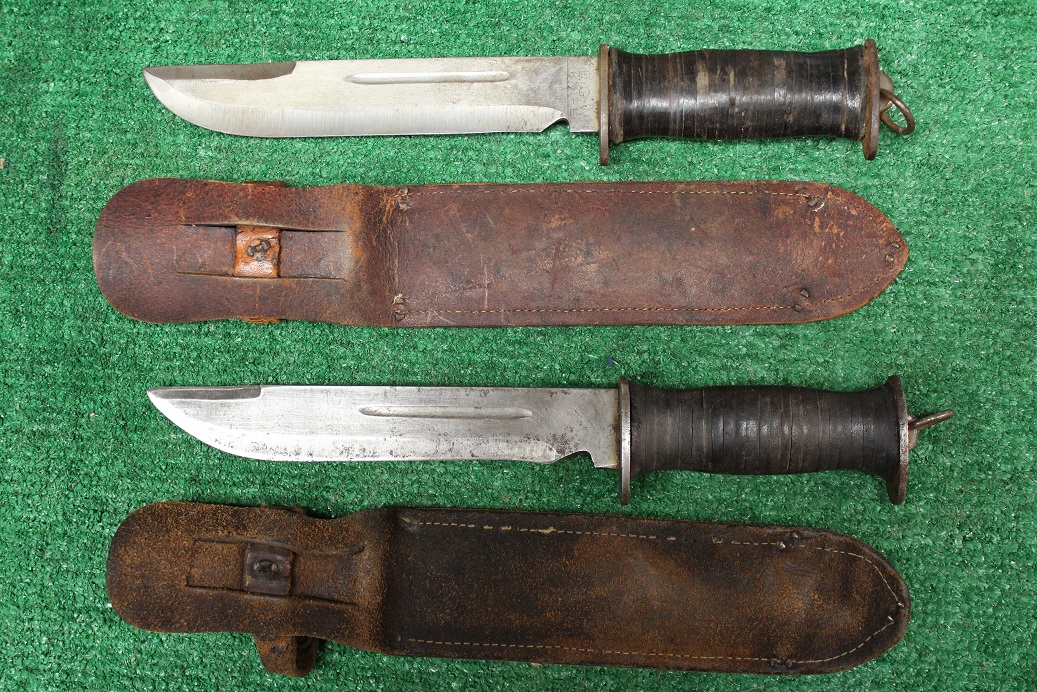
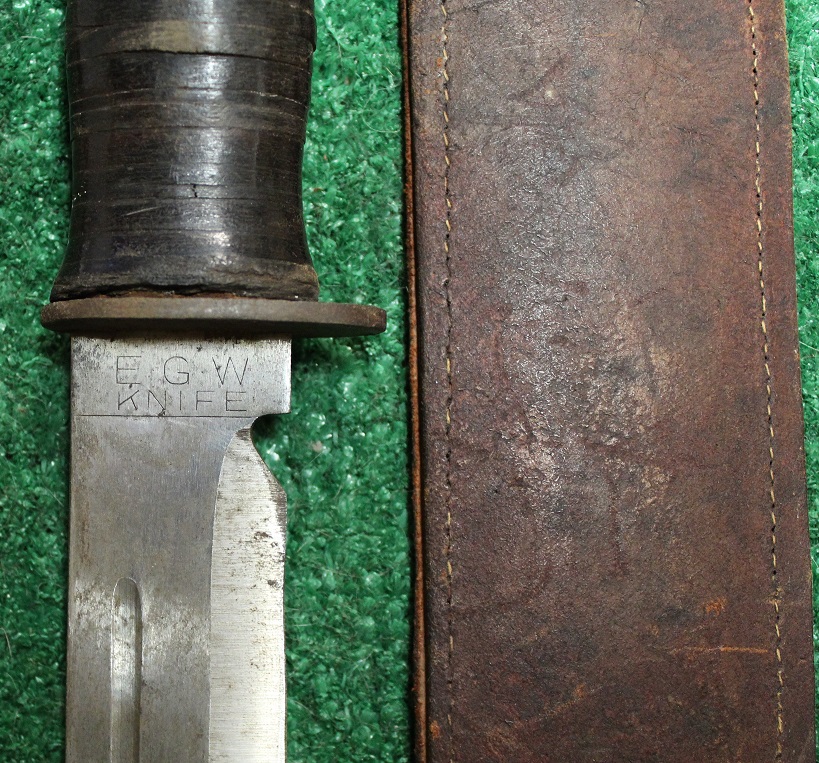
____________________________________________________________________________________
WW1/WW2 knives and bayonets 16
Here we have a WW2 German Dress Bayonet with scabbard and frog. The dagger is pretty nice with some finish splotching on the blade. Just cosmetic. The blade has not been sharpened and is nicely maker marked GUSTAV SPITZER-SOLINGEN
along with a Lion symbol. The grips are black plastic and perfect. The scabbard still has the original black lacquer finish but has two dents on either side near the tip of it that make the bayonet hard to go in and out. The frog is complete being
the black patent leather type finish. The finish is cracked and has a few heat impressions on it from probably being in the attic. These items were brought back by a Capt. C. L. Davidson but I'm afraid I don't have any info on him. For this piece
$165.00

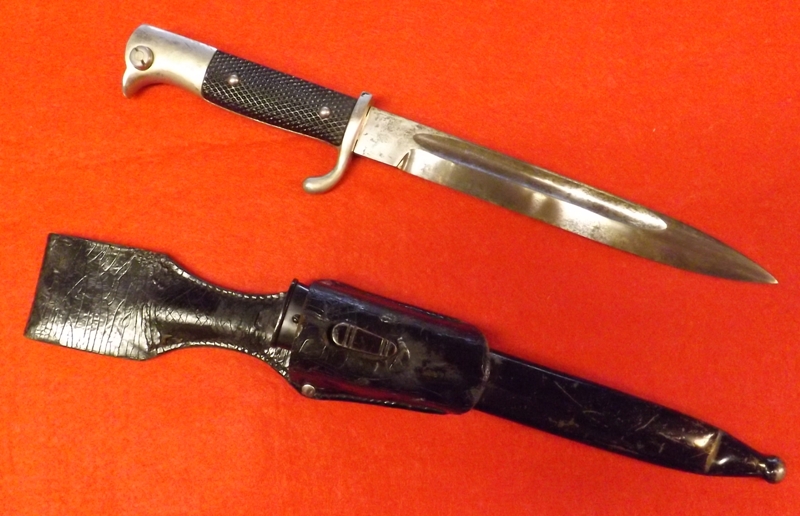
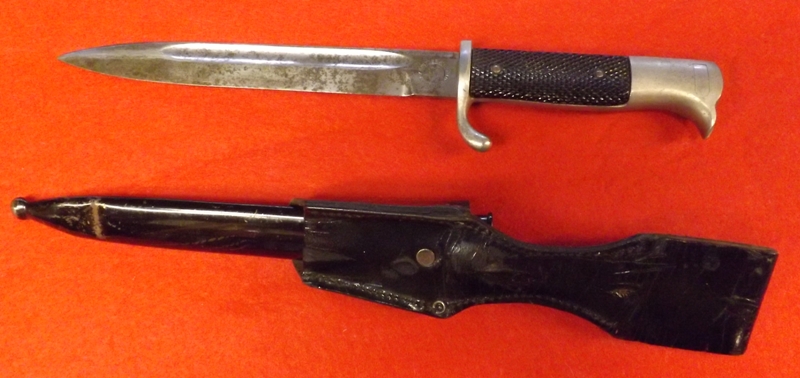
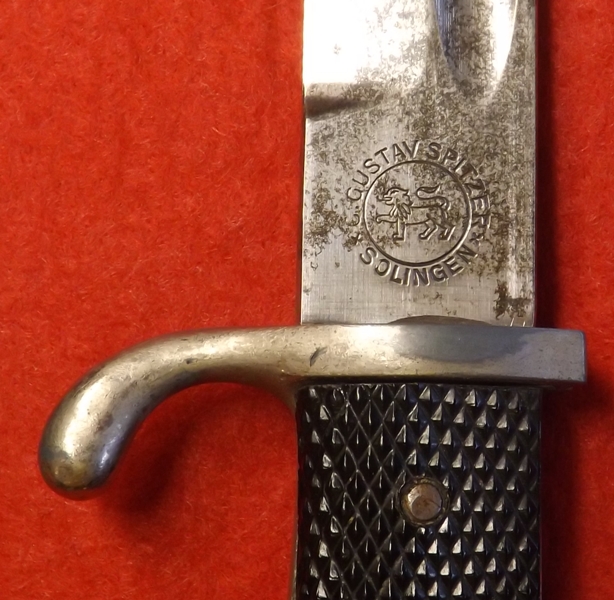

____________________________________________________________________________________
knives and bayonets 9
Here are 4 English Knifes that I recently picked up. All of them date from the 1800's thru WW2 I believe. The first one, starting on the left, is a small flat sided knife measuring 4 1/4 inches loing with a 3 1/4 inch blade and a can opener.
The pressed grips are in fair condition only showing lots of wear and some warping. The knife blade is marked NON XLL - JOSEPH ALLEN AND SONS - SHEFFIELD. Lots of chararcter here! $45.00
knives and bayonets 8
The 2nd knife is an aluminum handled knife measuring about 4 3/4 inches closed with a 3 1/2 inch knife blade and has a small spearpoint blade and a marlin spike indicative of a Naval Knive. The blade is marked CASE XX - METAL STAMPINGS- LTD.
Fair condition overall. $35.00 IThe Case Knife is SOLD!
knives and bayonets 7
The 3rd knife is a large Naval knife with pressed grips measuring about 5 inches overall with a 3 3/4 inch blade. This piece has a marlin spike and a spearpoint blade measuring about 1 3/4 inches long. The grips have a few stress cracks but they're
still solid. The blade is marked IXL and the markings on the ricasso are GEORGE WESTERHOLM - SHEFFIELD - ENGLAND. Overall real nice and BIG! $65.00
knives and bayonets 6
The last knife looks like a smaller version of the knife about except it has a can opener instead of the small spearpoint blade. The can opener has a broad arrow and 1940 stamped on it. I don't know if the 1940 is the year it was made or some sort of
part number. The blade markings seem to be WATTS SHEFFIELD ENGLAND. Overall pretty nice! This one also has the marlin spike and all of the knives have a laynard ring. $45.00 I
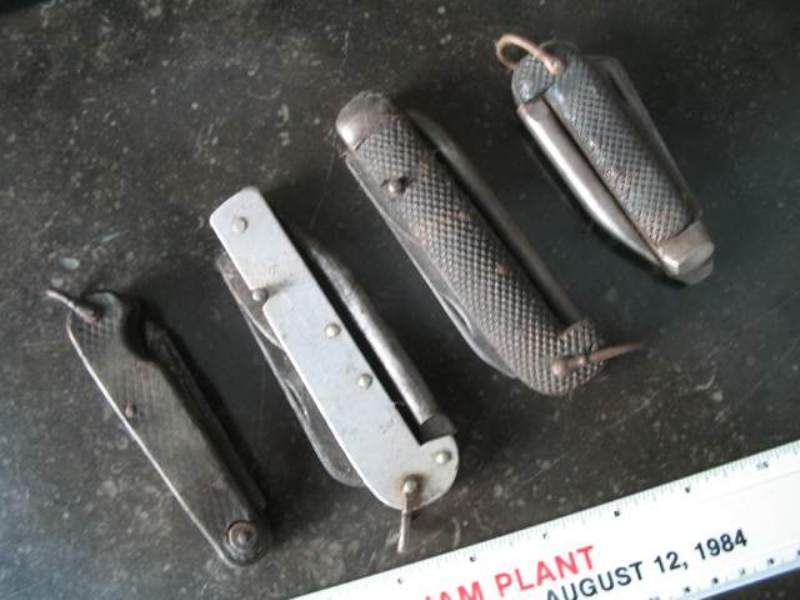
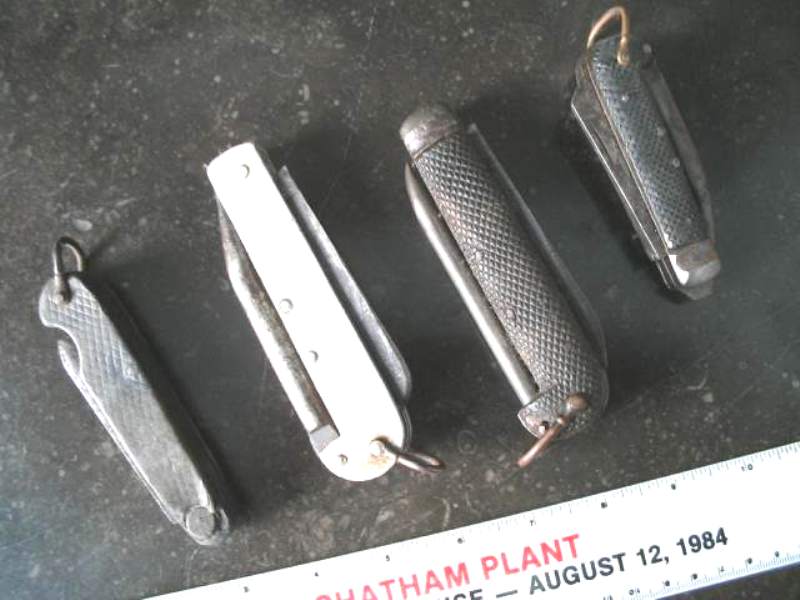
____________________________________________________________________________________
>
\WW1/WW2 knives and bayonets 5
Here we have picked up an Islamic Ottoman Decorated Dagger from 1700 to 1800 AD.
This gorgeous Islamic single edged weapon has its metal handle, and blade profusely decorated with foliage in intricate whorls, and stylized gazelles on each side of the blade and handle, as shown. The pattern is engraved identically on both sides of the blade and handle. The wooden part of the handle is a later addition, probably 19th-20th century.
Overall a rare and very well made museum quality late medieval single edged weapon.
This hacking dagger was originally purchased from a German auction house.
Intact, untouched. Old English collection. Length of dagger: 17 inches.
The Ottoman Empire was established by the cruel killing nature of the Mongoloid races invading into Southern Europe and "ruleing by the sword". This is one such example of an infamous albeit very attractive single edged cutting weapon! It looks
like the tip was used to pierce armour. This is a very impressive piece and comes with our guarantee that it is what we profess it to be. We also have a certificate of authenticity from the original English Dealer that we purchased it from.
You don't often see these weapons in any condition! $450.00





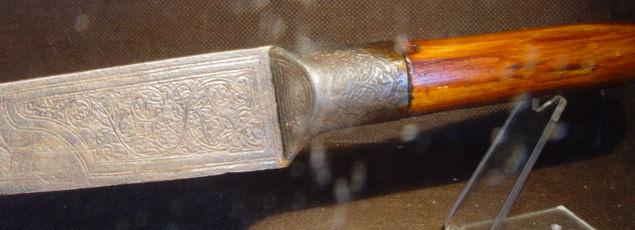
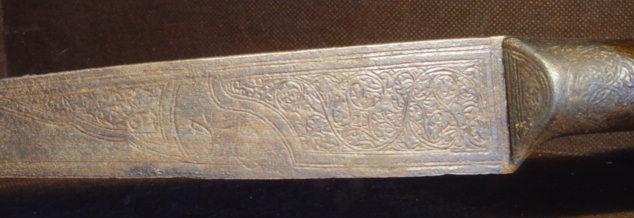


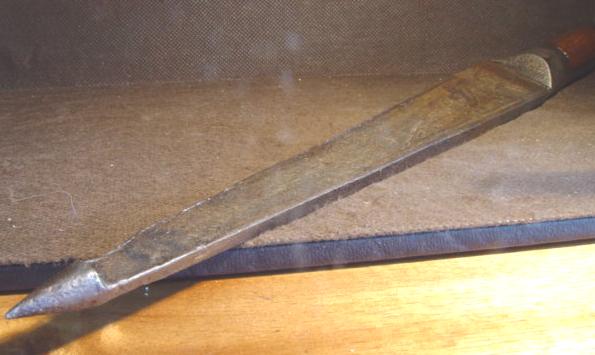
____________________________________________________________________________________
WW1/WW2 knives and bayonets 3
Here's another item that I don't see every day. This is a near relic what I believe to be an Moro Kampilan beheading sword. The blade is very rusty with what appears to be a design on it of perhaps a snake. The blade is over 28 inches long and 2 1/4
inches wide at it's widest point. The aged wooden grip is about 9 3/4 inches long with age cracks. I believe something is missing on the grip as well. The grip seems to be some kind of animal or something. The blade is fairly thick. I believe this
one to be from the 1800's as well. No Scabbard. Gruesome! $145.00





Here's another pic of a complete one!
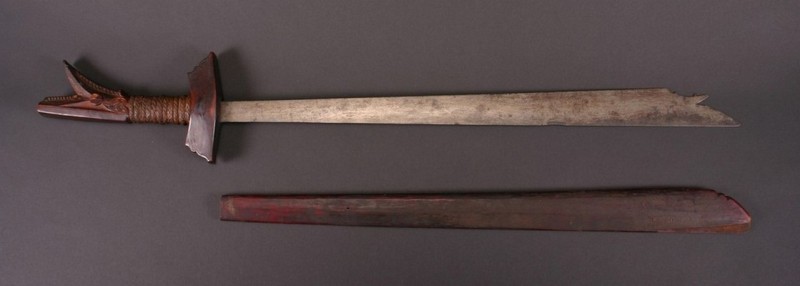
____________________________________________________________________________________


















































































































































 __________________________________________________________________________________________
__________________________________________________________________________________________
 __________________________________________________________________________________________
__________________________________________________________________________________________




































































































































































